APPLICATION OF EFFECTIVE STRATEGIES - A CASE OF PRET A MANGER
VerifiedAdded on 2022/06/07
|72
|21343
|33
AI Summary
Pret A Manger's case study aims to determine how effective strategies can be applied to create a new market. The report was heavily influenced by the work of Frei, Goldberg, and Van Sice (2012). Through its mission to provide healthy and high-quality food products and services to its consumers (see appendix 1 and 2), the company has steadily increased its sales performance in recent years.
Contribute Materials
Your contribution can guide someone’s learning journey. Share your
documents today.
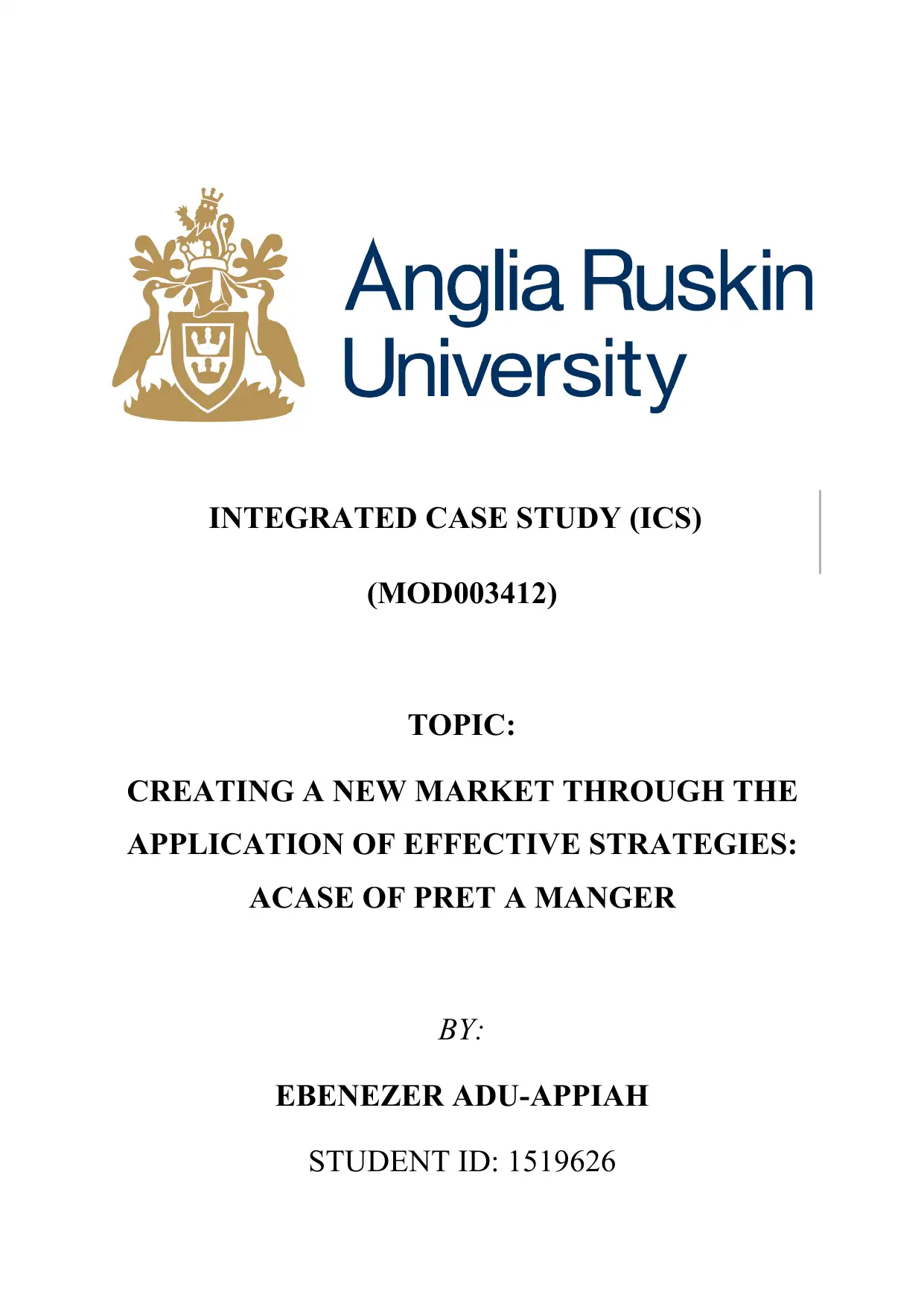
INTEGRATED CASE STUDY (ICS)
(MOD003412)
TOPIC:
CREATING A NEW MARKET THROUGH THE
APPLICATION OF EFFECTIVE STRATEGIES:
ACASE OF PRET A MANGER
BY:
EBENEZER ADU-APPIAH
STUDENT ID: 1519626
(MOD003412)
TOPIC:
CREATING A NEW MARKET THROUGH THE
APPLICATION OF EFFECTIVE STRATEGIES:
ACASE OF PRET A MANGER
BY:
EBENEZER ADU-APPIAH
STUDENT ID: 1519626
Secure Best Marks with AI Grader
Need help grading? Try our AI Grader for instant feedback on your assignments.
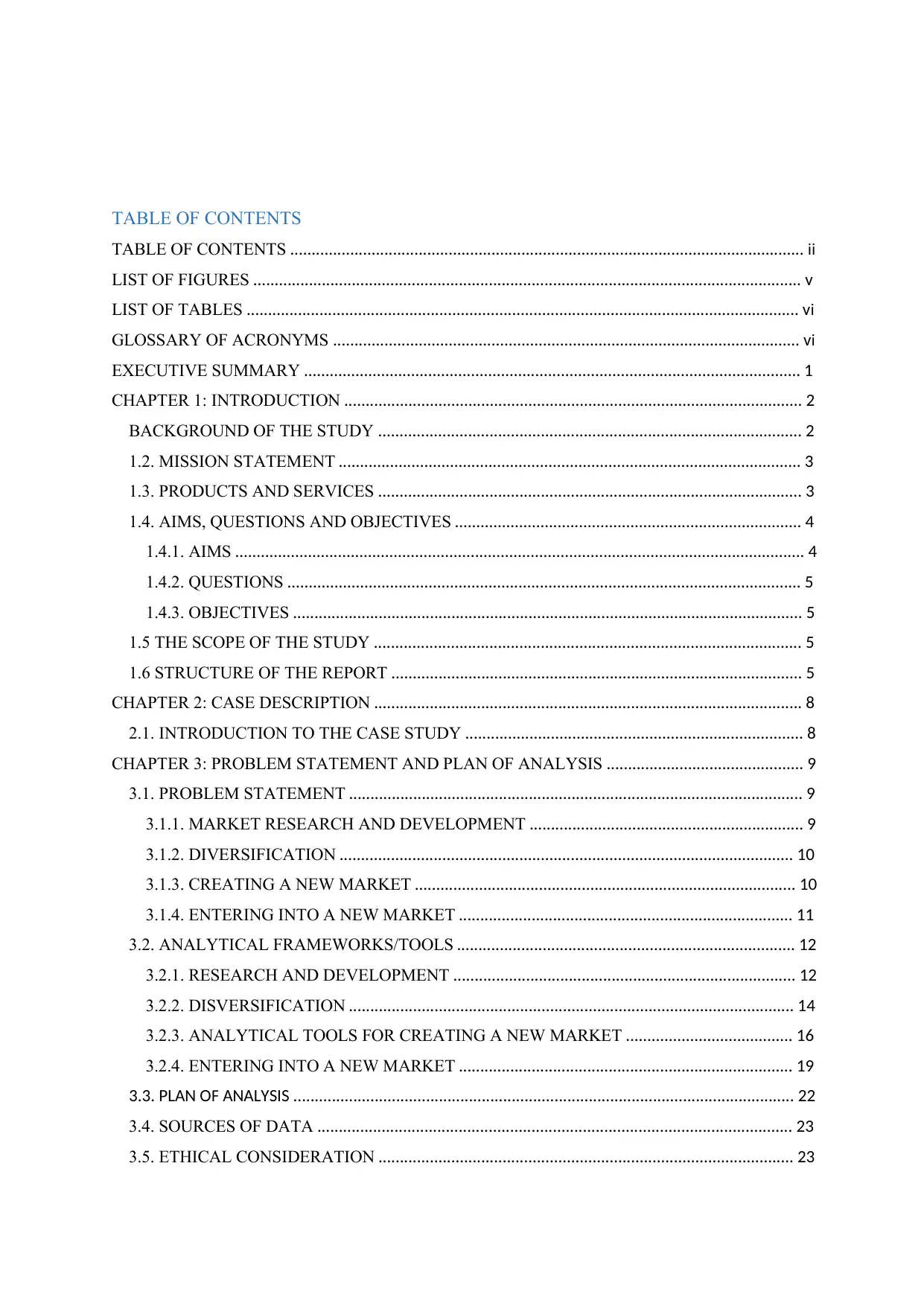
TABLE OF CONTENTS
TABLE OF CONTENTS ii........................................................................................................................
LIST OF FIGURES ................................................................................................................................ v
LIST OF TABLES i................................................................................................................................. v
GLOSSARY OF ACRONYMS i............................................................................................................. v
EXECUTIVE SUMMARY .................................................................................................................... 1
CHAPTER 1: INTRODUCTION ........................................................................................................... 2
BACKGROUND OF THE STUDY ................................................................................................... 2
1.2. MISSION STATEMENT ............................................................................................................ 3
1.3. PRODUCTS AND SERVICES ................................................................................................... 3
1.4. AIMS, QUESTIONS AND OBJECTIVES ................................................................................. 4
1.4.1. AIMS ..................................................................................................................................... 4
1.4.2. QUESTIONS ........................................................................................................................ 5
1.4.3. OBJECTIVES ....................................................................................................................... 5
1.5 THE SCOPE OF THE STUDY .................................................................................................... 5
1.6 STRUCTURE OF THE REPORT ................................................................................................ 5
CHAPTER 2: CASE DESCRIPTION .................................................................................................... 8
2.1. INTRODUCTION TO THE CASE STUDY ............................................................................... 8
CHAPTER 3: PROBLEM STATEMENT AND PLAN OF ANALYSIS .............................................. 9
3.1. PROBLEM STATEMENT .......................................................................................................... 9
3.1.1. MARKET RESEARCH AND DEVELOPMENT ................................................................ 9
3.1.2. DIVERSIFICATION .......................................................................................................... 10
3.1.3. CREATING A NEW MARKET ......................................................................................... 10
3.1.4. ENTERING INTO A NEW MARKET .............................................................................. 11
3.2. ANALYTICAL FRAMEWORKS/TOOLS ............................................................................... 12
3.2.1. RESEARCH AND DEVELOPMENT ................................................................................ 12
3.2.2. DISVERSIFICATION ........................................................................................................ 14
3.2.3. ANALYTICAL TOOLS FOR CREATING A NEW MARKET ....................................... 16
3.2.4. ENTERING INTO A NEW MARKET .............................................................................. 19
F3.3. PLAN O ANALYSIS ..................................................................................................................... 22
3.4. SOURCES OF DATA ............................................................................................................... 23
3.5. ETHICAL CONSIDERATION ................................................................................................. 23
TABLE OF CONTENTS ii........................................................................................................................
LIST OF FIGURES ................................................................................................................................ v
LIST OF TABLES i................................................................................................................................. v
GLOSSARY OF ACRONYMS i............................................................................................................. v
EXECUTIVE SUMMARY .................................................................................................................... 1
CHAPTER 1: INTRODUCTION ........................................................................................................... 2
BACKGROUND OF THE STUDY ................................................................................................... 2
1.2. MISSION STATEMENT ............................................................................................................ 3
1.3. PRODUCTS AND SERVICES ................................................................................................... 3
1.4. AIMS, QUESTIONS AND OBJECTIVES ................................................................................. 4
1.4.1. AIMS ..................................................................................................................................... 4
1.4.2. QUESTIONS ........................................................................................................................ 5
1.4.3. OBJECTIVES ....................................................................................................................... 5
1.5 THE SCOPE OF THE STUDY .................................................................................................... 5
1.6 STRUCTURE OF THE REPORT ................................................................................................ 5
CHAPTER 2: CASE DESCRIPTION .................................................................................................... 8
2.1. INTRODUCTION TO THE CASE STUDY ............................................................................... 8
CHAPTER 3: PROBLEM STATEMENT AND PLAN OF ANALYSIS .............................................. 9
3.1. PROBLEM STATEMENT .......................................................................................................... 9
3.1.1. MARKET RESEARCH AND DEVELOPMENT ................................................................ 9
3.1.2. DIVERSIFICATION .......................................................................................................... 10
3.1.3. CREATING A NEW MARKET ......................................................................................... 10
3.1.4. ENTERING INTO A NEW MARKET .............................................................................. 11
3.2. ANALYTICAL FRAMEWORKS/TOOLS ............................................................................... 12
3.2.1. RESEARCH AND DEVELOPMENT ................................................................................ 12
3.2.2. DISVERSIFICATION ........................................................................................................ 14
3.2.3. ANALYTICAL TOOLS FOR CREATING A NEW MARKET ....................................... 16
3.2.4. ENTERING INTO A NEW MARKET .............................................................................. 19
F3.3. PLAN O ANALYSIS ..................................................................................................................... 22
3.4. SOURCES OF DATA ............................................................................................................... 23
3.5. ETHICAL CONSIDERATION ................................................................................................. 23
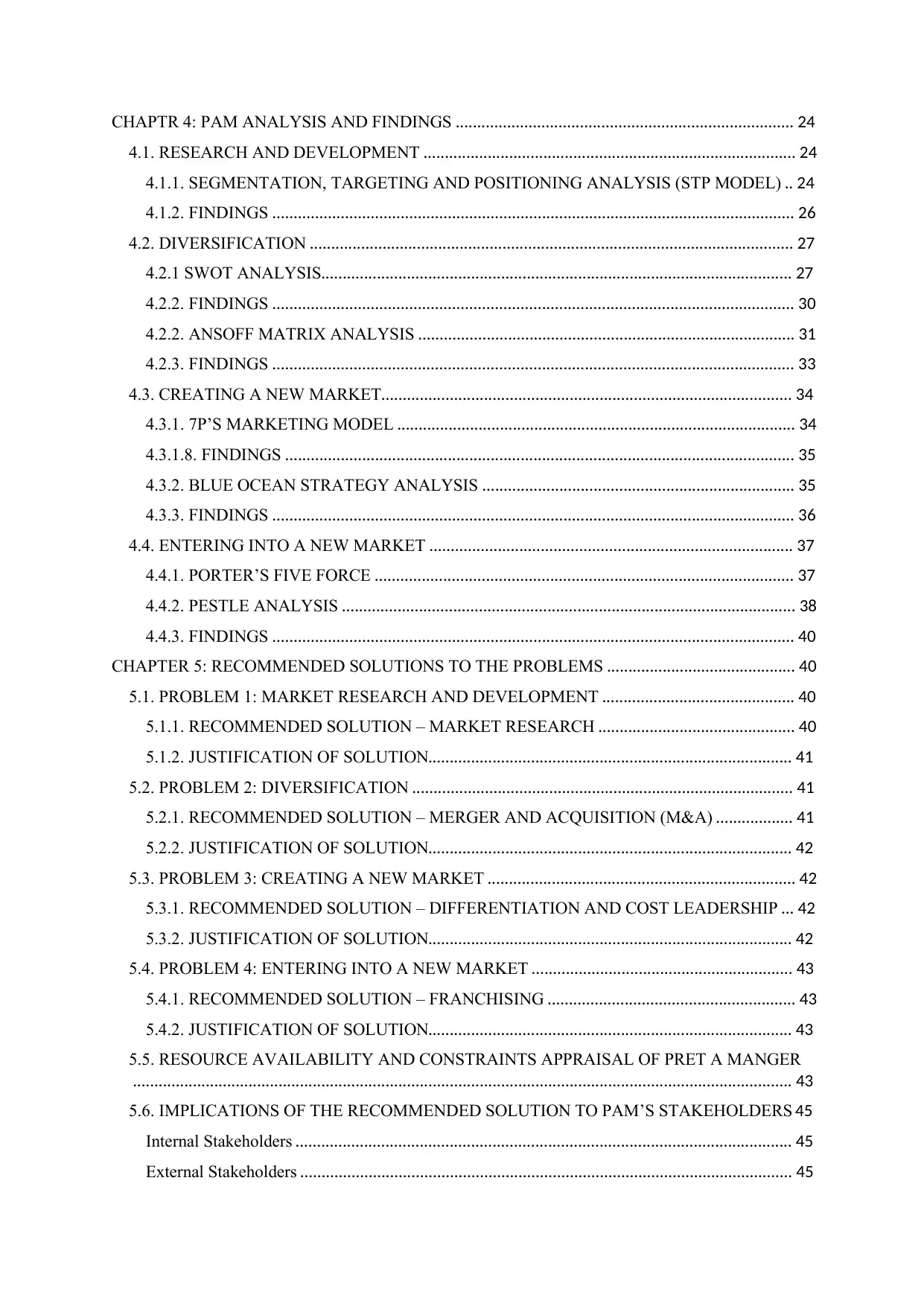
CHAPTR 4: PAM ANALYSIS AND FINDINGS ............................................................................... 24
4.1. RESEARCH AND DEVELOPMENT ....................................................................................... 24
4.1.1. SEGMENTATION, TARGETING AND POSITIONING ANALYSIS (STP MODEL) .. 24
4.1.2. FINDINGS .......................................................................................................................... 26
4.2. DIVERSIFICATION ................................................................................................................. 27
4.2.1 SWOT ANALYSIS.............................................................................................................. 27
4.2.2. FINDINGS .......................................................................................................................... 30
4.2.2. ANSOFF MATRIX ANALYSIS ........................................................................................ 31
4.2.3. FINDINGS .......................................................................................................................... 33
4.3. CREATING A NEW MARKET................................................................................................ 34
4.3.1. 7P’S MARKETING MODEL ............................................................................................. 34
4.3.1.8. FINDINGS ....................................................................................................................... 35
4.3.2. BLUE OCEAN STRATEGY ANALYSIS ......................................................................... 35
4.3.3. FINDINGS .......................................................................................................................... 36
4.4. ENTERING INTO A NEW MARKET ..................................................................................... 37
4.4.1. PORTER’S FIVE FORCE .................................................................................................. 37
4.4.2. PESTLE ANALYSIS .......................................................................................................... 38
4.4.3. FINDINGS .......................................................................................................................... 40
CHAPTER 5: RECOMMENDED SOLUTIONS TO THE PROBLEMS ............................................ 40
5.1. PROBLEM 1: MARKET RESEARCH AND DEVELOPMENT ............................................. 40
5.1.1. RECOMMENDED SOLUTION – MARKET RESEARCH .............................................. 40
5.1.2. JUSTIFICATION OF SOLUTION..................................................................................... 41
5.2. PROBLEM 2: DIVERSIFICATION ......................................................................................... 41
5.2.1. RECOMMENDED SOLUTION – MERGER AND ACQUISITION (M&A) .................. 41
5.2.2. JUSTIFICATION OF SOLUTION..................................................................................... 42
5.3. PROBLEM 3: CREATING A NEW MARKET ........................................................................ 42
5.3.1. RECOMMENDED SOLUTION – DIFFERENTIATION AND COST LEADERSHIP ... 42
5.3.2. JUSTIFICATION OF SOLUTION..................................................................................... 42
5.4. PROBLEM 4: ENTERING INTO A NEW MARKET ............................................................. 43
5.4.1. RECOMMENDED SOLUTION – FRANCHISING .......................................................... 43
5.4.2. JUSTIFICATION OF SOLUTION..................................................................................... 43
5.5. RESOURCE AVAILABILITY AND CONSTRAINTS APPRAISAL OF PRET A MANGER
.......................................................................................................................................................... 43
5.6. IMPLICATIONS OF THE RECOMMENDED SOLUTION TO PAM’S STAKEHOLDERS 45
Internal Stakeholders .................................................................................................................... 45
External Stakeholders ................................................................................................................... 45
4.1. RESEARCH AND DEVELOPMENT ....................................................................................... 24
4.1.1. SEGMENTATION, TARGETING AND POSITIONING ANALYSIS (STP MODEL) .. 24
4.1.2. FINDINGS .......................................................................................................................... 26
4.2. DIVERSIFICATION ................................................................................................................. 27
4.2.1 SWOT ANALYSIS.............................................................................................................. 27
4.2.2. FINDINGS .......................................................................................................................... 30
4.2.2. ANSOFF MATRIX ANALYSIS ........................................................................................ 31
4.2.3. FINDINGS .......................................................................................................................... 33
4.3. CREATING A NEW MARKET................................................................................................ 34
4.3.1. 7P’S MARKETING MODEL ............................................................................................. 34
4.3.1.8. FINDINGS ....................................................................................................................... 35
4.3.2. BLUE OCEAN STRATEGY ANALYSIS ......................................................................... 35
4.3.3. FINDINGS .......................................................................................................................... 36
4.4. ENTERING INTO A NEW MARKET ..................................................................................... 37
4.4.1. PORTER’S FIVE FORCE .................................................................................................. 37
4.4.2. PESTLE ANALYSIS .......................................................................................................... 38
4.4.3. FINDINGS .......................................................................................................................... 40
CHAPTER 5: RECOMMENDED SOLUTIONS TO THE PROBLEMS ............................................ 40
5.1. PROBLEM 1: MARKET RESEARCH AND DEVELOPMENT ............................................. 40
5.1.1. RECOMMENDED SOLUTION – MARKET RESEARCH .............................................. 40
5.1.2. JUSTIFICATION OF SOLUTION..................................................................................... 41
5.2. PROBLEM 2: DIVERSIFICATION ......................................................................................... 41
5.2.1. RECOMMENDED SOLUTION – MERGER AND ACQUISITION (M&A) .................. 41
5.2.2. JUSTIFICATION OF SOLUTION..................................................................................... 42
5.3. PROBLEM 3: CREATING A NEW MARKET ........................................................................ 42
5.3.1. RECOMMENDED SOLUTION – DIFFERENTIATION AND COST LEADERSHIP ... 42
5.3.2. JUSTIFICATION OF SOLUTION..................................................................................... 42
5.4. PROBLEM 4: ENTERING INTO A NEW MARKET ............................................................. 43
5.4.1. RECOMMENDED SOLUTION – FRANCHISING .......................................................... 43
5.4.2. JUSTIFICATION OF SOLUTION..................................................................................... 43
5.5. RESOURCE AVAILABILITY AND CONSTRAINTS APPRAISAL OF PRET A MANGER
.......................................................................................................................................................... 43
5.6. IMPLICATIONS OF THE RECOMMENDED SOLUTION TO PAM’S STAKEHOLDERS 45
Internal Stakeholders .................................................................................................................... 45
External Stakeholders ................................................................................................................... 45
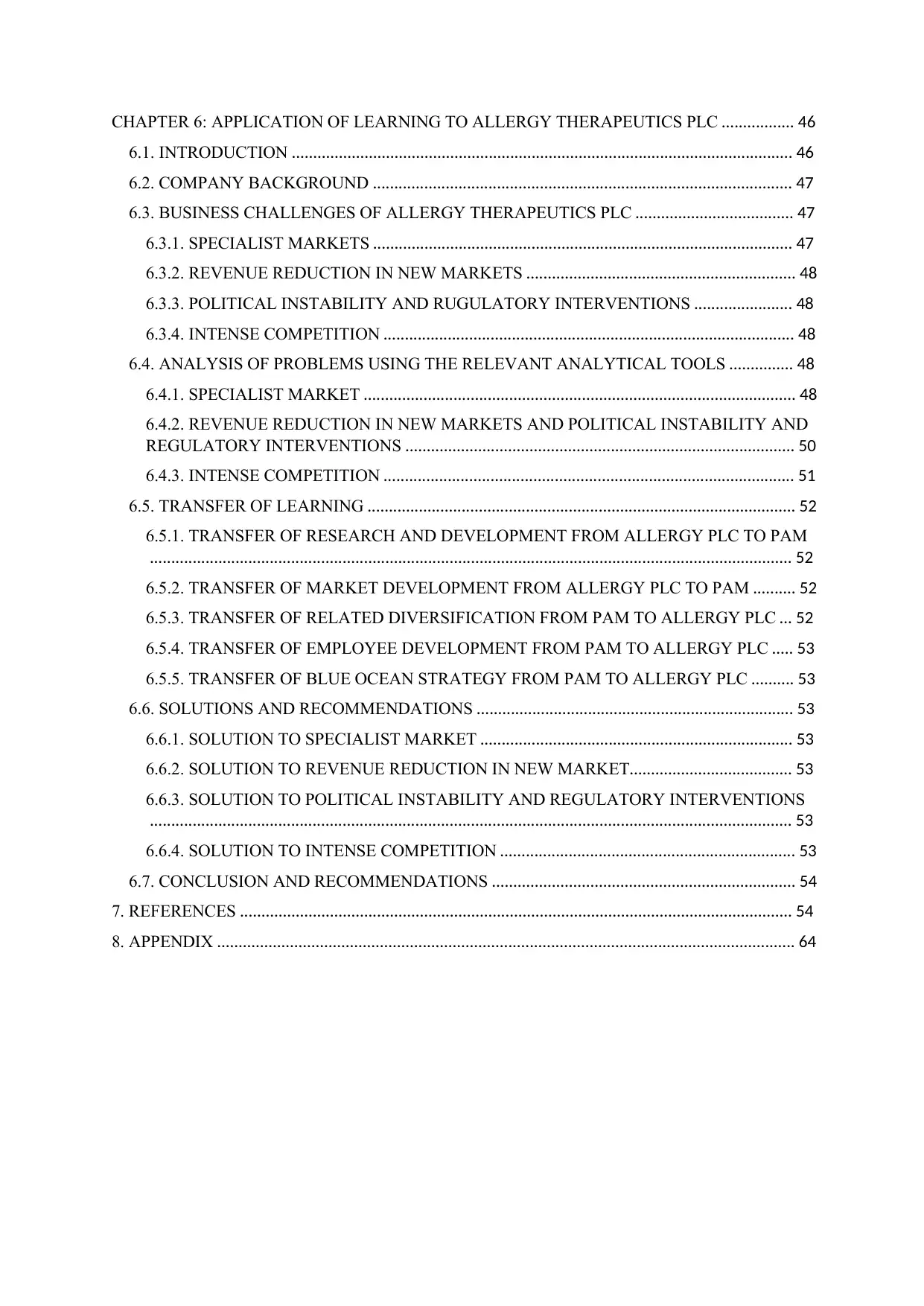
CHAPTER 6: APPLICATION OF LEARNING TO ALLERGY THERAPEUTICS PLC ................. 46
6.1. INTRODUCTION ..................................................................................................................... 46
6.2. COMPANY BACKGROUND .................................................................................................. 47
6.3. BUSINESS CHALLENGES OF ALLERGY THERAPEUTICS PLC ..................................... 47
6.3.1. SPECIALIST MARKETS .................................................................................................. 47
6.3.2. REVENUE REDUCTION IN NEW MARKETS ............................................................... 48
6.3.3. POLITICAL INSTABILITY AND RUGULATORY INTERVENTIONS ....................... 48
6.3.4. INTENSE COMPETITION ................................................................................................ 48
6.4. ANALYSIS OF PROBLEMS USING THE RELEVANT ANALYTICAL TOOLS ............... 48
6.4.1. SPECIALIST MARKET ..................................................................................................... 48
6.4.2. REVENUE REDUCTION IN NEW MARKETS AND POLITICAL INSTABILITY AND
REGULATORY INTERVENTIONS ........................................................................................... 50
6.4.3. INTENSE COMPETITION ................................................................................................ 51
6.5. TRANSFER OF LEARNING .................................................................................................... 52
6.5.1. TRANSFER OF RESEARCH AND DEVELOPMENT FROM ALLERGY PLC TO PAM
...................................................................................................................................................... 52
6.5.2. TRANSFER OF MARKET DEVELOPMENT FROM ALLERGY PLC TO PAM .......... 52
6.5.3. TRANSFER OF RELATED DIVERSIFICATION FROM PAM TO ALLERGY PLC ... 52
6.5.4. TRANSFER OF EMPLOYEE DEVELOPMENT FROM PAM TO ALLERGY PLC ..... 53
6.5.5. TRANSFER OF BLUE OCEAN STRATEGY FROM PAM TO ALLERGY PLC .......... 53
6.6. SOLUTIONS AND RECOMMENDATIONS .......................................................................... 53
6.6.1. SOLUTION TO SPECIALIST MARKET ......................................................................... 53
6.6.2. SOLUTION TO REVENUE REDUCTION IN NEW MARKET...................................... 53
6.6.3. SOLUTION TO POLITICAL INSTABILITY AND REGULATORY INTERVENTIONS
...................................................................................................................................................... 53
6.6.4. SOLUTION TO INTENSE COMPETITION ..................................................................... 53
6.7. CONCLUSION AND RECOMMENDATIONS ....................................................................... 54
7. REFERENCES ................................................................................................................................. 54
8. APPENDIX ....................................................................................................................................... 64
6.1. INTRODUCTION ..................................................................................................................... 46
6.2. COMPANY BACKGROUND .................................................................................................. 47
6.3. BUSINESS CHALLENGES OF ALLERGY THERAPEUTICS PLC ..................................... 47
6.3.1. SPECIALIST MARKETS .................................................................................................. 47
6.3.2. REVENUE REDUCTION IN NEW MARKETS ............................................................... 48
6.3.3. POLITICAL INSTABILITY AND RUGULATORY INTERVENTIONS ....................... 48
6.3.4. INTENSE COMPETITION ................................................................................................ 48
6.4. ANALYSIS OF PROBLEMS USING THE RELEVANT ANALYTICAL TOOLS ............... 48
6.4.1. SPECIALIST MARKET ..................................................................................................... 48
6.4.2. REVENUE REDUCTION IN NEW MARKETS AND POLITICAL INSTABILITY AND
REGULATORY INTERVENTIONS ........................................................................................... 50
6.4.3. INTENSE COMPETITION ................................................................................................ 51
6.5. TRANSFER OF LEARNING .................................................................................................... 52
6.5.1. TRANSFER OF RESEARCH AND DEVELOPMENT FROM ALLERGY PLC TO PAM
...................................................................................................................................................... 52
6.5.2. TRANSFER OF MARKET DEVELOPMENT FROM ALLERGY PLC TO PAM .......... 52
6.5.3. TRANSFER OF RELATED DIVERSIFICATION FROM PAM TO ALLERGY PLC ... 52
6.5.4. TRANSFER OF EMPLOYEE DEVELOPMENT FROM PAM TO ALLERGY PLC ..... 53
6.5.5. TRANSFER OF BLUE OCEAN STRATEGY FROM PAM TO ALLERGY PLC .......... 53
6.6. SOLUTIONS AND RECOMMENDATIONS .......................................................................... 53
6.6.1. SOLUTION TO SPECIALIST MARKET ......................................................................... 53
6.6.2. SOLUTION TO REVENUE REDUCTION IN NEW MARKET...................................... 53
6.6.3. SOLUTION TO POLITICAL INSTABILITY AND REGULATORY INTERVENTIONS
...................................................................................................................................................... 53
6.6.4. SOLUTION TO INTENSE COMPETITION ..................................................................... 53
6.7. CONCLUSION AND RECOMMENDATIONS ....................................................................... 54
7. REFERENCES ................................................................................................................................. 54
8. APPENDIX ....................................................................................................................................... 64
Secure Best Marks with AI Grader
Need help grading? Try our AI Grader for instant feedback on your assignments.
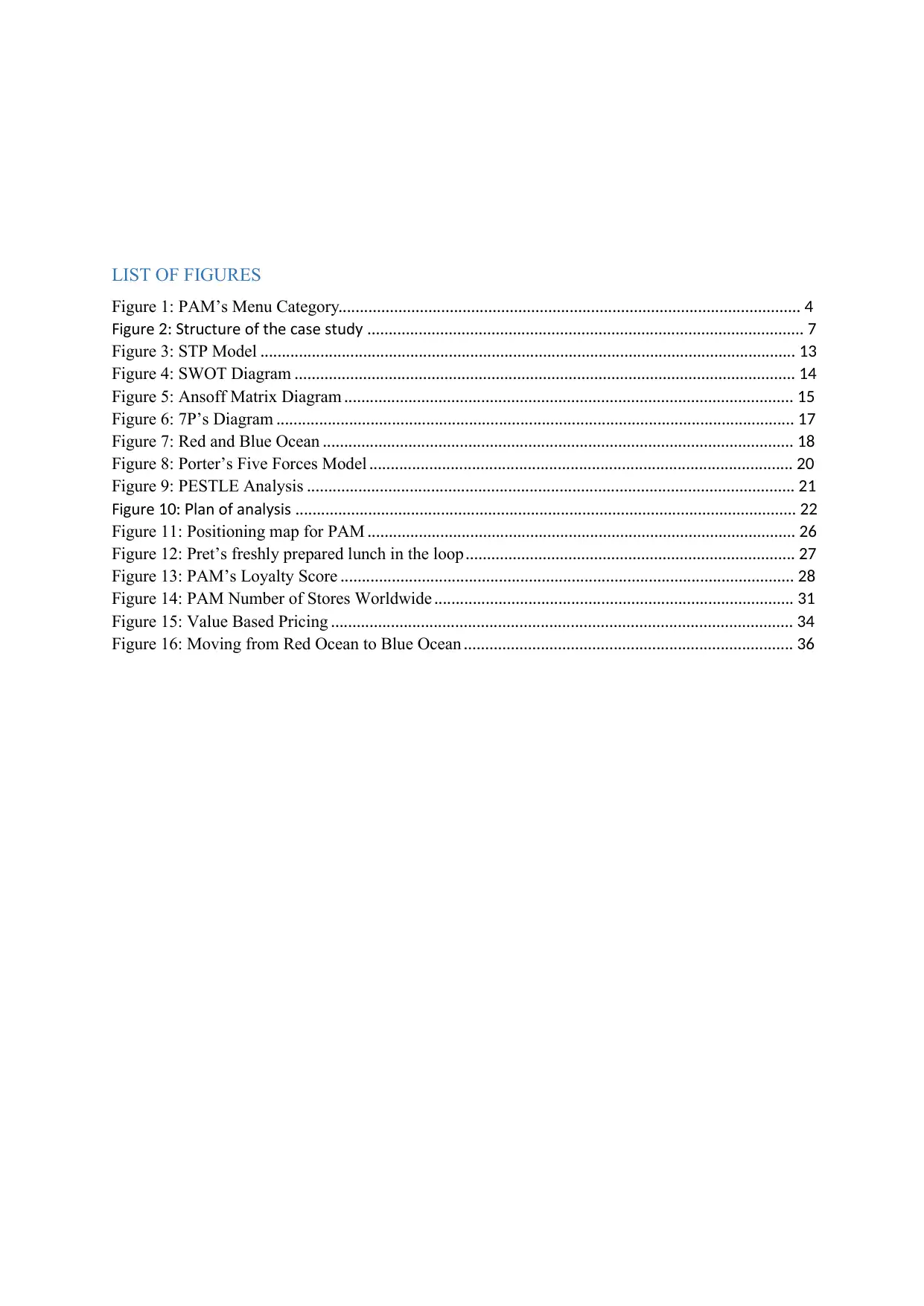
LIST OF FIGURES
Figure 1: PAM’s Menu Category............................................................................................................ 4
Figure tru ture of t e ase stud2: S c h c y ...................................................................................................... 7
Figure 3: STP Model ............................................................................................................................. 13
Figure 4: SWOT Diagram ..................................................................................................................... 14
Figure 5: Ansoff Matrix Diagram ......................................................................................................... 15
Figure 6: 7P’s Diagram ......................................................................................................................... 17
Figure 7: Red and Blue Ocean .............................................................................................................. 18
Figure 8: Porter’s Five Forces Model ................................................................................................... 20
Figure 9: PESTLE Analysis .................................................................................................................. 21
Figure lan of anal sis10: P y ..................................................................................................................... 22
Figure 11: Positioning map for PAM .................................................................................................... 26
Figure 12: Pret’s freshly prepared lunch in the loop............................................................................. 27
Figure 13: PAM’s Loyalty Score .......................................................................................................... 28
Figure 14: PAM Number of Stores Worldwide .................................................................................... 31
Figure 15: Value Based Pricing ............................................................................................................ 34
Figure 16: Moving from Red Ocean to Blue Ocean ............................................................................. 36
Figure 1: PAM’s Menu Category............................................................................................................ 4
Figure tru ture of t e ase stud2: S c h c y ...................................................................................................... 7
Figure 3: STP Model ............................................................................................................................. 13
Figure 4: SWOT Diagram ..................................................................................................................... 14
Figure 5: Ansoff Matrix Diagram ......................................................................................................... 15
Figure 6: 7P’s Diagram ......................................................................................................................... 17
Figure 7: Red and Blue Ocean .............................................................................................................. 18
Figure 8: Porter’s Five Forces Model ................................................................................................... 20
Figure 9: PESTLE Analysis .................................................................................................................. 21
Figure lan of anal sis10: P y ..................................................................................................................... 22
Figure 11: Positioning map for PAM .................................................................................................... 26
Figure 12: Pret’s freshly prepared lunch in the loop............................................................................. 27
Figure 13: PAM’s Loyalty Score .......................................................................................................... 28
Figure 14: PAM Number of Stores Worldwide .................................................................................... 31
Figure 15: Value Based Pricing ............................................................................................................ 34
Figure 16: Moving from Red Ocean to Blue Ocean ............................................................................. 36
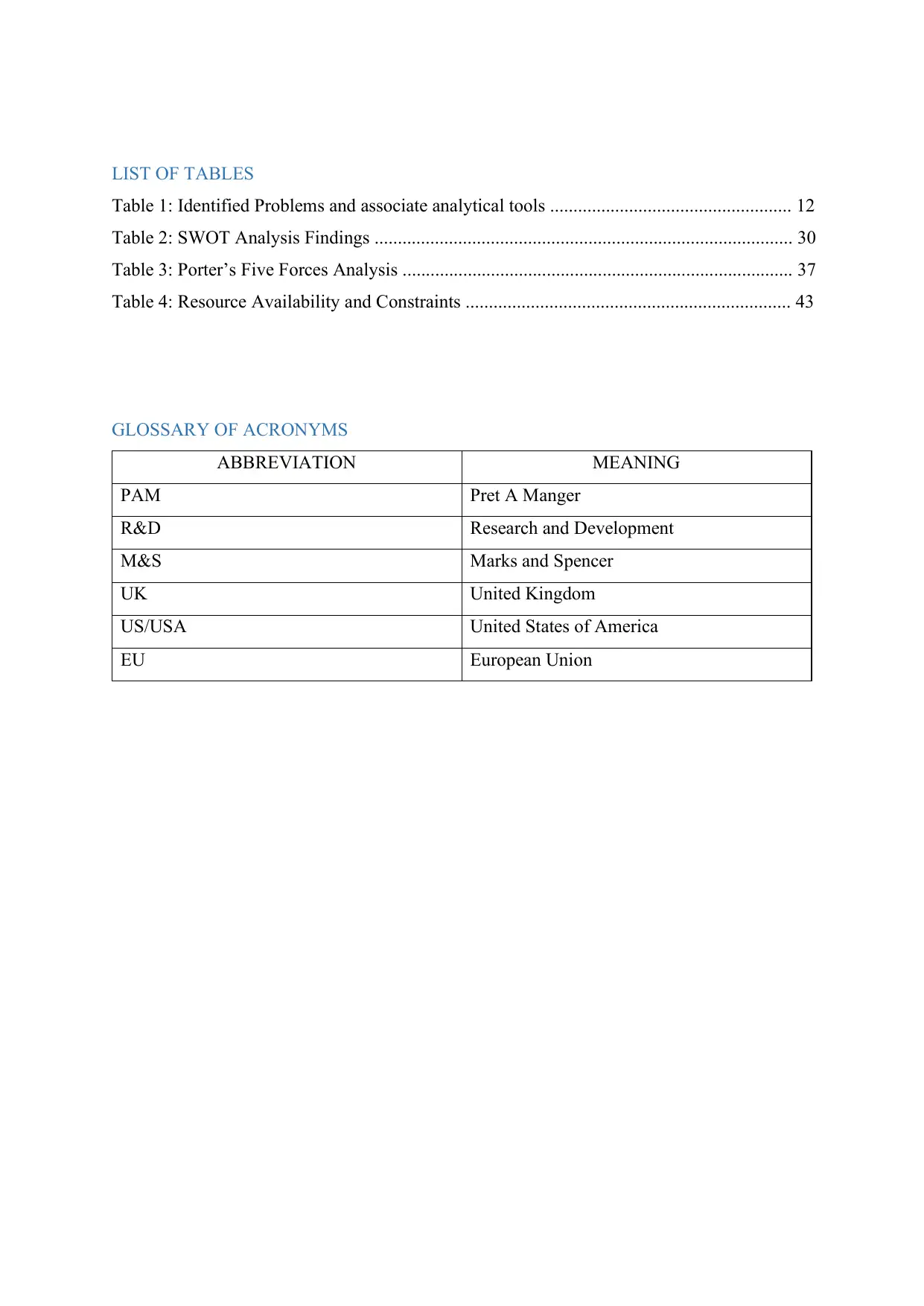
LIST OF TABLES
Table 1: Identified Problems and associate analytical tools .................................................... 12
Table 2: SWOT Analysis Findings .......................................................................................... 30
Table 3: Porter’s Five Forces Analysis .................................................................................... 37
Table 4: Resource Availability and Constraints ...................................................................... 43
GLOSSARY OF ACRONYMS
ABBREVIATION MEANING
PAM Pret A Manger
R&D Research and Development
M&S Marks and Spencer
UK United Kingdom
US/USA United States of America
EU European Union
Table 1: Identified Problems and associate analytical tools .................................................... 12
Table 2: SWOT Analysis Findings .......................................................................................... 30
Table 3: Porter’s Five Forces Analysis .................................................................................... 37
Table 4: Resource Availability and Constraints ...................................................................... 43
GLOSSARY OF ACRONYMS
ABBREVIATION MEANING
PAM Pret A Manger
R&D Research and Development
M&S Marks and Spencer
UK United Kingdom
US/USA United States of America
EU European Union
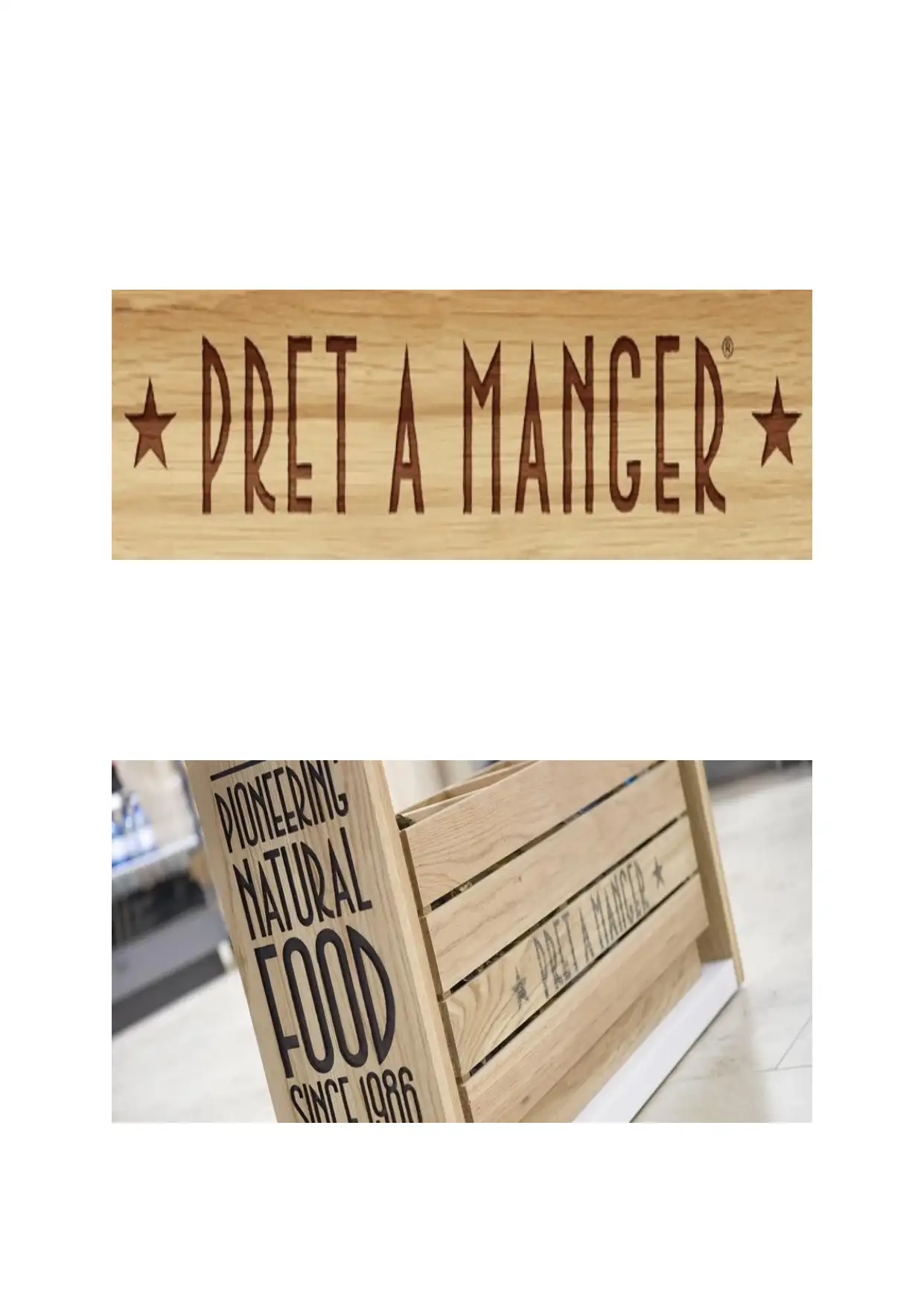
Paraphrase This Document
Need a fresh take? Get an instant paraphrase of this document with our AI Paraphraser
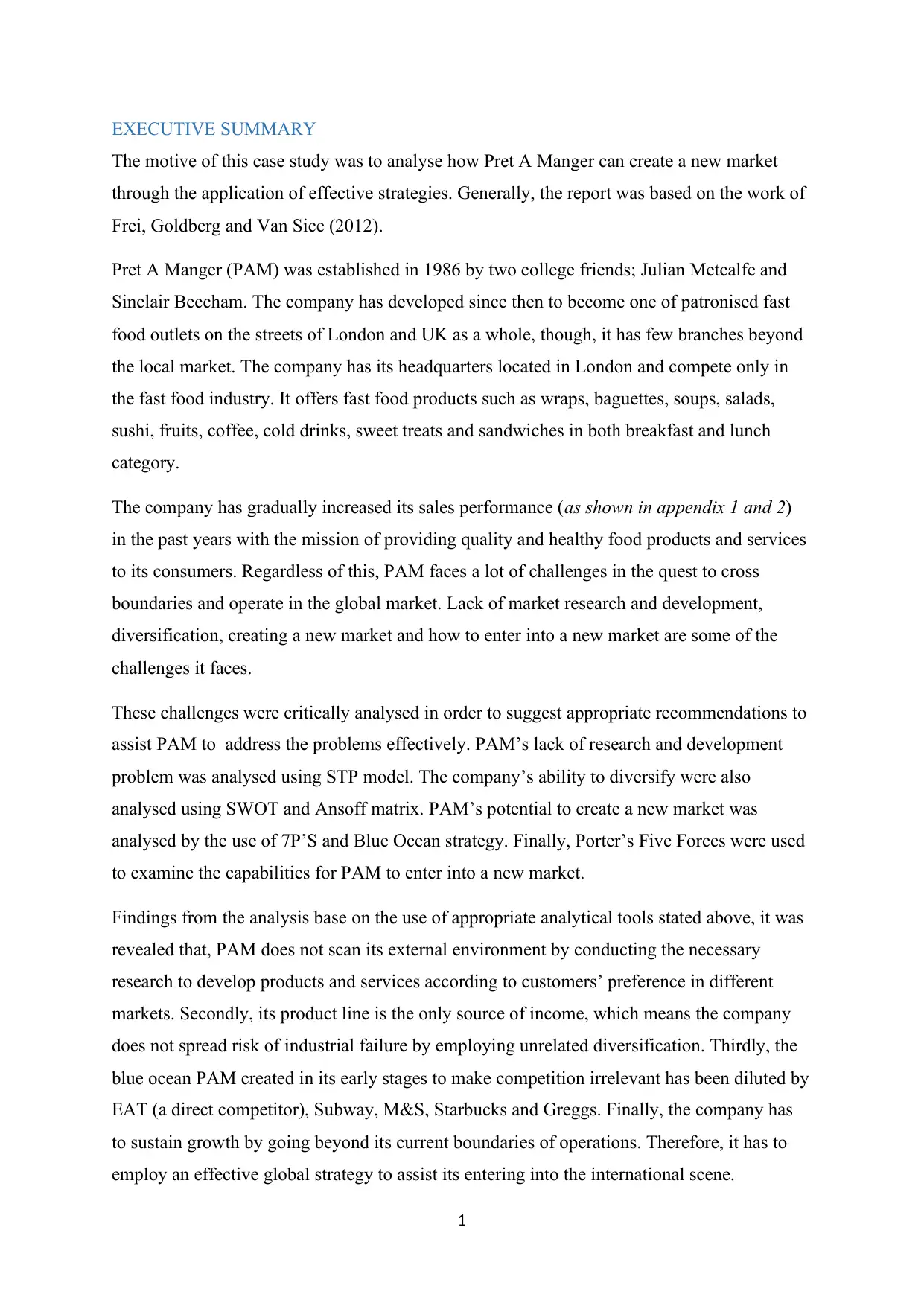
1
EXECUTIVE SUMMARY
The motive of this case study was to analyse how Pret A Manger can create a new market
through the application of effective strategies. Generally, the report was based on the work of
Frei, Goldberg and Van Sice (2012).
Pret A Manger (PAM) was established in 1986 by two college friends; Julian Metcalfe and
Sinclair Beecham. The company has developed since then to become one of patronised fast
food outlets on the streets of London and UK as a whole, though, it has few branches beyond
the local market. The company has its headquarters located in London and compete only in
the fast food industry. It offers fast food products such as wraps, baguettes, soups, salads,
sushi, fruits, coffee, cold drinks, sweet treats and sandwiches in both breakfast and lunch
category.
The company has gradually increased its sales performance (as shown in appendix 1 and 2)
in the past years with the mission of providing quality and healthy food products and services
to its consumers. Regardless of this, PAM faces a lot of challenges in the quest to cross
boundaries and operate in the global market. Lack of market research and development,
diversification, creating a new market and how to enter into a new market are some of the
challenges it faces.
These challenges were critically analysed in order to suggest appropriate recommendations to
assist PAM to address the problems effectively. PAM’s lack of research and development
problem was analysed using STP model. The company’s ability to diversify were also
analysed using SWOT and Ansoff matrix. PAM’s potential to create a new market was
analysed by the use of 7P’S and Blue Ocean strategy. Finally, Porter’s Five Forces were used
to examine the capabilities for PAM to enter into a new market.
Findings from the analysis base on the use of appropriate analytical tools stated above, it was
revealed that, PAM does not scan its external environment by conducting the necessary
research to develop products and services according to customers’ preference in different
markets. Secondly, its product line is the only source of income, which means the company
does not spread risk of industrial failure by employing unrelated diversification. Thirdly, the
blue ocean PAM created in its early stages to make competition irrelevant has been diluted by
EAT (a direct competitor), Subway, M&S, Starbucks and Greggs. Finally, the company has
to sustain growth by going beyond its current boundaries of operations. Therefore, it has to
employ an effective global strategy to assist its entering into the international scene.
EXECUTIVE SUMMARY
The motive of this case study was to analyse how Pret A Manger can create a new market
through the application of effective strategies. Generally, the report was based on the work of
Frei, Goldberg and Van Sice (2012).
Pret A Manger (PAM) was established in 1986 by two college friends; Julian Metcalfe and
Sinclair Beecham. The company has developed since then to become one of patronised fast
food outlets on the streets of London and UK as a whole, though, it has few branches beyond
the local market. The company has its headquarters located in London and compete only in
the fast food industry. It offers fast food products such as wraps, baguettes, soups, salads,
sushi, fruits, coffee, cold drinks, sweet treats and sandwiches in both breakfast and lunch
category.
The company has gradually increased its sales performance (as shown in appendix 1 and 2)
in the past years with the mission of providing quality and healthy food products and services
to its consumers. Regardless of this, PAM faces a lot of challenges in the quest to cross
boundaries and operate in the global market. Lack of market research and development,
diversification, creating a new market and how to enter into a new market are some of the
challenges it faces.
These challenges were critically analysed in order to suggest appropriate recommendations to
assist PAM to address the problems effectively. PAM’s lack of research and development
problem was analysed using STP model. The company’s ability to diversify were also
analysed using SWOT and Ansoff matrix. PAM’s potential to create a new market was
analysed by the use of 7P’S and Blue Ocean strategy. Finally, Porter’s Five Forces were used
to examine the capabilities for PAM to enter into a new market.
Findings from the analysis base on the use of appropriate analytical tools stated above, it was
revealed that, PAM does not scan its external environment by conducting the necessary
research to develop products and services according to customers’ preference in different
markets. Secondly, its product line is the only source of income, which means the company
does not spread risk of industrial failure by employing unrelated diversification. Thirdly, the
blue ocean PAM created in its early stages to make competition irrelevant has been diluted by
EAT (a direct competitor), Subway, M&S, Starbucks and Greggs. Finally, the company has
to sustain growth by going beyond its current boundaries of operations. Therefore, it has to
employ an effective global strategy to assist its entering into the international scene.
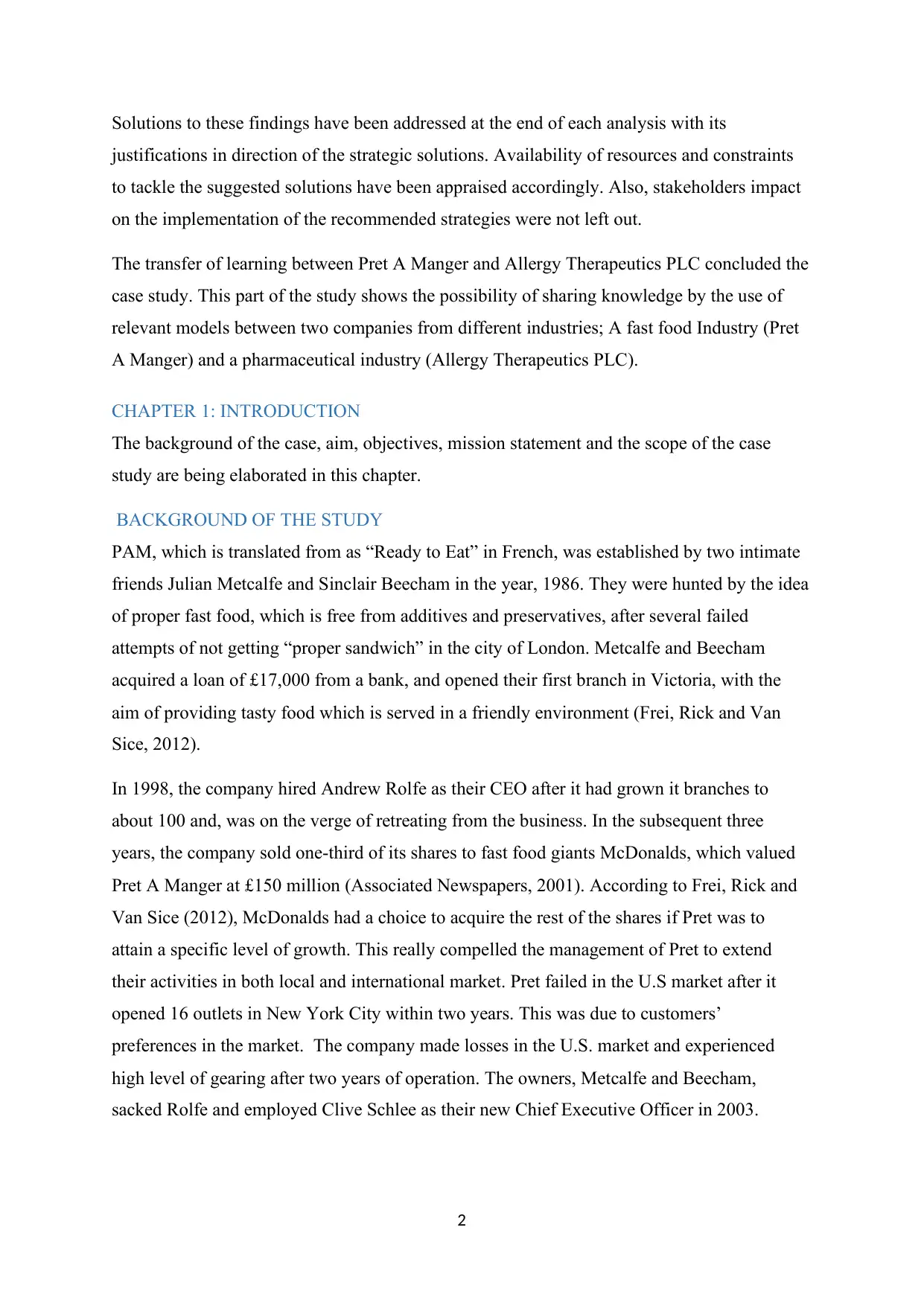
2
Solutions to these findings have been addressed at the end of each analysis with its
justifications in direction of the strategic solutions. Availability of resources and constraints
to tackle the suggested solutions have been appraised accordingly. Also, stakeholders impact
on the implementation of the recommended strategies were not left out.
The transfer of learning between Pret A Manger and Allergy Therapeutics PLC concluded the
case study. This part of the study shows the possibility of sharing knowledge by the use of
relevant models between two companies from different industries; A fast food Industry (Pret
A Manger) and a pharmaceutical industry (Allergy Therapeutics PLC).
CHAPTER 1: INTRODUCTION
The background of the case, aim, objectives, mission statement and the scope of the case
study are being elaborated in this chapter.
BACKGROUND OF THE STUDY
PAM, which is translated from as “Ready to Eat” in French, was established by two intimate
friends Julian Metcalfe and Sinclair Beecham in the year, 1986. They were hunted by the idea
of proper fast food, which is free from additives and preservatives, after several failed
attempts of not getting “proper sandwich” in the city of London. Metcalfe and Beecham
acquired a loan of £17,000 from a bank, and opened their first branch in Victoria, with the
aim of providing tasty food which is served in a friendly environment (Frei, Rick and Van
Sice, 2012).
In 1998, the company hired Andrew Rolfe as their CEO after it had grown it branches to
about 100 and, was on the verge of retreating from the business. In the subsequent three
years, the company sold one-third of its shares to fast food giants McDonalds, which valued
Pret A Manger at £150 million (Associated Newspapers, 2001). According to Frei, Rick and
Van Sice (2012), McDonalds had a choice to acquire the rest of the shares if Pret was to
attain a specific level of growth. This really compelled the management of Pret to extend
their activities in both local and international market. Pret failed in the U.S market after it
opened 16 outlets in New York City within two years. This was due to customers’
preferences in the market. The company made losses in the U.S. market and experienced
high level of gearing after two years of operation. The owners, Metcalfe and Beecham,
sacked Rolfe and employed Clive Schlee as their new Chief Executive Officer in 2003.
Solutions to these findings have been addressed at the end of each analysis with its
justifications in direction of the strategic solutions. Availability of resources and constraints
to tackle the suggested solutions have been appraised accordingly. Also, stakeholders impact
on the implementation of the recommended strategies were not left out.
The transfer of learning between Pret A Manger and Allergy Therapeutics PLC concluded the
case study. This part of the study shows the possibility of sharing knowledge by the use of
relevant models between two companies from different industries; A fast food Industry (Pret
A Manger) and a pharmaceutical industry (Allergy Therapeutics PLC).
CHAPTER 1: INTRODUCTION
The background of the case, aim, objectives, mission statement and the scope of the case
study are being elaborated in this chapter.
BACKGROUND OF THE STUDY
PAM, which is translated from as “Ready to Eat” in French, was established by two intimate
friends Julian Metcalfe and Sinclair Beecham in the year, 1986. They were hunted by the idea
of proper fast food, which is free from additives and preservatives, after several failed
attempts of not getting “proper sandwich” in the city of London. Metcalfe and Beecham
acquired a loan of £17,000 from a bank, and opened their first branch in Victoria, with the
aim of providing tasty food which is served in a friendly environment (Frei, Rick and Van
Sice, 2012).
In 1998, the company hired Andrew Rolfe as their CEO after it had grown it branches to
about 100 and, was on the verge of retreating from the business. In the subsequent three
years, the company sold one-third of its shares to fast food giants McDonalds, which valued
Pret A Manger at £150 million (Associated Newspapers, 2001). According to Frei, Rick and
Van Sice (2012), McDonalds had a choice to acquire the rest of the shares if Pret was to
attain a specific level of growth. This really compelled the management of Pret to extend
their activities in both local and international market. Pret failed in the U.S market after it
opened 16 outlets in New York City within two years. This was due to customers’
preferences in the market. The company made losses in the U.S. market and experienced
high level of gearing after two years of operation. The owners, Metcalfe and Beecham,
sacked Rolfe and employed Clive Schlee as their new Chief Executive Officer in 2003.
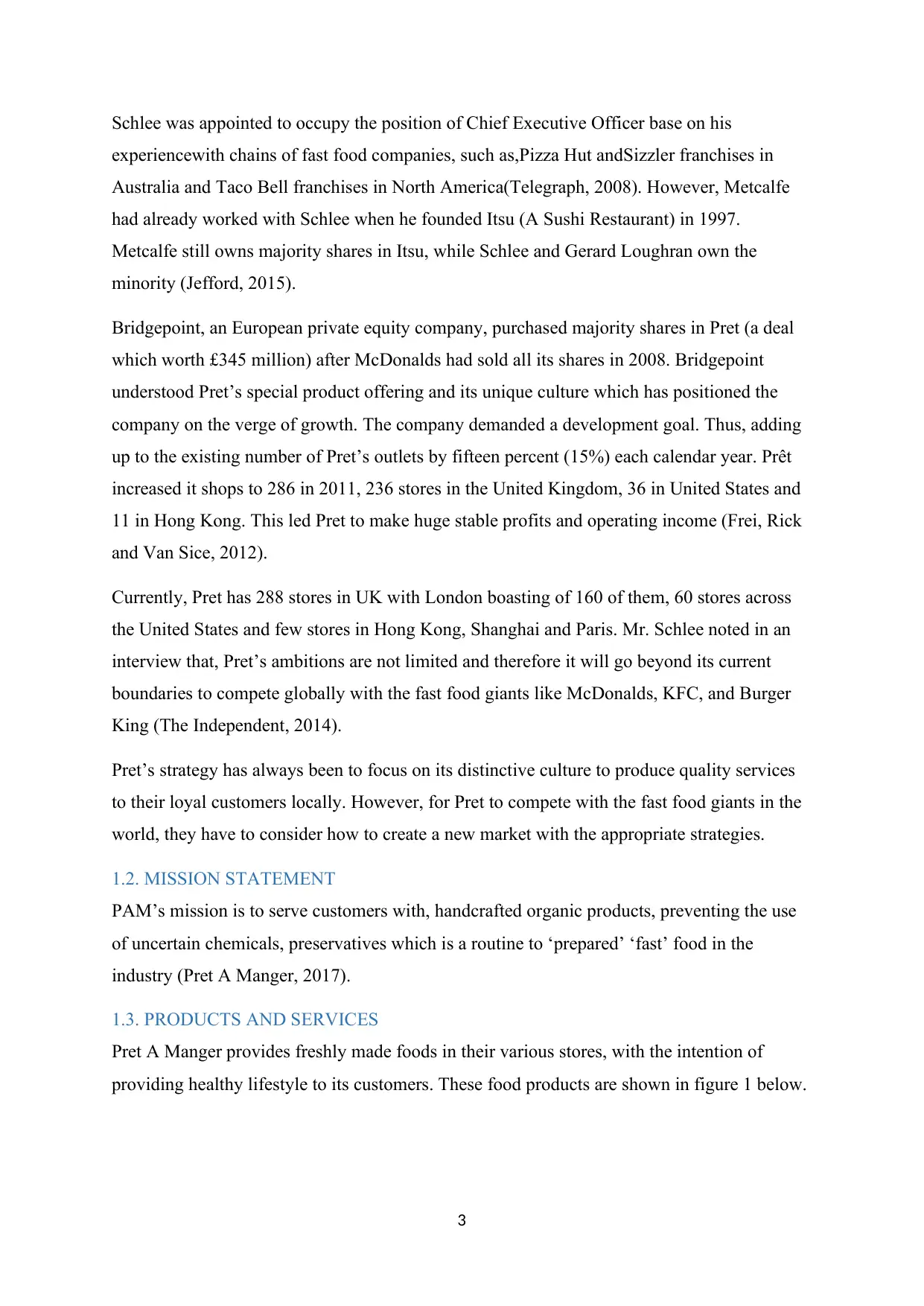
3
Schlee was appointed to occupy the position of Chief Executive Officer base on his
experiencewith chains of fast food companies, such as,Pizza Hut andSizzler franchises in
Australia and Taco Bell franchises in North America(Telegraph, 2008). However, Metcalfe
had already worked with Schlee when he founded Itsu (A Sushi Restaurant) in 1997.
Metcalfe still owns majority shares in Itsu, while Schlee and Gerard Loughran own the
minority (Jefford, 2015).
Bridgepoint, an European private equity company, purchased majority shares in Pret (a deal
which worth £345 million) after McDonalds had sold all its shares in 2008. Bridgepoint
understood Pret’s special product offering and its unique culture which has positioned the
company on the verge of growth. The company demanded a development goal. Thus, adding
up to the existing number of Pret’s outlets by fifteen percent (15%) each calendar year. Prêt
increased it shops to 286 in 2011, 236 stores in the United Kingdom, 36 in United States and
11 in Hong Kong. This led Pret to make huge stable profits and operating income (Frei, Rick
and Van Sice, 2012).
Currently, Pret has 288 stores in UK with London boasting of 160 of them, 60 stores across
the United States and few stores in Hong Kong, Shanghai and Paris. Mr. Schlee noted in an
interview that, Pret’s ambitions are not limited and therefore it will go beyond its current
boundaries to compete globally with the fast food giants like McDonalds, KFC, and Burger
King (The Independent, 2014).
Pret’s strategy has always been to focus on its distinctive culture to produce quality services
to their loyal customers locally. However, for Pret to compete with the fast food giants in the
world, they have to consider how to create a new market with the appropriate strategies.
1.2. MISSION STATEMENT
PAM’s mission is to serve customers with, handcrafted organic products, preventing the use
of uncertain chemicals, preservatives which is a routine to ‘prepared’ ‘fast’ food in the
industry (Pret A Manger, 2017).
1.3. PRODUCTS AND SERVICES
Pret A Manger provides freshly made foods in their various stores, with the intention of
providing healthy lifestyle to its customers. These food products are shown in figure 1 below.
Schlee was appointed to occupy the position of Chief Executive Officer base on his
experiencewith chains of fast food companies, such as,Pizza Hut andSizzler franchises in
Australia and Taco Bell franchises in North America(Telegraph, 2008). However, Metcalfe
had already worked with Schlee when he founded Itsu (A Sushi Restaurant) in 1997.
Metcalfe still owns majority shares in Itsu, while Schlee and Gerard Loughran own the
minority (Jefford, 2015).
Bridgepoint, an European private equity company, purchased majority shares in Pret (a deal
which worth £345 million) after McDonalds had sold all its shares in 2008. Bridgepoint
understood Pret’s special product offering and its unique culture which has positioned the
company on the verge of growth. The company demanded a development goal. Thus, adding
up to the existing number of Pret’s outlets by fifteen percent (15%) each calendar year. Prêt
increased it shops to 286 in 2011, 236 stores in the United Kingdom, 36 in United States and
11 in Hong Kong. This led Pret to make huge stable profits and operating income (Frei, Rick
and Van Sice, 2012).
Currently, Pret has 288 stores in UK with London boasting of 160 of them, 60 stores across
the United States and few stores in Hong Kong, Shanghai and Paris. Mr. Schlee noted in an
interview that, Pret’s ambitions are not limited and therefore it will go beyond its current
boundaries to compete globally with the fast food giants like McDonalds, KFC, and Burger
King (The Independent, 2014).
Pret’s strategy has always been to focus on its distinctive culture to produce quality services
to their loyal customers locally. However, for Pret to compete with the fast food giants in the
world, they have to consider how to create a new market with the appropriate strategies.
1.2. MISSION STATEMENT
PAM’s mission is to serve customers with, handcrafted organic products, preventing the use
of uncertain chemicals, preservatives which is a routine to ‘prepared’ ‘fast’ food in the
industry (Pret A Manger, 2017).
1.3. PRODUCTS AND SERVICES
Pret A Manger provides freshly made foods in their various stores, with the intention of
providing healthy lifestyle to its customers. These food products are shown in figure 1 below.
Secure Best Marks with AI Grader
Need help grading? Try our AI Grader for instant feedback on your assignments.
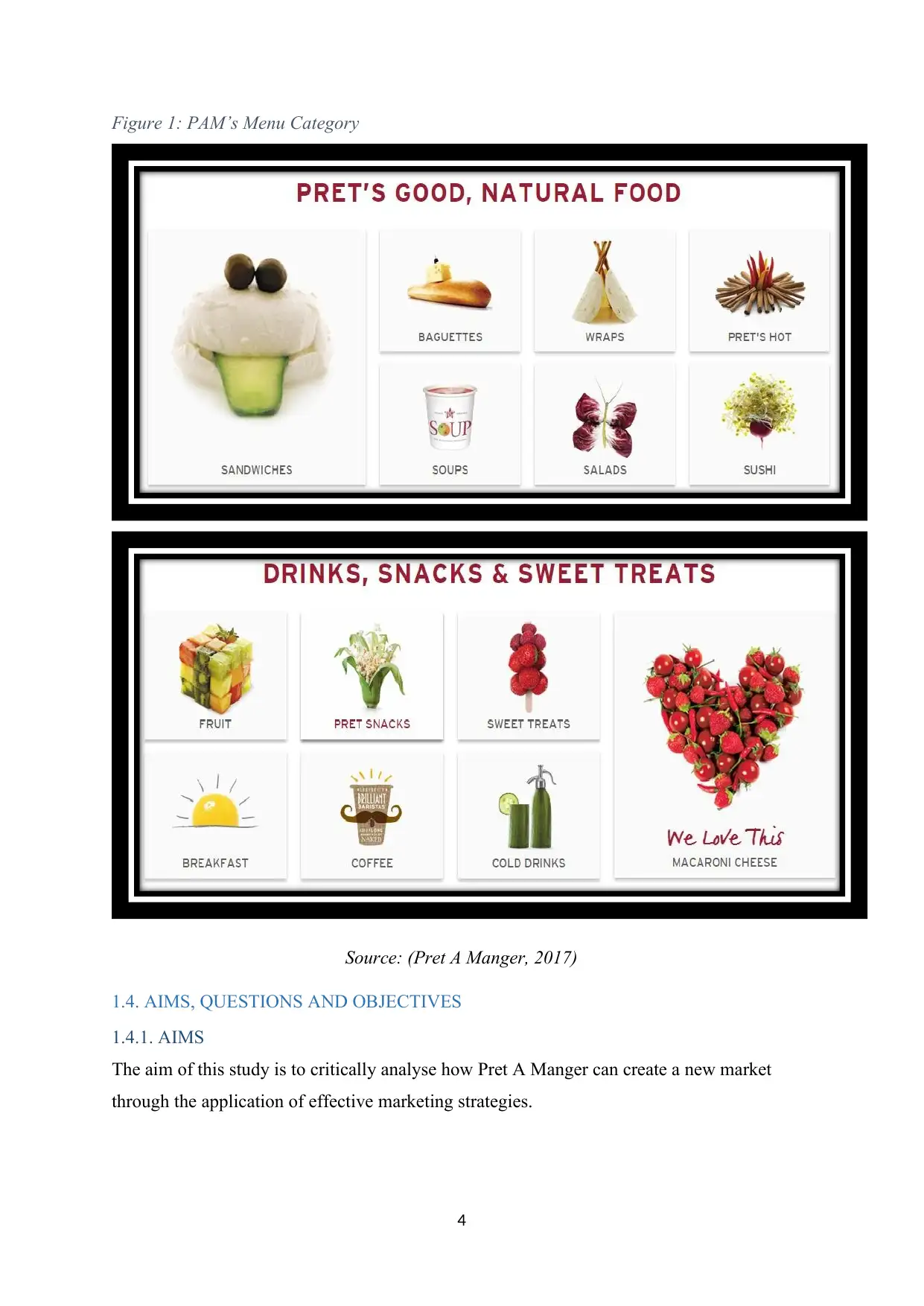
4
Figure 1: PAM’s Menu Category
Source: (Pret A Manger, 2017)
1.4. AIMS, QUESTIONS AND OBJECTIVES
1.4.1. AIMS
The aim of this study is to critically analyse how Pret A Manger can create a new market
through the application of effective marketing strategies.
Figure 1: PAM’s Menu Category
Source: (Pret A Manger, 2017)
1.4. AIMS, QUESTIONS AND OBJECTIVES
1.4.1. AIMS
The aim of this study is to critically analyse how Pret A Manger can create a new market
through the application of effective marketing strategies.
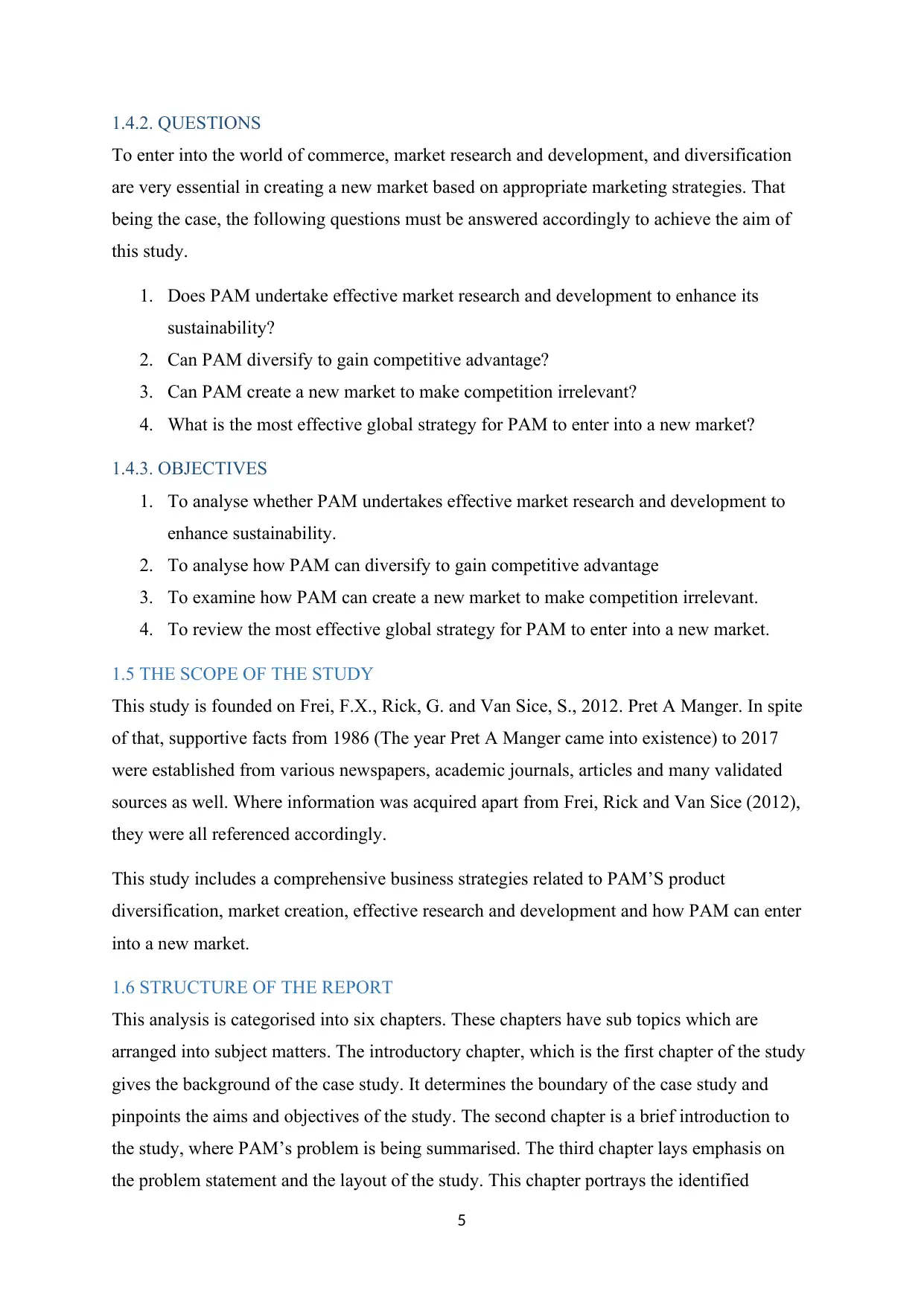
5
1.4.2. QUESTIONS
To enter into the world of commerce, market research and development, and diversification
are very essential in creating a new market based on appropriate marketing strategies. That
being the case, the following questions must be answered accordingly to achieve the aim of
this study.
1. Does PAM undertake effective market research and development to enhance its
sustainability?
2. Can PAM diversify to gain competitive advantage?
3. Can PAM create a new market to make competition irrelevant?
4. What is the most effective global strategy for PAM to enter into a new market?
1.4.3. OBJECTIVES
1. To analyse whether PAM undertakes effective market research and development to
enhance sustainability.
2. To analyse how PAM can diversify to gain competitive advantage
3. To examine how PAM can create a new market to make competition irrelevant.
4. To review the most effective global strategy for PAM to enter into a new market.
1.5 THE SCOPE OF THE STUDY
This study is founded on Frei, F.X., Rick, G. and Van Sice, S., 2012. Pret A Manger. In spite
of that, supportive facts from 1986 (The year Pret A Manger came into existence) to 2017
were established from various newspapers, academic journals, articles and many validated
sources as well. Where information was acquired apart from Frei, Rick and Van Sice (2012),
they were all referenced accordingly.
This study includes a comprehensive business strategies related to PAM’S product
diversification, market creation, effective research and development and how PAM can enter
into a new market.
1.6 STRUCTURE OF THE REPORT
This analysis is categorised into six chapters. These chapters have sub topics which are
arranged into subject matters. The introductory chapter, which is the first chapter of the study
gives the background of the case study. It determines the boundary of the case study and
pinpoints the aims and objectives of the study. The second chapter is a brief introduction to
the study, where PAM’s problem is being summarised. The third chapter lays emphasis on
the problem statement and the layout of the study. This chapter portrays the identified
1.4.2. QUESTIONS
To enter into the world of commerce, market research and development, and diversification
are very essential in creating a new market based on appropriate marketing strategies. That
being the case, the following questions must be answered accordingly to achieve the aim of
this study.
1. Does PAM undertake effective market research and development to enhance its
sustainability?
2. Can PAM diversify to gain competitive advantage?
3. Can PAM create a new market to make competition irrelevant?
4. What is the most effective global strategy for PAM to enter into a new market?
1.4.3. OBJECTIVES
1. To analyse whether PAM undertakes effective market research and development to
enhance sustainability.
2. To analyse how PAM can diversify to gain competitive advantage
3. To examine how PAM can create a new market to make competition irrelevant.
4. To review the most effective global strategy for PAM to enter into a new market.
1.5 THE SCOPE OF THE STUDY
This study is founded on Frei, F.X., Rick, G. and Van Sice, S., 2012. Pret A Manger. In spite
of that, supportive facts from 1986 (The year Pret A Manger came into existence) to 2017
were established from various newspapers, academic journals, articles and many validated
sources as well. Where information was acquired apart from Frei, Rick and Van Sice (2012),
they were all referenced accordingly.
This study includes a comprehensive business strategies related to PAM’S product
diversification, market creation, effective research and development and how PAM can enter
into a new market.
1.6 STRUCTURE OF THE REPORT
This analysis is categorised into six chapters. These chapters have sub topics which are
arranged into subject matters. The introductory chapter, which is the first chapter of the study
gives the background of the case study. It determines the boundary of the case study and
pinpoints the aims and objectives of the study. The second chapter is a brief introduction to
the study, where PAM’s problem is being summarised. The third chapter lays emphasis on
the problem statement and the layout of the study. This chapter portrays the identified
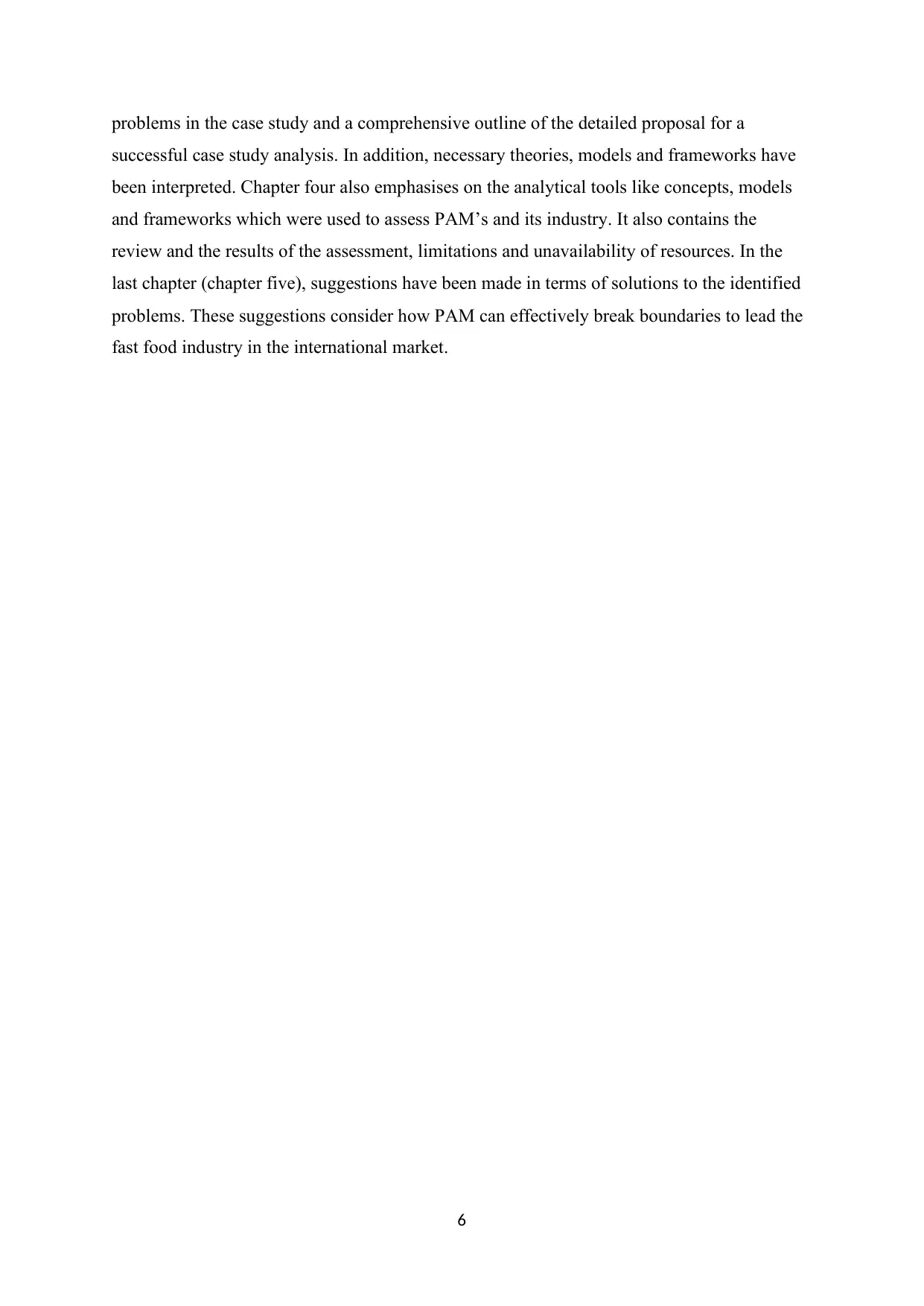
6
problems in the case study and a comprehensive outline of the detailed proposal for a
successful case study analysis. In addition, necessary theories, models and frameworks have
been interpreted. Chapter four also emphasises on the analytical tools like concepts, models
and frameworks which were used to assess PAM’s and its industry. It also contains the
review and the results of the assessment, limitations and unavailability of resources. In the
last chapter (chapter five), suggestions have been made in terms of solutions to the identified
problems. These suggestions consider how PAM can effectively break boundaries to lead the
fast food industry in the international market.
problems in the case study and a comprehensive outline of the detailed proposal for a
successful case study analysis. In addition, necessary theories, models and frameworks have
been interpreted. Chapter four also emphasises on the analytical tools like concepts, models
and frameworks which were used to assess PAM’s and its industry. It also contains the
review and the results of the assessment, limitations and unavailability of resources. In the
last chapter (chapter five), suggestions have been made in terms of solutions to the identified
problems. These suggestions consider how PAM can effectively break boundaries to lead the
fast food industry in the international market.
Paraphrase This Document
Need a fresh take? Get an instant paraphrase of this document with our AI Paraphraser
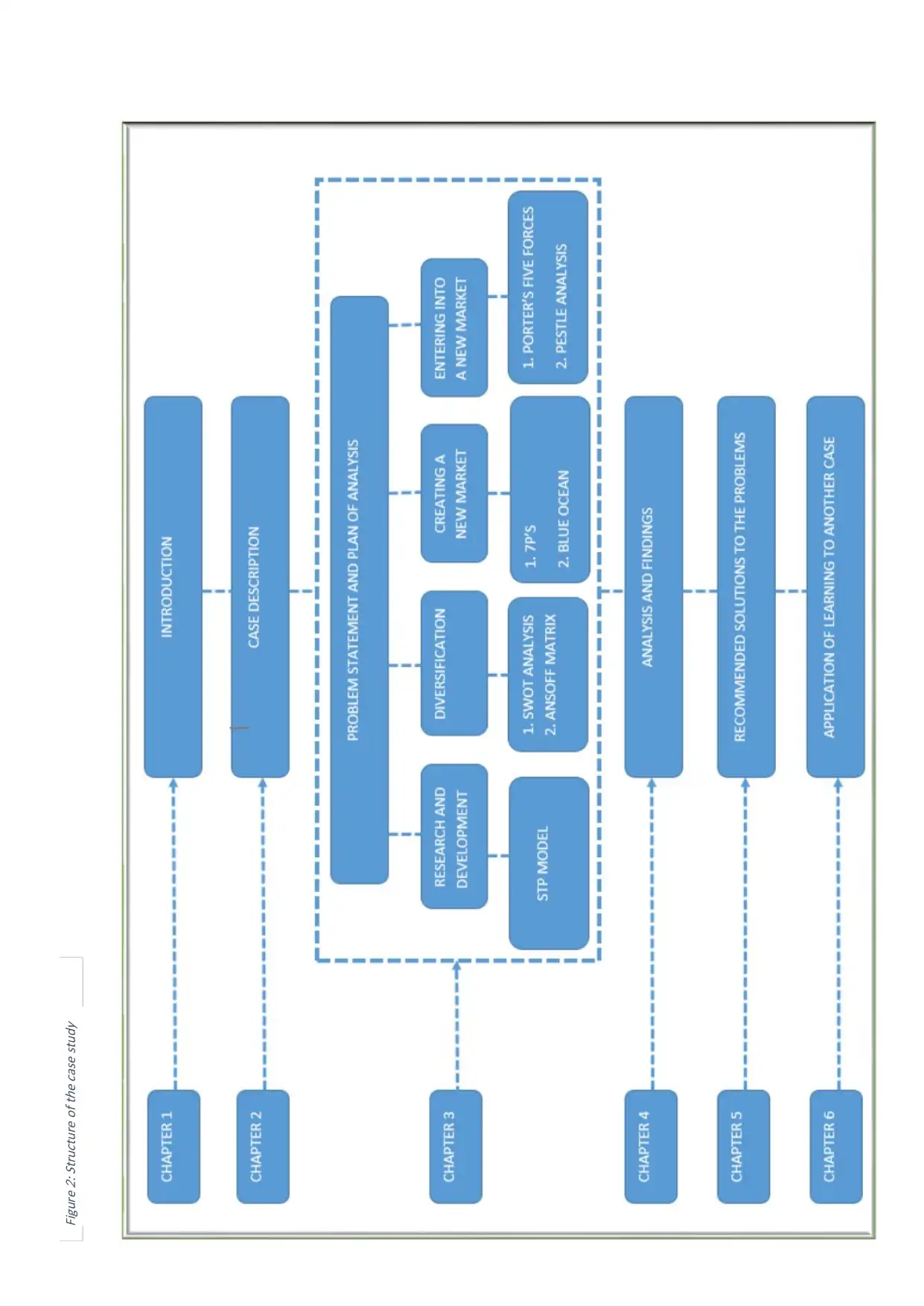
7
Figure tru ture of t e ase stud
2: S c h c y
Figure tru ture of t e ase stud
2: S c h c y
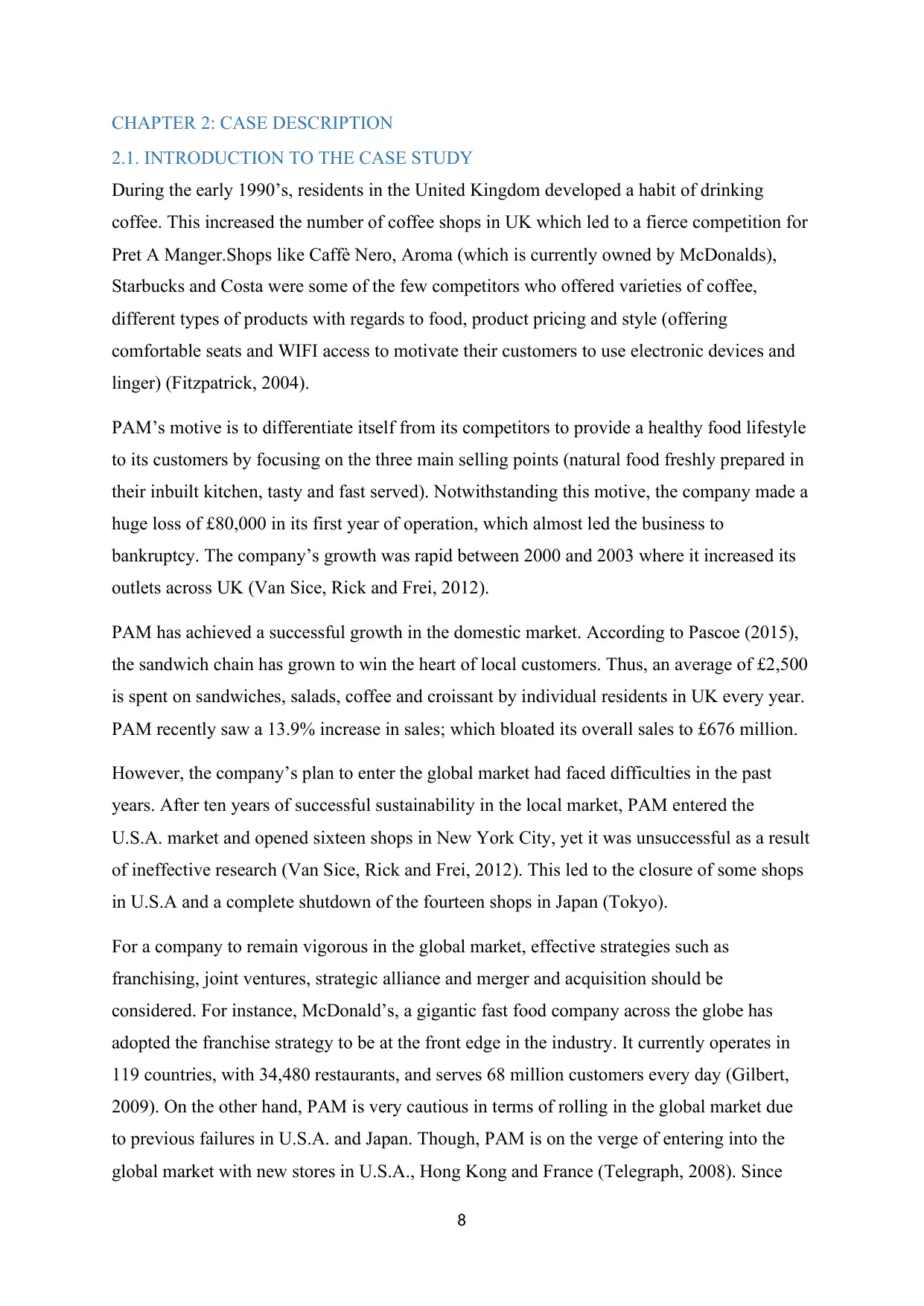
8
CHAPTER 2: CASE DESCRIPTION
2.1. INTRODUCTION TO THE CASE STUDY
During the early 1990’s, residents in the United Kingdom developed a habit of drinking
coffee. This increased the number of coffee shops in UK which led to a fierce competition for
Pret A Manger.Shops like Caffè Nero, Aroma (which is currently owned by McDonalds),
Starbucks and Costa were some of the few competitors who offered varieties of coffee,
different types of products with regards to food, product pricing and style (offering
comfortable seats and WIFI access to motivate their customers to use electronic devices and
linger) (Fitzpatrick, 2004).
PAM’s motive is to differentiate itself from its competitors to provide a healthy food lifestyle
to its customers by focusing on the three main selling points (natural food freshly prepared in
their inbuilt kitchen, tasty and fast served). Notwithstanding this motive, the company made a
huge loss of £80,000 in its first year of operation, which almost led the business to
bankruptcy. The company’s growth was rapid between 2000 and 2003 where it increased its
outlets across UK (Van Sice, Rick and Frei, 2012).
PAM has achieved a successful growth in the domestic market. According to Pascoe (2015),
the sandwich chain has grown to win the heart of local customers. Thus, an average of £2,500
is spent on sandwiches, salads, coffee and croissant by individual residents in UK every year.
PAM recently saw a 13.9% increase in sales; which bloated its overall sales to £676 million.
However, the company’s plan to enter the global market had faced difficulties in the past
years. After ten years of successful sustainability in the local market, PAM entered the
U.S.A. market and opened sixteen shops in New York City, yet it was unsuccessful as a result
of ineffective research (Van Sice, Rick and Frei, 2012). This led to the closure of some shops
in U.S.A and a complete shutdown of the fourteen shops in Japan (Tokyo).
For a company to remain vigorous in the global market, effective strategies such as
franchising, joint ventures, strategic alliance and merger and acquisition should be
considered. For instance, McDonald’s, a gigantic fast food company across the globe has
adopted the franchise strategy to be at the front edge in the industry. It currently operates in
119 countries, with 34,480 restaurants, and serves 68 million customers every day (Gilbert,
2009). On the other hand, PAM is very cautious in terms of rolling in the global market due
to previous failures in U.S.A. and Japan. Though, PAM is on the verge of entering into the
global market with new stores in U.S.A., Hong Kong and France (Telegraph, 2008). Since
CHAPTER 2: CASE DESCRIPTION
2.1. INTRODUCTION TO THE CASE STUDY
During the early 1990’s, residents in the United Kingdom developed a habit of drinking
coffee. This increased the number of coffee shops in UK which led to a fierce competition for
Pret A Manger.Shops like Caffè Nero, Aroma (which is currently owned by McDonalds),
Starbucks and Costa were some of the few competitors who offered varieties of coffee,
different types of products with regards to food, product pricing and style (offering
comfortable seats and WIFI access to motivate their customers to use electronic devices and
linger) (Fitzpatrick, 2004).
PAM’s motive is to differentiate itself from its competitors to provide a healthy food lifestyle
to its customers by focusing on the three main selling points (natural food freshly prepared in
their inbuilt kitchen, tasty and fast served). Notwithstanding this motive, the company made a
huge loss of £80,000 in its first year of operation, which almost led the business to
bankruptcy. The company’s growth was rapid between 2000 and 2003 where it increased its
outlets across UK (Van Sice, Rick and Frei, 2012).
PAM has achieved a successful growth in the domestic market. According to Pascoe (2015),
the sandwich chain has grown to win the heart of local customers. Thus, an average of £2,500
is spent on sandwiches, salads, coffee and croissant by individual residents in UK every year.
PAM recently saw a 13.9% increase in sales; which bloated its overall sales to £676 million.
However, the company’s plan to enter the global market had faced difficulties in the past
years. After ten years of successful sustainability in the local market, PAM entered the
U.S.A. market and opened sixteen shops in New York City, yet it was unsuccessful as a result
of ineffective research (Van Sice, Rick and Frei, 2012). This led to the closure of some shops
in U.S.A and a complete shutdown of the fourteen shops in Japan (Tokyo).
For a company to remain vigorous in the global market, effective strategies such as
franchising, joint ventures, strategic alliance and merger and acquisition should be
considered. For instance, McDonald’s, a gigantic fast food company across the globe has
adopted the franchise strategy to be at the front edge in the industry. It currently operates in
119 countries, with 34,480 restaurants, and serves 68 million customers every day (Gilbert,
2009). On the other hand, PAM is very cautious in terms of rolling in the global market due
to previous failures in U.S.A. and Japan. Though, PAM is on the verge of entering into the
global market with new stores in U.S.A., Hong Kong and France (Telegraph, 2008). Since
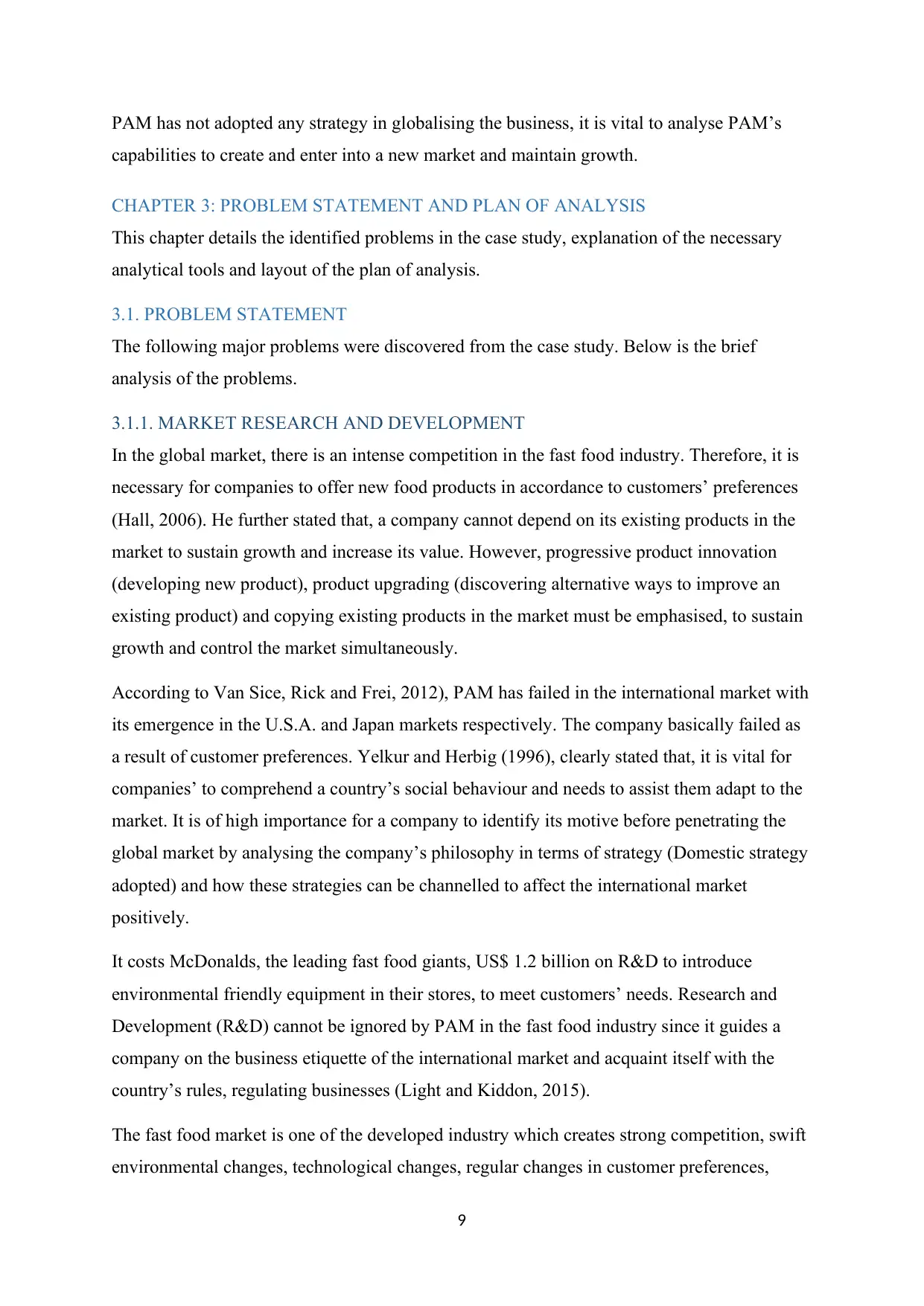
9
PAM has not adopted any strategy in globalising the business, it is vital to analyse PAM’s
capabilities to create and enter into a new market and maintain growth.
CHAPTER 3: PROBLEM STATEMENT AND PLAN OF ANALYSIS
This chapter details the identified problems in the case study, explanation of the necessary
analytical tools and layout of the plan of analysis.
3.1. PROBLEM STATEMENT
The following major problems were discovered from the case study. Below is the brief
analysis of the problems.
3.1.1. MARKET RESEARCH AND DEVELOPMENT
In the global market, there is an intense competition in the fast food industry. Therefore, it is
necessary for companies to offer new food products in accordance to customers’ preferences
(Hall, 2006). He further stated that, a company cannot depend on its existing products in the
market to sustain growth and increase its value. However, progressive product innovation
(developing new product), product upgrading (discovering alternative ways to improve an
existing product) and copying existing products in the market must be emphasised, to sustain
growth and control the market simultaneously.
According to Van Sice, Rick and Frei, 2012), PAM has failed in the international market with
its emergence in the U.S.A. and Japan markets respectively. The company basically failed as
a result of customer preferences. Yelkur and Herbig (1996), clearly stated that, it is vital for
companies’ to comprehend a country’s social behaviour and needs to assist them adapt to the
market. It is of high importance for a company to identify its motive before penetrating the
global market by analysing the company’s philosophy in terms of strategy (Domestic strategy
adopted) and how these strategies can be channelled to affect the international market
positively.
It costs McDonalds, the leading fast food giants, US$ 1.2 billion on R&D to introduce
environmental friendly equipment in their stores, to meet customers’ needs. Research and
Development (R&D) cannot be ignored by PAM in the fast food industry since it guides a
company on the business etiquette of the international market and acquaint itself with the
country’s rules, regulating businesses (Light and Kiddon, 2015).
The fast food market is one of the developed industry which creates strong competition, swift
environmental changes, technological changes, regular changes in customer preferences,
PAM has not adopted any strategy in globalising the business, it is vital to analyse PAM’s
capabilities to create and enter into a new market and maintain growth.
CHAPTER 3: PROBLEM STATEMENT AND PLAN OF ANALYSIS
This chapter details the identified problems in the case study, explanation of the necessary
analytical tools and layout of the plan of analysis.
3.1. PROBLEM STATEMENT
The following major problems were discovered from the case study. Below is the brief
analysis of the problems.
3.1.1. MARKET RESEARCH AND DEVELOPMENT
In the global market, there is an intense competition in the fast food industry. Therefore, it is
necessary for companies to offer new food products in accordance to customers’ preferences
(Hall, 2006). He further stated that, a company cannot depend on its existing products in the
market to sustain growth and increase its value. However, progressive product innovation
(developing new product), product upgrading (discovering alternative ways to improve an
existing product) and copying existing products in the market must be emphasised, to sustain
growth and control the market simultaneously.
According to Van Sice, Rick and Frei, 2012), PAM has failed in the international market with
its emergence in the U.S.A. and Japan markets respectively. The company basically failed as
a result of customer preferences. Yelkur and Herbig (1996), clearly stated that, it is vital for
companies’ to comprehend a country’s social behaviour and needs to assist them adapt to the
market. It is of high importance for a company to identify its motive before penetrating the
global market by analysing the company’s philosophy in terms of strategy (Domestic strategy
adopted) and how these strategies can be channelled to affect the international market
positively.
It costs McDonalds, the leading fast food giants, US$ 1.2 billion on R&D to introduce
environmental friendly equipment in their stores, to meet customers’ needs. Research and
Development (R&D) cannot be ignored by PAM in the fast food industry since it guides a
company on the business etiquette of the international market and acquaint itself with the
country’s rules, regulating businesses (Light and Kiddon, 2015).
The fast food market is one of the developed industry which creates strong competition, swift
environmental changes, technological changes, regular changes in customer preferences,
Secure Best Marks with AI Grader
Need help grading? Try our AI Grader for instant feedback on your assignments.
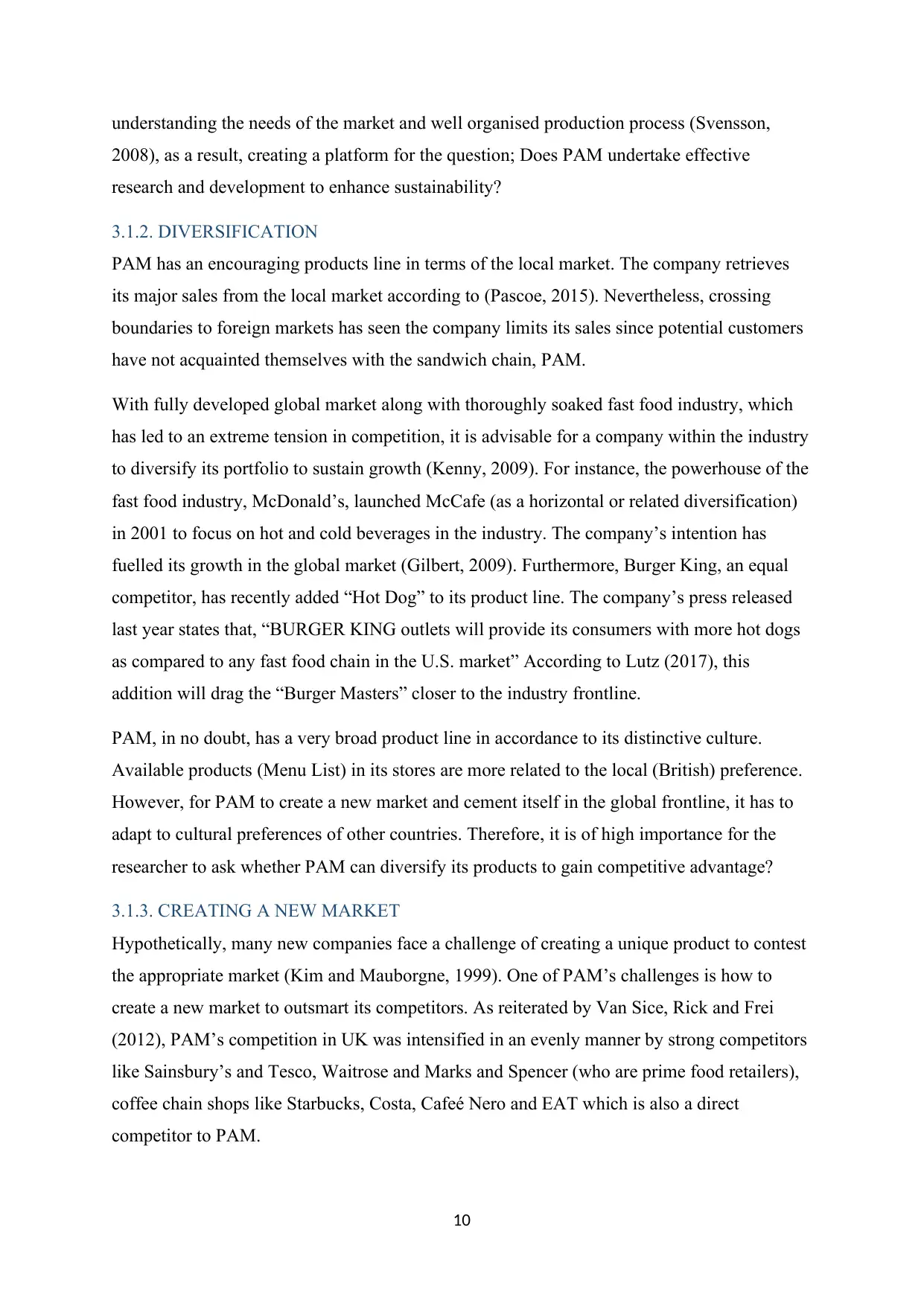
10
understanding the needs of the market and well organised production process (Svensson,
2008), as a result, creating a platform for the question; Does PAM undertake effective
research and development to enhance sustainability?
3.1.2. DIVERSIFICATION
PAM has an encouraging products line in terms of the local market. The company retrieves
its major sales from the local market according to (Pascoe, 2015). Nevertheless, crossing
boundaries to foreign markets has seen the company limits its sales since potential customers
have not acquainted themselves with the sandwich chain, PAM.
With fully developed global market along with thoroughly soaked fast food industry, which
has led to an extreme tension in competition, it is advisable for a company within the industry
to diversify its portfolio to sustain growth (Kenny, 2009). For instance, the powerhouse of the
fast food industry, McDonald’s, launched McCafe (as a horizontal or related diversification)
in 2001 to focus on hot and cold beverages in the industry. The company’s intention has
fuelled its growth in the global market (Gilbert, 2009). Furthermore, Burger King, an equal
competitor, has recently added “Hot Dog” to its product line. The company’s press released
last year states that, “BURGER KING outlets will provide its consumers with more hot dogs
as compared to any fast food chain in the U.S. market” According to Lutz (2017), this
addition will drag the “Burger Masters” closer to the industry frontline.
PAM, in no doubt, has a very broad product line in accordance to its distinctive culture.
Available products (Menu List) in its stores are more related to the local (British) preference.
However, for PAM to create a new market and cement itself in the global frontline, it has to
adapt to cultural preferences of other countries. Therefore, it is of high importance for the
researcher to ask whether PAM can diversify its products to gain competitive advantage?
3.1.3. CREATING A NEW MARKET
Hypothetically, many new companies face a challenge of creating a unique product to contest
the appropriate market (Kim and Mauborgne, 1999). One of PAM’s challenges is how to
create a new market to outsmart its competitors. As reiterated by Van Sice, Rick and Frei
(2012), PAM’s competition in UK was intensified in an evenly manner by strong competitors
like Sainsbury’s and Tesco, Waitrose and Marks and Spencer (who are prime food retailers),
coffee chain shops like Starbucks, Costa, Cafeé Nero and EAT which is also a direct
competitor to PAM.
understanding the needs of the market and well organised production process (Svensson,
2008), as a result, creating a platform for the question; Does PAM undertake effective
research and development to enhance sustainability?
3.1.2. DIVERSIFICATION
PAM has an encouraging products line in terms of the local market. The company retrieves
its major sales from the local market according to (Pascoe, 2015). Nevertheless, crossing
boundaries to foreign markets has seen the company limits its sales since potential customers
have not acquainted themselves with the sandwich chain, PAM.
With fully developed global market along with thoroughly soaked fast food industry, which
has led to an extreme tension in competition, it is advisable for a company within the industry
to diversify its portfolio to sustain growth (Kenny, 2009). For instance, the powerhouse of the
fast food industry, McDonald’s, launched McCafe (as a horizontal or related diversification)
in 2001 to focus on hot and cold beverages in the industry. The company’s intention has
fuelled its growth in the global market (Gilbert, 2009). Furthermore, Burger King, an equal
competitor, has recently added “Hot Dog” to its product line. The company’s press released
last year states that, “BURGER KING outlets will provide its consumers with more hot dogs
as compared to any fast food chain in the U.S. market” According to Lutz (2017), this
addition will drag the “Burger Masters” closer to the industry frontline.
PAM, in no doubt, has a very broad product line in accordance to its distinctive culture.
Available products (Menu List) in its stores are more related to the local (British) preference.
However, for PAM to create a new market and cement itself in the global frontline, it has to
adapt to cultural preferences of other countries. Therefore, it is of high importance for the
researcher to ask whether PAM can diversify its products to gain competitive advantage?
3.1.3. CREATING A NEW MARKET
Hypothetically, many new companies face a challenge of creating a unique product to contest
the appropriate market (Kim and Mauborgne, 1999). One of PAM’s challenges is how to
create a new market to outsmart its competitors. As reiterated by Van Sice, Rick and Frei
(2012), PAM’s competition in UK was intensified in an evenly manner by strong competitors
like Sainsbury’s and Tesco, Waitrose and Marks and Spencer (who are prime food retailers),
coffee chain shops like Starbucks, Costa, Cafeé Nero and EAT which is also a direct
competitor to PAM.
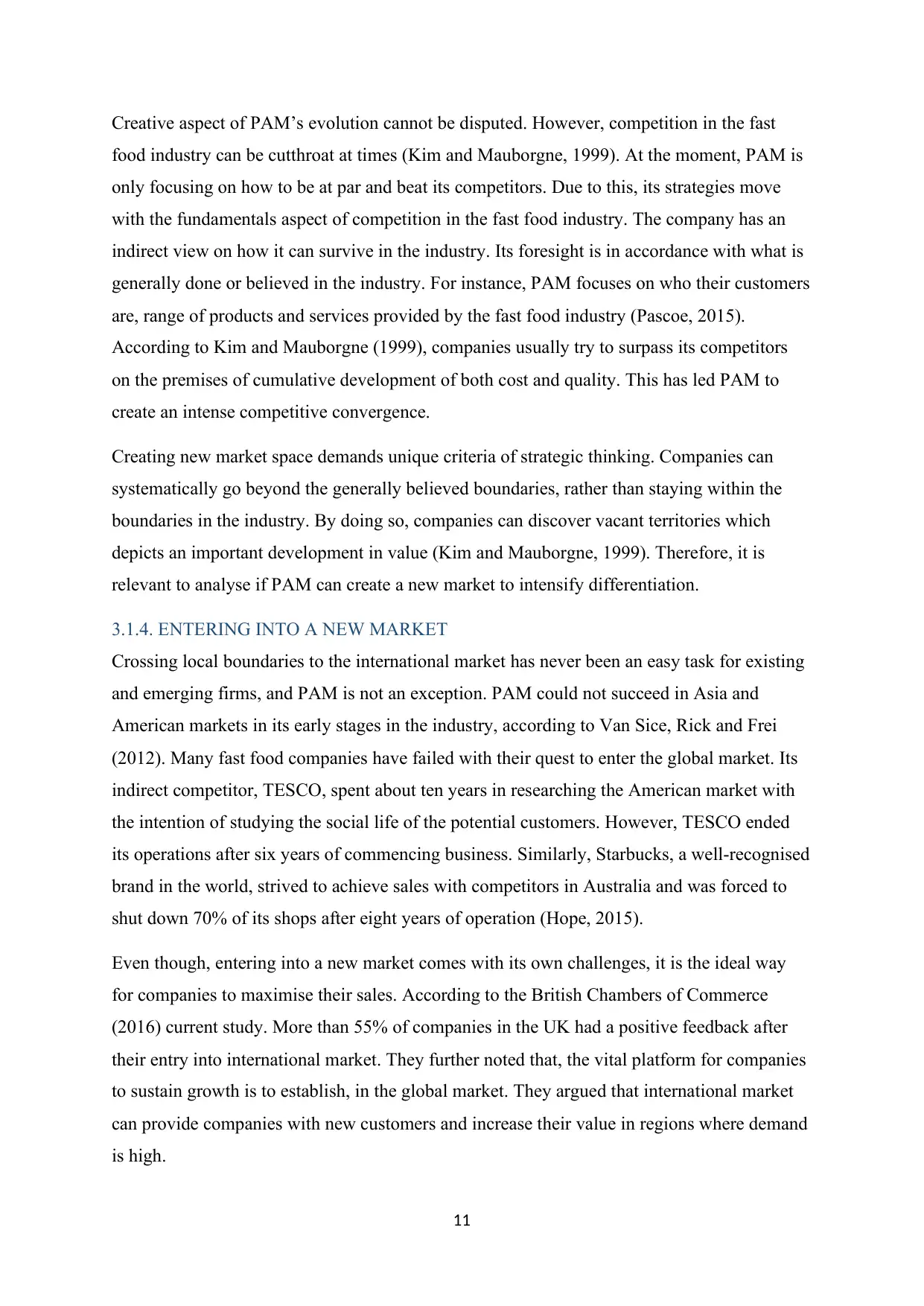
11
Creative aspect of PAM’s evolution cannot be disputed. However, competition in the fast
food industry can be cutthroat at times (Kim and Mauborgne, 1999). At the moment, PAM is
only focusing on how to be at par and beat its competitors. Due to this, its strategies move
with the fundamentals aspect of competition in the fast food industry. The company has an
indirect view on how it can survive in the industry. Its foresight is in accordance with what is
generally done or believed in the industry. For instance, PAM focuses on who their customers
are, range of products and services provided by the fast food industry (Pascoe, 2015).
According to Kim and Mauborgne (1999), companies usually try to surpass its competitors
on the premises of cumulative development of both cost and quality. This has led PAM to
create an intense competitive convergence.
Creating new market space demands unique criteria of strategic thinking. Companies can
systematically go beyond the generally believed boundaries, rather than staying within the
boundaries in the industry. By doing so, companies can discover vacant territories which
depicts an important development in value (Kim and Mauborgne, 1999). Therefore, it is
relevant to analyse if PAM can create a new market to intensify differentiation.
3.1.4. ENTERING INTO A NEW MARKET
Crossing local boundaries to the international market has never been an easy task for existing
and emerging firms, and PAM is not an exception. PAM could not succeed in Asia and
American markets in its early stages in the industry, according to Van Sice, Rick and Frei
(2012). Many fast food companies have failed with their quest to enter the global market. Its
indirect competitor, TESCO, spent about ten years in researching the American market with
the intention of studying the social life of the potential customers. However, TESCO ended
its operations after six years of commencing business. Similarly, Starbucks, a well-recognised
brand in the world, strived to achieve sales with competitors in Australia and was forced to
shut down 70% of its shops after eight years of operation (Hope, 2015).
Even though, entering into a new market comes with its own challenges, it is the ideal way
for companies to maximise their sales. According to the British Chambers of Commerce
(2016) current study. More than 55% of companies in the UK had a positive feedback after
their entry into international market. They further noted that, the vital platform for companies
to sustain growth is to establish, in the global market. They argued that international market
can provide companies with new customers and increase their value in regions where demand
is high.
Creative aspect of PAM’s evolution cannot be disputed. However, competition in the fast
food industry can be cutthroat at times (Kim and Mauborgne, 1999). At the moment, PAM is
only focusing on how to be at par and beat its competitors. Due to this, its strategies move
with the fundamentals aspect of competition in the fast food industry. The company has an
indirect view on how it can survive in the industry. Its foresight is in accordance with what is
generally done or believed in the industry. For instance, PAM focuses on who their customers
are, range of products and services provided by the fast food industry (Pascoe, 2015).
According to Kim and Mauborgne (1999), companies usually try to surpass its competitors
on the premises of cumulative development of both cost and quality. This has led PAM to
create an intense competitive convergence.
Creating new market space demands unique criteria of strategic thinking. Companies can
systematically go beyond the generally believed boundaries, rather than staying within the
boundaries in the industry. By doing so, companies can discover vacant territories which
depicts an important development in value (Kim and Mauborgne, 1999). Therefore, it is
relevant to analyse if PAM can create a new market to intensify differentiation.
3.1.4. ENTERING INTO A NEW MARKET
Crossing local boundaries to the international market has never been an easy task for existing
and emerging firms, and PAM is not an exception. PAM could not succeed in Asia and
American markets in its early stages in the industry, according to Van Sice, Rick and Frei
(2012). Many fast food companies have failed with their quest to enter the global market. Its
indirect competitor, TESCO, spent about ten years in researching the American market with
the intention of studying the social life of the potential customers. However, TESCO ended
its operations after six years of commencing business. Similarly, Starbucks, a well-recognised
brand in the world, strived to achieve sales with competitors in Australia and was forced to
shut down 70% of its shops after eight years of operation (Hope, 2015).
Even though, entering into a new market comes with its own challenges, it is the ideal way
for companies to maximise their sales. According to the British Chambers of Commerce
(2016) current study. More than 55% of companies in the UK had a positive feedback after
their entry into international market. They further noted that, the vital platform for companies
to sustain growth is to establish, in the global market. They argued that international market
can provide companies with new customers and increase their value in regions where demand
is high.
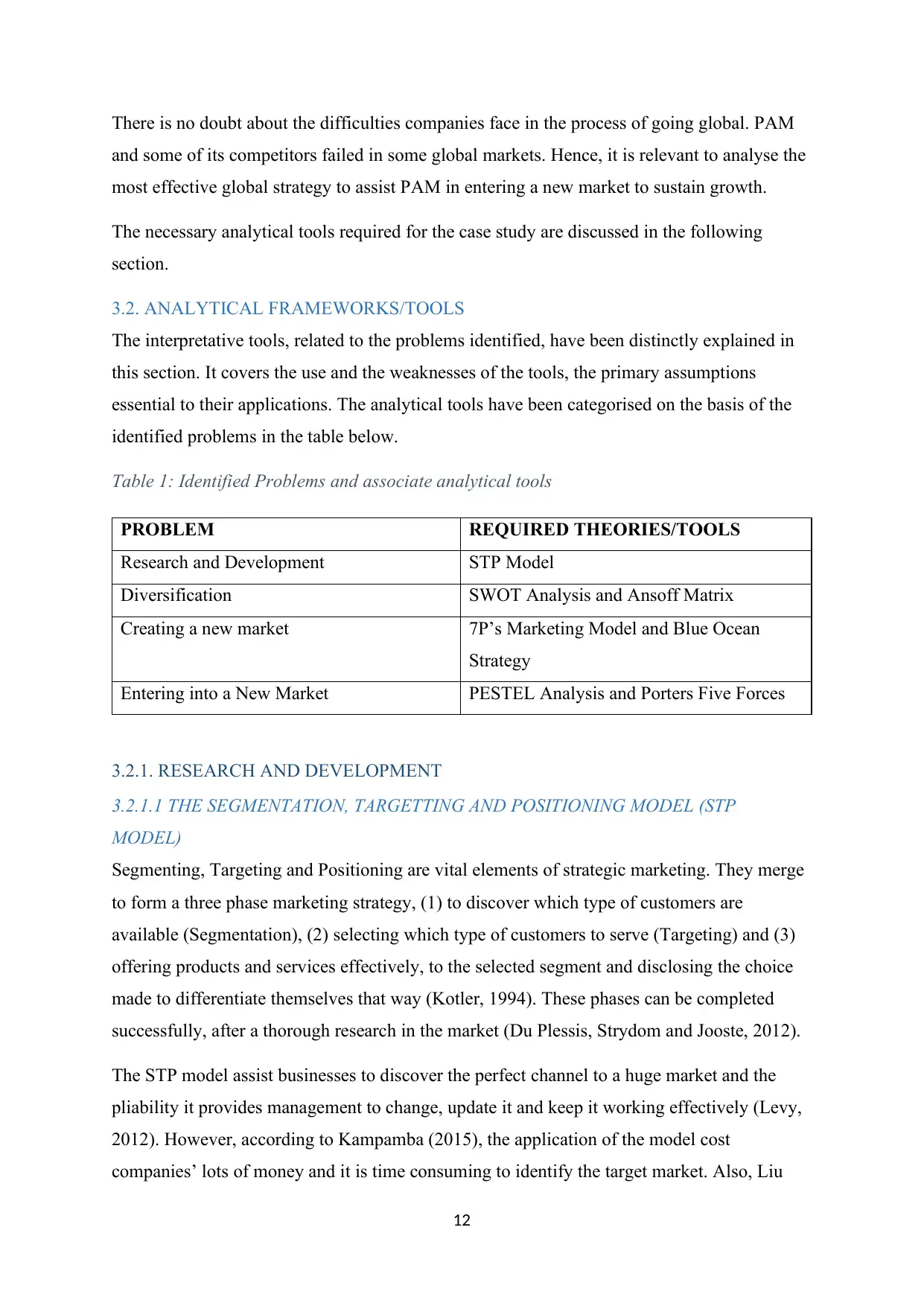
12
There is no doubt about the difficulties companies face in the process of going global. PAM
and some of its competitors failed in some global markets. Hence, it is relevant to analyse the
most effective global strategy to assist PAM in entering a new market to sustain growth.
The necessary analytical tools required for the case study are discussed in the following
section.
3.2. ANALYTICAL FRAMEWORKS/TOOLS
The interpretative tools, related to the problems identified, have been distinctly explained in
this section. It covers the use and the weaknesses of the tools, the primary assumptions
essential to their applications. The analytical tools have been categorised on the basis of the
identified problems in the table below.
Table 1: Identified Problems and associate analytical tools
PROBLEM REQUIRED THEORIES/TOOLS
Research and Development STP Model
Diversification SWOT Analysis and Ansoff Matrix
Creating a new market 7P’s Marketing Model and Blue Ocean
Strategy
Entering into a New Market PESTEL Analysis and Porters Five Forces
3.2.1. RESEARCH AND DEVELOPMENT
3.2.1.1 THE SEGMENTATION, TARGETTING AND POSITIONING MODEL (STP
MODEL)
Segmenting, Targeting and Positioning are vital elements of strategic marketing. They merge
to form a three phase marketing strategy, (1) to discover which type of customers are
available (Segmentation), (2) selecting which type of customers to serve (Targeting) and (3)
offering products and services effectively, to the selected segment and disclosing the choice
made to differentiate themselves that way (Kotler, 1994). These phases can be completed
successfully, after a thorough research in the market (Du Plessis, Strydom and Jooste, 2012).
The STP model assist businesses to discover the perfect channel to a huge market and the
pliability it provides management to change, update it and keep it working effectively (Levy,
2012). However, according to Kampamba (2015), the application of the model cost
companies’ lots of money and it is time consuming to identify the target market. Also, Liu
There is no doubt about the difficulties companies face in the process of going global. PAM
and some of its competitors failed in some global markets. Hence, it is relevant to analyse the
most effective global strategy to assist PAM in entering a new market to sustain growth.
The necessary analytical tools required for the case study are discussed in the following
section.
3.2. ANALYTICAL FRAMEWORKS/TOOLS
The interpretative tools, related to the problems identified, have been distinctly explained in
this section. It covers the use and the weaknesses of the tools, the primary assumptions
essential to their applications. The analytical tools have been categorised on the basis of the
identified problems in the table below.
Table 1: Identified Problems and associate analytical tools
PROBLEM REQUIRED THEORIES/TOOLS
Research and Development STP Model
Diversification SWOT Analysis and Ansoff Matrix
Creating a new market 7P’s Marketing Model and Blue Ocean
Strategy
Entering into a New Market PESTEL Analysis and Porters Five Forces
3.2.1. RESEARCH AND DEVELOPMENT
3.2.1.1 THE SEGMENTATION, TARGETTING AND POSITIONING MODEL (STP
MODEL)
Segmenting, Targeting and Positioning are vital elements of strategic marketing. They merge
to form a three phase marketing strategy, (1) to discover which type of customers are
available (Segmentation), (2) selecting which type of customers to serve (Targeting) and (3)
offering products and services effectively, to the selected segment and disclosing the choice
made to differentiate themselves that way (Kotler, 1994). These phases can be completed
successfully, after a thorough research in the market (Du Plessis, Strydom and Jooste, 2012).
The STP model assist businesses to discover the perfect channel to a huge market and the
pliability it provides management to change, update it and keep it working effectively (Levy,
2012). However, according to Kampamba (2015), the application of the model cost
companies’ lots of money and it is time consuming to identify the target market. Also, Liu
Paraphrase This Document
Need a fresh take? Get an instant paraphrase of this document with our AI Paraphraser
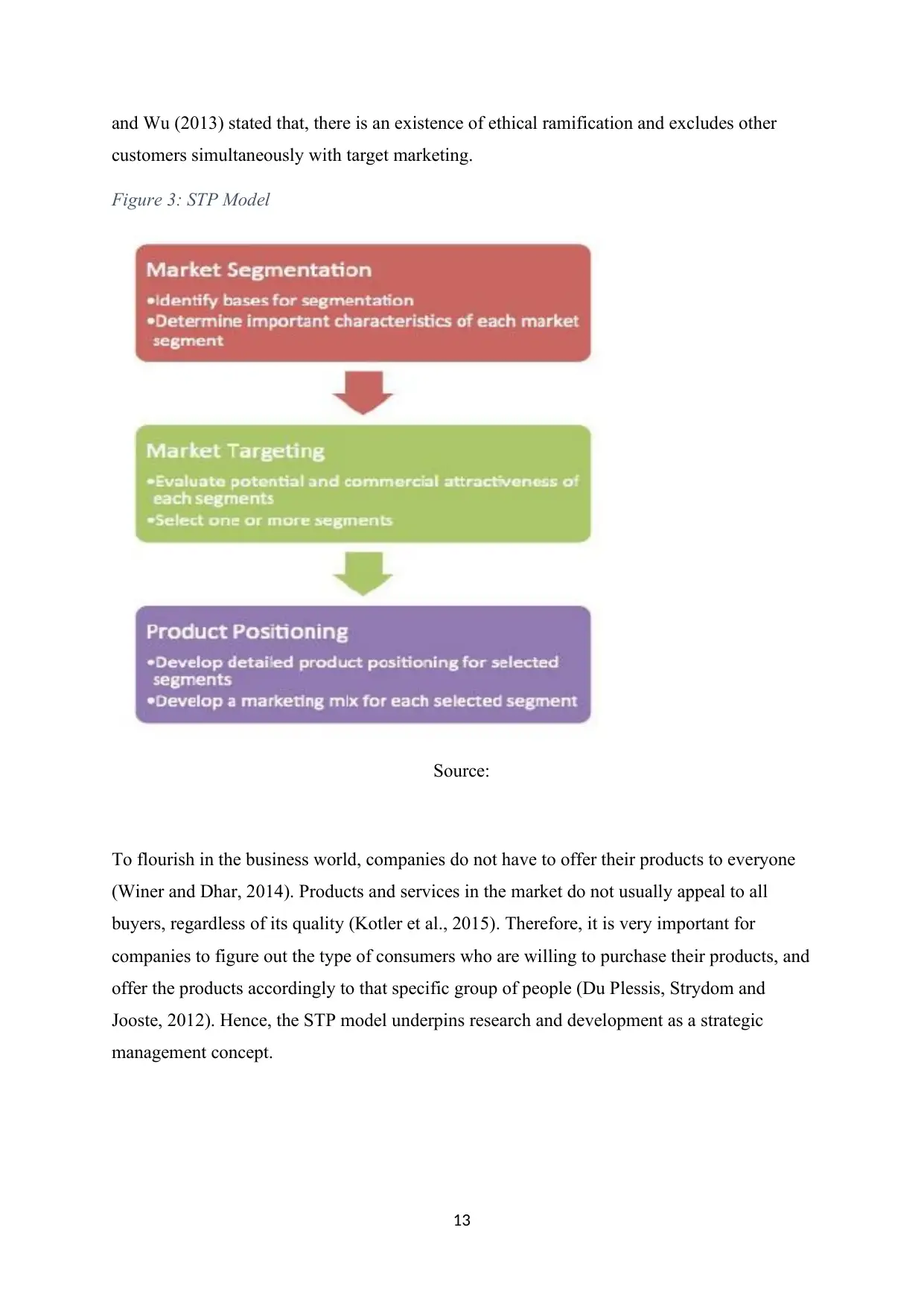
13
and Wu (2013) stated that, there is an existence of ethical ramification and excludes other
customers simultaneously with target marketing.
Figure 3: STP Model
Source:
To flourish in the business world, companies do not have to offer their products to everyone
(Winer and Dhar, 2014). Products and services in the market do not usually appeal to all
buyers, regardless of its quality (Kotler et al., 2015). Therefore, it is very important for
companies to figure out the type of consumers who are willing to purchase their products, and
offer the products accordingly to that specific group of people (Du Plessis, Strydom and
Jooste, 2012). Hence, the STP model underpins research and development as a strategic
management concept.
and Wu (2013) stated that, there is an existence of ethical ramification and excludes other
customers simultaneously with target marketing.
Figure 3: STP Model
Source:
To flourish in the business world, companies do not have to offer their products to everyone
(Winer and Dhar, 2014). Products and services in the market do not usually appeal to all
buyers, regardless of its quality (Kotler et al., 2015). Therefore, it is very important for
companies to figure out the type of consumers who are willing to purchase their products, and
offer the products accordingly to that specific group of people (Du Plessis, Strydom and
Jooste, 2012). Hence, the STP model underpins research and development as a strategic
management concept.
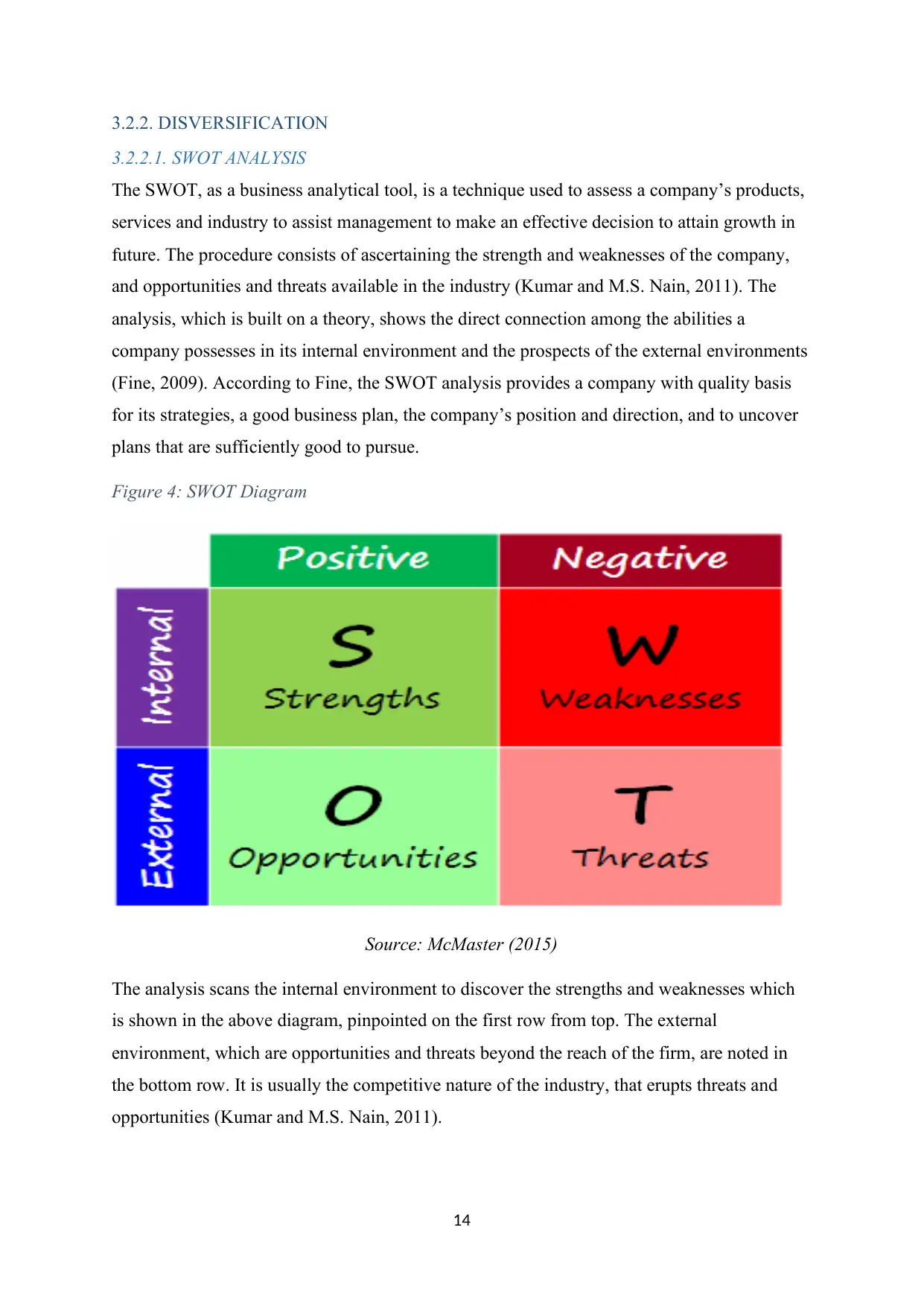
14
3.2.2. DISVERSIFICATION
3.2.2.1. SWOT ANALYSIS
The SWOT, as a business analytical tool, is a technique used to assess a company’s products,
services and industry to assist management to make an effective decision to attain growth in
future. The procedure consists of ascertaining the strength and weaknesses of the company,
and opportunities and threats available in the industry (Kumar and M.S. Nain, 2011). The
analysis, which is built on a theory, shows the direct connection among the abilities a
company possesses in its internal environment and the prospects of the external environments
(Fine, 2009). According to Fine, the SWOT analysis provides a company with quality basis
for its strategies, a good business plan, the company’s position and direction, and to uncover
plans that are sufficiently good to pursue.
Figure 4: SWOT Diagram
Source: McMaster (2015)
The analysis scans the internal environment to discover the strengths and weaknesses which
is shown in the above diagram, pinpointed on the first row from top. The external
environment, which are opportunities and threats beyond the reach of the firm, are noted in
the bottom row. It is usually the competitive nature of the industry, that erupts threats and
opportunities (Kumar and M.S. Nain, 2011).
3.2.2. DISVERSIFICATION
3.2.2.1. SWOT ANALYSIS
The SWOT, as a business analytical tool, is a technique used to assess a company’s products,
services and industry to assist management to make an effective decision to attain growth in
future. The procedure consists of ascertaining the strength and weaknesses of the company,
and opportunities and threats available in the industry (Kumar and M.S. Nain, 2011). The
analysis, which is built on a theory, shows the direct connection among the abilities a
company possesses in its internal environment and the prospects of the external environments
(Fine, 2009). According to Fine, the SWOT analysis provides a company with quality basis
for its strategies, a good business plan, the company’s position and direction, and to uncover
plans that are sufficiently good to pursue.
Figure 4: SWOT Diagram
Source: McMaster (2015)
The analysis scans the internal environment to discover the strengths and weaknesses which
is shown in the above diagram, pinpointed on the first row from top. The external
environment, which are opportunities and threats beyond the reach of the firm, are noted in
the bottom row. It is usually the competitive nature of the industry, that erupts threats and
opportunities (Kumar and M.S. Nain, 2011).
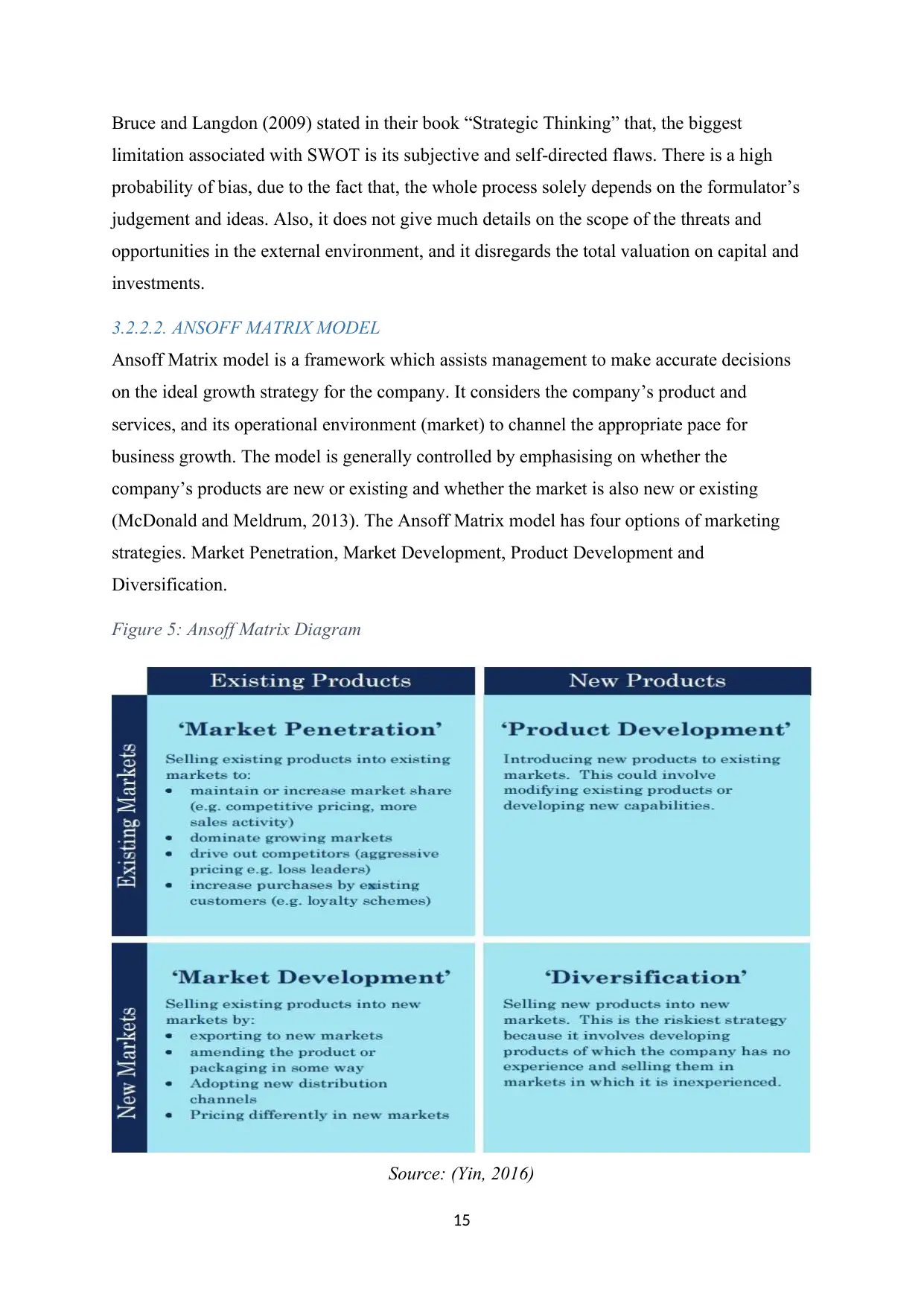
15
Bruce and Langdon (2009) stated in their book “Strategic Thinking” that, the biggest
limitation associated with SWOT is its subjective and self-directed flaws. There is a high
probability of bias, due to the fact that, the whole process solely depends on the formulator’s
judgement and ideas. Also, it does not give much details on the scope of the threats and
opportunities in the external environment, and it disregards the total valuation on capital and
investments.
3.2.2.2. ANSOFF MATRIX MODEL
Ansoff Matrix model is a framework which assists management to make accurate decisions
on the ideal growth strategy for the company. It considers the company’s product and
services, and its operational environment (market) to channel the appropriate pace for
business growth. The model is generally controlled by emphasising on whether the
company’s products are new or existing and whether the market is also new or existing
(McDonald and Meldrum, 2013). The Ansoff Matrix model has four options of marketing
strategies. Market Penetration, Market Development, Product Development and
Diversification.
Figure 5: Ansoff Matrix Diagram
Source: (Yin, 2016)
Bruce and Langdon (2009) stated in their book “Strategic Thinking” that, the biggest
limitation associated with SWOT is its subjective and self-directed flaws. There is a high
probability of bias, due to the fact that, the whole process solely depends on the formulator’s
judgement and ideas. Also, it does not give much details on the scope of the threats and
opportunities in the external environment, and it disregards the total valuation on capital and
investments.
3.2.2.2. ANSOFF MATRIX MODEL
Ansoff Matrix model is a framework which assists management to make accurate decisions
on the ideal growth strategy for the company. It considers the company’s product and
services, and its operational environment (market) to channel the appropriate pace for
business growth. The model is generally controlled by emphasising on whether the
company’s products are new or existing and whether the market is also new or existing
(McDonald and Meldrum, 2013). The Ansoff Matrix model has four options of marketing
strategies. Market Penetration, Market Development, Product Development and
Diversification.
Figure 5: Ansoff Matrix Diagram
Source: (Yin, 2016)
Secure Best Marks with AI Grader
Need help grading? Try our AI Grader for instant feedback on your assignments.
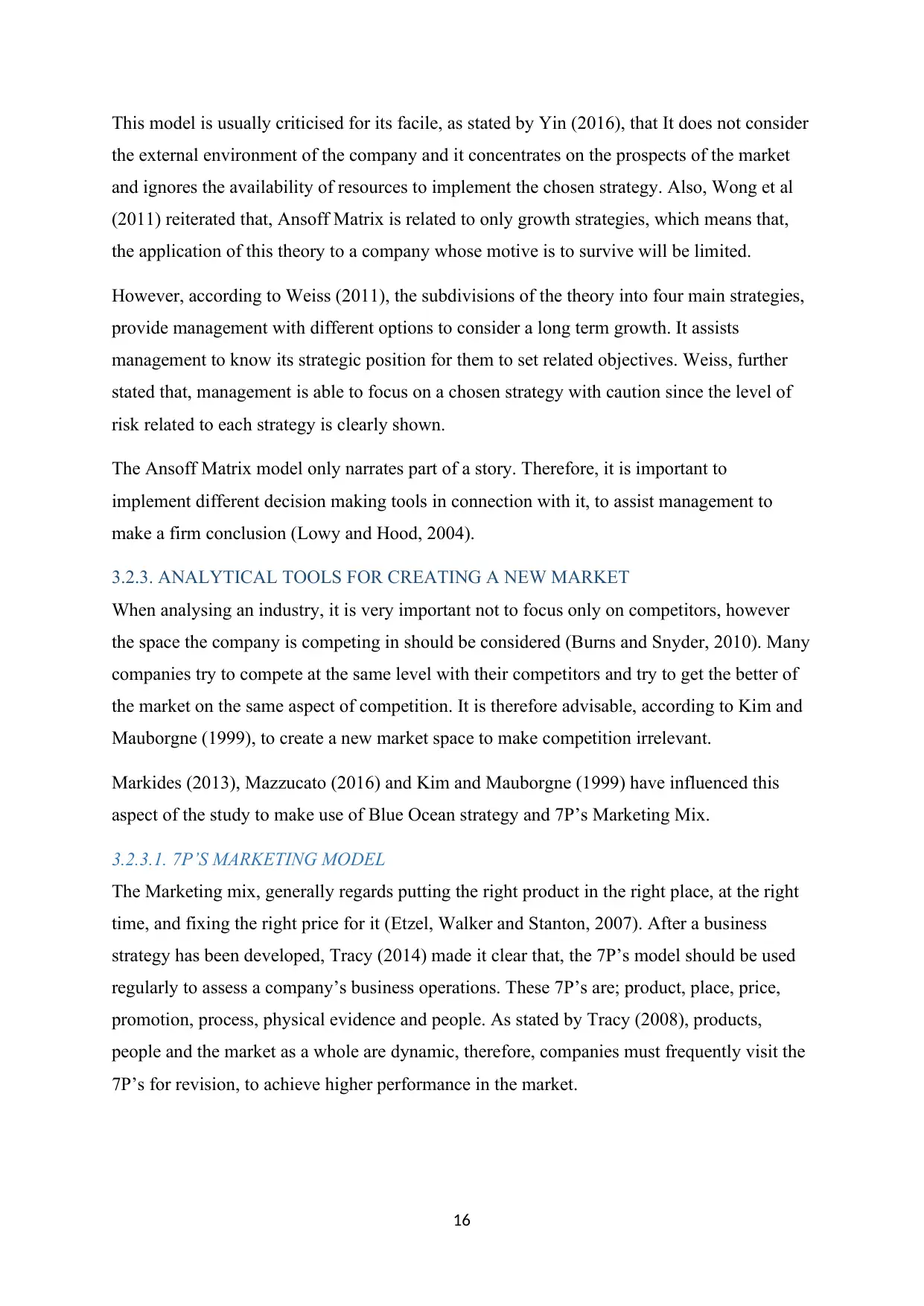
16
This model is usually criticised for its facile, as stated by Yin (2016), that It does not consider
the external environment of the company and it concentrates on the prospects of the market
and ignores the availability of resources to implement the chosen strategy. Also, Wong et al
(2011) reiterated that, Ansoff Matrix is related to only growth strategies, which means that,
the application of this theory to a company whose motive is to survive will be limited.
However, according to Weiss (2011), the subdivisions of the theory into four main strategies,
provide management with different options to consider a long term growth. It assists
management to know its strategic position for them to set related objectives. Weiss, further
stated that, management is able to focus on a chosen strategy with caution since the level of
risk related to each strategy is clearly shown.
The Ansoff Matrix model only narrates part of a story. Therefore, it is important to
implement different decision making tools in connection with it, to assist management to
make a firm conclusion (Lowy and Hood, 2004).
3.2.3. ANALYTICAL TOOLS FOR CREATING A NEW MARKET
When analysing an industry, it is very important not to focus only on competitors, however
the space the company is competing in should be considered (Burns and Snyder, 2010). Many
companies try to compete at the same level with their competitors and try to get the better of
the market on the same aspect of competition. It is therefore advisable, according to Kim and
Mauborgne (1999), to create a new market space to make competition irrelevant.
Markides (2013), Mazzucato (2016) and Kim and Mauborgne (1999) have influenced this
aspect of the study to make use of Blue Ocean strategy and 7P’s Marketing Mix.
3.2.3.1. 7P’S MARKETING MODEL
The Marketing mix, generally regards putting the right product in the right place, at the right
time, and fixing the right price for it (Etzel, Walker and Stanton, 2007). After a business
strategy has been developed, Tracy (2014) made it clear that, the 7P’s model should be used
regularly to assess a company’s business operations. These 7P’s are; product, place, price,
promotion, process, physical evidence and people. As stated by Tracy (2008), products,
people and the market as a whole are dynamic, therefore, companies must frequently visit the
7P’s for revision, to achieve higher performance in the market.
This model is usually criticised for its facile, as stated by Yin (2016), that It does not consider
the external environment of the company and it concentrates on the prospects of the market
and ignores the availability of resources to implement the chosen strategy. Also, Wong et al
(2011) reiterated that, Ansoff Matrix is related to only growth strategies, which means that,
the application of this theory to a company whose motive is to survive will be limited.
However, according to Weiss (2011), the subdivisions of the theory into four main strategies,
provide management with different options to consider a long term growth. It assists
management to know its strategic position for them to set related objectives. Weiss, further
stated that, management is able to focus on a chosen strategy with caution since the level of
risk related to each strategy is clearly shown.
The Ansoff Matrix model only narrates part of a story. Therefore, it is important to
implement different decision making tools in connection with it, to assist management to
make a firm conclusion (Lowy and Hood, 2004).
3.2.3. ANALYTICAL TOOLS FOR CREATING A NEW MARKET
When analysing an industry, it is very important not to focus only on competitors, however
the space the company is competing in should be considered (Burns and Snyder, 2010). Many
companies try to compete at the same level with their competitors and try to get the better of
the market on the same aspect of competition. It is therefore advisable, according to Kim and
Mauborgne (1999), to create a new market space to make competition irrelevant.
Markides (2013), Mazzucato (2016) and Kim and Mauborgne (1999) have influenced this
aspect of the study to make use of Blue Ocean strategy and 7P’s Marketing Mix.
3.2.3.1. 7P’S MARKETING MODEL
The Marketing mix, generally regards putting the right product in the right place, at the right
time, and fixing the right price for it (Etzel, Walker and Stanton, 2007). After a business
strategy has been developed, Tracy (2014) made it clear that, the 7P’s model should be used
regularly to assess a company’s business operations. These 7P’s are; product, place, price,
promotion, process, physical evidence and people. As stated by Tracy (2008), products,
people and the market as a whole are dynamic, therefore, companies must frequently visit the
7P’s for revision, to achieve higher performance in the market.
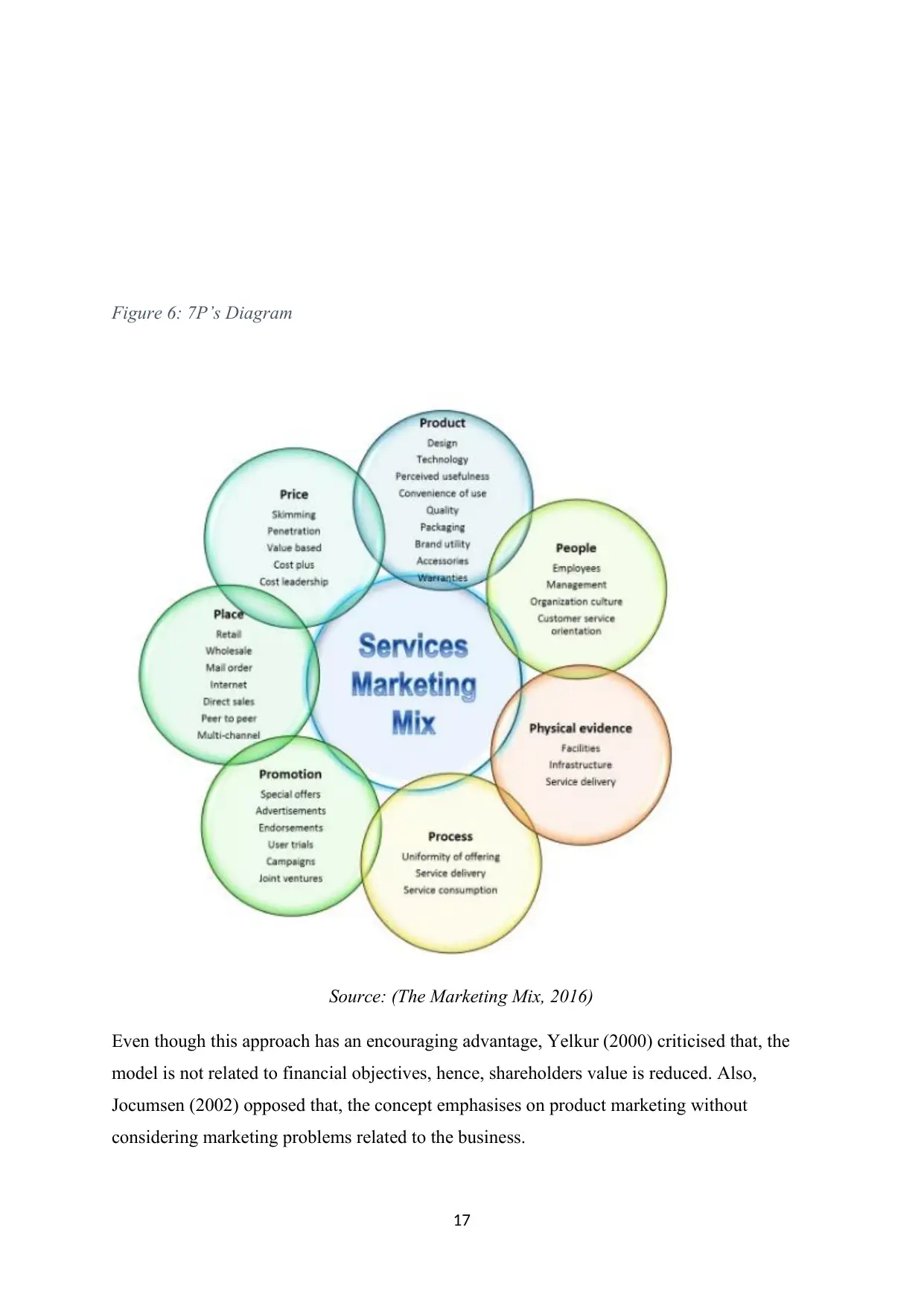
17
Figure 6: 7P’s Diagram
Source: (The Marketing Mix, 2016)
Even though this approach has an encouraging advantage, Yelkur (2000) criticised that, the
model is not related to financial objectives, hence, shareholders value is reduced. Also,
Jocumsen (2002) opposed that, the concept emphasises on product marketing without
considering marketing problems related to the business.
Figure 6: 7P’s Diagram
Source: (The Marketing Mix, 2016)
Even though this approach has an encouraging advantage, Yelkur (2000) criticised that, the
model is not related to financial objectives, hence, shareholders value is reduced. Also,
Jocumsen (2002) opposed that, the concept emphasises on product marketing without
considering marketing problems related to the business.
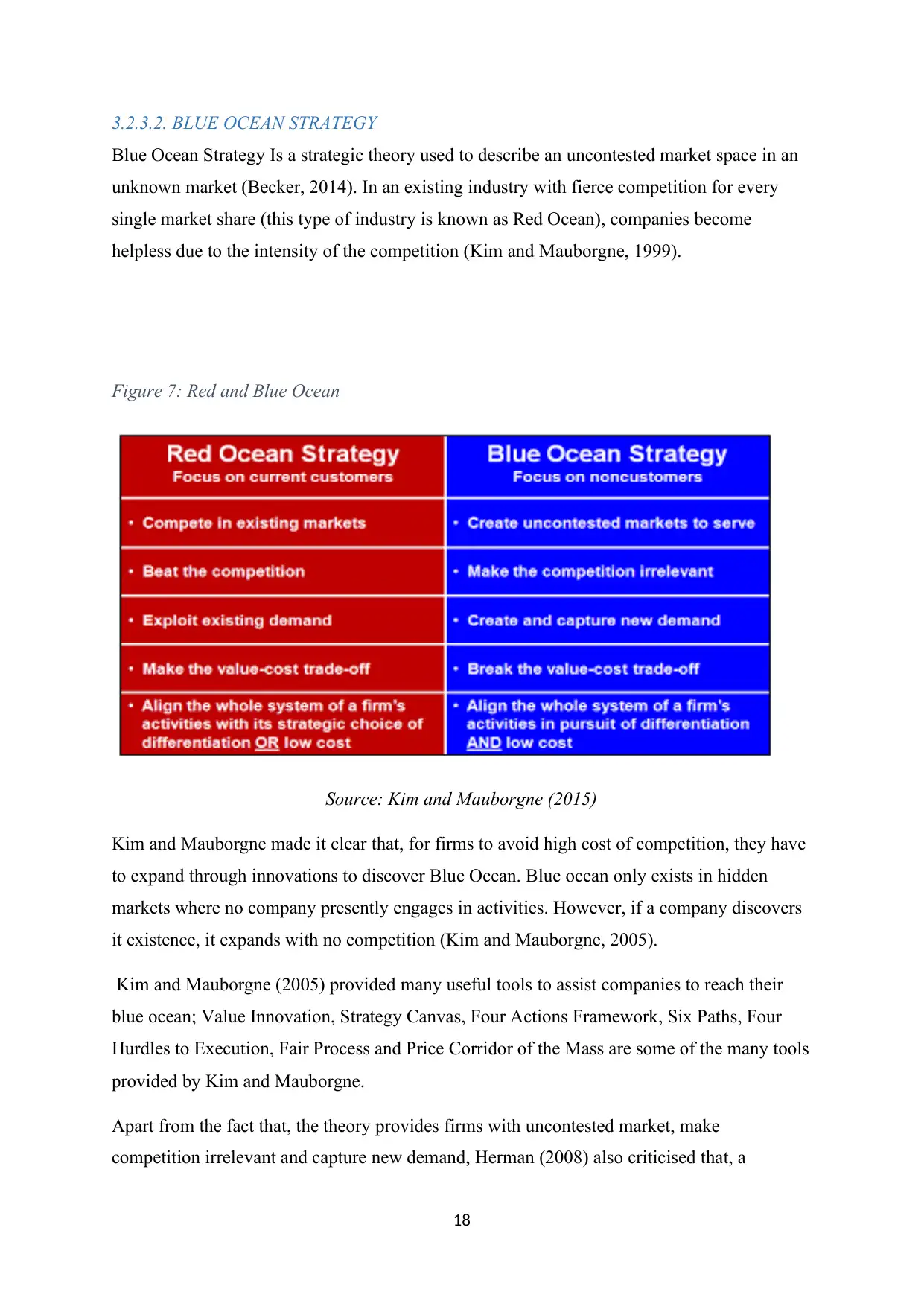
18
3.2.3.2. BLUE OCEAN STRATEGY
Blue Ocean Strategy Is a strategic theory used to describe an uncontested market space in an
unknown market (Becker, 2014). In an existing industry with fierce competition for every
single market share (this type of industry is known as Red Ocean), companies become
helpless due to the intensity of the competition (Kim and Mauborgne, 1999).
Figure 7: Red and Blue Ocean
Source: Kim and Mauborgne (2015)
Kim and Mauborgne made it clear that, for firms to avoid high cost of competition, they have
to expand through innovations to discover Blue Ocean. Blue ocean only exists in hidden
markets where no company presently engages in activities. However, if a company discovers
it existence, it expands with no competition (Kim and Mauborgne, 2005).
Kim and Mauborgne (2005) provided many useful tools to assist companies to reach their
blue ocean; Value Innovation, Strategy Canvas, Four Actions Framework, Six Paths, Four
Hurdles to Execution, Fair Process and Price Corridor of the Mass are some of the many tools
provided by Kim and Mauborgne.
Apart from the fact that, the theory provides firms with uncontested market, make
competition irrelevant and capture new demand, Herman (2008) also criticised that, a
3.2.3.2. BLUE OCEAN STRATEGY
Blue Ocean Strategy Is a strategic theory used to describe an uncontested market space in an
unknown market (Becker, 2014). In an existing industry with fierce competition for every
single market share (this type of industry is known as Red Ocean), companies become
helpless due to the intensity of the competition (Kim and Mauborgne, 1999).
Figure 7: Red and Blue Ocean
Source: Kim and Mauborgne (2015)
Kim and Mauborgne made it clear that, for firms to avoid high cost of competition, they have
to expand through innovations to discover Blue Ocean. Blue ocean only exists in hidden
markets where no company presently engages in activities. However, if a company discovers
it existence, it expands with no competition (Kim and Mauborgne, 2005).
Kim and Mauborgne (2005) provided many useful tools to assist companies to reach their
blue ocean; Value Innovation, Strategy Canvas, Four Actions Framework, Six Paths, Four
Hurdles to Execution, Fair Process and Price Corridor of the Mass are some of the many tools
provided by Kim and Mauborgne.
Apart from the fact that, the theory provides firms with uncontested market, make
competition irrelevant and capture new demand, Herman (2008) also criticised that, a
Paraphrase This Document
Need a fresh take? Get an instant paraphrase of this document with our AI Paraphraser
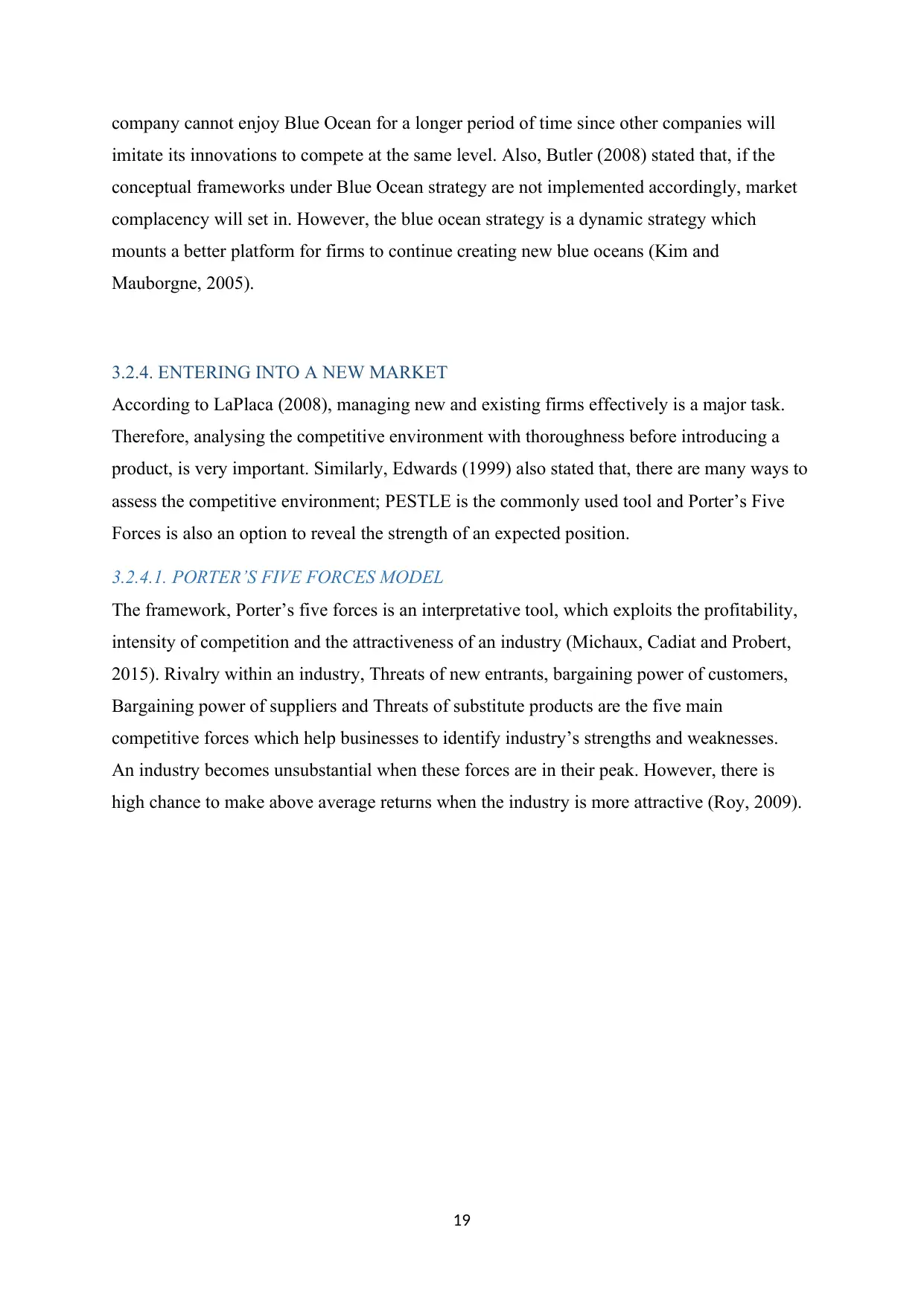
19
company cannot enjoy Blue Ocean for a longer period of time since other companies will
imitate its innovations to compete at the same level. Also, Butler (2008) stated that, if the
conceptual frameworks under Blue Ocean strategy are not implemented accordingly, market
complacency will set in. However, the blue ocean strategy is a dynamic strategy which
mounts a better platform for firms to continue creating new blue oceans (Kim and
Mauborgne, 2005).
3.2.4. ENTERING INTO A NEW MARKET
According to LaPlaca (2008), managing new and existing firms effectively is a major task.
Therefore, analysing the competitive environment with thoroughness before introducing a
product, is very important. Similarly, Edwards (1999) also stated that, there are many ways to
assess the competitive environment; PESTLE is the commonly used tool and Porter’s Five
Forces is also an option to reveal the strength of an expected position.
3.2.4.1. PORTER’S FIVE FORCES MODEL
The framework, Porter’s five forces is an interpretative tool, which exploits the profitability,
intensity of competition and the attractiveness of an industry (Michaux, Cadiat and Probert,
2015). Rivalry within an industry, Threats of new entrants, bargaining power of customers,
Bargaining power of suppliers and Threats of substitute products are the five main
competitive forces which help businesses to identify industry’s strengths and weaknesses.
An industry becomes unsubstantial when these forces are in their peak. However, there is
high chance to make above average returns when the industry is more attractive (Roy, 2009).
company cannot enjoy Blue Ocean for a longer period of time since other companies will
imitate its innovations to compete at the same level. Also, Butler (2008) stated that, if the
conceptual frameworks under Blue Ocean strategy are not implemented accordingly, market
complacency will set in. However, the blue ocean strategy is a dynamic strategy which
mounts a better platform for firms to continue creating new blue oceans (Kim and
Mauborgne, 2005).
3.2.4. ENTERING INTO A NEW MARKET
According to LaPlaca (2008), managing new and existing firms effectively is a major task.
Therefore, analysing the competitive environment with thoroughness before introducing a
product, is very important. Similarly, Edwards (1999) also stated that, there are many ways to
assess the competitive environment; PESTLE is the commonly used tool and Porter’s Five
Forces is also an option to reveal the strength of an expected position.
3.2.4.1. PORTER’S FIVE FORCES MODEL
The framework, Porter’s five forces is an interpretative tool, which exploits the profitability,
intensity of competition and the attractiveness of an industry (Michaux, Cadiat and Probert,
2015). Rivalry within an industry, Threats of new entrants, bargaining power of customers,
Bargaining power of suppliers and Threats of substitute products are the five main
competitive forces which help businesses to identify industry’s strengths and weaknesses.
An industry becomes unsubstantial when these forces are in their peak. However, there is
high chance to make above average returns when the industry is more attractive (Roy, 2009).
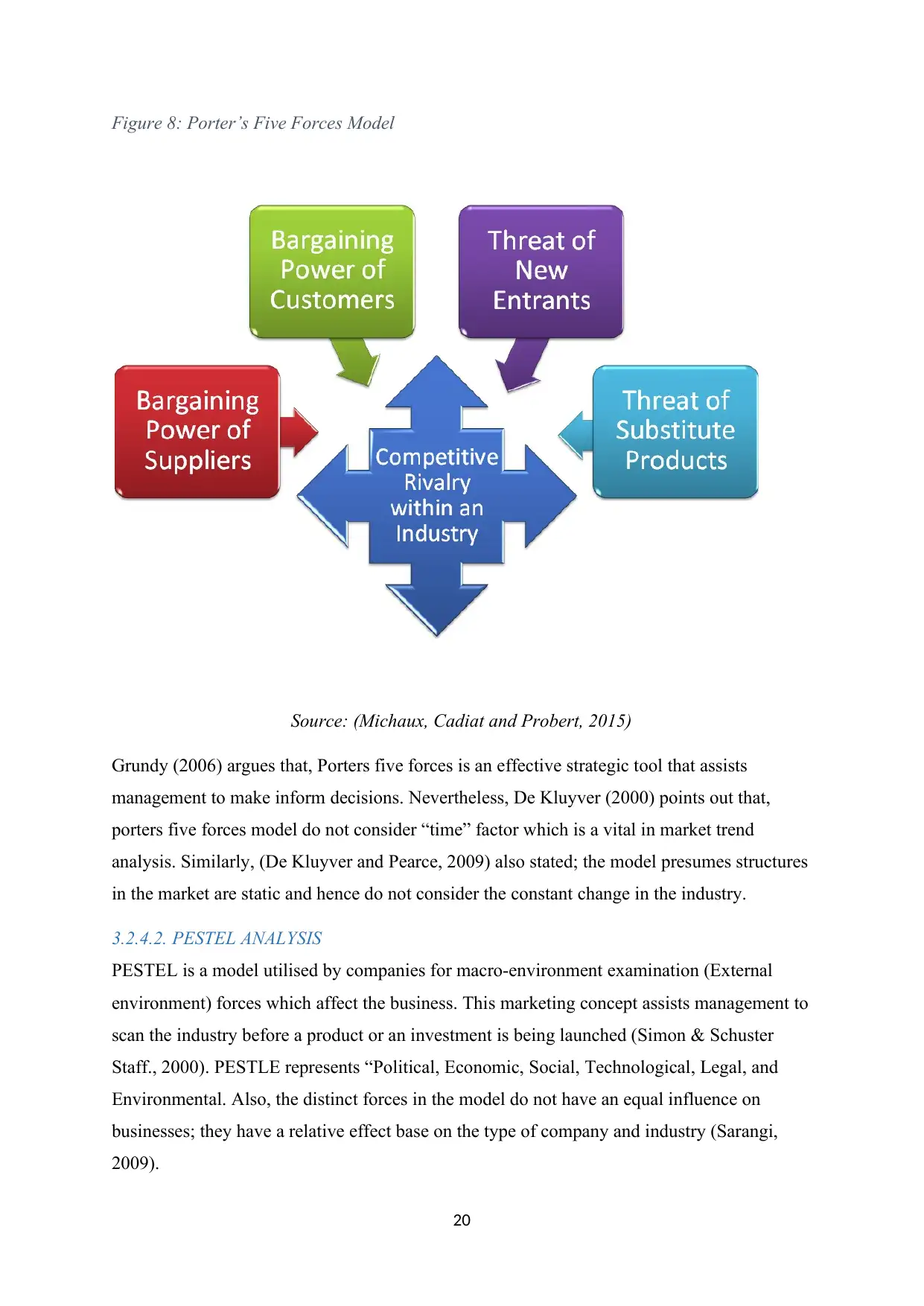
20
Figure 8: Porter’s Five Forces Model
Source: (Michaux, Cadiat and Probert, 2015)
Grundy (2006) argues that, Porters five forces is an effective strategic tool that assists
management to make inform decisions. Nevertheless, De Kluyver (2000) points out that,
porters five forces model do not consider “time” factor which is a vital in market trend
analysis. Similarly, (De Kluyver and Pearce, 2009) also stated; the model presumes structures
in the market are static and hence do not consider the constant change in the industry.
3.2.4.2. PESTEL ANALYSIS
PESTEL is a model utilised by companies for macro-environment examination (External
environment) forces which affect the business. This marketing concept assists management to
scan the industry before a product or an investment is being launched (Simon & Schuster
Staff., 2000). PESTLE represents “Political, Economic, Social, Technological, Legal, and
Environmental. Also, the distinct forces in the model do not have an equal influence on
businesses; they have a relative effect base on the type of company and industry (Sarangi,
2009).
Figure 8: Porter’s Five Forces Model
Source: (Michaux, Cadiat and Probert, 2015)
Grundy (2006) argues that, Porters five forces is an effective strategic tool that assists
management to make inform decisions. Nevertheless, De Kluyver (2000) points out that,
porters five forces model do not consider “time” factor which is a vital in market trend
analysis. Similarly, (De Kluyver and Pearce, 2009) also stated; the model presumes structures
in the market are static and hence do not consider the constant change in the industry.
3.2.4.2. PESTEL ANALYSIS
PESTEL is a model utilised by companies for macro-environment examination (External
environment) forces which affect the business. This marketing concept assists management to
scan the industry before a product or an investment is being launched (Simon & Schuster
Staff., 2000). PESTLE represents “Political, Economic, Social, Technological, Legal, and
Environmental. Also, the distinct forces in the model do not have an equal influence on
businesses; they have a relative effect base on the type of company and industry (Sarangi,
2009).
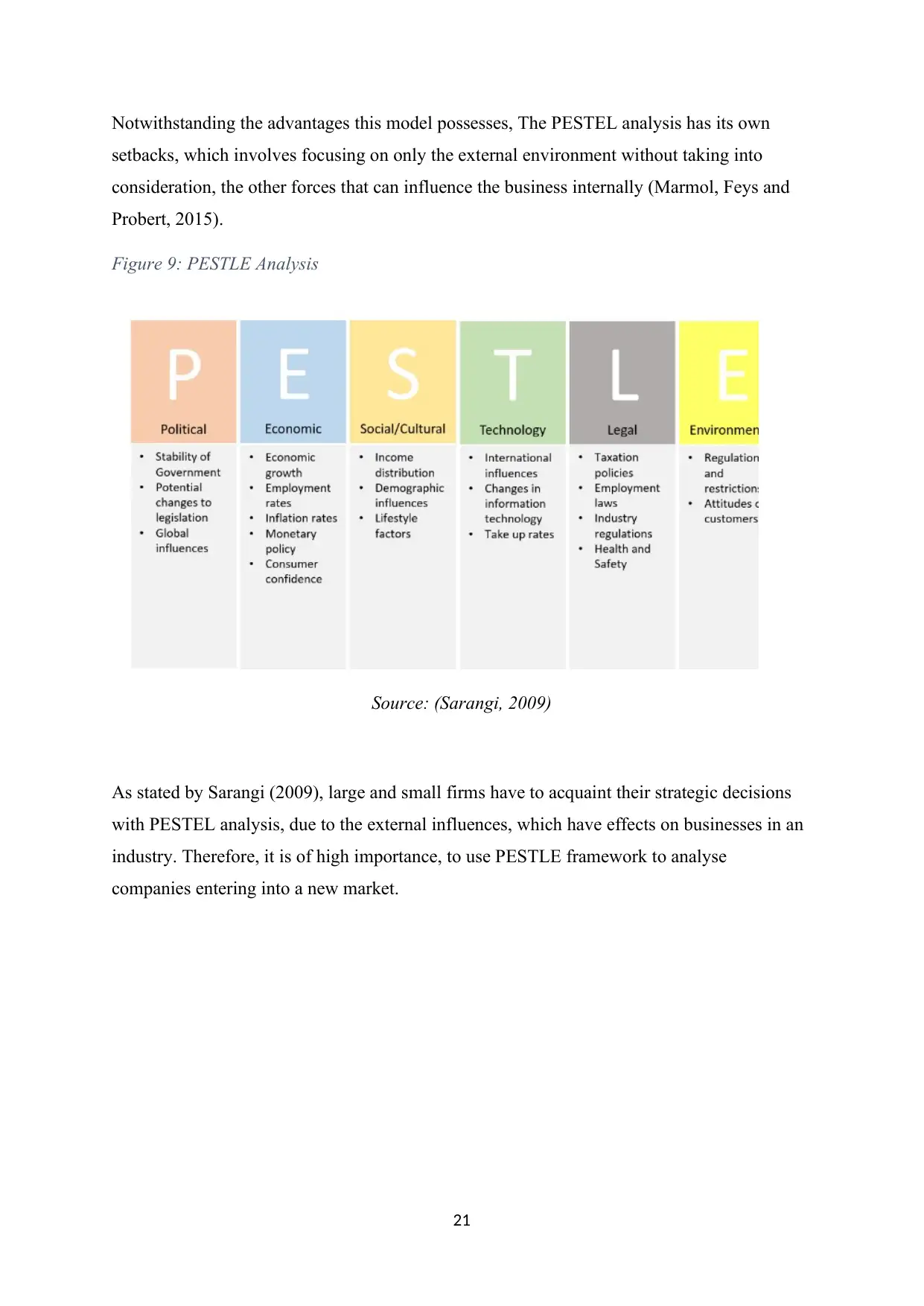
21
Notwithstanding the advantages this model possesses, The PESTEL analysis has its own
setbacks, which involves focusing on only the external environment without taking into
consideration, the other forces that can influence the business internally (Marmol, Feys and
Probert, 2015).
Figure 9: PESTLE Analysis
Source: (Sarangi, 2009)
As stated by Sarangi (2009), large and small firms have to acquaint their strategic decisions
with PESTEL analysis, due to the external influences, which have effects on businesses in an
industry. Therefore, it is of high importance, to use PESTLE framework to analyse
companies entering into a new market.
Notwithstanding the advantages this model possesses, The PESTEL analysis has its own
setbacks, which involves focusing on only the external environment without taking into
consideration, the other forces that can influence the business internally (Marmol, Feys and
Probert, 2015).
Figure 9: PESTLE Analysis
Source: (Sarangi, 2009)
As stated by Sarangi (2009), large and small firms have to acquaint their strategic decisions
with PESTEL analysis, due to the external influences, which have effects on businesses in an
industry. Therefore, it is of high importance, to use PESTLE framework to analyse
companies entering into a new market.
Secure Best Marks with AI Grader
Need help grading? Try our AI Grader for instant feedback on your assignments.
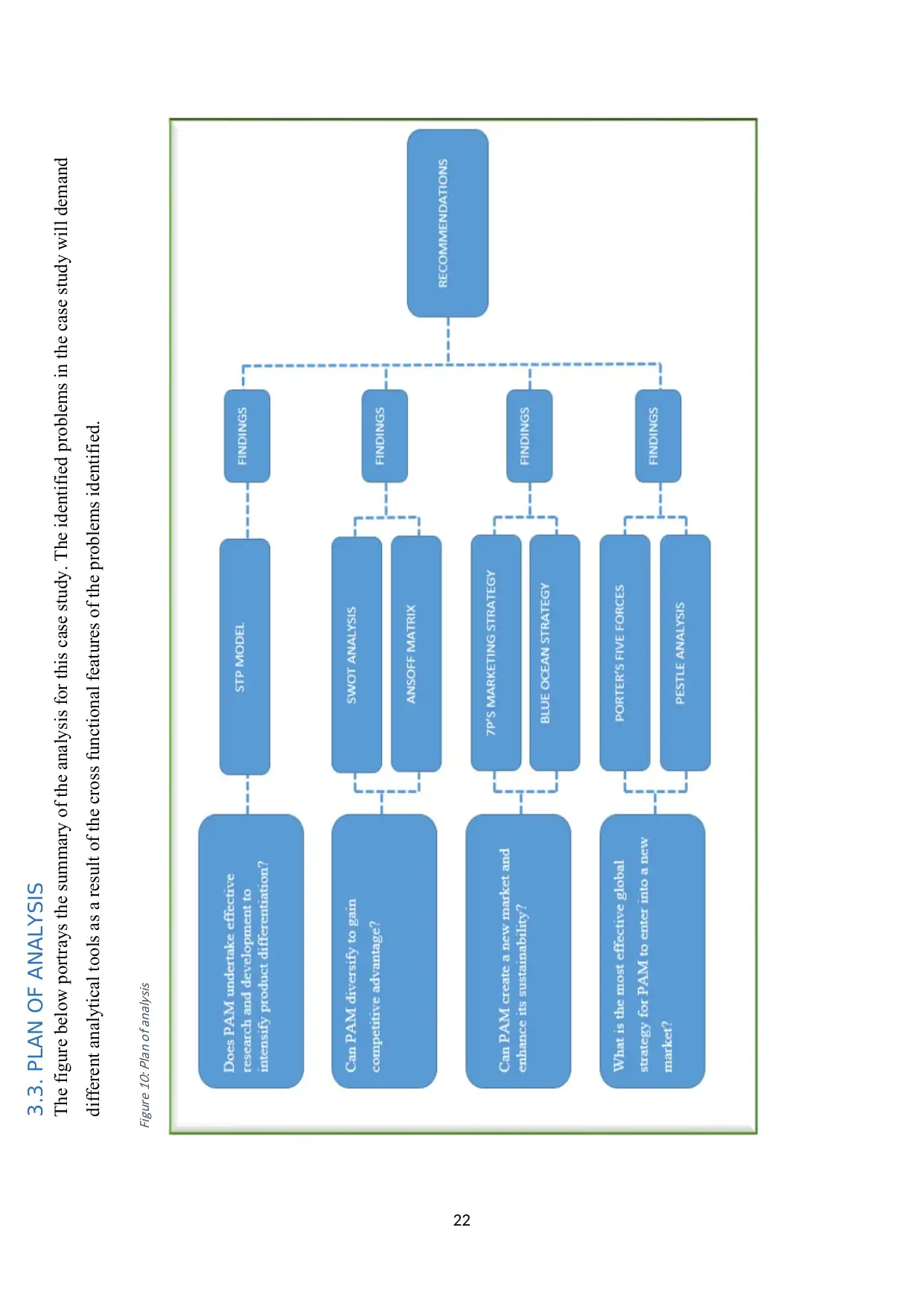
22
3.3. PLAN OF ANALYSIS
The figure below portrays the summary of the analysis for this case study. The identified problems in the case study will demand
different analytical tools as a result of the cross functional features of the problems identified.Figure lan of anal sis
10: P
y
3.3. PLAN OF ANALYSIS
The figure below portrays the summary of the analysis for this case study. The identified problems in the case study will demand
different analytical tools as a result of the cross functional features of the problems identified.Figure lan of anal sis
10: P
y
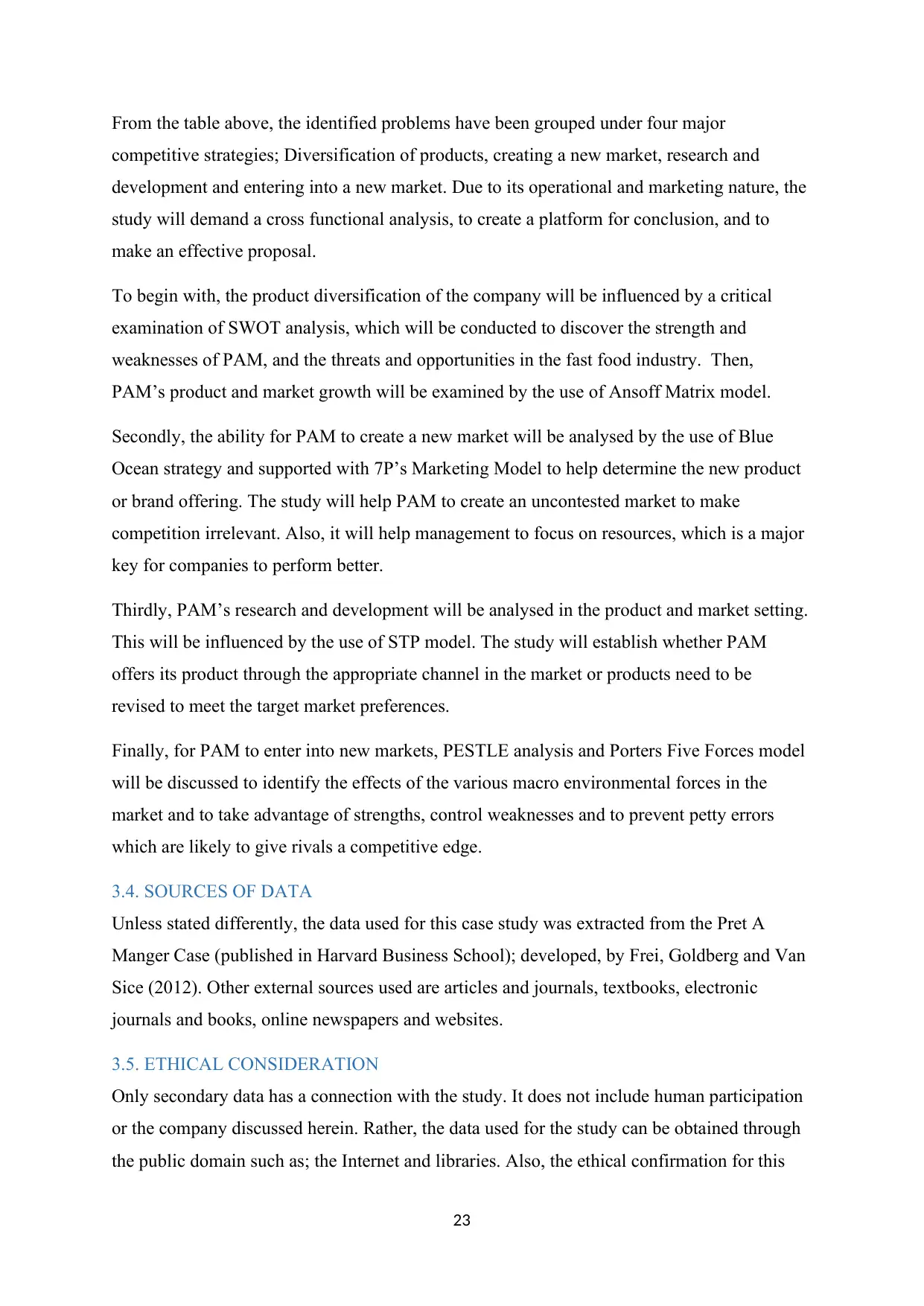
23
From the table above, the identified problems have been grouped under four major
competitive strategies; Diversification of products, creating a new market, research and
development and entering into a new market. Due to its operational and marketing nature, the
study will demand a cross functional analysis, to create a platform for conclusion, and to
make an effective proposal.
To begin with, the product diversification of the company will be influenced by a critical
examination of SWOT analysis, which will be conducted to discover the strength and
weaknesses of PAM, and the threats and opportunities in the fast food industry. Then,
PAM’s product and market growth will be examined by the use of Ansoff Matrix model.
Secondly, the ability for PAM to create a new market will be analysed by the use of Blue
Ocean strategy and supported with 7P’s Marketing Model to help determine the new product
or brand offering. The study will help PAM to create an uncontested market to make
competition irrelevant. Also, it will help management to focus on resources, which is a major
key for companies to perform better.
Thirdly, PAM’s research and development will be analysed in the product and market setting.
This will be influenced by the use of STP model. The study will establish whether PAM
offers its product through the appropriate channel in the market or products need to be
revised to meet the target market preferences.
Finally, for PAM to enter into new markets, PESTLE analysis and Porters Five Forces model
will be discussed to identify the effects of the various macro environmental forces in the
market and to take advantage of strengths, control weaknesses and to prevent petty errors
which are likely to give rivals a competitive edge.
3.4. SOURCES OF DATA
Unless stated differently, the data used for this case study was extracted from the Pret A
Manger Case (published in Harvard Business School); developed, by Frei, Goldberg and Van
Sice (2012). Other external sources used are articles and journals, textbooks, electronic
journals and books, online newspapers and websites.
3.5. ETHICAL CONSIDERATION
Only secondary data has a connection with the study. It does not include human participation
or the company discussed herein. Rather, the data used for the study can be obtained through
the public domain such as; the Internet and libraries. Also, the ethical confirmation for this
From the table above, the identified problems have been grouped under four major
competitive strategies; Diversification of products, creating a new market, research and
development and entering into a new market. Due to its operational and marketing nature, the
study will demand a cross functional analysis, to create a platform for conclusion, and to
make an effective proposal.
To begin with, the product diversification of the company will be influenced by a critical
examination of SWOT analysis, which will be conducted to discover the strength and
weaknesses of PAM, and the threats and opportunities in the fast food industry. Then,
PAM’s product and market growth will be examined by the use of Ansoff Matrix model.
Secondly, the ability for PAM to create a new market will be analysed by the use of Blue
Ocean strategy and supported with 7P’s Marketing Model to help determine the new product
or brand offering. The study will help PAM to create an uncontested market to make
competition irrelevant. Also, it will help management to focus on resources, which is a major
key for companies to perform better.
Thirdly, PAM’s research and development will be analysed in the product and market setting.
This will be influenced by the use of STP model. The study will establish whether PAM
offers its product through the appropriate channel in the market or products need to be
revised to meet the target market preferences.
Finally, for PAM to enter into new markets, PESTLE analysis and Porters Five Forces model
will be discussed to identify the effects of the various macro environmental forces in the
market and to take advantage of strengths, control weaknesses and to prevent petty errors
which are likely to give rivals a competitive edge.
3.4. SOURCES OF DATA
Unless stated differently, the data used for this case study was extracted from the Pret A
Manger Case (published in Harvard Business School); developed, by Frei, Goldberg and Van
Sice (2012). Other external sources used are articles and journals, textbooks, electronic
journals and books, online newspapers and websites.
3.5. ETHICAL CONSIDERATION
Only secondary data has a connection with the study. It does not include human participation
or the company discussed herein. Rather, the data used for the study can be obtained through
the public domain such as; the Internet and libraries. Also, the ethical confirmation for this
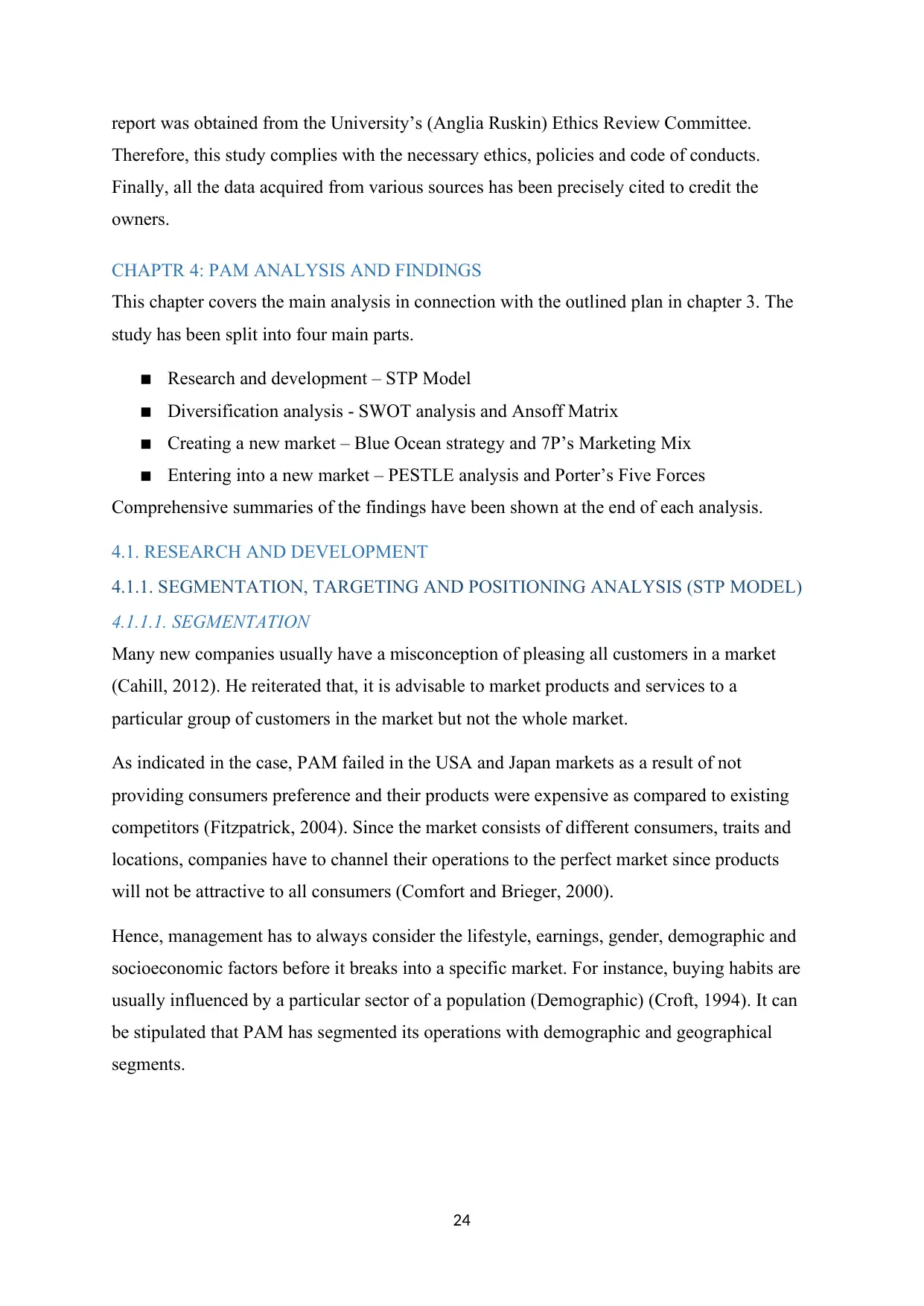
24
report was obtained from the University’s (Anglia Ruskin) Ethics Review Committee.
Therefore, this study complies with the necessary ethics, policies and code of conducts.
Finally, all the data acquired from various sources has been precisely cited to credit the
owners.
CHAPTR 4: PAM ANALYSIS AND FINDINGS
This chapter covers the main analysis in connection with the outlined plan in chapter 3. The
study has been split into four main parts.
▪ Research and development – STP Model
▪ Diversification analysis - SWOT analysis and Ansoff Matrix
▪ Creating a new market – Blue Ocean strategy and 7P’s Marketing Mix
▪ Entering into a new market – PESTLE analysis and Porter’s Five Forces
Comprehensive summaries of the findings have been shown at the end of each analysis.
4.1. RESEARCH AND DEVELOPMENT
4.1.1. SEGMENTATION, TARGETING AND POSITIONING ANALYSIS (STP MODEL)
4.1.1.1. SEGMENTATION
Many new companies usually have a misconception of pleasing all customers in a market
(Cahill, 2012). He reiterated that, it is advisable to market products and services to a
particular group of customers in the market but not the whole market.
As indicated in the case, PAM failed in the USA and Japan markets as a result of not
providing consumers preference and their products were expensive as compared to existing
competitors (Fitzpatrick, 2004). Since the market consists of different consumers, traits and
locations, companies have to channel their operations to the perfect market since products
will not be attractive to all consumers (Comfort and Brieger, 2000).
Hence, management has to always consider the lifestyle, earnings, gender, demographic and
socioeconomic factors before it breaks into a specific market. For instance, buying habits are
usually influenced by a particular sector of a population (Demographic) (Croft, 1994). It can
be stipulated that PAM has segmented its operations with demographic and geographical
segments.
report was obtained from the University’s (Anglia Ruskin) Ethics Review Committee.
Therefore, this study complies with the necessary ethics, policies and code of conducts.
Finally, all the data acquired from various sources has been precisely cited to credit the
owners.
CHAPTR 4: PAM ANALYSIS AND FINDINGS
This chapter covers the main analysis in connection with the outlined plan in chapter 3. The
study has been split into four main parts.
▪ Research and development – STP Model
▪ Diversification analysis - SWOT analysis and Ansoff Matrix
▪ Creating a new market – Blue Ocean strategy and 7P’s Marketing Mix
▪ Entering into a new market – PESTLE analysis and Porter’s Five Forces
Comprehensive summaries of the findings have been shown at the end of each analysis.
4.1. RESEARCH AND DEVELOPMENT
4.1.1. SEGMENTATION, TARGETING AND POSITIONING ANALYSIS (STP MODEL)
4.1.1.1. SEGMENTATION
Many new companies usually have a misconception of pleasing all customers in a market
(Cahill, 2012). He reiterated that, it is advisable to market products and services to a
particular group of customers in the market but not the whole market.
As indicated in the case, PAM failed in the USA and Japan markets as a result of not
providing consumers preference and their products were expensive as compared to existing
competitors (Fitzpatrick, 2004). Since the market consists of different consumers, traits and
locations, companies have to channel their operations to the perfect market since products
will not be attractive to all consumers (Comfort and Brieger, 2000).
Hence, management has to always consider the lifestyle, earnings, gender, demographic and
socioeconomic factors before it breaks into a specific market. For instance, buying habits are
usually influenced by a particular sector of a population (Demographic) (Croft, 1994). It can
be stipulated that PAM has segmented its operations with demographic and geographical
segments.
Paraphrase This Document
Need a fresh take? Get an instant paraphrase of this document with our AI Paraphraser
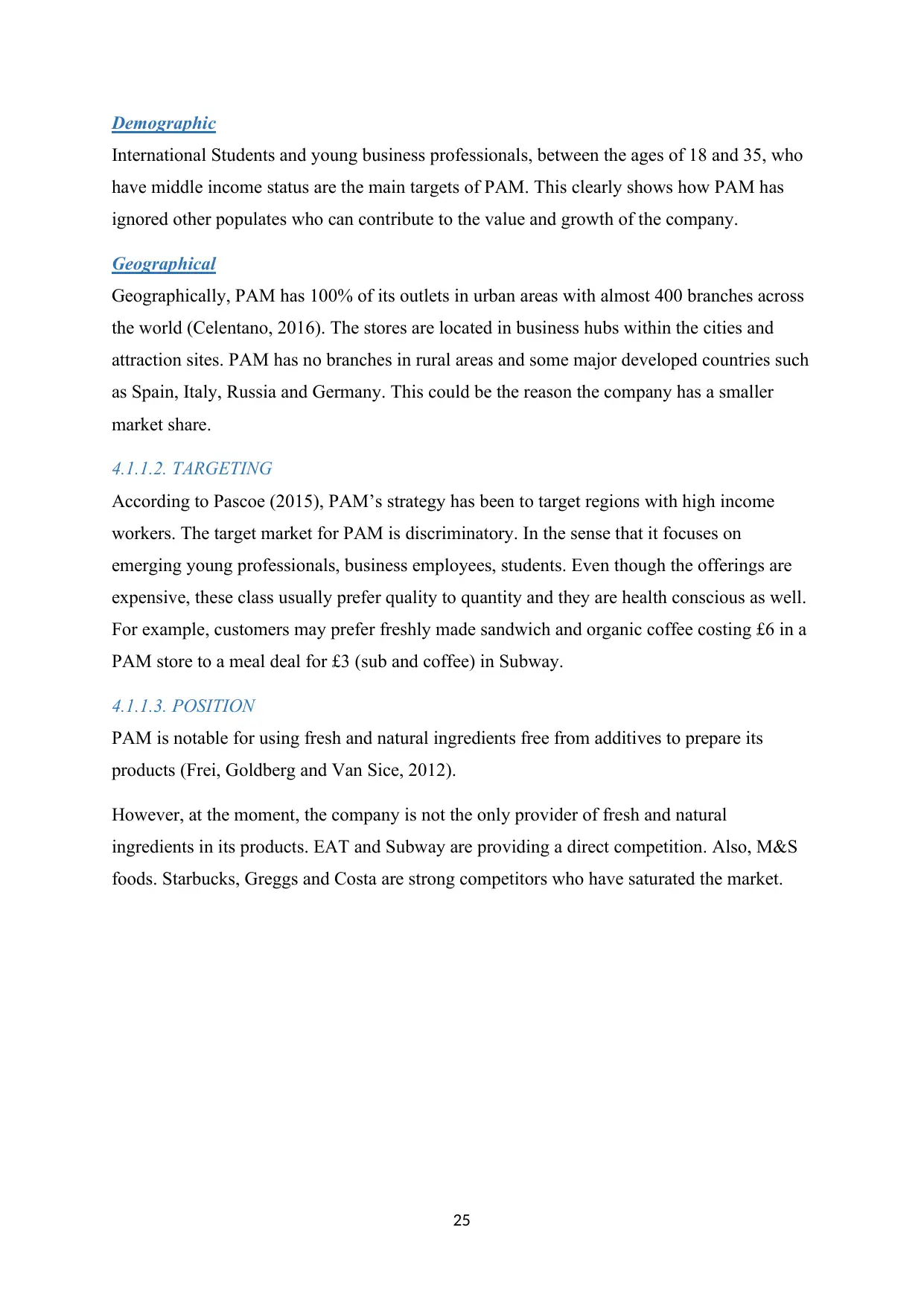
25
Demographic
International Students and young business professionals, between the ages of 18 and 35, who
have middle income status are the main targets of PAM. This clearly shows how PAM has
ignored other populates who can contribute to the value and growth of the company.
Geographical
Geographically, PAM has 100% of its outlets in urban areas with almost 400 branches across
the world (Celentano, 2016). The stores are located in business hubs within the cities and
attraction sites. PAM has no branches in rural areas and some major developed countries such
as Spain, Italy, Russia and Germany. This could be the reason the company has a smaller
market share.
4.1.1.2. TARGETING
According to Pascoe (2015), PAM’s strategy has been to target regions with high income
workers. The target market for PAM is discriminatory. In the sense that it focuses on
emerging young professionals, business employees, students. Even though the offerings are
expensive, these class usually prefer quality to quantity and they are health conscious as well.
For example, customers may prefer freshly made sandwich and organic coffee costing £6 in a
PAM store to a meal deal for £3 (sub and coffee) in Subway.
4.1.1.3. POSITION
PAM is notable for using fresh and natural ingredients free from additives to prepare its
products (Frei, Goldberg and Van Sice, 2012).
However, at the moment, the company is not the only provider of fresh and natural
ingredients in its products. EAT and Subway are providing a direct competition. Also, M&S
foods. Starbucks, Greggs and Costa are strong competitors who have saturated the market.
Demographic
International Students and young business professionals, between the ages of 18 and 35, who
have middle income status are the main targets of PAM. This clearly shows how PAM has
ignored other populates who can contribute to the value and growth of the company.
Geographical
Geographically, PAM has 100% of its outlets in urban areas with almost 400 branches across
the world (Celentano, 2016). The stores are located in business hubs within the cities and
attraction sites. PAM has no branches in rural areas and some major developed countries such
as Spain, Italy, Russia and Germany. This could be the reason the company has a smaller
market share.
4.1.1.2. TARGETING
According to Pascoe (2015), PAM’s strategy has been to target regions with high income
workers. The target market for PAM is discriminatory. In the sense that it focuses on
emerging young professionals, business employees, students. Even though the offerings are
expensive, these class usually prefer quality to quantity and they are health conscious as well.
For example, customers may prefer freshly made sandwich and organic coffee costing £6 in a
PAM store to a meal deal for £3 (sub and coffee) in Subway.
4.1.1.3. POSITION
PAM is notable for using fresh and natural ingredients free from additives to prepare its
products (Frei, Goldberg and Van Sice, 2012).
However, at the moment, the company is not the only provider of fresh and natural
ingredients in its products. EAT and Subway are providing a direct competition. Also, M&S
foods. Starbucks, Greggs and Costa are strong competitors who have saturated the market.
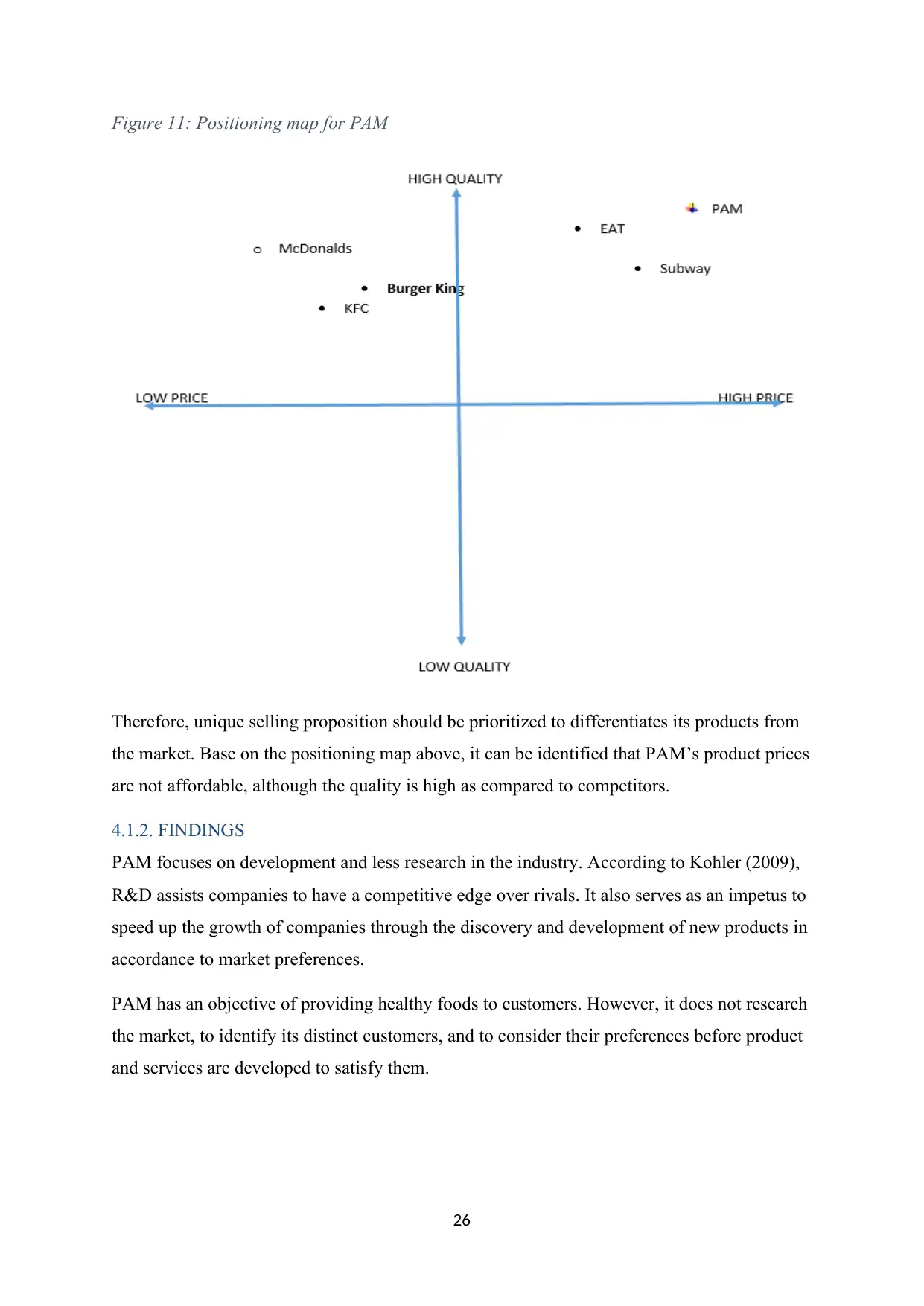
26
Figure 11: Positioning map for PAM
Therefore, unique selling proposition should be prioritized to differentiates its products from
the market. Base on the positioning map above, it can be identified that PAM’s product prices
are not affordable, although the quality is high as compared to competitors.
4.1.2. FINDINGS
PAM focuses on development and less research in the industry. According to Kohler (2009),
R&D assists companies to have a competitive edge over rivals. It also serves as an impetus to
speed up the growth of companies through the discovery and development of new products in
accordance to market preferences.
PAM has an objective of providing healthy foods to customers. However, it does not research
the market, to identify its distinct customers, and to consider their preferences before product
and services are developed to satisfy them.
Figure 11: Positioning map for PAM
Therefore, unique selling proposition should be prioritized to differentiates its products from
the market. Base on the positioning map above, it can be identified that PAM’s product prices
are not affordable, although the quality is high as compared to competitors.
4.1.2. FINDINGS
PAM focuses on development and less research in the industry. According to Kohler (2009),
R&D assists companies to have a competitive edge over rivals. It also serves as an impetus to
speed up the growth of companies through the discovery and development of new products in
accordance to market preferences.
PAM has an objective of providing healthy foods to customers. However, it does not research
the market, to identify its distinct customers, and to consider their preferences before product
and services are developed to satisfy them.
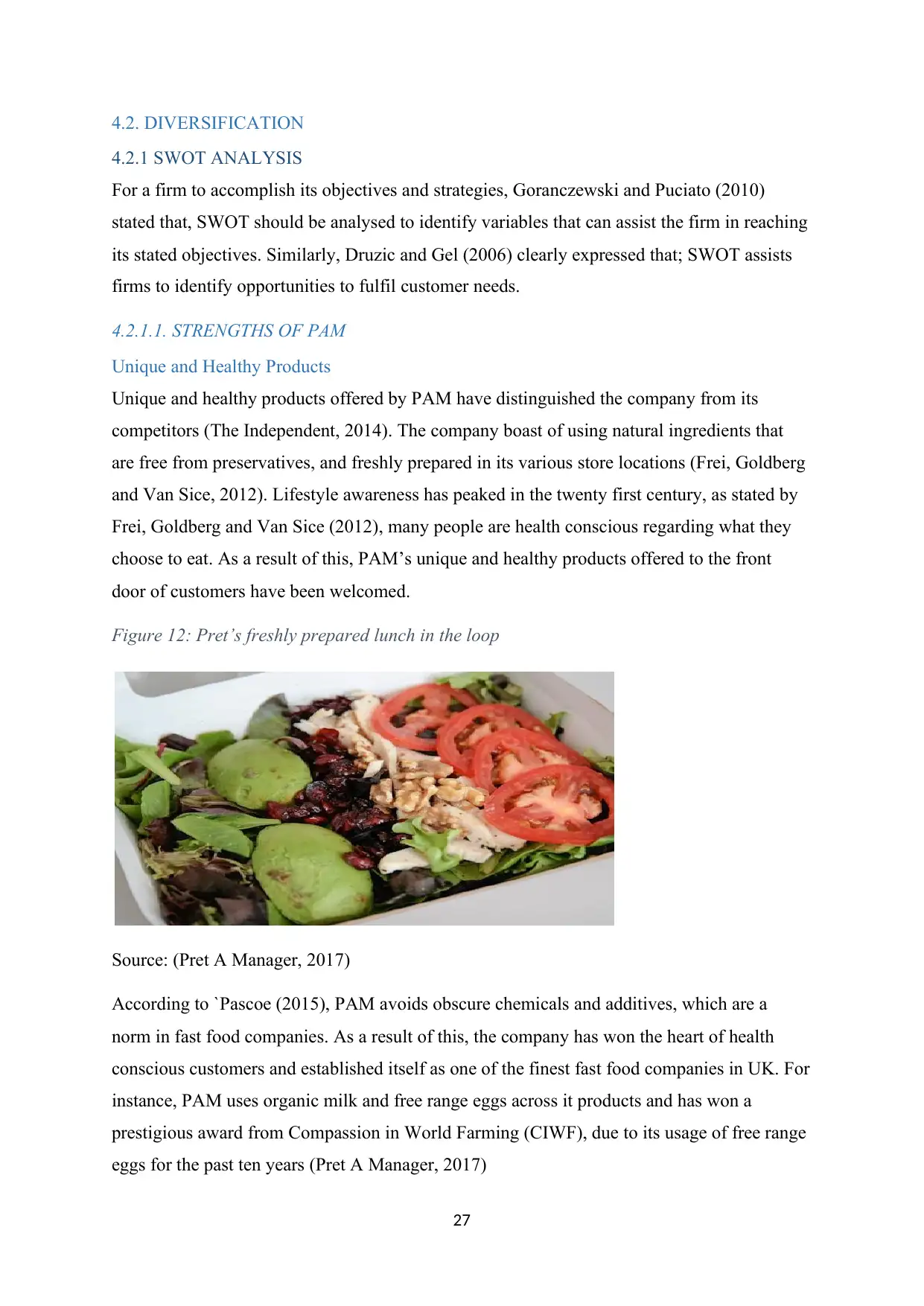
27
4.2. DIVERSIFICATION
4.2.1 SWOT ANALYSIS
For a firm to accomplish its objectives and strategies, Goranczewski and Puciato (2010)
stated that, SWOT should be analysed to identify variables that can assist the firm in reaching
its stated objectives. Similarly, Druzic and Gel (2006) clearly expressed that; SWOT assists
firms to identify opportunities to fulfil customer needs.
4.2.1.1. STRENGTHS OF PAM
Unique and Healthy Products
Unique and healthy products offered by PAM have distinguished the company from its
competitors (The Independent, 2014). The company boast of using natural ingredients that
are free from preservatives, and freshly prepared in its various store locations (Frei, Goldberg
and Van Sice, 2012). Lifestyle awareness has peaked in the twenty first century, as stated by
Frei, Goldberg and Van Sice (2012), many people are health conscious regarding what they
choose to eat. As a result of this, PAM’s unique and healthy products offered to the front
door of customers have been welcomed.
Figure 12: Pret’s freshly prepared lunch in the loop
Source: (Pret A Manager, 2017)
According to `Pascoe (2015), PAM avoids obscure chemicals and additives, which are a
norm in fast food companies. As a result of this, the company has won the heart of health
conscious customers and established itself as one of the finest fast food companies in UK. For
instance, PAM uses organic milk and free range eggs across it products and has won a
prestigious award from Compassion in World Farming (CIWF), due to its usage of free range
eggs for the past ten years (Pret A Manager, 2017)
4.2. DIVERSIFICATION
4.2.1 SWOT ANALYSIS
For a firm to accomplish its objectives and strategies, Goranczewski and Puciato (2010)
stated that, SWOT should be analysed to identify variables that can assist the firm in reaching
its stated objectives. Similarly, Druzic and Gel (2006) clearly expressed that; SWOT assists
firms to identify opportunities to fulfil customer needs.
4.2.1.1. STRENGTHS OF PAM
Unique and Healthy Products
Unique and healthy products offered by PAM have distinguished the company from its
competitors (The Independent, 2014). The company boast of using natural ingredients that
are free from preservatives, and freshly prepared in its various store locations (Frei, Goldberg
and Van Sice, 2012). Lifestyle awareness has peaked in the twenty first century, as stated by
Frei, Goldberg and Van Sice (2012), many people are health conscious regarding what they
choose to eat. As a result of this, PAM’s unique and healthy products offered to the front
door of customers have been welcomed.
Figure 12: Pret’s freshly prepared lunch in the loop
Source: (Pret A Manager, 2017)
According to `Pascoe (2015), PAM avoids obscure chemicals and additives, which are a
norm in fast food companies. As a result of this, the company has won the heart of health
conscious customers and established itself as one of the finest fast food companies in UK. For
instance, PAM uses organic milk and free range eggs across it products and has won a
prestigious award from Compassion in World Farming (CIWF), due to its usage of free range
eggs for the past ten years (Pret A Manager, 2017)
Secure Best Marks with AI Grader
Need help grading? Try our AI Grader for instant feedback on your assignments.
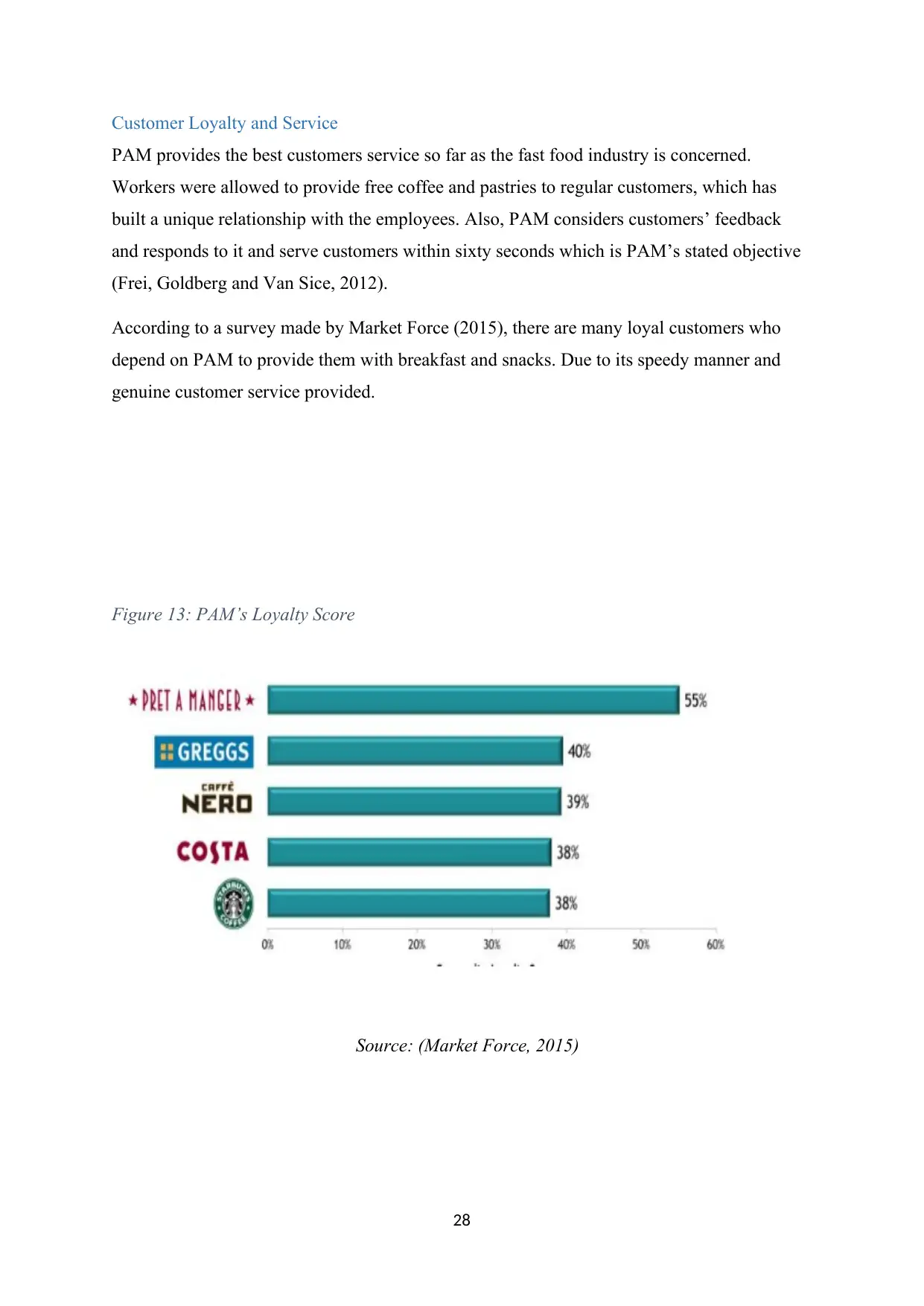
28
Customer Loyalty and Service
PAM provides the best customers service so far as the fast food industry is concerned.
Workers were allowed to provide free coffee and pastries to regular customers, which has
built a unique relationship with the employees. Also, PAM considers customers’ feedback
and responds to it and serve customers within sixty seconds which is PAM’s stated objective
(Frei, Goldberg and Van Sice, 2012).
According to a survey made by Market Force (2015), there are many loyal customers who
depend on PAM to provide them with breakfast and snacks. Due to its speedy manner and
genuine customer service provided.
Figure 13: PAM’s Loyalty Score
Source: (Market Force, 2015)
Customer Loyalty and Service
PAM provides the best customers service so far as the fast food industry is concerned.
Workers were allowed to provide free coffee and pastries to regular customers, which has
built a unique relationship with the employees. Also, PAM considers customers’ feedback
and responds to it and serve customers within sixty seconds which is PAM’s stated objective
(Frei, Goldberg and Van Sice, 2012).
According to a survey made by Market Force (2015), there are many loyal customers who
depend on PAM to provide them with breakfast and snacks. Due to its speedy manner and
genuine customer service provided.
Figure 13: PAM’s Loyalty Score
Source: (Market Force, 2015)
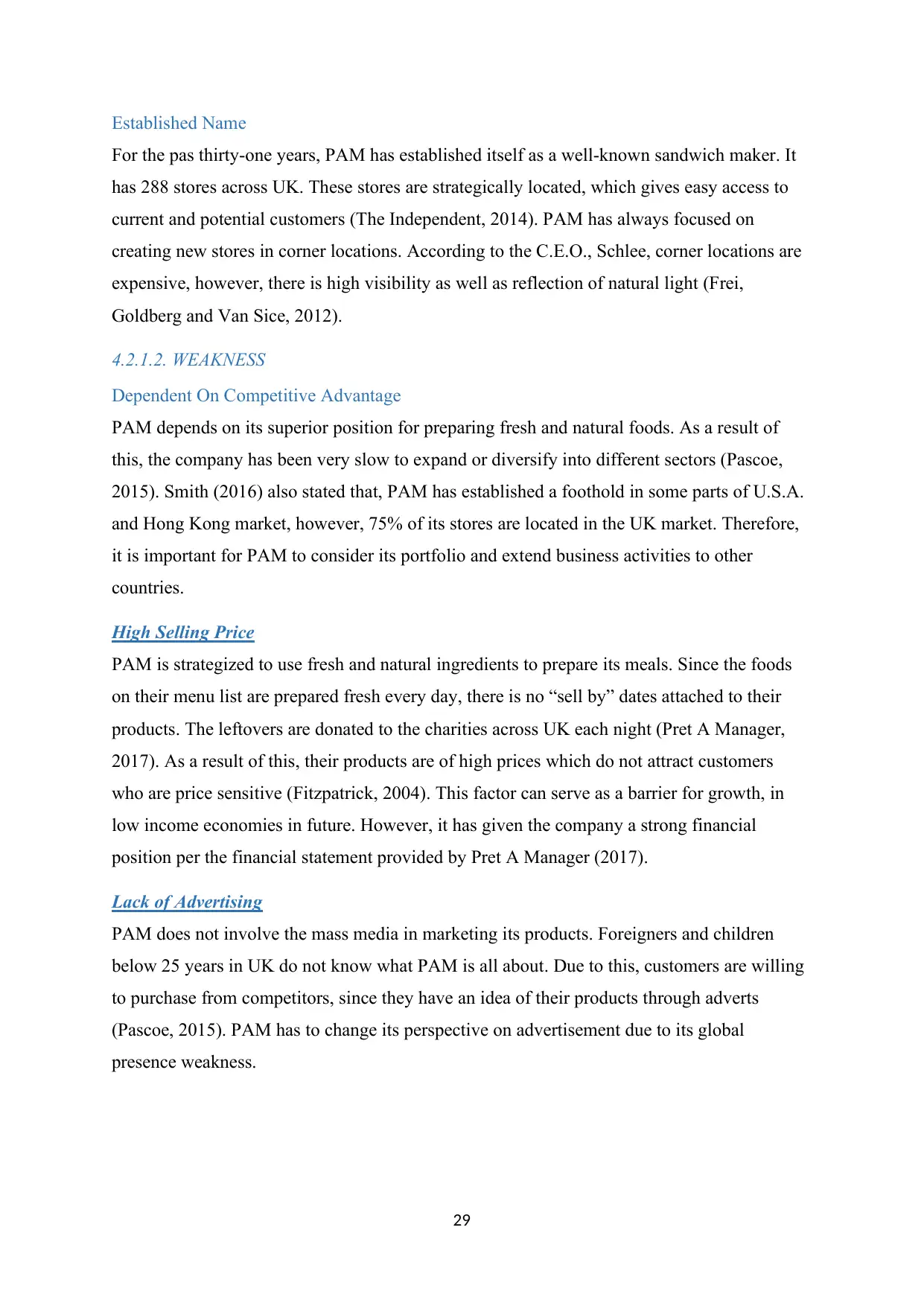
29
Established Name
For the pas thirty-one years, PAM has established itself as a well-known sandwich maker. It
has 288 stores across UK. These stores are strategically located, which gives easy access to
current and potential customers (The Independent, 2014). PAM has always focused on
creating new stores in corner locations. According to the C.E.O., Schlee, corner locations are
expensive, however, there is high visibility as well as reflection of natural light (Frei,
Goldberg and Van Sice, 2012).
4.2.1.2. WEAKNESS
Dependent On Competitive Advantage
PAM depends on its superior position for preparing fresh and natural foods. As a result of
this, the company has been very slow to expand or diversify into different sectors (Pascoe,
2015). Smith (2016) also stated that, PAM has established a foothold in some parts of U.S.A.
and Hong Kong market, however, 75% of its stores are located in the UK market. Therefore,
it is important for PAM to consider its portfolio and extend business activities to other
countries.
High Selling Price
PAM is strategized to use fresh and natural ingredients to prepare its meals. Since the foods
on their menu list are prepared fresh every day, there is no “sell by” dates attached to their
products. The leftovers are donated to the charities across UK each night (Pret A Manager,
2017). As a result of this, their products are of high prices which do not attract customers
who are price sensitive (Fitzpatrick, 2004). This factor can serve as a barrier for growth, in
low income economies in future. However, it has given the company a strong financial
position per the financial statement provided by Pret A Manager (2017).
Lack of Advertising
PAM does not involve the mass media in marketing its products. Foreigners and children
below 25 years in UK do not know what PAM is all about. Due to this, customers are willing
to purchase from competitors, since they have an idea of their products through adverts
(Pascoe, 2015). PAM has to change its perspective on advertisement due to its global
presence weakness.
Established Name
For the pas thirty-one years, PAM has established itself as a well-known sandwich maker. It
has 288 stores across UK. These stores are strategically located, which gives easy access to
current and potential customers (The Independent, 2014). PAM has always focused on
creating new stores in corner locations. According to the C.E.O., Schlee, corner locations are
expensive, however, there is high visibility as well as reflection of natural light (Frei,
Goldberg and Van Sice, 2012).
4.2.1.2. WEAKNESS
Dependent On Competitive Advantage
PAM depends on its superior position for preparing fresh and natural foods. As a result of
this, the company has been very slow to expand or diversify into different sectors (Pascoe,
2015). Smith (2016) also stated that, PAM has established a foothold in some parts of U.S.A.
and Hong Kong market, however, 75% of its stores are located in the UK market. Therefore,
it is important for PAM to consider its portfolio and extend business activities to other
countries.
High Selling Price
PAM is strategized to use fresh and natural ingredients to prepare its meals. Since the foods
on their menu list are prepared fresh every day, there is no “sell by” dates attached to their
products. The leftovers are donated to the charities across UK each night (Pret A Manager,
2017). As a result of this, their products are of high prices which do not attract customers
who are price sensitive (Fitzpatrick, 2004). This factor can serve as a barrier for growth, in
low income economies in future. However, it has given the company a strong financial
position per the financial statement provided by Pret A Manager (2017).
Lack of Advertising
PAM does not involve the mass media in marketing its products. Foreigners and children
below 25 years in UK do not know what PAM is all about. Due to this, customers are willing
to purchase from competitors, since they have an idea of their products through adverts
(Pascoe, 2015). PAM has to change its perspective on advertisement due to its global
presence weakness.
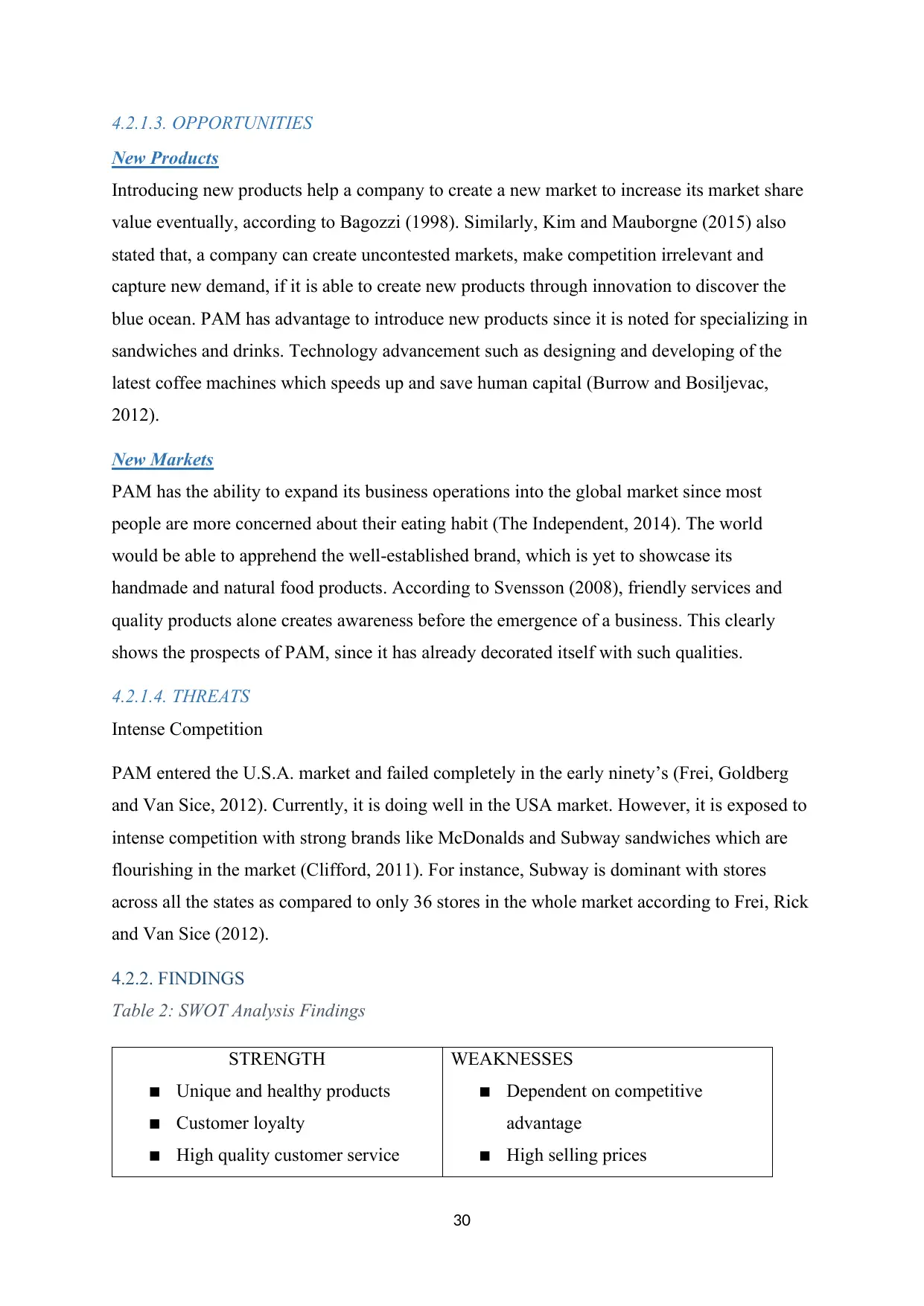
30
4.2.1.3. OPPORTUNITIES
New Products
Introducing new products help a company to create a new market to increase its market share
value eventually, according to Bagozzi (1998). Similarly, Kim and Mauborgne (2015) also
stated that, a company can create uncontested markets, make competition irrelevant and
capture new demand, if it is able to create new products through innovation to discover the
blue ocean. PAM has advantage to introduce new products since it is noted for specializing in
sandwiches and drinks. Technology advancement such as designing and developing of the
latest coffee machines which speeds up and save human capital (Burrow and Bosiljevac,
2012).
New Markets
PAM has the ability to expand its business operations into the global market since most
people are more concerned about their eating habit (The Independent, 2014). The world
would be able to apprehend the well-established brand, which is yet to showcase its
handmade and natural food products. According to Svensson (2008), friendly services and
quality products alone creates awareness before the emergence of a business. This clearly
shows the prospects of PAM, since it has already decorated itself with such qualities.
4.2.1.4. THREATS
Intense Competition
PAM entered the U.S.A. market and failed completely in the early ninety’s (Frei, Goldberg
and Van Sice, 2012). Currently, it is doing well in the USA market. However, it is exposed to
intense competition with strong brands like McDonalds and Subway sandwiches which are
flourishing in the market (Clifford, 2011). For instance, Subway is dominant with stores
across all the states as compared to only 36 stores in the whole market according to Frei, Rick
and Van Sice (2012).
4.2.2. FINDINGS
Table 2: SWOT Analysis Findings
STRENGTH
▪ Unique and healthy products
▪ Customer loyalty
▪ High quality customer service
WEAKNESSES
▪ Dependent on competitive
advantage
▪ High selling prices
4.2.1.3. OPPORTUNITIES
New Products
Introducing new products help a company to create a new market to increase its market share
value eventually, according to Bagozzi (1998). Similarly, Kim and Mauborgne (2015) also
stated that, a company can create uncontested markets, make competition irrelevant and
capture new demand, if it is able to create new products through innovation to discover the
blue ocean. PAM has advantage to introduce new products since it is noted for specializing in
sandwiches and drinks. Technology advancement such as designing and developing of the
latest coffee machines which speeds up and save human capital (Burrow and Bosiljevac,
2012).
New Markets
PAM has the ability to expand its business operations into the global market since most
people are more concerned about their eating habit (The Independent, 2014). The world
would be able to apprehend the well-established brand, which is yet to showcase its
handmade and natural food products. According to Svensson (2008), friendly services and
quality products alone creates awareness before the emergence of a business. This clearly
shows the prospects of PAM, since it has already decorated itself with such qualities.
4.2.1.4. THREATS
Intense Competition
PAM entered the U.S.A. market and failed completely in the early ninety’s (Frei, Goldberg
and Van Sice, 2012). Currently, it is doing well in the USA market. However, it is exposed to
intense competition with strong brands like McDonalds and Subway sandwiches which are
flourishing in the market (Clifford, 2011). For instance, Subway is dominant with stores
across all the states as compared to only 36 stores in the whole market according to Frei, Rick
and Van Sice (2012).
4.2.2. FINDINGS
Table 2: SWOT Analysis Findings
STRENGTH
▪ Unique and healthy products
▪ Customer loyalty
▪ High quality customer service
WEAKNESSES
▪ Dependent on competitive
advantage
▪ High selling prices
Paraphrase This Document
Need a fresh take? Get an instant paraphrase of this document with our AI Paraphraser
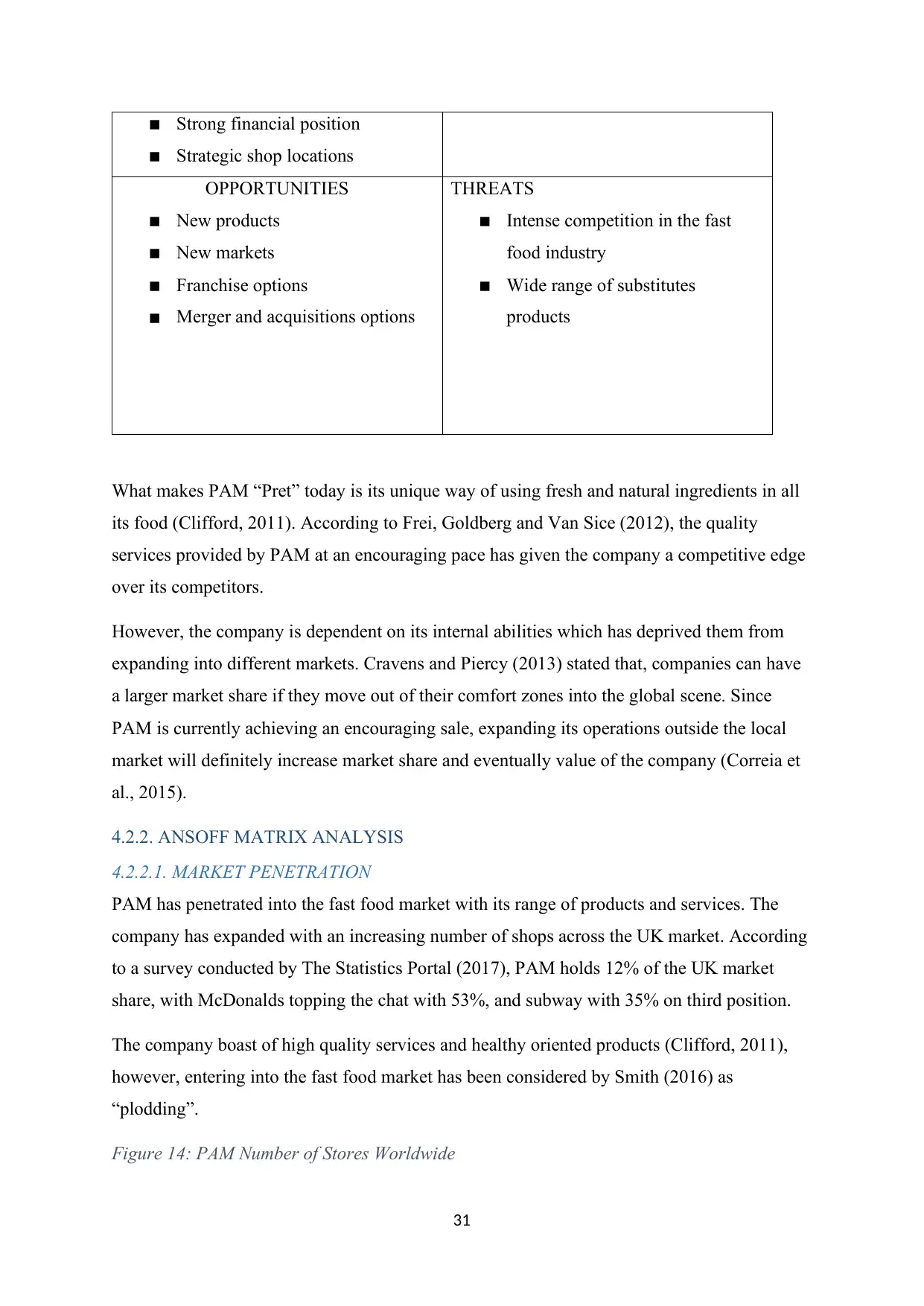
31
▪ Strong financial position
▪ Strategic shop locations
OPPORTUNITIES
▪ New products
▪ New markets
▪ Franchise options
▪ Merger and acquisitions options
THREATS
▪ Intense competition in the fast
food industry
▪ Wide range of substitutes
products
What makes PAM “Pret” today is its unique way of using fresh and natural ingredients in all
its food (Clifford, 2011). According to Frei, Goldberg and Van Sice (2012), the quality
services provided by PAM at an encouraging pace has given the company a competitive edge
over its competitors.
However, the company is dependent on its internal abilities which has deprived them from
expanding into different markets. Cravens and Piercy (2013) stated that, companies can have
a larger market share if they move out of their comfort zones into the global scene. Since
PAM is currently achieving an encouraging sale, expanding its operations outside the local
market will definitely increase market share and eventually value of the company (Correia et
al., 2015).
4.2.2. ANSOFF MATRIX ANALYSIS
4.2.2.1. MARKET PENETRATION
PAM has penetrated into the fast food market with its range of products and services. The
company has expanded with an increasing number of shops across the UK market. According
to a survey conducted by The Statistics Portal (2017), PAM holds 12% of the UK market
share, with McDonalds topping the chat with 53%, and subway with 35% on third position.
The company boast of high quality services and healthy oriented products (Clifford, 2011),
however, entering into the fast food market has been considered by Smith (2016) as
“plodding”.
Figure 14: PAM Number of Stores Worldwide
▪ Strong financial position
▪ Strategic shop locations
OPPORTUNITIES
▪ New products
▪ New markets
▪ Franchise options
▪ Merger and acquisitions options
THREATS
▪ Intense competition in the fast
food industry
▪ Wide range of substitutes
products
What makes PAM “Pret” today is its unique way of using fresh and natural ingredients in all
its food (Clifford, 2011). According to Frei, Goldberg and Van Sice (2012), the quality
services provided by PAM at an encouraging pace has given the company a competitive edge
over its competitors.
However, the company is dependent on its internal abilities which has deprived them from
expanding into different markets. Cravens and Piercy (2013) stated that, companies can have
a larger market share if they move out of their comfort zones into the global scene. Since
PAM is currently achieving an encouraging sale, expanding its operations outside the local
market will definitely increase market share and eventually value of the company (Correia et
al., 2015).
4.2.2. ANSOFF MATRIX ANALYSIS
4.2.2.1. MARKET PENETRATION
PAM has penetrated into the fast food market with its range of products and services. The
company has expanded with an increasing number of shops across the UK market. According
to a survey conducted by The Statistics Portal (2017), PAM holds 12% of the UK market
share, with McDonalds topping the chat with 53%, and subway with 35% on third position.
The company boast of high quality services and healthy oriented products (Clifford, 2011),
however, entering into the fast food market has been considered by Smith (2016) as
“plodding”.
Figure 14: PAM Number of Stores Worldwide
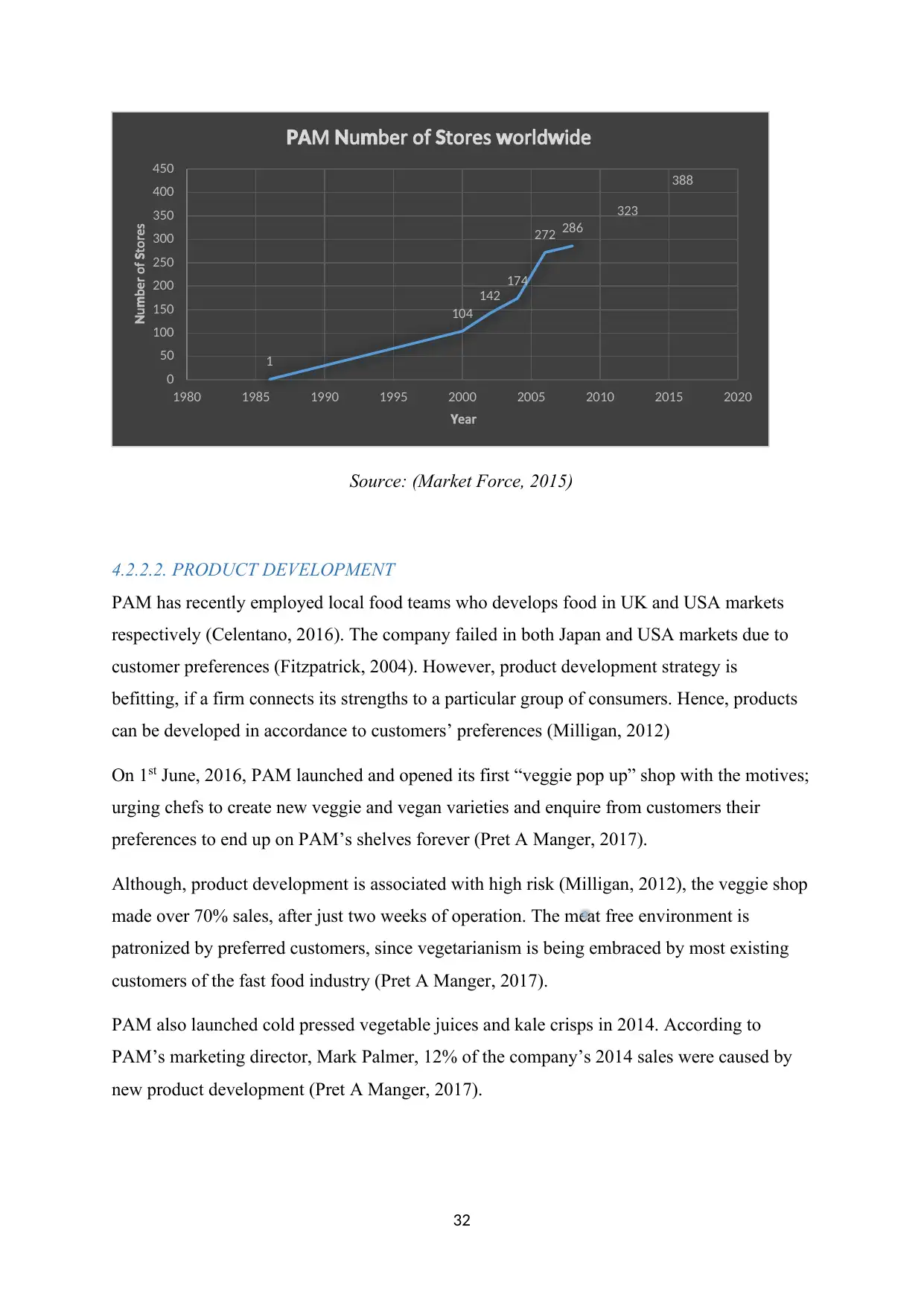
32
Source: (Market Force, 2015)
4.2.2.2. PRODUCT DEVELOPMENT
PAM has recently employed local food teams who develops food in UK and USA markets
respectively (Celentano, 2016). The company failed in both Japan and USA markets due to
customer preferences (Fitzpatrick, 2004). However, product development strategy is
befitting, if a firm connects its strengths to a particular group of consumers. Hence, products
can be developed in accordance to customers’ preferences (Milligan, 2012)
On 1st June, 2016, PAM launched and opened its first “veggie pop up” shop with the motives;
urging chefs to create new veggie and vegan varieties and enquire from customers their
preferences to end up on PAM’s shelves forever (Pret A Manger, 2017).
Although, product development is associated with high risk (Milligan, 2012), the veggie shop
made over 70% sales, after just two weeks of operation. The meat free environment is
patronized by preferred customers, since vegetarianism is being embraced by most existing
customers of the fast food industry (Pret A Manger, 2017).
PAM also launched cold pressed vegetable juices and kale crisps in 2014. According to
PAM’s marketing director, Mark Palmer, 12% of the company’s 2014 sales were caused by
new product development (Pret A Manger, 2017).
1
104
142
174
272 286
323
388
0
50
100
150
200
250
300
350
400
450
1980 1985 1990 1995 2000 2005 2010 2015 2020
u ber of toresN m S
earY
M u ber of tores orld idePA N m S w w
Source: (Market Force, 2015)
4.2.2.2. PRODUCT DEVELOPMENT
PAM has recently employed local food teams who develops food in UK and USA markets
respectively (Celentano, 2016). The company failed in both Japan and USA markets due to
customer preferences (Fitzpatrick, 2004). However, product development strategy is
befitting, if a firm connects its strengths to a particular group of consumers. Hence, products
can be developed in accordance to customers’ preferences (Milligan, 2012)
On 1st June, 2016, PAM launched and opened its first “veggie pop up” shop with the motives;
urging chefs to create new veggie and vegan varieties and enquire from customers their
preferences to end up on PAM’s shelves forever (Pret A Manger, 2017).
Although, product development is associated with high risk (Milligan, 2012), the veggie shop
made over 70% sales, after just two weeks of operation. The meat free environment is
patronized by preferred customers, since vegetarianism is being embraced by most existing
customers of the fast food industry (Pret A Manger, 2017).
PAM also launched cold pressed vegetable juices and kale crisps in 2014. According to
PAM’s marketing director, Mark Palmer, 12% of the company’s 2014 sales were caused by
new product development (Pret A Manger, 2017).
1
104
142
174
272 286
323
388
0
50
100
150
200
250
300
350
400
450
1980 1985 1990 1995 2000 2005 2010 2015 2020
u ber of toresN m S
earY
M u ber of tores orld idePA N m S w w
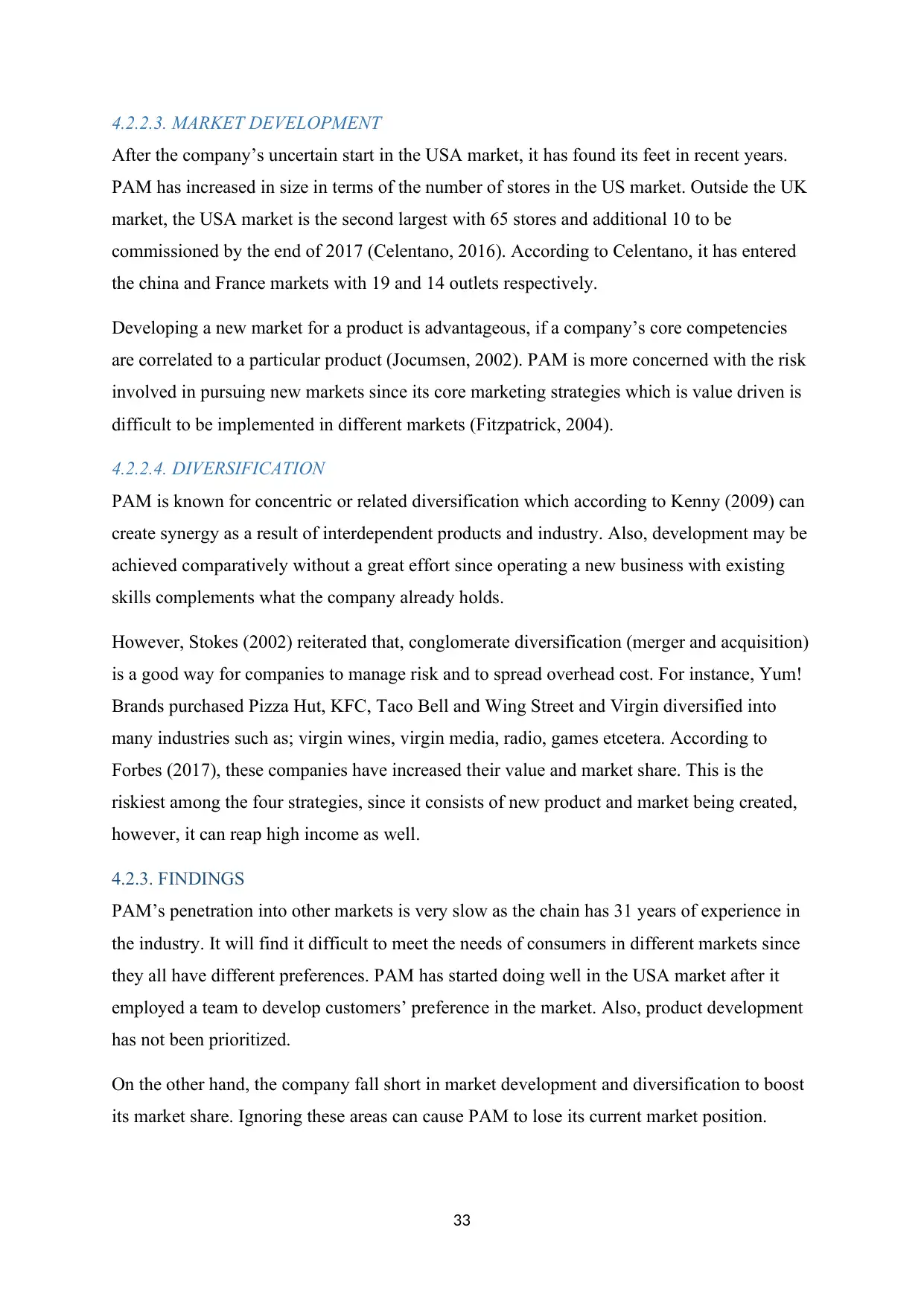
33
4.2.2.3. MARKET DEVELOPMENT
After the company’s uncertain start in the USA market, it has found its feet in recent years.
PAM has increased in size in terms of the number of stores in the US market. Outside the UK
market, the USA market is the second largest with 65 stores and additional 10 to be
commissioned by the end of 2017 (Celentano, 2016). According to Celentano, it has entered
the china and France markets with 19 and 14 outlets respectively.
Developing a new market for a product is advantageous, if a company’s core competencies
are correlated to a particular product (Jocumsen, 2002). PAM is more concerned with the risk
involved in pursuing new markets since its core marketing strategies which is value driven is
difficult to be implemented in different markets (Fitzpatrick, 2004).
4.2.2.4. DIVERSIFICATION
PAM is known for concentric or related diversification which according to Kenny (2009) can
create synergy as a result of interdependent products and industry. Also, development may be
achieved comparatively without a great effort since operating a new business with existing
skills complements what the company already holds.
However, Stokes (2002) reiterated that, conglomerate diversification (merger and acquisition)
is a good way for companies to manage risk and to spread overhead cost. For instance, Yum!
Brands purchased Pizza Hut, KFC, Taco Bell and Wing Street and Virgin diversified into
many industries such as; virgin wines, virgin media, radio, games etcetera. According to
Forbes (2017), these companies have increased their value and market share. This is the
riskiest among the four strategies, since it consists of new product and market being created,
however, it can reap high income as well.
4.2.3. FINDINGS
PAM’s penetration into other markets is very slow as the chain has 31 years of experience in
the industry. It will find it difficult to meet the needs of consumers in different markets since
they all have different preferences. PAM has started doing well in the USA market after it
employed a team to develop customers’ preference in the market. Also, product development
has not been prioritized.
On the other hand, the company fall short in market development and diversification to boost
its market share. Ignoring these areas can cause PAM to lose its current market position.
4.2.2.3. MARKET DEVELOPMENT
After the company’s uncertain start in the USA market, it has found its feet in recent years.
PAM has increased in size in terms of the number of stores in the US market. Outside the UK
market, the USA market is the second largest with 65 stores and additional 10 to be
commissioned by the end of 2017 (Celentano, 2016). According to Celentano, it has entered
the china and France markets with 19 and 14 outlets respectively.
Developing a new market for a product is advantageous, if a company’s core competencies
are correlated to a particular product (Jocumsen, 2002). PAM is more concerned with the risk
involved in pursuing new markets since its core marketing strategies which is value driven is
difficult to be implemented in different markets (Fitzpatrick, 2004).
4.2.2.4. DIVERSIFICATION
PAM is known for concentric or related diversification which according to Kenny (2009) can
create synergy as a result of interdependent products and industry. Also, development may be
achieved comparatively without a great effort since operating a new business with existing
skills complements what the company already holds.
However, Stokes (2002) reiterated that, conglomerate diversification (merger and acquisition)
is a good way for companies to manage risk and to spread overhead cost. For instance, Yum!
Brands purchased Pizza Hut, KFC, Taco Bell and Wing Street and Virgin diversified into
many industries such as; virgin wines, virgin media, radio, games etcetera. According to
Forbes (2017), these companies have increased their value and market share. This is the
riskiest among the four strategies, since it consists of new product and market being created,
however, it can reap high income as well.
4.2.3. FINDINGS
PAM’s penetration into other markets is very slow as the chain has 31 years of experience in
the industry. It will find it difficult to meet the needs of consumers in different markets since
they all have different preferences. PAM has started doing well in the USA market after it
employed a team to develop customers’ preference in the market. Also, product development
has not been prioritized.
On the other hand, the company fall short in market development and diversification to boost
its market share. Ignoring these areas can cause PAM to lose its current market position.
Secure Best Marks with AI Grader
Need help grading? Try our AI Grader for instant feedback on your assignments.
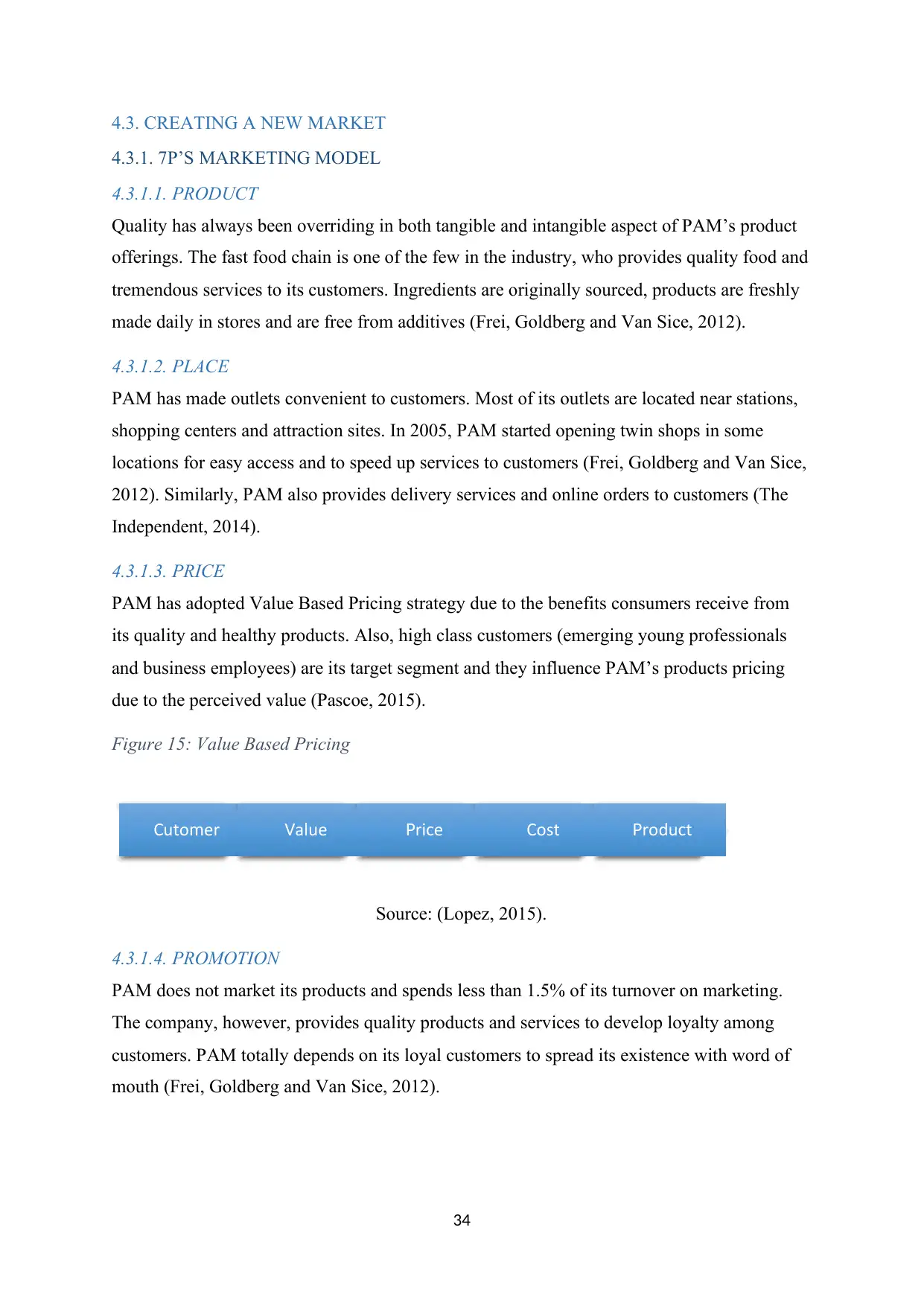
34
4.3. CREATING A NEW MARKET
4.3.1. 7P’S MARKETING MODEL
4.3.1.1. PRODUCT
Quality has always been overriding in both tangible and intangible aspect of PAM’s product
offerings. The fast food chain is one of the few in the industry, who provides quality food and
tremendous services to its customers. Ingredients are originally sourced, products are freshly
made daily in stores and are free from additives (Frei, Goldberg and Van Sice, 2012).
4.3.1.2. PLACE
PAM has made outlets convenient to customers. Most of its outlets are located near stations,
shopping centers and attraction sites. In 2005, PAM started opening twin shops in some
locations for easy access and to speed up services to customers (Frei, Goldberg and Van Sice,
2012). Similarly, PAM also provides delivery services and online orders to customers (The
Independent, 2014).
4.3.1.3. PRICE
PAM has adopted Value Based Pricing strategy due to the benefits consumers receive from
its quality and healthy products. Also, high class customers (emerging young professionals
and business employees) are its target segment and they influence PAM’s products pricing
due to the perceived value (Pascoe, 2015).
Figure 15: Value Based Pricing
Source: (Lopez, 2015).
4.3.1.4. PROMOTION
PAM does not market its products and spends less than 1.5% of its turnover on marketing.
The company, however, provides quality products and services to develop loyalty among
customers. PAM totally depends on its loyal customers to spread its existence with word of
mouth (Frei, Goldberg and Van Sice, 2012).
Cuto erm alueV ri eP c Cost rodu tP c
4.3. CREATING A NEW MARKET
4.3.1. 7P’S MARKETING MODEL
4.3.1.1. PRODUCT
Quality has always been overriding in both tangible and intangible aspect of PAM’s product
offerings. The fast food chain is one of the few in the industry, who provides quality food and
tremendous services to its customers. Ingredients are originally sourced, products are freshly
made daily in stores and are free from additives (Frei, Goldberg and Van Sice, 2012).
4.3.1.2. PLACE
PAM has made outlets convenient to customers. Most of its outlets are located near stations,
shopping centers and attraction sites. In 2005, PAM started opening twin shops in some
locations for easy access and to speed up services to customers (Frei, Goldberg and Van Sice,
2012). Similarly, PAM also provides delivery services and online orders to customers (The
Independent, 2014).
4.3.1.3. PRICE
PAM has adopted Value Based Pricing strategy due to the benefits consumers receive from
its quality and healthy products. Also, high class customers (emerging young professionals
and business employees) are its target segment and they influence PAM’s products pricing
due to the perceived value (Pascoe, 2015).
Figure 15: Value Based Pricing
Source: (Lopez, 2015).
4.3.1.4. PROMOTION
PAM does not market its products and spends less than 1.5% of its turnover on marketing.
The company, however, provides quality products and services to develop loyalty among
customers. PAM totally depends on its loyal customers to spread its existence with word of
mouth (Frei, Goldberg and Van Sice, 2012).
Cuto erm alueV ri eP c Cost rodu tP c
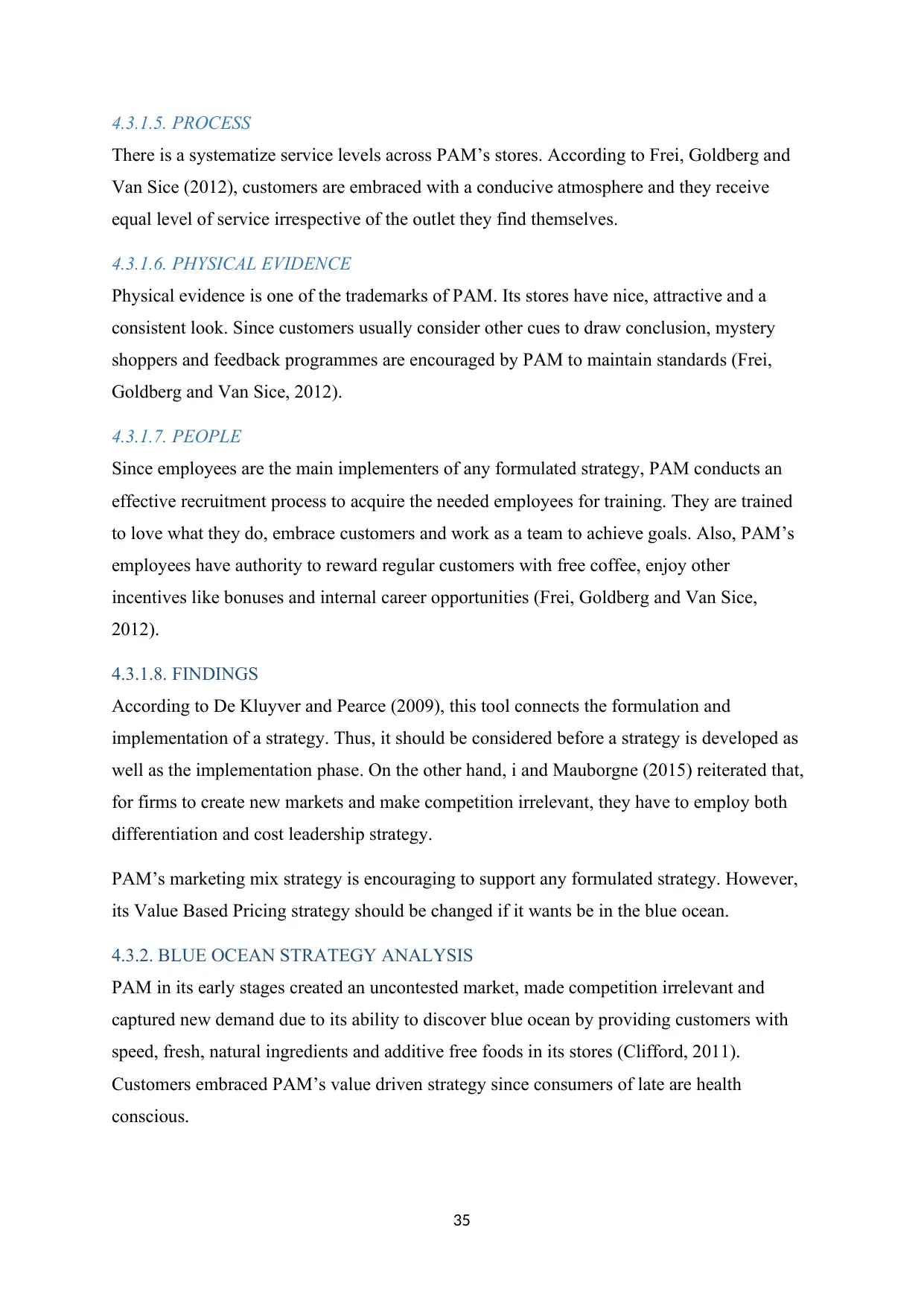
35
4.3.1.5. PROCESS
There is a systematize service levels across PAM’s stores. According to Frei, Goldberg and
Van Sice (2012), customers are embraced with a conducive atmosphere and they receive
equal level of service irrespective of the outlet they find themselves.
4.3.1.6. PHYSICAL EVIDENCE
Physical evidence is one of the trademarks of PAM. Its stores have nice, attractive and a
consistent look. Since customers usually consider other cues to draw conclusion, mystery
shoppers and feedback programmes are encouraged by PAM to maintain standards (Frei,
Goldberg and Van Sice, 2012).
4.3.1.7. PEOPLE
Since employees are the main implementers of any formulated strategy, PAM conducts an
effective recruitment process to acquire the needed employees for training. They are trained
to love what they do, embrace customers and work as a team to achieve goals. Also, PAM’s
employees have authority to reward regular customers with free coffee, enjoy other
incentives like bonuses and internal career opportunities (Frei, Goldberg and Van Sice,
2012).
4.3.1.8. FINDINGS
According to De Kluyver and Pearce (2009), this tool connects the formulation and
implementation of a strategy. Thus, it should be considered before a strategy is developed as
well as the implementation phase. On the other hand, i and Mauborgne (2015) reiterated that,
for firms to create new markets and make competition irrelevant, they have to employ both
differentiation and cost leadership strategy.
PAM’s marketing mix strategy is encouraging to support any formulated strategy. However,
its Value Based Pricing strategy should be changed if it wants be in the blue ocean.
4.3.2. BLUE OCEAN STRATEGY ANALYSIS
PAM in its early stages created an uncontested market, made competition irrelevant and
captured new demand due to its ability to discover blue ocean by providing customers with
speed, fresh, natural ingredients and additive free foods in its stores (Clifford, 2011).
Customers embraced PAM’s value driven strategy since consumers of late are health
conscious.
4.3.1.5. PROCESS
There is a systematize service levels across PAM’s stores. According to Frei, Goldberg and
Van Sice (2012), customers are embraced with a conducive atmosphere and they receive
equal level of service irrespective of the outlet they find themselves.
4.3.1.6. PHYSICAL EVIDENCE
Physical evidence is one of the trademarks of PAM. Its stores have nice, attractive and a
consistent look. Since customers usually consider other cues to draw conclusion, mystery
shoppers and feedback programmes are encouraged by PAM to maintain standards (Frei,
Goldberg and Van Sice, 2012).
4.3.1.7. PEOPLE
Since employees are the main implementers of any formulated strategy, PAM conducts an
effective recruitment process to acquire the needed employees for training. They are trained
to love what they do, embrace customers and work as a team to achieve goals. Also, PAM’s
employees have authority to reward regular customers with free coffee, enjoy other
incentives like bonuses and internal career opportunities (Frei, Goldberg and Van Sice,
2012).
4.3.1.8. FINDINGS
According to De Kluyver and Pearce (2009), this tool connects the formulation and
implementation of a strategy. Thus, it should be considered before a strategy is developed as
well as the implementation phase. On the other hand, i and Mauborgne (2015) reiterated that,
for firms to create new markets and make competition irrelevant, they have to employ both
differentiation and cost leadership strategy.
PAM’s marketing mix strategy is encouraging to support any formulated strategy. However,
its Value Based Pricing strategy should be changed if it wants be in the blue ocean.
4.3.2. BLUE OCEAN STRATEGY ANALYSIS
PAM in its early stages created an uncontested market, made competition irrelevant and
captured new demand due to its ability to discover blue ocean by providing customers with
speed, fresh, natural ingredients and additive free foods in its stores (Clifford, 2011).
Customers embraced PAM’s value driven strategy since consumers of late are health
conscious.
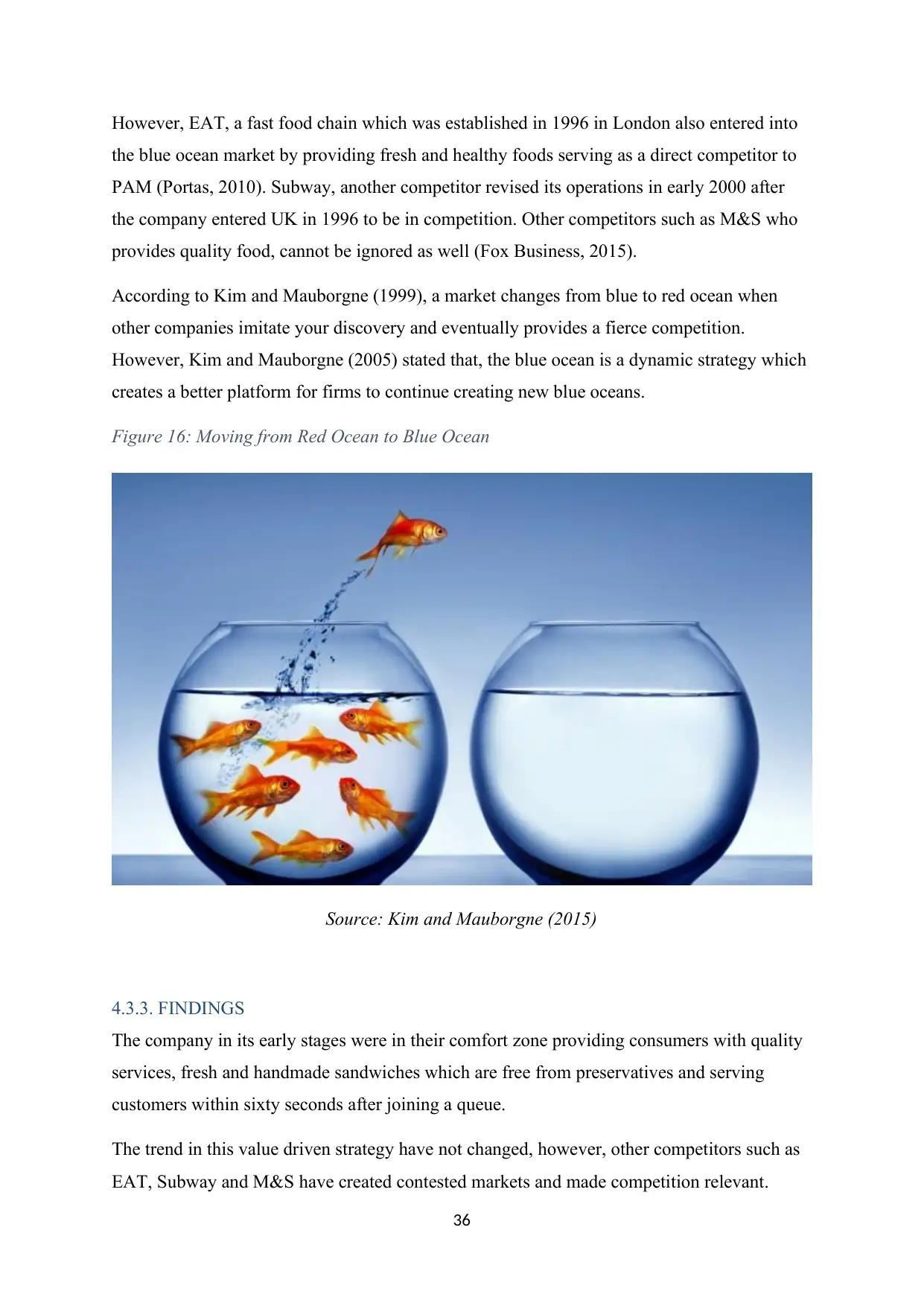
36
However, EAT, a fast food chain which was established in 1996 in London also entered into
the blue ocean market by providing fresh and healthy foods serving as a direct competitor to
PAM (Portas, 2010). Subway, another competitor revised its operations in early 2000 after
the company entered UK in 1996 to be in competition. Other competitors such as M&S who
provides quality food, cannot be ignored as well (Fox Business, 2015).
According to Kim and Mauborgne (1999), a market changes from blue to red ocean when
other companies imitate your discovery and eventually provides a fierce competition.
However, Kim and Mauborgne (2005) stated that, the blue ocean is a dynamic strategy which
creates a better platform for firms to continue creating new blue oceans.
Figure 16: Moving from Red Ocean to Blue Ocean
Source: Kim and Mauborgne (2015)
4.3.3. FINDINGS
The company in its early stages were in their comfort zone providing consumers with quality
services, fresh and handmade sandwiches which are free from preservatives and serving
customers within sixty seconds after joining a queue.
The trend in this value driven strategy have not changed, however, other competitors such as
EAT, Subway and M&S have created contested markets and made competition relevant.
However, EAT, a fast food chain which was established in 1996 in London also entered into
the blue ocean market by providing fresh and healthy foods serving as a direct competitor to
PAM (Portas, 2010). Subway, another competitor revised its operations in early 2000 after
the company entered UK in 1996 to be in competition. Other competitors such as M&S who
provides quality food, cannot be ignored as well (Fox Business, 2015).
According to Kim and Mauborgne (1999), a market changes from blue to red ocean when
other companies imitate your discovery and eventually provides a fierce competition.
However, Kim and Mauborgne (2005) stated that, the blue ocean is a dynamic strategy which
creates a better platform for firms to continue creating new blue oceans.
Figure 16: Moving from Red Ocean to Blue Ocean
Source: Kim and Mauborgne (2015)
4.3.3. FINDINGS
The company in its early stages were in their comfort zone providing consumers with quality
services, fresh and handmade sandwiches which are free from preservatives and serving
customers within sixty seconds after joining a queue.
The trend in this value driven strategy have not changed, however, other competitors such as
EAT, Subway and M&S have created contested markets and made competition relevant.
Paraphrase This Document
Need a fresh take? Get an instant paraphrase of this document with our AI Paraphraser
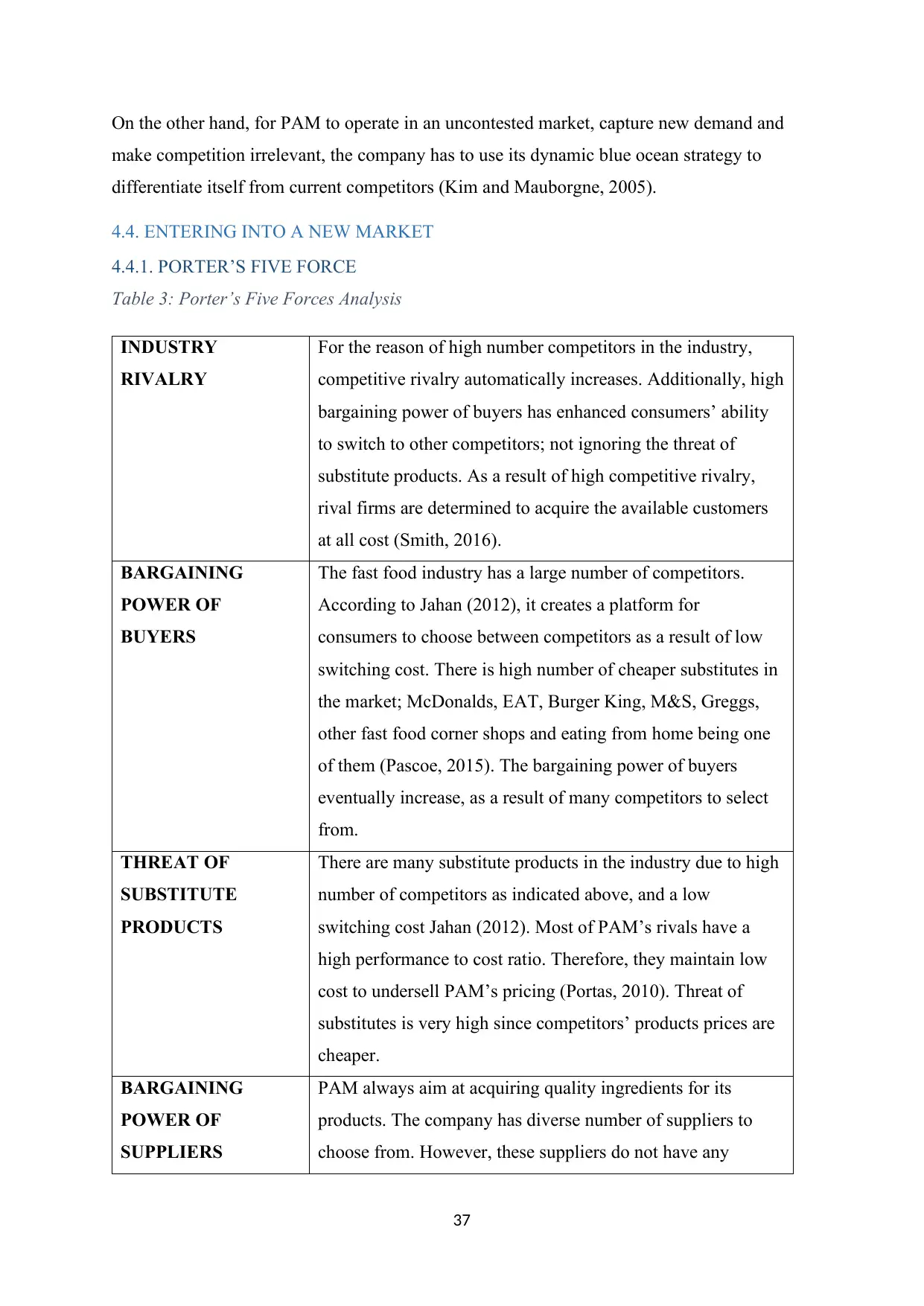
37
On the other hand, for PAM to operate in an uncontested market, capture new demand and
make competition irrelevant, the company has to use its dynamic blue ocean strategy to
differentiate itself from current competitors (Kim and Mauborgne, 2005).
4.4. ENTERING INTO A NEW MARKET
4.4.1. PORTER’S FIVE FORCE
Table 3: Porter’s Five Forces Analysis
INDUSTRY
RIVALRY
For the reason of high number competitors in the industry,
competitive rivalry automatically increases. Additionally, high
bargaining power of buyers has enhanced consumers’ ability
to switch to other competitors; not ignoring the threat of
substitute products. As a result of high competitive rivalry,
rival firms are determined to acquire the available customers
at all cost (Smith, 2016).
BARGAINING
POWER OF
BUYERS
The fast food industry has a large number of competitors.
According to Jahan (2012), it creates a platform for
consumers to choose between competitors as a result of low
switching cost. There is high number of cheaper substitutes in
the market; McDonalds, EAT, Burger King, M&S, Greggs,
other fast food corner shops and eating from home being one
of them (Pascoe, 2015). The bargaining power of buyers
eventually increase, as a result of many competitors to select
from.
THREAT OF
SUBSTITUTE
PRODUCTS
There are many substitute products in the industry due to high
number of competitors as indicated above, and a low
switching cost Jahan (2012). Most of PAM’s rivals have a
high performance to cost ratio. Therefore, they maintain low
cost to undersell PAM’s pricing (Portas, 2010). Threat of
substitutes is very high since competitors’ products prices are
cheaper.
BARGAINING
POWER OF
SUPPLIERS
PAM always aim at acquiring quality ingredients for its
products. The company has diverse number of suppliers to
choose from. However, these suppliers do not have any
On the other hand, for PAM to operate in an uncontested market, capture new demand and
make competition irrelevant, the company has to use its dynamic blue ocean strategy to
differentiate itself from current competitors (Kim and Mauborgne, 2005).
4.4. ENTERING INTO A NEW MARKET
4.4.1. PORTER’S FIVE FORCE
Table 3: Porter’s Five Forces Analysis
INDUSTRY
RIVALRY
For the reason of high number competitors in the industry,
competitive rivalry automatically increases. Additionally, high
bargaining power of buyers has enhanced consumers’ ability
to switch to other competitors; not ignoring the threat of
substitute products. As a result of high competitive rivalry,
rival firms are determined to acquire the available customers
at all cost (Smith, 2016).
BARGAINING
POWER OF
BUYERS
The fast food industry has a large number of competitors.
According to Jahan (2012), it creates a platform for
consumers to choose between competitors as a result of low
switching cost. There is high number of cheaper substitutes in
the market; McDonalds, EAT, Burger King, M&S, Greggs,
other fast food corner shops and eating from home being one
of them (Pascoe, 2015). The bargaining power of buyers
eventually increase, as a result of many competitors to select
from.
THREAT OF
SUBSTITUTE
PRODUCTS
There are many substitute products in the industry due to high
number of competitors as indicated above, and a low
switching cost Jahan (2012). Most of PAM’s rivals have a
high performance to cost ratio. Therefore, they maintain low
cost to undersell PAM’s pricing (Portas, 2010). Threat of
substitutes is very high since competitors’ products prices are
cheaper.
BARGAINING
POWER OF
SUPPLIERS
PAM always aim at acquiring quality ingredients for its
products. The company has diverse number of suppliers to
choose from. However, these suppliers do not have any
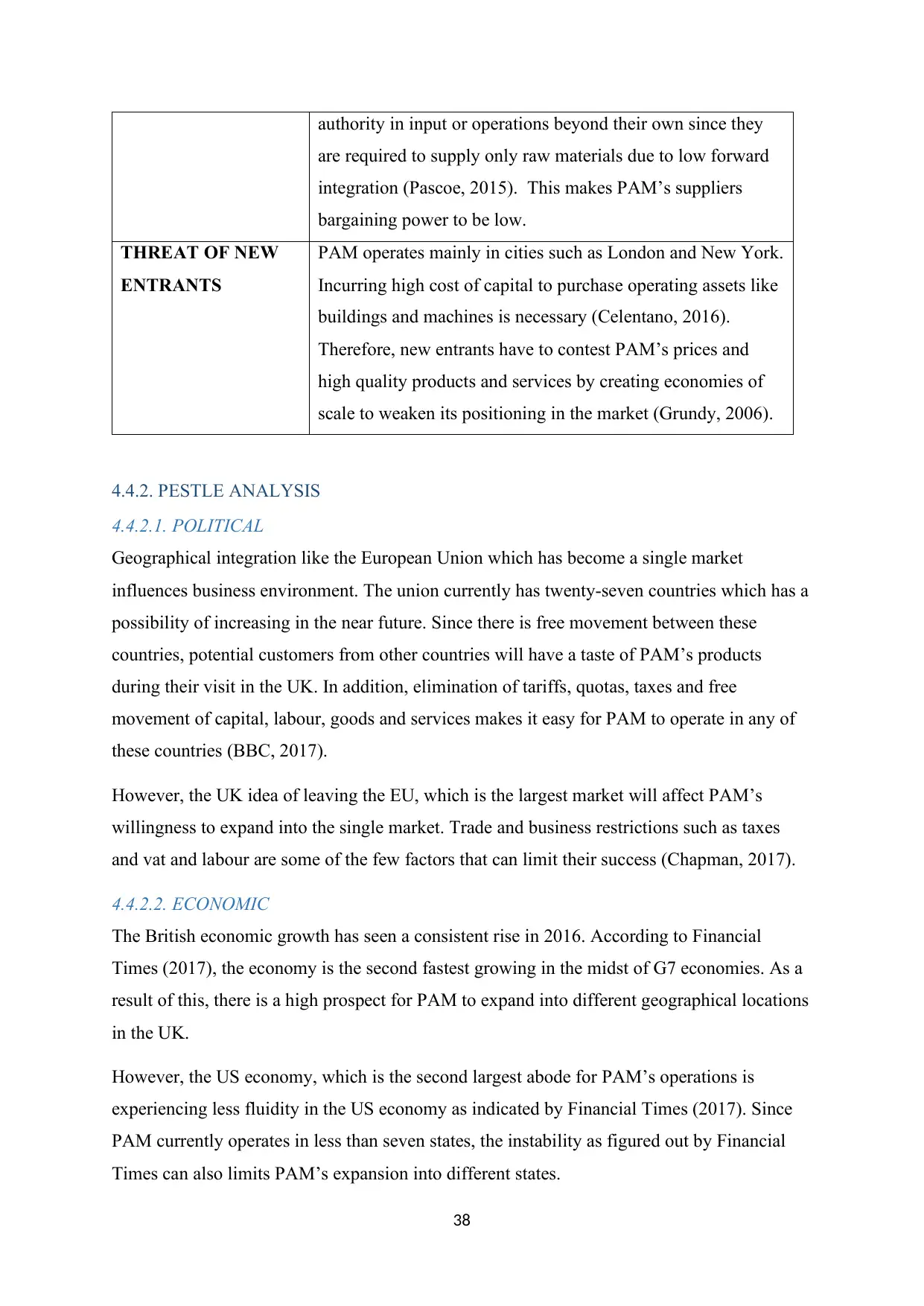
38
authority in input or operations beyond their own since they
are required to supply only raw materials due to low forward
integration (Pascoe, 2015). This makes PAM’s suppliers
bargaining power to be low.
THREAT OF NEW
ENTRANTS
PAM operates mainly in cities such as London and New York.
Incurring high cost of capital to purchase operating assets like
buildings and machines is necessary (Celentano, 2016).
Therefore, new entrants have to contest PAM’s prices and
high quality products and services by creating economies of
scale to weaken its positioning in the market (Grundy, 2006).
4.4.2. PESTLE ANALYSIS
4.4.2.1. POLITICAL
Geographical integration like the European Union which has become a single market
influences business environment. The union currently has twenty-seven countries which has a
possibility of increasing in the near future. Since there is free movement between these
countries, potential customers from other countries will have a taste of PAM’s products
during their visit in the UK. In addition, elimination of tariffs, quotas, taxes and free
movement of capital, labour, goods and services makes it easy for PAM to operate in any of
these countries (BBC, 2017).
However, the UK idea of leaving the EU, which is the largest market will affect PAM’s
willingness to expand into the single market. Trade and business restrictions such as taxes
and vat and labour are some of the few factors that can limit their success (Chapman, 2017).
4.4.2.2. ECONOMIC
The British economic growth has seen a consistent rise in 2016. According to Financial
Times (2017), the economy is the second fastest growing in the midst of G7 economies. As a
result of this, there is a high prospect for PAM to expand into different geographical locations
in the UK.
However, the US economy, which is the second largest abode for PAM’s operations is
experiencing less fluidity in the US economy as indicated by Financial Times (2017). Since
PAM currently operates in less than seven states, the instability as figured out by Financial
Times can also limits PAM’s expansion into different states.
authority in input or operations beyond their own since they
are required to supply only raw materials due to low forward
integration (Pascoe, 2015). This makes PAM’s suppliers
bargaining power to be low.
THREAT OF NEW
ENTRANTS
PAM operates mainly in cities such as London and New York.
Incurring high cost of capital to purchase operating assets like
buildings and machines is necessary (Celentano, 2016).
Therefore, new entrants have to contest PAM’s prices and
high quality products and services by creating economies of
scale to weaken its positioning in the market (Grundy, 2006).
4.4.2. PESTLE ANALYSIS
4.4.2.1. POLITICAL
Geographical integration like the European Union which has become a single market
influences business environment. The union currently has twenty-seven countries which has a
possibility of increasing in the near future. Since there is free movement between these
countries, potential customers from other countries will have a taste of PAM’s products
during their visit in the UK. In addition, elimination of tariffs, quotas, taxes and free
movement of capital, labour, goods and services makes it easy for PAM to operate in any of
these countries (BBC, 2017).
However, the UK idea of leaving the EU, which is the largest market will affect PAM’s
willingness to expand into the single market. Trade and business restrictions such as taxes
and vat and labour are some of the few factors that can limit their success (Chapman, 2017).
4.4.2.2. ECONOMIC
The British economic growth has seen a consistent rise in 2016. According to Financial
Times (2017), the economy is the second fastest growing in the midst of G7 economies. As a
result of this, there is a high prospect for PAM to expand into different geographical locations
in the UK.
However, the US economy, which is the second largest abode for PAM’s operations is
experiencing less fluidity in the US economy as indicated by Financial Times (2017). Since
PAM currently operates in less than seven states, the instability as figured out by Financial
Times can also limits PAM’s expansion into different states.
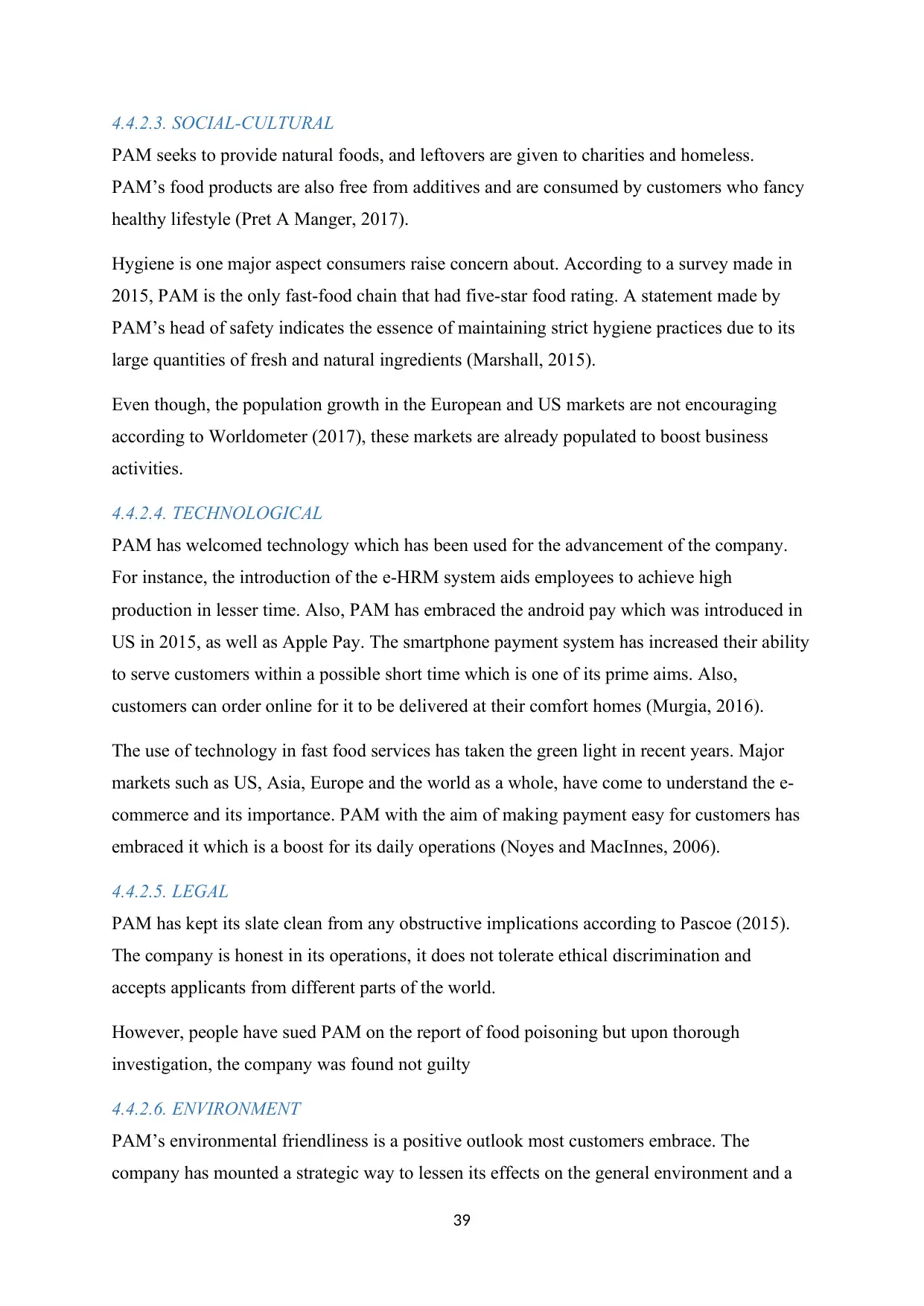
39
4.4.2.3. SOCIAL-CULTURAL
PAM seeks to provide natural foods, and leftovers are given to charities and homeless.
PAM’s food products are also free from additives and are consumed by customers who fancy
healthy lifestyle (Pret A Manger, 2017).
Hygiene is one major aspect consumers raise concern about. According to a survey made in
2015, PAM is the only fast-food chain that had five-star food rating. A statement made by
PAM’s head of safety indicates the essence of maintaining strict hygiene practices due to its
large quantities of fresh and natural ingredients (Marshall, 2015).
Even though, the population growth in the European and US markets are not encouraging
according to Worldometer (2017), these markets are already populated to boost business
activities.
4.4.2.4. TECHNOLOGICAL
PAM has welcomed technology which has been used for the advancement of the company.
For instance, the introduction of the e-HRM system aids employees to achieve high
production in lesser time. Also, PAM has embraced the android pay which was introduced in
US in 2015, as well as Apple Pay. The smartphone payment system has increased their ability
to serve customers within a possible short time which is one of its prime aims. Also,
customers can order online for it to be delivered at their comfort homes (Murgia, 2016).
The use of technology in fast food services has taken the green light in recent years. Major
markets such as US, Asia, Europe and the world as a whole, have come to understand the e-
commerce and its importance. PAM with the aim of making payment easy for customers has
embraced it which is a boost for its daily operations (Noyes and MacInnes, 2006).
4.4.2.5. LEGAL
PAM has kept its slate clean from any obstructive implications according to Pascoe (2015).
The company is honest in its operations, it does not tolerate ethical discrimination and
accepts applicants from different parts of the world.
However, people have sued PAM on the report of food poisoning but upon thorough
investigation, the company was found not guilty
4.4.2.6. ENVIRONMENT
PAM’s environmental friendliness is a positive outlook most customers embrace. The
company has mounted a strategic way to lessen its effects on the general environment and a
4.4.2.3. SOCIAL-CULTURAL
PAM seeks to provide natural foods, and leftovers are given to charities and homeless.
PAM’s food products are also free from additives and are consumed by customers who fancy
healthy lifestyle (Pret A Manger, 2017).
Hygiene is one major aspect consumers raise concern about. According to a survey made in
2015, PAM is the only fast-food chain that had five-star food rating. A statement made by
PAM’s head of safety indicates the essence of maintaining strict hygiene practices due to its
large quantities of fresh and natural ingredients (Marshall, 2015).
Even though, the population growth in the European and US markets are not encouraging
according to Worldometer (2017), these markets are already populated to boost business
activities.
4.4.2.4. TECHNOLOGICAL
PAM has welcomed technology which has been used for the advancement of the company.
For instance, the introduction of the e-HRM system aids employees to achieve high
production in lesser time. Also, PAM has embraced the android pay which was introduced in
US in 2015, as well as Apple Pay. The smartphone payment system has increased their ability
to serve customers within a possible short time which is one of its prime aims. Also,
customers can order online for it to be delivered at their comfort homes (Murgia, 2016).
The use of technology in fast food services has taken the green light in recent years. Major
markets such as US, Asia, Europe and the world as a whole, have come to understand the e-
commerce and its importance. PAM with the aim of making payment easy for customers has
embraced it which is a boost for its daily operations (Noyes and MacInnes, 2006).
4.4.2.5. LEGAL
PAM has kept its slate clean from any obstructive implications according to Pascoe (2015).
The company is honest in its operations, it does not tolerate ethical discrimination and
accepts applicants from different parts of the world.
However, people have sued PAM on the report of food poisoning but upon thorough
investigation, the company was found not guilty
4.4.2.6. ENVIRONMENT
PAM’s environmental friendliness is a positive outlook most customers embrace. The
company has mounted a strategic way to lessen its effects on the general environment and a
Secure Best Marks with AI Grader
Need help grading? Try our AI Grader for instant feedback on your assignments.
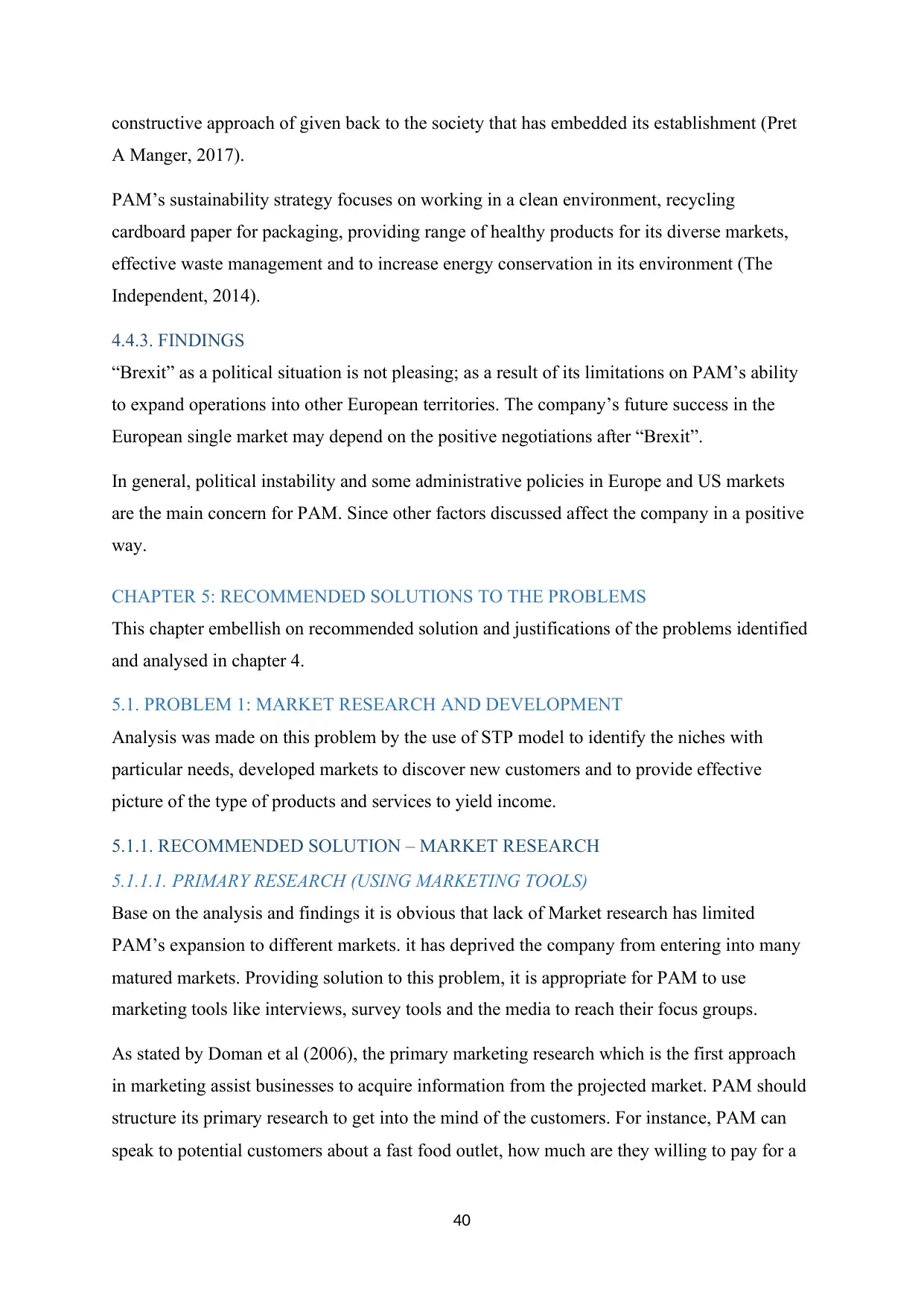
40
constructive approach of given back to the society that has embedded its establishment (Pret
A Manger, 2017).
PAM’s sustainability strategy focuses on working in a clean environment, recycling
cardboard paper for packaging, providing range of healthy products for its diverse markets,
effective waste management and to increase energy conservation in its environment (The
Independent, 2014).
4.4.3. FINDINGS
“Brexit” as a political situation is not pleasing; as a result of its limitations on PAM’s ability
to expand operations into other European territories. The company’s future success in the
European single market may depend on the positive negotiations after “Brexit”.
In general, political instability and some administrative policies in Europe and US markets
are the main concern for PAM. Since other factors discussed affect the company in a positive
way.
CHAPTER 5: RECOMMENDED SOLUTIONS TO THE PROBLEMS
This chapter embellish on recommended solution and justifications of the problems identified
and analysed in chapter 4.
5.1. PROBLEM 1: MARKET RESEARCH AND DEVELOPMENT
Analysis was made on this problem by the use of STP model to identify the niches with
particular needs, developed markets to discover new customers and to provide effective
picture of the type of products and services to yield income.
5.1.1. RECOMMENDED SOLUTION – MARKET RESEARCH
5.1.1.1. PRIMARY RESEARCH (USING MARKETING TOOLS)
Base on the analysis and findings it is obvious that lack of Market research has limited
PAM’s expansion to different markets. it has deprived the company from entering into many
matured markets. Providing solution to this problem, it is appropriate for PAM to use
marketing tools like interviews, survey tools and the media to reach their focus groups.
As stated by Doman et al (2006), the primary marketing research which is the first approach
in marketing assist businesses to acquire information from the projected market. PAM should
structure its primary research to get into the mind of the customers. For instance, PAM can
speak to potential customers about a fast food outlet, how much are they willing to pay for a
constructive approach of given back to the society that has embedded its establishment (Pret
A Manger, 2017).
PAM’s sustainability strategy focuses on working in a clean environment, recycling
cardboard paper for packaging, providing range of healthy products for its diverse markets,
effective waste management and to increase energy conservation in its environment (The
Independent, 2014).
4.4.3. FINDINGS
“Brexit” as a political situation is not pleasing; as a result of its limitations on PAM’s ability
to expand operations into other European territories. The company’s future success in the
European single market may depend on the positive negotiations after “Brexit”.
In general, political instability and some administrative policies in Europe and US markets
are the main concern for PAM. Since other factors discussed affect the company in a positive
way.
CHAPTER 5: RECOMMENDED SOLUTIONS TO THE PROBLEMS
This chapter embellish on recommended solution and justifications of the problems identified
and analysed in chapter 4.
5.1. PROBLEM 1: MARKET RESEARCH AND DEVELOPMENT
Analysis was made on this problem by the use of STP model to identify the niches with
particular needs, developed markets to discover new customers and to provide effective
picture of the type of products and services to yield income.
5.1.1. RECOMMENDED SOLUTION – MARKET RESEARCH
5.1.1.1. PRIMARY RESEARCH (USING MARKETING TOOLS)
Base on the analysis and findings it is obvious that lack of Market research has limited
PAM’s expansion to different markets. it has deprived the company from entering into many
matured markets. Providing solution to this problem, it is appropriate for PAM to use
marketing tools like interviews, survey tools and the media to reach their focus groups.
As stated by Doman et al (2006), the primary marketing research which is the first approach
in marketing assist businesses to acquire information from the projected market. PAM should
structure its primary research to get into the mind of the customers. For instance, PAM can
speak to potential customers about a fast food outlet, how much are they willing to pay for a
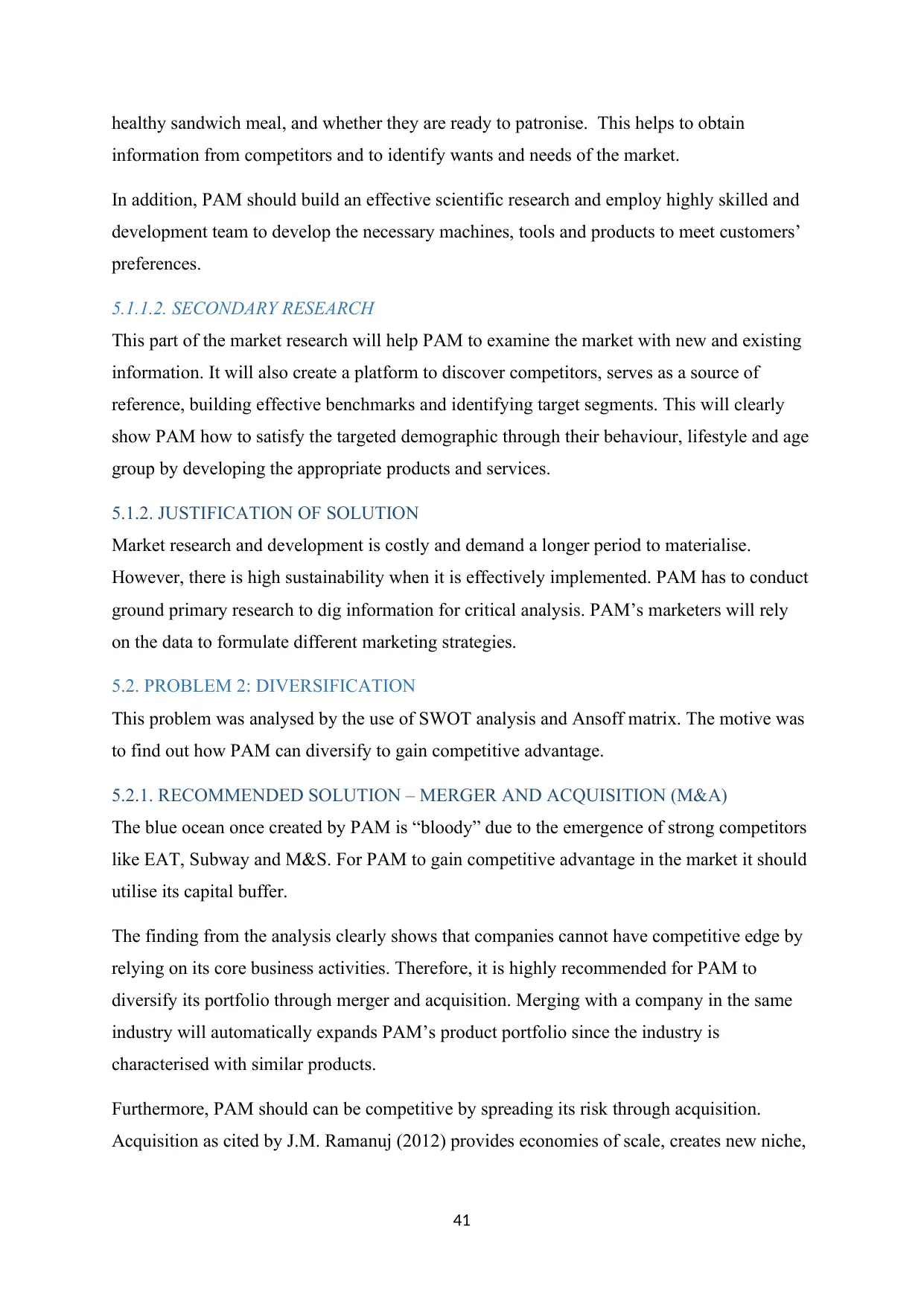
41
healthy sandwich meal, and whether they are ready to patronise. This helps to obtain
information from competitors and to identify wants and needs of the market.
In addition, PAM should build an effective scientific research and employ highly skilled and
development team to develop the necessary machines, tools and products to meet customers’
preferences.
5.1.1.2. SECONDARY RESEARCH
This part of the market research will help PAM to examine the market with new and existing
information. It will also create a platform to discover competitors, serves as a source of
reference, building effective benchmarks and identifying target segments. This will clearly
show PAM how to satisfy the targeted demographic through their behaviour, lifestyle and age
group by developing the appropriate products and services.
5.1.2. JUSTIFICATION OF SOLUTION
Market research and development is costly and demand a longer period to materialise.
However, there is high sustainability when it is effectively implemented. PAM has to conduct
ground primary research to dig information for critical analysis. PAM’s marketers will rely
on the data to formulate different marketing strategies.
5.2. PROBLEM 2: DIVERSIFICATION
This problem was analysed by the use of SWOT analysis and Ansoff matrix. The motive was
to find out how PAM can diversify to gain competitive advantage.
5.2.1. RECOMMENDED SOLUTION – MERGER AND ACQUISITION (M&A)
The blue ocean once created by PAM is “bloody” due to the emergence of strong competitors
like EAT, Subway and M&S. For PAM to gain competitive advantage in the market it should
utilise its capital buffer.
The finding from the analysis clearly shows that companies cannot have competitive edge by
relying on its core business activities. Therefore, it is highly recommended for PAM to
diversify its portfolio through merger and acquisition. Merging with a company in the same
industry will automatically expands PAM’s product portfolio since the industry is
characterised with similar products.
Furthermore, PAM should can be competitive by spreading its risk through acquisition.
Acquisition as cited by J.M. Ramanuj (2012) provides economies of scale, creates new niche,
healthy sandwich meal, and whether they are ready to patronise. This helps to obtain
information from competitors and to identify wants and needs of the market.
In addition, PAM should build an effective scientific research and employ highly skilled and
development team to develop the necessary machines, tools and products to meet customers’
preferences.
5.1.1.2. SECONDARY RESEARCH
This part of the market research will help PAM to examine the market with new and existing
information. It will also create a platform to discover competitors, serves as a source of
reference, building effective benchmarks and identifying target segments. This will clearly
show PAM how to satisfy the targeted demographic through their behaviour, lifestyle and age
group by developing the appropriate products and services.
5.1.2. JUSTIFICATION OF SOLUTION
Market research and development is costly and demand a longer period to materialise.
However, there is high sustainability when it is effectively implemented. PAM has to conduct
ground primary research to dig information for critical analysis. PAM’s marketers will rely
on the data to formulate different marketing strategies.
5.2. PROBLEM 2: DIVERSIFICATION
This problem was analysed by the use of SWOT analysis and Ansoff matrix. The motive was
to find out how PAM can diversify to gain competitive advantage.
5.2.1. RECOMMENDED SOLUTION – MERGER AND ACQUISITION (M&A)
The blue ocean once created by PAM is “bloody” due to the emergence of strong competitors
like EAT, Subway and M&S. For PAM to gain competitive advantage in the market it should
utilise its capital buffer.
The finding from the analysis clearly shows that companies cannot have competitive edge by
relying on its core business activities. Therefore, it is highly recommended for PAM to
diversify its portfolio through merger and acquisition. Merging with a company in the same
industry will automatically expands PAM’s product portfolio since the industry is
characterised with similar products.
Furthermore, PAM should can be competitive by spreading its risk through acquisition.
Acquisition as cited by J.M. Ramanuj (2012) provides economies of scale, creates new niche,
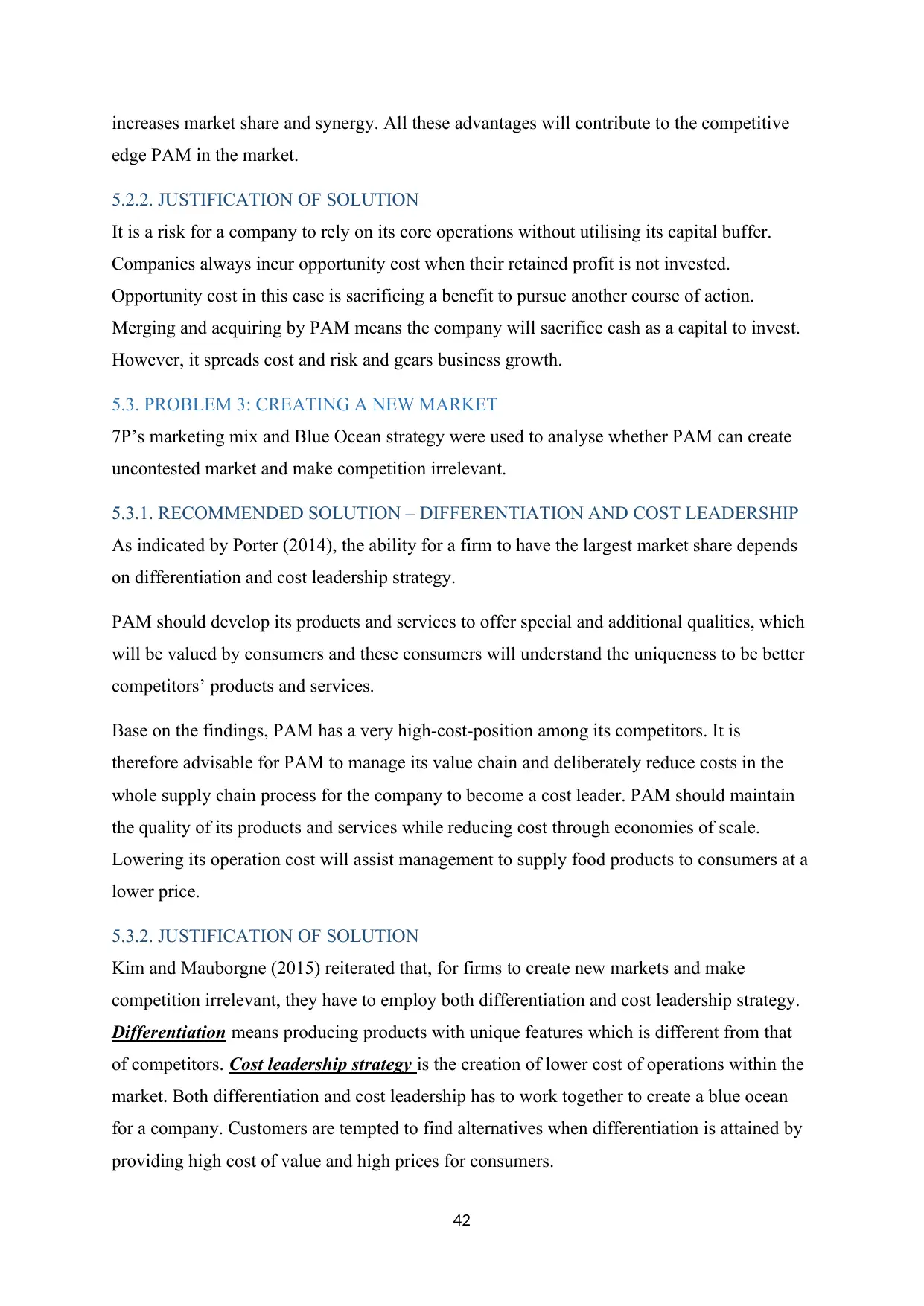
42
increases market share and synergy. All these advantages will contribute to the competitive
edge PAM in the market.
5.2.2. JUSTIFICATION OF SOLUTION
It is a risk for a company to rely on its core operations without utilising its capital buffer.
Companies always incur opportunity cost when their retained profit is not invested.
Opportunity cost in this case is sacrificing a benefit to pursue another course of action.
Merging and acquiring by PAM means the company will sacrifice cash as a capital to invest.
However, it spreads cost and risk and gears business growth.
5.3. PROBLEM 3: CREATING A NEW MARKET
7P’s marketing mix and Blue Ocean strategy were used to analyse whether PAM can create
uncontested market and make competition irrelevant.
5.3.1. RECOMMENDED SOLUTION – DIFFERENTIATION AND COST LEADERSHIP
As indicated by Porter (2014), the ability for a firm to have the largest market share depends
on differentiation and cost leadership strategy.
PAM should develop its products and services to offer special and additional qualities, which
will be valued by consumers and these consumers will understand the uniqueness to be better
competitors’ products and services.
Base on the findings, PAM has a very high-cost-position among its competitors. It is
therefore advisable for PAM to manage its value chain and deliberately reduce costs in the
whole supply chain process for the company to become a cost leader. PAM should maintain
the quality of its products and services while reducing cost through economies of scale.
Lowering its operation cost will assist management to supply food products to consumers at a
lower price.
5.3.2. JUSTIFICATION OF SOLUTION
Kim and Mauborgne (2015) reiterated that, for firms to create new markets and make
competition irrelevant, they have to employ both differentiation and cost leadership strategy.
Differentiation means producing products with unique features which is different from that
of competitors. Cost leadership strategy is the creation of lower cost of operations within the
market. Both differentiation and cost leadership has to work together to create a blue ocean
for a company. Customers are tempted to find alternatives when differentiation is attained by
providing high cost of value and high prices for consumers.
increases market share and synergy. All these advantages will contribute to the competitive
edge PAM in the market.
5.2.2. JUSTIFICATION OF SOLUTION
It is a risk for a company to rely on its core operations without utilising its capital buffer.
Companies always incur opportunity cost when their retained profit is not invested.
Opportunity cost in this case is sacrificing a benefit to pursue another course of action.
Merging and acquiring by PAM means the company will sacrifice cash as a capital to invest.
However, it spreads cost and risk and gears business growth.
5.3. PROBLEM 3: CREATING A NEW MARKET
7P’s marketing mix and Blue Ocean strategy were used to analyse whether PAM can create
uncontested market and make competition irrelevant.
5.3.1. RECOMMENDED SOLUTION – DIFFERENTIATION AND COST LEADERSHIP
As indicated by Porter (2014), the ability for a firm to have the largest market share depends
on differentiation and cost leadership strategy.
PAM should develop its products and services to offer special and additional qualities, which
will be valued by consumers and these consumers will understand the uniqueness to be better
competitors’ products and services.
Base on the findings, PAM has a very high-cost-position among its competitors. It is
therefore advisable for PAM to manage its value chain and deliberately reduce costs in the
whole supply chain process for the company to become a cost leader. PAM should maintain
the quality of its products and services while reducing cost through economies of scale.
Lowering its operation cost will assist management to supply food products to consumers at a
lower price.
5.3.2. JUSTIFICATION OF SOLUTION
Kim and Mauborgne (2015) reiterated that, for firms to create new markets and make
competition irrelevant, they have to employ both differentiation and cost leadership strategy.
Differentiation means producing products with unique features which is different from that
of competitors. Cost leadership strategy is the creation of lower cost of operations within the
market. Both differentiation and cost leadership has to work together to create a blue ocean
for a company. Customers are tempted to find alternatives when differentiation is attained by
providing high cost of value and high prices for consumers.
Paraphrase This Document
Need a fresh take? Get an instant paraphrase of this document with our AI Paraphraser
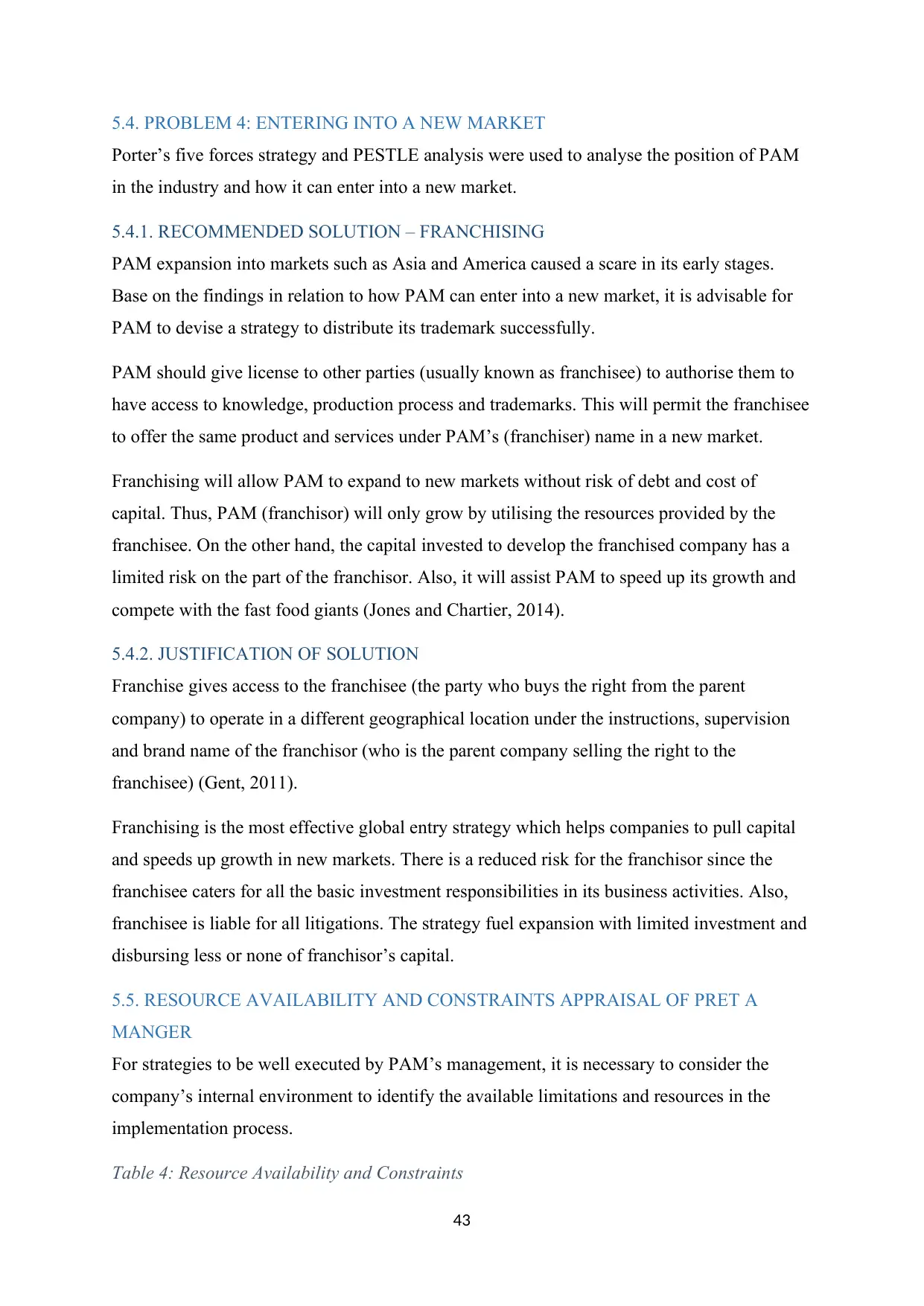
43
5.4. PROBLEM 4: ENTERING INTO A NEW MARKET
Porter’s five forces strategy and PESTLE analysis were used to analyse the position of PAM
in the industry and how it can enter into a new market.
5.4.1. RECOMMENDED SOLUTION – FRANCHISING
PAM expansion into markets such as Asia and America caused a scare in its early stages.
Base on the findings in relation to how PAM can enter into a new market, it is advisable for
PAM to devise a strategy to distribute its trademark successfully.
PAM should give license to other parties (usually known as franchisee) to authorise them to
have access to knowledge, production process and trademarks. This will permit the franchisee
to offer the same product and services under PAM’s (franchiser) name in a new market.
Franchising will allow PAM to expand to new markets without risk of debt and cost of
capital. Thus, PAM (franchisor) will only grow by utilising the resources provided by the
franchisee. On the other hand, the capital invested to develop the franchised company has a
limited risk on the part of the franchisor. Also, it will assist PAM to speed up its growth and
compete with the fast food giants (Jones and Chartier, 2014).
5.4.2. JUSTIFICATION OF SOLUTION
Franchise gives access to the franchisee (the party who buys the right from the parent
company) to operate in a different geographical location under the instructions, supervision
and brand name of the franchisor (who is the parent company selling the right to the
franchisee) (Gent, 2011).
Franchising is the most effective global entry strategy which helps companies to pull capital
and speeds up growth in new markets. There is a reduced risk for the franchisor since the
franchisee caters for all the basic investment responsibilities in its business activities. Also,
franchisee is liable for all litigations. The strategy fuel expansion with limited investment and
disbursing less or none of franchisor’s capital.
5.5. RESOURCE AVAILABILITY AND CONSTRAINTS APPRAISAL OF PRET A
MANGER
For strategies to be well executed by PAM’s management, it is necessary to consider the
company’s internal environment to identify the available limitations and resources in the
implementation process.
Table 4: Resource Availability and Constraints
5.4. PROBLEM 4: ENTERING INTO A NEW MARKET
Porter’s five forces strategy and PESTLE analysis were used to analyse the position of PAM
in the industry and how it can enter into a new market.
5.4.1. RECOMMENDED SOLUTION – FRANCHISING
PAM expansion into markets such as Asia and America caused a scare in its early stages.
Base on the findings in relation to how PAM can enter into a new market, it is advisable for
PAM to devise a strategy to distribute its trademark successfully.
PAM should give license to other parties (usually known as franchisee) to authorise them to
have access to knowledge, production process and trademarks. This will permit the franchisee
to offer the same product and services under PAM’s (franchiser) name in a new market.
Franchising will allow PAM to expand to new markets without risk of debt and cost of
capital. Thus, PAM (franchisor) will only grow by utilising the resources provided by the
franchisee. On the other hand, the capital invested to develop the franchised company has a
limited risk on the part of the franchisor. Also, it will assist PAM to speed up its growth and
compete with the fast food giants (Jones and Chartier, 2014).
5.4.2. JUSTIFICATION OF SOLUTION
Franchise gives access to the franchisee (the party who buys the right from the parent
company) to operate in a different geographical location under the instructions, supervision
and brand name of the franchisor (who is the parent company selling the right to the
franchisee) (Gent, 2011).
Franchising is the most effective global entry strategy which helps companies to pull capital
and speeds up growth in new markets. There is a reduced risk for the franchisor since the
franchisee caters for all the basic investment responsibilities in its business activities. Also,
franchisee is liable for all litigations. The strategy fuel expansion with limited investment and
disbursing less or none of franchisor’s capital.
5.5. RESOURCE AVAILABILITY AND CONSTRAINTS APPRAISAL OF PRET A
MANGER
For strategies to be well executed by PAM’s management, it is necessary to consider the
company’s internal environment to identify the available limitations and resources in the
implementation process.
Table 4: Resource Availability and Constraints
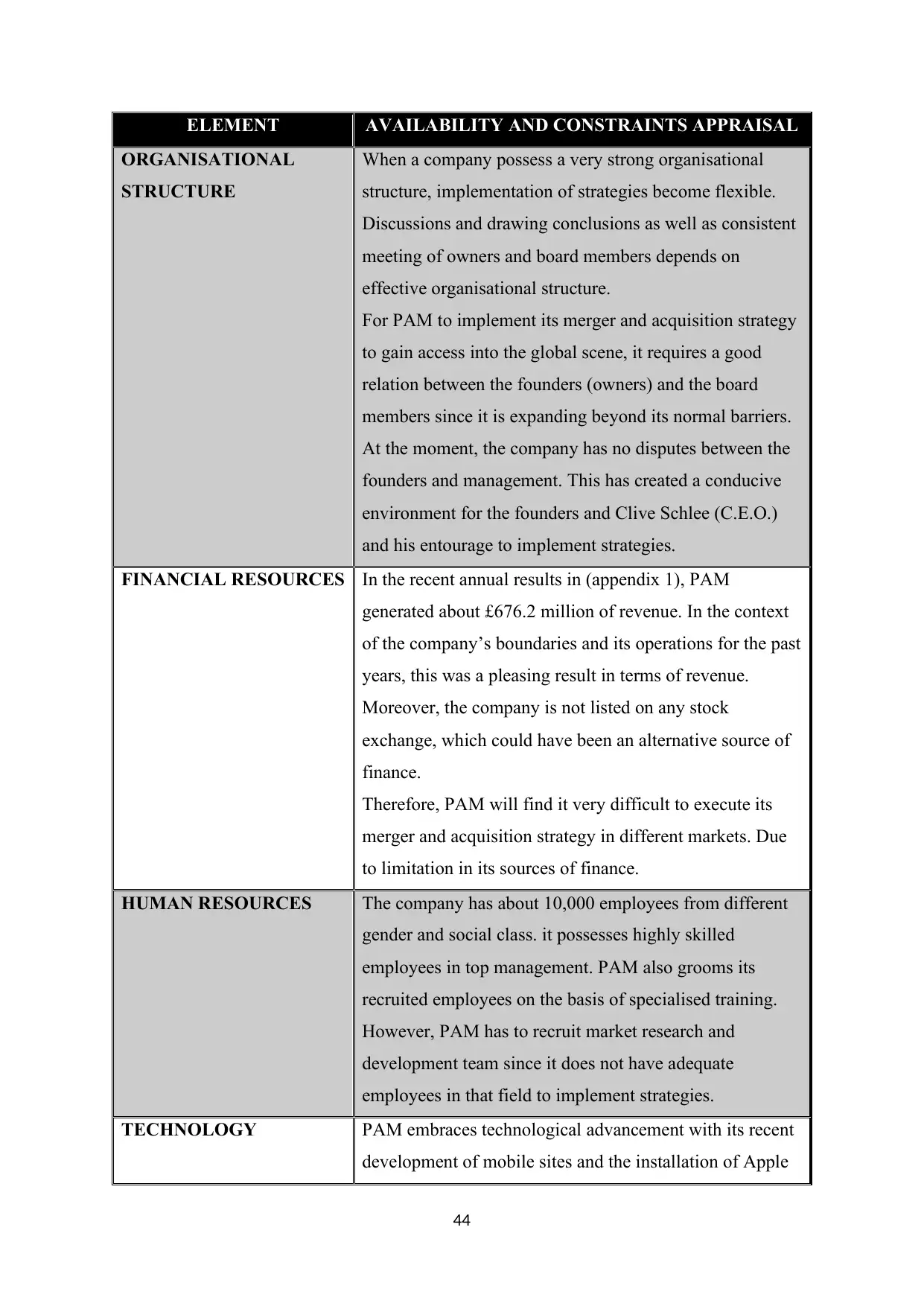
44
ELEMENT AVAILABILITY AND CONSTRAINTS APPRAISAL
ORGANISATIONAL
STRUCTURE
When a company possess a very strong organisational
structure, implementation of strategies become flexible.
Discussions and drawing conclusions as well as consistent
meeting of owners and board members depends on
effective organisational structure.
For PAM to implement its merger and acquisition strategy
to gain access into the global scene, it requires a good
relation between the founders (owners) and the board
members since it is expanding beyond its normal barriers.
At the moment, the company has no disputes between the
founders and management. This has created a conducive
environment for the founders and Clive Schlee (C.E.O.)
and his entourage to implement strategies.
FINANCIAL RESOURCES In the recent annual results in (appendix 1), PAM
generated about £676.2 million of revenue. In the context
of the company’s boundaries and its operations for the past
years, this was a pleasing result in terms of revenue.
Moreover, the company is not listed on any stock
exchange, which could have been an alternative source of
finance.
Therefore, PAM will find it very difficult to execute its
merger and acquisition strategy in different markets. Due
to limitation in its sources of finance.
HUMAN RESOURCES The company has about 10,000 employees from different
gender and social class. it possesses highly skilled
employees in top management. PAM also grooms its
recruited employees on the basis of specialised training.
However, PAM has to recruit market research and
development team since it does not have adequate
employees in that field to implement strategies.
TECHNOLOGY PAM embraces technological advancement with its recent
development of mobile sites and the installation of Apple
ELEMENT AVAILABILITY AND CONSTRAINTS APPRAISAL
ORGANISATIONAL
STRUCTURE
When a company possess a very strong organisational
structure, implementation of strategies become flexible.
Discussions and drawing conclusions as well as consistent
meeting of owners and board members depends on
effective organisational structure.
For PAM to implement its merger and acquisition strategy
to gain access into the global scene, it requires a good
relation between the founders (owners) and the board
members since it is expanding beyond its normal barriers.
At the moment, the company has no disputes between the
founders and management. This has created a conducive
environment for the founders and Clive Schlee (C.E.O.)
and his entourage to implement strategies.
FINANCIAL RESOURCES In the recent annual results in (appendix 1), PAM
generated about £676.2 million of revenue. In the context
of the company’s boundaries and its operations for the past
years, this was a pleasing result in terms of revenue.
Moreover, the company is not listed on any stock
exchange, which could have been an alternative source of
finance.
Therefore, PAM will find it very difficult to execute its
merger and acquisition strategy in different markets. Due
to limitation in its sources of finance.
HUMAN RESOURCES The company has about 10,000 employees from different
gender and social class. it possesses highly skilled
employees in top management. PAM also grooms its
recruited employees on the basis of specialised training.
However, PAM has to recruit market research and
development team since it does not have adequate
employees in that field to implement strategies.
TECHNOLOGY PAM embraces technological advancement with its recent
development of mobile sites and the installation of Apple
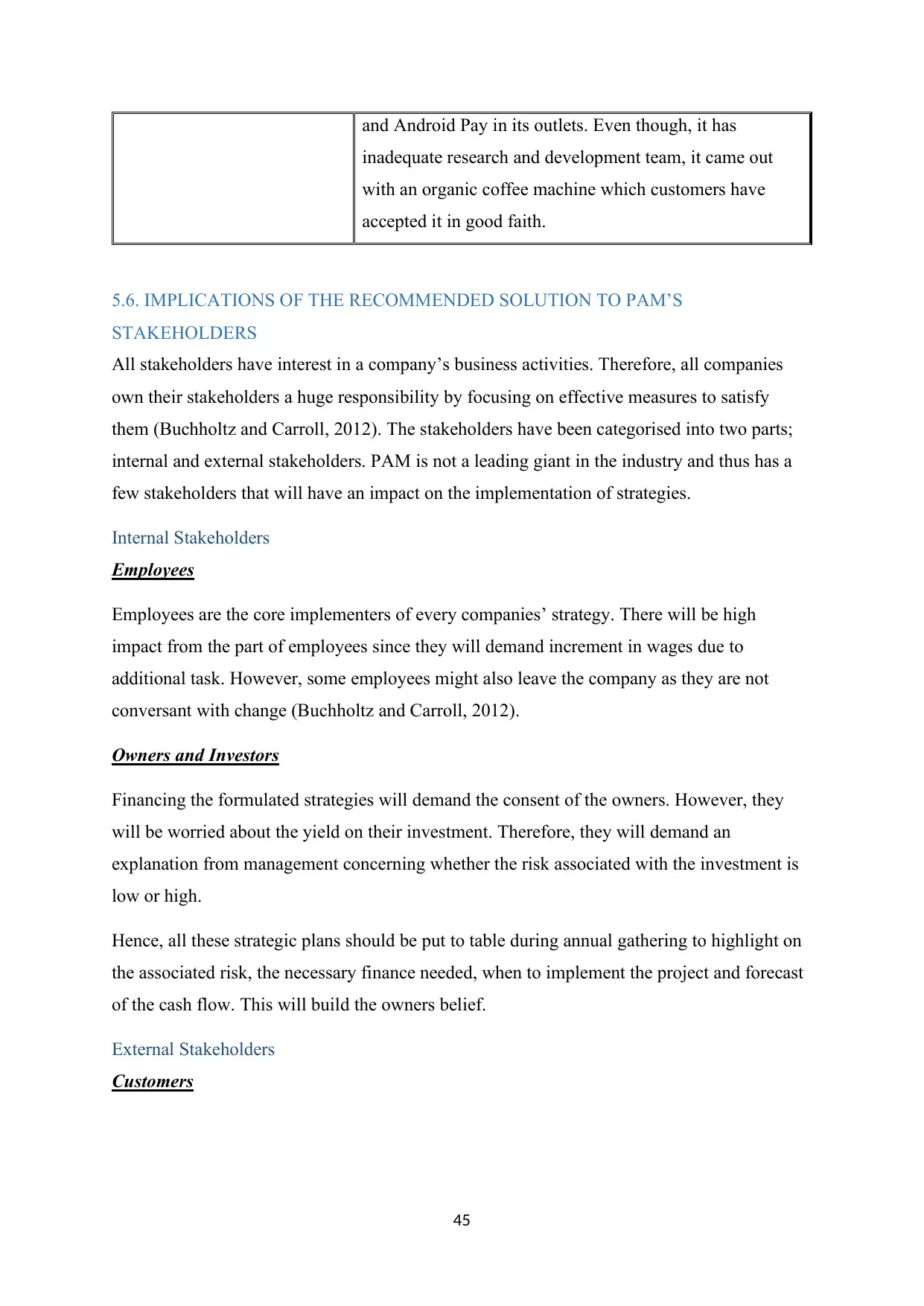
45
and Android Pay in its outlets. Even though, it has
inadequate research and development team, it came out
with an organic coffee machine which customers have
accepted it in good faith.
5.6. IMPLICATIONS OF THE RECOMMENDED SOLUTION TO PAM’S
STAKEHOLDERS
All stakeholders have interest in a company’s business activities. Therefore, all companies
own their stakeholders a huge responsibility by focusing on effective measures to satisfy
them (Buchholtz and Carroll, 2012). The stakeholders have been categorised into two parts;
internal and external stakeholders. PAM is not a leading giant in the industry and thus has a
few stakeholders that will have an impact on the implementation of strategies.
Internal Stakeholders
Employees
Employees are the core implementers of every companies’ strategy. There will be high
impact from the part of employees since they will demand increment in wages due to
additional task. However, some employees might also leave the company as they are not
conversant with change (Buchholtz and Carroll, 2012).
Owners and Investors
Financing the formulated strategies will demand the consent of the owners. However, they
will be worried about the yield on their investment. Therefore, they will demand an
explanation from management concerning whether the risk associated with the investment is
low or high.
Hence, all these strategic plans should be put to table during annual gathering to highlight on
the associated risk, the necessary finance needed, when to implement the project and forecast
of the cash flow. This will build the owners belief.
External Stakeholders
Customers
and Android Pay in its outlets. Even though, it has
inadequate research and development team, it came out
with an organic coffee machine which customers have
accepted it in good faith.
5.6. IMPLICATIONS OF THE RECOMMENDED SOLUTION TO PAM’S
STAKEHOLDERS
All stakeholders have interest in a company’s business activities. Therefore, all companies
own their stakeholders a huge responsibility by focusing on effective measures to satisfy
them (Buchholtz and Carroll, 2012). The stakeholders have been categorised into two parts;
internal and external stakeholders. PAM is not a leading giant in the industry and thus has a
few stakeholders that will have an impact on the implementation of strategies.
Internal Stakeholders
Employees
Employees are the core implementers of every companies’ strategy. There will be high
impact from the part of employees since they will demand increment in wages due to
additional task. However, some employees might also leave the company as they are not
conversant with change (Buchholtz and Carroll, 2012).
Owners and Investors
Financing the formulated strategies will demand the consent of the owners. However, they
will be worried about the yield on their investment. Therefore, they will demand an
explanation from management concerning whether the risk associated with the investment is
low or high.
Hence, all these strategic plans should be put to table during annual gathering to highlight on
the associated risk, the necessary finance needed, when to implement the project and forecast
of the cash flow. This will build the owners belief.
External Stakeholders
Customers
Secure Best Marks with AI Grader
Need help grading? Try our AI Grader for instant feedback on your assignments.
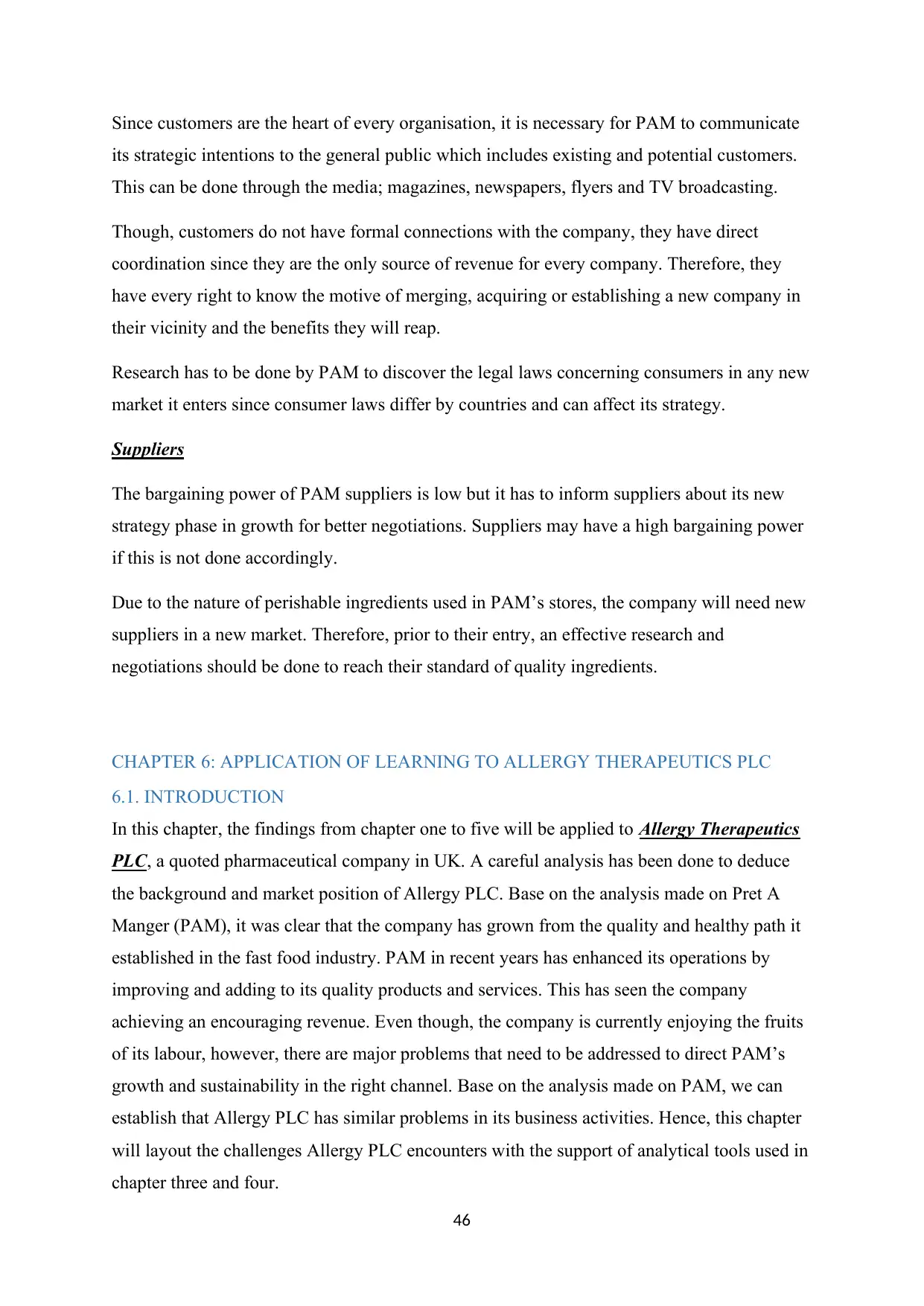
46
Since customers are the heart of every organisation, it is necessary for PAM to communicate
its strategic intentions to the general public which includes existing and potential customers.
This can be done through the media; magazines, newspapers, flyers and TV broadcasting.
Though, customers do not have formal connections with the company, they have direct
coordination since they are the only source of revenue for every company. Therefore, they
have every right to know the motive of merging, acquiring or establishing a new company in
their vicinity and the benefits they will reap.
Research has to be done by PAM to discover the legal laws concerning consumers in any new
market it enters since consumer laws differ by countries and can affect its strategy.
Suppliers
The bargaining power of PAM suppliers is low but it has to inform suppliers about its new
strategy phase in growth for better negotiations. Suppliers may have a high bargaining power
if this is not done accordingly.
Due to the nature of perishable ingredients used in PAM’s stores, the company will need new
suppliers in a new market. Therefore, prior to their entry, an effective research and
negotiations should be done to reach their standard of quality ingredients.
CHAPTER 6: APPLICATION OF LEARNING TO ALLERGY THERAPEUTICS PLC
6.1. INTRODUCTION
In this chapter, the findings from chapter one to five will be applied to Allergy Therapeutics
PLC, a quoted pharmaceutical company in UK. A careful analysis has been done to deduce
the background and market position of Allergy PLC. Base on the analysis made on Pret A
Manger (PAM), it was clear that the company has grown from the quality and healthy path it
established in the fast food industry. PAM in recent years has enhanced its operations by
improving and adding to its quality products and services. This has seen the company
achieving an encouraging revenue. Even though, the company is currently enjoying the fruits
of its labour, however, there are major problems that need to be addressed to direct PAM’s
growth and sustainability in the right channel. Base on the analysis made on PAM, we can
establish that Allergy PLC has similar problems in its business activities. Hence, this chapter
will layout the challenges Allergy PLC encounters with the support of analytical tools used in
chapter three and four.
Since customers are the heart of every organisation, it is necessary for PAM to communicate
its strategic intentions to the general public which includes existing and potential customers.
This can be done through the media; magazines, newspapers, flyers and TV broadcasting.
Though, customers do not have formal connections with the company, they have direct
coordination since they are the only source of revenue for every company. Therefore, they
have every right to know the motive of merging, acquiring or establishing a new company in
their vicinity and the benefits they will reap.
Research has to be done by PAM to discover the legal laws concerning consumers in any new
market it enters since consumer laws differ by countries and can affect its strategy.
Suppliers
The bargaining power of PAM suppliers is low but it has to inform suppliers about its new
strategy phase in growth for better negotiations. Suppliers may have a high bargaining power
if this is not done accordingly.
Due to the nature of perishable ingredients used in PAM’s stores, the company will need new
suppliers in a new market. Therefore, prior to their entry, an effective research and
negotiations should be done to reach their standard of quality ingredients.
CHAPTER 6: APPLICATION OF LEARNING TO ALLERGY THERAPEUTICS PLC
6.1. INTRODUCTION
In this chapter, the findings from chapter one to five will be applied to Allergy Therapeutics
PLC, a quoted pharmaceutical company in UK. A careful analysis has been done to deduce
the background and market position of Allergy PLC. Base on the analysis made on Pret A
Manger (PAM), it was clear that the company has grown from the quality and healthy path it
established in the fast food industry. PAM in recent years has enhanced its operations by
improving and adding to its quality products and services. This has seen the company
achieving an encouraging revenue. Even though, the company is currently enjoying the fruits
of its labour, however, there are major problems that need to be addressed to direct PAM’s
growth and sustainability in the right channel. Base on the analysis made on PAM, we can
establish that Allergy PLC has similar problems in its business activities. Hence, this chapter
will layout the challenges Allergy PLC encounters with the support of analytical tools used in
chapter three and four.
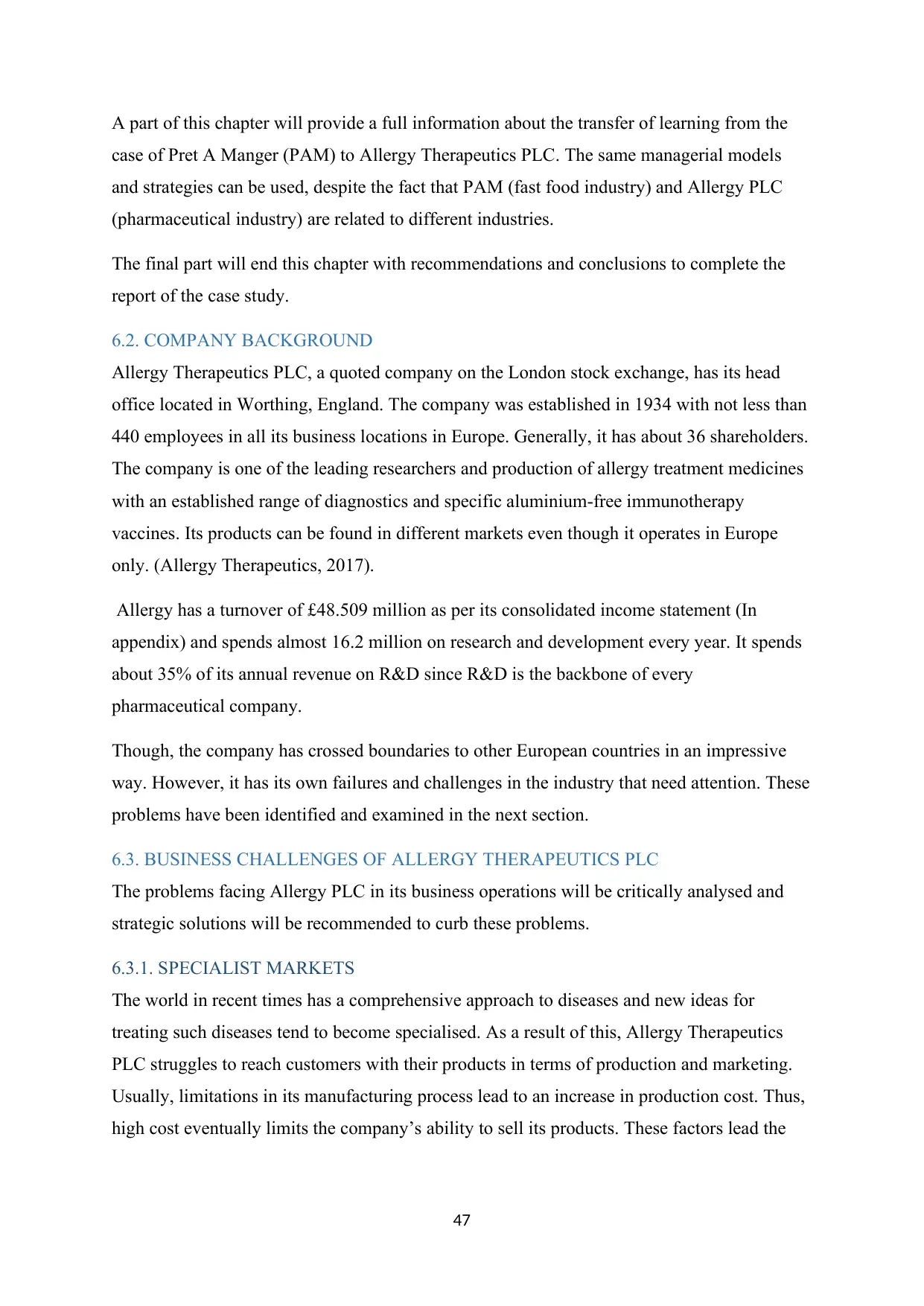
47
A part of this chapter will provide a full information about the transfer of learning from the
case of Pret A Manger (PAM) to Allergy Therapeutics PLC. The same managerial models
and strategies can be used, despite the fact that PAM (fast food industry) and Allergy PLC
(pharmaceutical industry) are related to different industries.
The final part will end this chapter with recommendations and conclusions to complete the
report of the case study.
6.2. COMPANY BACKGROUND
Allergy Therapeutics PLC, a quoted company on the London stock exchange, has its head
office located in Worthing, England. The company was established in 1934 with not less than
440 employees in all its business locations in Europe. Generally, it has about 36 shareholders.
The company is one of the leading researchers and production of allergy treatment medicines
with an established range of diagnostics and specific aluminium-free immunotherapy
vaccines. Its products can be found in different markets even though it operates in Europe
only. (Allergy Therapeutics, 2017).
Allergy has a turnover of £48.509 million as per its consolidated income statement (In
appendix) and spends almost 16.2 million on research and development every year. It spends
about 35% of its annual revenue on R&D since R&D is the backbone of every
pharmaceutical company.
Though, the company has crossed boundaries to other European countries in an impressive
way. However, it has its own failures and challenges in the industry that need attention. These
problems have been identified and examined in the next section.
6.3. BUSINESS CHALLENGES OF ALLERGY THERAPEUTICS PLC
The problems facing Allergy PLC in its business operations will be critically analysed and
strategic solutions will be recommended to curb these problems.
6.3.1. SPECIALIST MARKETS
The world in recent times has a comprehensive approach to diseases and new ideas for
treating such diseases tend to become specialised. As a result of this, Allergy Therapeutics
PLC struggles to reach customers with their products in terms of production and marketing.
Usually, limitations in its manufacturing process lead to an increase in production cost. Thus,
high cost eventually limits the company’s ability to sell its products. These factors lead the
A part of this chapter will provide a full information about the transfer of learning from the
case of Pret A Manger (PAM) to Allergy Therapeutics PLC. The same managerial models
and strategies can be used, despite the fact that PAM (fast food industry) and Allergy PLC
(pharmaceutical industry) are related to different industries.
The final part will end this chapter with recommendations and conclusions to complete the
report of the case study.
6.2. COMPANY BACKGROUND
Allergy Therapeutics PLC, a quoted company on the London stock exchange, has its head
office located in Worthing, England. The company was established in 1934 with not less than
440 employees in all its business locations in Europe. Generally, it has about 36 shareholders.
The company is one of the leading researchers and production of allergy treatment medicines
with an established range of diagnostics and specific aluminium-free immunotherapy
vaccines. Its products can be found in different markets even though it operates in Europe
only. (Allergy Therapeutics, 2017).
Allergy has a turnover of £48.509 million as per its consolidated income statement (In
appendix) and spends almost 16.2 million on research and development every year. It spends
about 35% of its annual revenue on R&D since R&D is the backbone of every
pharmaceutical company.
Though, the company has crossed boundaries to other European countries in an impressive
way. However, it has its own failures and challenges in the industry that need attention. These
problems have been identified and examined in the next section.
6.3. BUSINESS CHALLENGES OF ALLERGY THERAPEUTICS PLC
The problems facing Allergy PLC in its business operations will be critically analysed and
strategic solutions will be recommended to curb these problems.
6.3.1. SPECIALIST MARKETS
The world in recent times has a comprehensive approach to diseases and new ideas for
treating such diseases tend to become specialised. As a result of this, Allergy Therapeutics
PLC struggles to reach customers with their products in terms of production and marketing.
Usually, limitations in its manufacturing process lead to an increase in production cost. Thus,
high cost eventually limits the company’s ability to sell its products. These factors lead the
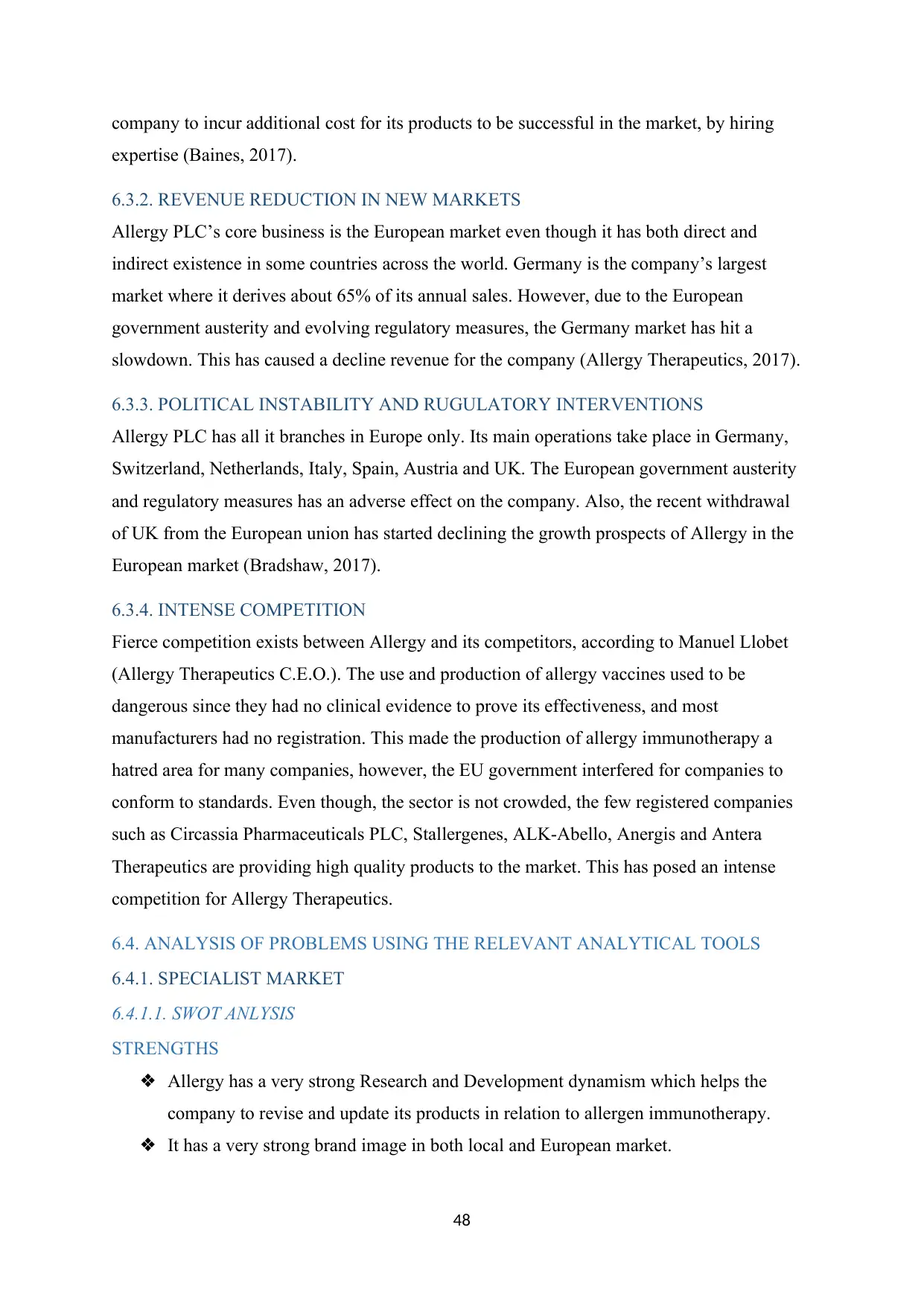
48
company to incur additional cost for its products to be successful in the market, by hiring
expertise (Baines, 2017).
6.3.2. REVENUE REDUCTION IN NEW MARKETS
Allergy PLC’s core business is the European market even though it has both direct and
indirect existence in some countries across the world. Germany is the company’s largest
market where it derives about 65% of its annual sales. However, due to the European
government austerity and evolving regulatory measures, the Germany market has hit a
slowdown. This has caused a decline revenue for the company (Allergy Therapeutics, 2017).
6.3.3. POLITICAL INSTABILITY AND RUGULATORY INTERVENTIONS
Allergy PLC has all it branches in Europe only. Its main operations take place in Germany,
Switzerland, Netherlands, Italy, Spain, Austria and UK. The European government austerity
and regulatory measures has an adverse effect on the company. Also, the recent withdrawal
of UK from the European union has started declining the growth prospects of Allergy in the
European market (Bradshaw, 2017).
6.3.4. INTENSE COMPETITION
Fierce competition exists between Allergy and its competitors, according to Manuel Llobet
(Allergy Therapeutics C.E.O.). The use and production of allergy vaccines used to be
dangerous since they had no clinical evidence to prove its effectiveness, and most
manufacturers had no registration. This made the production of allergy immunotherapy a
hatred area for many companies, however, the EU government interfered for companies to
conform to standards. Even though, the sector is not crowded, the few registered companies
such as Circassia Pharmaceuticals PLC, Stallergenes, ALK-Abello, Anergis and Antera
Therapeutics are providing high quality products to the market. This has posed an intense
competition for Allergy Therapeutics.
6.4. ANALYSIS OF PROBLEMS USING THE RELEVANT ANALYTICAL TOOLS
6.4.1. SPECIALIST MARKET
6.4.1.1. SWOT ANLYSIS
STRENGTHS
❖ Allergy has a very strong Research and Development dynamism which helps the
company to revise and update its products in relation to allergen immunotherapy.
❖ It has a very strong brand image in both local and European market.
company to incur additional cost for its products to be successful in the market, by hiring
expertise (Baines, 2017).
6.3.2. REVENUE REDUCTION IN NEW MARKETS
Allergy PLC’s core business is the European market even though it has both direct and
indirect existence in some countries across the world. Germany is the company’s largest
market where it derives about 65% of its annual sales. However, due to the European
government austerity and evolving regulatory measures, the Germany market has hit a
slowdown. This has caused a decline revenue for the company (Allergy Therapeutics, 2017).
6.3.3. POLITICAL INSTABILITY AND RUGULATORY INTERVENTIONS
Allergy PLC has all it branches in Europe only. Its main operations take place in Germany,
Switzerland, Netherlands, Italy, Spain, Austria and UK. The European government austerity
and regulatory measures has an adverse effect on the company. Also, the recent withdrawal
of UK from the European union has started declining the growth prospects of Allergy in the
European market (Bradshaw, 2017).
6.3.4. INTENSE COMPETITION
Fierce competition exists between Allergy and its competitors, according to Manuel Llobet
(Allergy Therapeutics C.E.O.). The use and production of allergy vaccines used to be
dangerous since they had no clinical evidence to prove its effectiveness, and most
manufacturers had no registration. This made the production of allergy immunotherapy a
hatred area for many companies, however, the EU government interfered for companies to
conform to standards. Even though, the sector is not crowded, the few registered companies
such as Circassia Pharmaceuticals PLC, Stallergenes, ALK-Abello, Anergis and Antera
Therapeutics are providing high quality products to the market. This has posed an intense
competition for Allergy Therapeutics.
6.4. ANALYSIS OF PROBLEMS USING THE RELEVANT ANALYTICAL TOOLS
6.4.1. SPECIALIST MARKET
6.4.1.1. SWOT ANLYSIS
STRENGTHS
❖ Allergy has a very strong Research and Development dynamism which helps the
company to revise and update its products in relation to allergen immunotherapy.
❖ It has a very strong brand image in both local and European market.
Paraphrase This Document
Need a fresh take? Get an instant paraphrase of this document with our AI Paraphraser
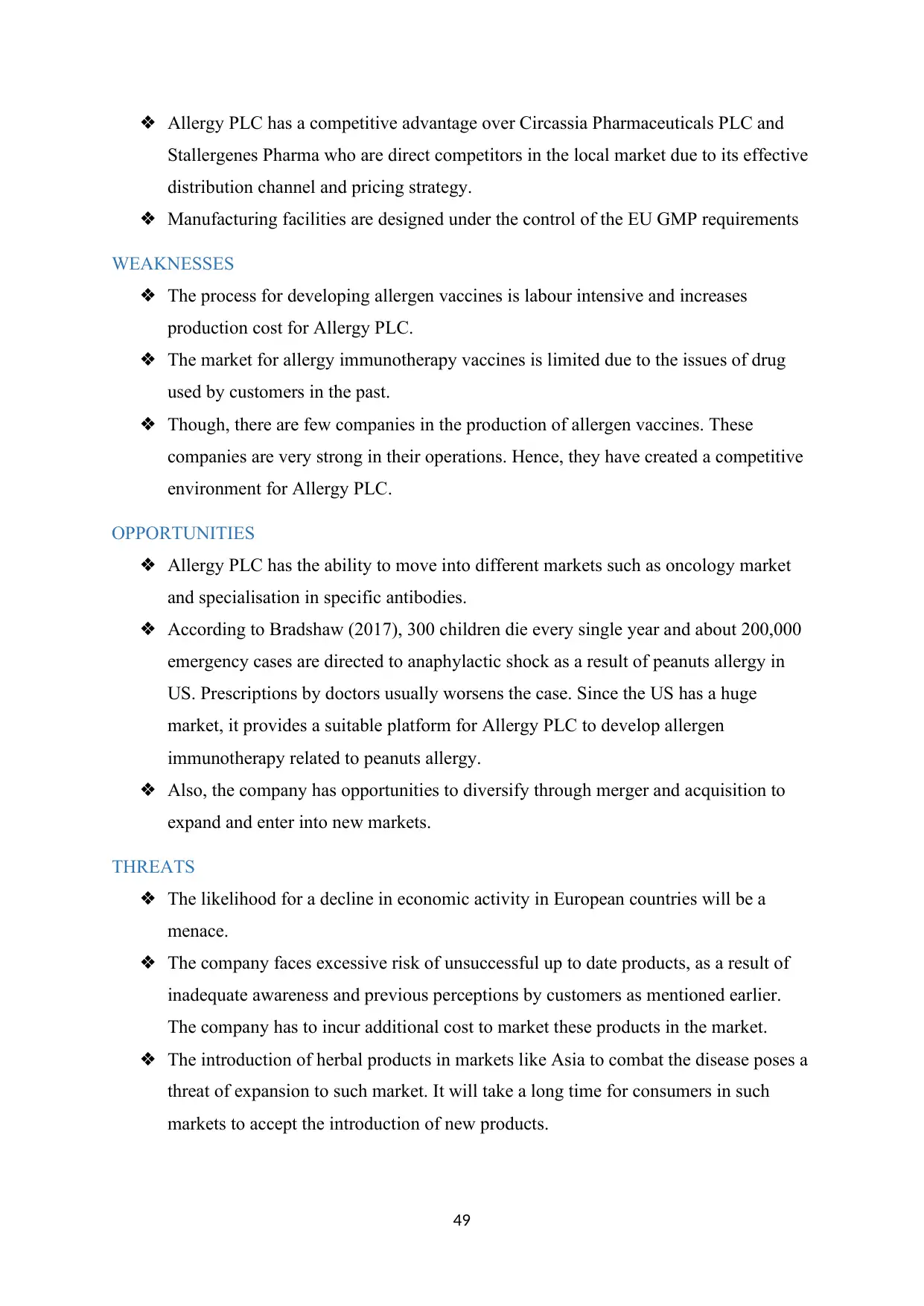
49
❖ Allergy PLC has a competitive advantage over Circassia Pharmaceuticals PLC and
Stallergenes Pharma who are direct competitors in the local market due to its effective
distribution channel and pricing strategy.
❖ Manufacturing facilities are designed under the control of the EU GMP requirements
WEAKNESSES
❖ The process for developing allergen vaccines is labour intensive and increases
production cost for Allergy PLC.
❖ The market for allergy immunotherapy vaccines is limited due to the issues of drug
used by customers in the past.
❖ Though, there are few companies in the production of allergen vaccines. These
companies are very strong in their operations. Hence, they have created a competitive
environment for Allergy PLC.
OPPORTUNITIES
❖ Allergy PLC has the ability to move into different markets such as oncology market
and specialisation in specific antibodies.
❖ According to Bradshaw (2017), 300 children die every single year and about 200,000
emergency cases are directed to anaphylactic shock as a result of peanuts allergy in
US. Prescriptions by doctors usually worsens the case. Since the US has a huge
market, it provides a suitable platform for Allergy PLC to develop allergen
immunotherapy related to peanuts allergy.
❖ Also, the company has opportunities to diversify through merger and acquisition to
expand and enter into new markets.
THREATS
❖ The likelihood for a decline in economic activity in European countries will be a
menace.
❖ The company faces excessive risk of unsuccessful up to date products, as a result of
inadequate awareness and previous perceptions by customers as mentioned earlier.
The company has to incur additional cost to market these products in the market.
❖ The introduction of herbal products in markets like Asia to combat the disease poses a
threat of expansion to such market. It will take a long time for consumers in such
markets to accept the introduction of new products.
❖ Allergy PLC has a competitive advantage over Circassia Pharmaceuticals PLC and
Stallergenes Pharma who are direct competitors in the local market due to its effective
distribution channel and pricing strategy.
❖ Manufacturing facilities are designed under the control of the EU GMP requirements
WEAKNESSES
❖ The process for developing allergen vaccines is labour intensive and increases
production cost for Allergy PLC.
❖ The market for allergy immunotherapy vaccines is limited due to the issues of drug
used by customers in the past.
❖ Though, there are few companies in the production of allergen vaccines. These
companies are very strong in their operations. Hence, they have created a competitive
environment for Allergy PLC.
OPPORTUNITIES
❖ Allergy PLC has the ability to move into different markets such as oncology market
and specialisation in specific antibodies.
❖ According to Bradshaw (2017), 300 children die every single year and about 200,000
emergency cases are directed to anaphylactic shock as a result of peanuts allergy in
US. Prescriptions by doctors usually worsens the case. Since the US has a huge
market, it provides a suitable platform for Allergy PLC to develop allergen
immunotherapy related to peanuts allergy.
❖ Also, the company has opportunities to diversify through merger and acquisition to
expand and enter into new markets.
THREATS
❖ The likelihood for a decline in economic activity in European countries will be a
menace.
❖ The company faces excessive risk of unsuccessful up to date products, as a result of
inadequate awareness and previous perceptions by customers as mentioned earlier.
The company has to incur additional cost to market these products in the market.
❖ The introduction of herbal products in markets like Asia to combat the disease poses a
threat of expansion to such market. It will take a long time for consumers in such
markets to accept the introduction of new products.
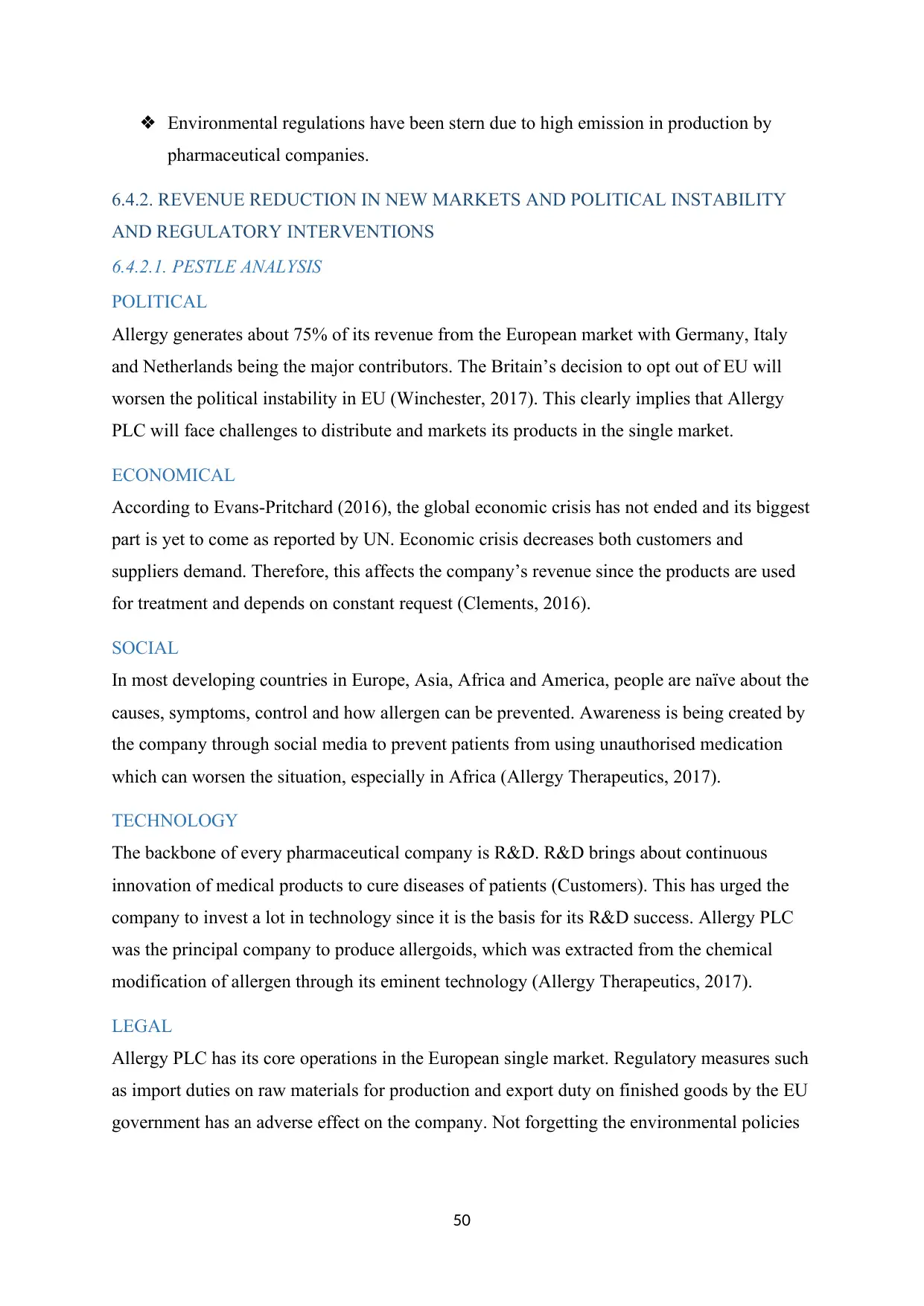
50
❖ Environmental regulations have been stern due to high emission in production by
pharmaceutical companies.
6.4.2. REVENUE REDUCTION IN NEW MARKETS AND POLITICAL INSTABILITY
AND REGULATORY INTERVENTIONS
6.4.2.1. PESTLE ANALYSIS
POLITICAL
Allergy generates about 75% of its revenue from the European market with Germany, Italy
and Netherlands being the major contributors. The Britain’s decision to opt out of EU will
worsen the political instability in EU (Winchester, 2017). This clearly implies that Allergy
PLC will face challenges to distribute and markets its products in the single market.
ECONOMICAL
According to Evans-Pritchard (2016), the global economic crisis has not ended and its biggest
part is yet to come as reported by UN. Economic crisis decreases both customers and
suppliers demand. Therefore, this affects the company’s revenue since the products are used
for treatment and depends on constant request (Clements, 2016).
SOCIAL
In most developing countries in Europe, Asia, Africa and America, people are naïve about the
causes, symptoms, control and how allergen can be prevented. Awareness is being created by
the company through social media to prevent patients from using unauthorised medication
which can worsen the situation, especially in Africa (Allergy Therapeutics, 2017).
TECHNOLOGY
The backbone of every pharmaceutical company is R&D. R&D brings about continuous
innovation of medical products to cure diseases of patients (Customers). This has urged the
company to invest a lot in technology since it is the basis for its R&D success. Allergy PLC
was the principal company to produce allergoids, which was extracted from the chemical
modification of allergen through its eminent technology (Allergy Therapeutics, 2017).
LEGAL
Allergy PLC has its core operations in the European single market. Regulatory measures such
as import duties on raw materials for production and export duty on finished goods by the EU
government has an adverse effect on the company. Not forgetting the environmental policies
❖ Environmental regulations have been stern due to high emission in production by
pharmaceutical companies.
6.4.2. REVENUE REDUCTION IN NEW MARKETS AND POLITICAL INSTABILITY
AND REGULATORY INTERVENTIONS
6.4.2.1. PESTLE ANALYSIS
POLITICAL
Allergy generates about 75% of its revenue from the European market with Germany, Italy
and Netherlands being the major contributors. The Britain’s decision to opt out of EU will
worsen the political instability in EU (Winchester, 2017). This clearly implies that Allergy
PLC will face challenges to distribute and markets its products in the single market.
ECONOMICAL
According to Evans-Pritchard (2016), the global economic crisis has not ended and its biggest
part is yet to come as reported by UN. Economic crisis decreases both customers and
suppliers demand. Therefore, this affects the company’s revenue since the products are used
for treatment and depends on constant request (Clements, 2016).
SOCIAL
In most developing countries in Europe, Asia, Africa and America, people are naïve about the
causes, symptoms, control and how allergen can be prevented. Awareness is being created by
the company through social media to prevent patients from using unauthorised medication
which can worsen the situation, especially in Africa (Allergy Therapeutics, 2017).
TECHNOLOGY
The backbone of every pharmaceutical company is R&D. R&D brings about continuous
innovation of medical products to cure diseases of patients (Customers). This has urged the
company to invest a lot in technology since it is the basis for its R&D success. Allergy PLC
was the principal company to produce allergoids, which was extracted from the chemical
modification of allergen through its eminent technology (Allergy Therapeutics, 2017).
LEGAL
Allergy PLC has its core operations in the European single market. Regulatory measures such
as import duties on raw materials for production and export duty on finished goods by the EU
government has an adverse effect on the company. Not forgetting the environmental policies
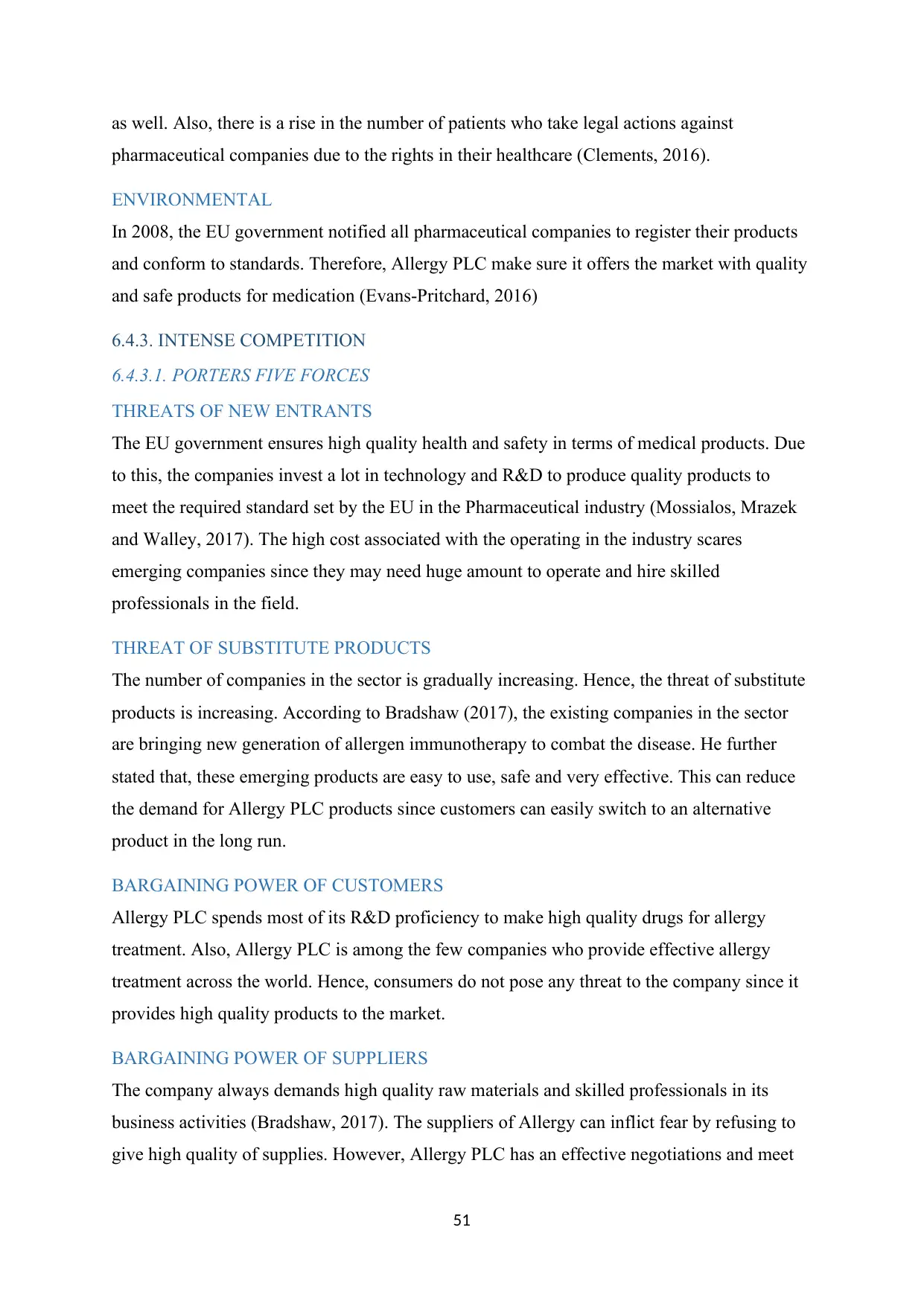
51
as well. Also, there is a rise in the number of patients who take legal actions against
pharmaceutical companies due to the rights in their healthcare (Clements, 2016).
ENVIRONMENTAL
In 2008, the EU government notified all pharmaceutical companies to register their products
and conform to standards. Therefore, Allergy PLC make sure it offers the market with quality
and safe products for medication (Evans-Pritchard, 2016)
6.4.3. INTENSE COMPETITION
6.4.3.1. PORTERS FIVE FORCES
THREATS OF NEW ENTRANTS
The EU government ensures high quality health and safety in terms of medical products. Due
to this, the companies invest a lot in technology and R&D to produce quality products to
meet the required standard set by the EU in the Pharmaceutical industry (Mossialos, Mrazek
and Walley, 2017). The high cost associated with the operating in the industry scares
emerging companies since they may need huge amount to operate and hire skilled
professionals in the field.
THREAT OF SUBSTITUTE PRODUCTS
The number of companies in the sector is gradually increasing. Hence, the threat of substitute
products is increasing. According to Bradshaw (2017), the existing companies in the sector
are bringing new generation of allergen immunotherapy to combat the disease. He further
stated that, these emerging products are easy to use, safe and very effective. This can reduce
the demand for Allergy PLC products since customers can easily switch to an alternative
product in the long run.
BARGAINING POWER OF CUSTOMERS
Allergy PLC spends most of its R&D proficiency to make high quality drugs for allergy
treatment. Also, Allergy PLC is among the few companies who provide effective allergy
treatment across the world. Hence, consumers do not pose any threat to the company since it
provides high quality products to the market.
BARGAINING POWER OF SUPPLIERS
The company always demands high quality raw materials and skilled professionals in its
business activities (Bradshaw, 2017). The suppliers of Allergy can inflict fear by refusing to
give high quality of supplies. However, Allergy PLC has an effective negotiations and meet
as well. Also, there is a rise in the number of patients who take legal actions against
pharmaceutical companies due to the rights in their healthcare (Clements, 2016).
ENVIRONMENTAL
In 2008, the EU government notified all pharmaceutical companies to register their products
and conform to standards. Therefore, Allergy PLC make sure it offers the market with quality
and safe products for medication (Evans-Pritchard, 2016)
6.4.3. INTENSE COMPETITION
6.4.3.1. PORTERS FIVE FORCES
THREATS OF NEW ENTRANTS
The EU government ensures high quality health and safety in terms of medical products. Due
to this, the companies invest a lot in technology and R&D to produce quality products to
meet the required standard set by the EU in the Pharmaceutical industry (Mossialos, Mrazek
and Walley, 2017). The high cost associated with the operating in the industry scares
emerging companies since they may need huge amount to operate and hire skilled
professionals in the field.
THREAT OF SUBSTITUTE PRODUCTS
The number of companies in the sector is gradually increasing. Hence, the threat of substitute
products is increasing. According to Bradshaw (2017), the existing companies in the sector
are bringing new generation of allergen immunotherapy to combat the disease. He further
stated that, these emerging products are easy to use, safe and very effective. This can reduce
the demand for Allergy PLC products since customers can easily switch to an alternative
product in the long run.
BARGAINING POWER OF CUSTOMERS
Allergy PLC spends most of its R&D proficiency to make high quality drugs for allergy
treatment. Also, Allergy PLC is among the few companies who provide effective allergy
treatment across the world. Hence, consumers do not pose any threat to the company since it
provides high quality products to the market.
BARGAINING POWER OF SUPPLIERS
The company always demands high quality raw materials and skilled professionals in its
business activities (Bradshaw, 2017). The suppliers of Allergy can inflict fear by refusing to
give high quality of supplies. However, Allergy PLC has an effective negotiations and meet
Secure Best Marks with AI Grader
Need help grading? Try our AI Grader for instant feedback on your assignments.
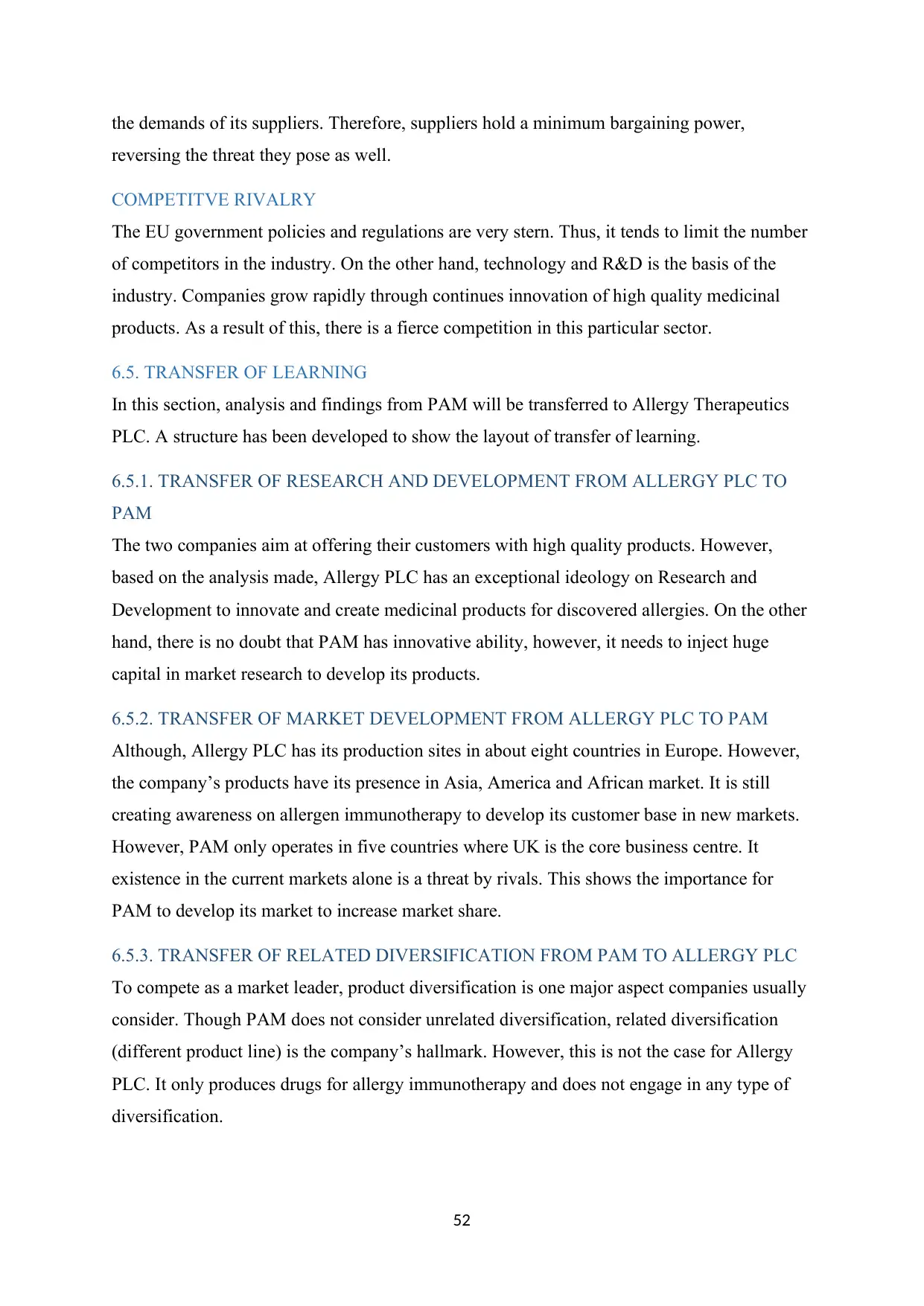
52
the demands of its suppliers. Therefore, suppliers hold a minimum bargaining power,
reversing the threat they pose as well.
COMPETITVE RIVALRY
The EU government policies and regulations are very stern. Thus, it tends to limit the number
of competitors in the industry. On the other hand, technology and R&D is the basis of the
industry. Companies grow rapidly through continues innovation of high quality medicinal
products. As a result of this, there is a fierce competition in this particular sector.
6.5. TRANSFER OF LEARNING
In this section, analysis and findings from PAM will be transferred to Allergy Therapeutics
PLC. A structure has been developed to show the layout of transfer of learning.
6.5.1. TRANSFER OF RESEARCH AND DEVELOPMENT FROM ALLERGY PLC TO
PAM
The two companies aim at offering their customers with high quality products. However,
based on the analysis made, Allergy PLC has an exceptional ideology on Research and
Development to innovate and create medicinal products for discovered allergies. On the other
hand, there is no doubt that PAM has innovative ability, however, it needs to inject huge
capital in market research to develop its products.
6.5.2. TRANSFER OF MARKET DEVELOPMENT FROM ALLERGY PLC TO PAM
Although, Allergy PLC has its production sites in about eight countries in Europe. However,
the company’s products have its presence in Asia, America and African market. It is still
creating awareness on allergen immunotherapy to develop its customer base in new markets.
However, PAM only operates in five countries where UK is the core business centre. It
existence in the current markets alone is a threat by rivals. This shows the importance for
PAM to develop its market to increase market share.
6.5.3. TRANSFER OF RELATED DIVERSIFICATION FROM PAM TO ALLERGY PLC
To compete as a market leader, product diversification is one major aspect companies usually
consider. Though PAM does not consider unrelated diversification, related diversification
(different product line) is the company’s hallmark. However, this is not the case for Allergy
PLC. It only produces drugs for allergy immunotherapy and does not engage in any type of
diversification.
the demands of its suppliers. Therefore, suppliers hold a minimum bargaining power,
reversing the threat they pose as well.
COMPETITVE RIVALRY
The EU government policies and regulations are very stern. Thus, it tends to limit the number
of competitors in the industry. On the other hand, technology and R&D is the basis of the
industry. Companies grow rapidly through continues innovation of high quality medicinal
products. As a result of this, there is a fierce competition in this particular sector.
6.5. TRANSFER OF LEARNING
In this section, analysis and findings from PAM will be transferred to Allergy Therapeutics
PLC. A structure has been developed to show the layout of transfer of learning.
6.5.1. TRANSFER OF RESEARCH AND DEVELOPMENT FROM ALLERGY PLC TO
PAM
The two companies aim at offering their customers with high quality products. However,
based on the analysis made, Allergy PLC has an exceptional ideology on Research and
Development to innovate and create medicinal products for discovered allergies. On the other
hand, there is no doubt that PAM has innovative ability, however, it needs to inject huge
capital in market research to develop its products.
6.5.2. TRANSFER OF MARKET DEVELOPMENT FROM ALLERGY PLC TO PAM
Although, Allergy PLC has its production sites in about eight countries in Europe. However,
the company’s products have its presence in Asia, America and African market. It is still
creating awareness on allergen immunotherapy to develop its customer base in new markets.
However, PAM only operates in five countries where UK is the core business centre. It
existence in the current markets alone is a threat by rivals. This shows the importance for
PAM to develop its market to increase market share.
6.5.3. TRANSFER OF RELATED DIVERSIFICATION FROM PAM TO ALLERGY PLC
To compete as a market leader, product diversification is one major aspect companies usually
consider. Though PAM does not consider unrelated diversification, related diversification
(different product line) is the company’s hallmark. However, this is not the case for Allergy
PLC. It only produces drugs for allergy immunotherapy and does not engage in any type of
diversification.
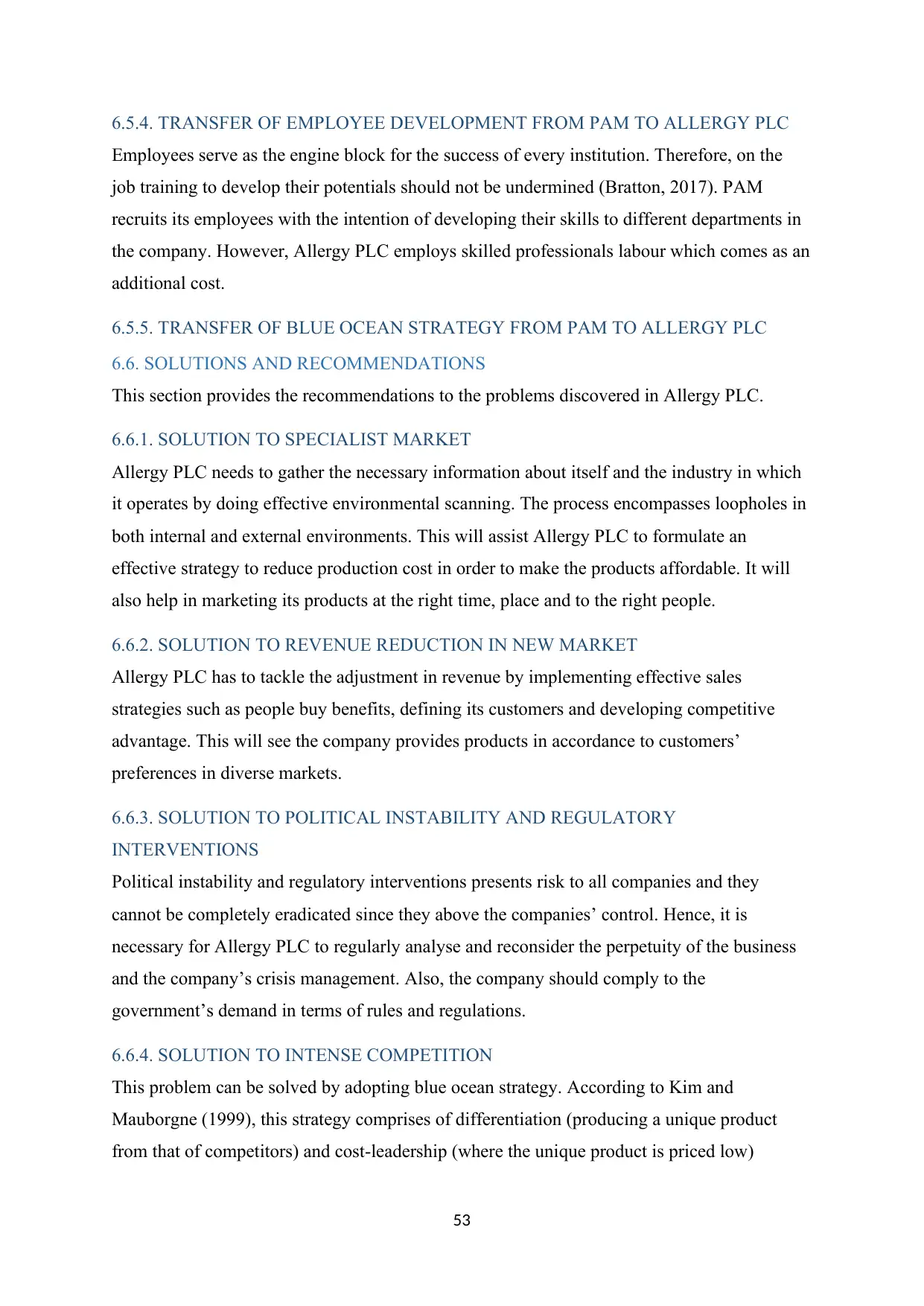
53
6.5.4. TRANSFER OF EMPLOYEE DEVELOPMENT FROM PAM TO ALLERGY PLC
Employees serve as the engine block for the success of every institution. Therefore, on the
job training to develop their potentials should not be undermined (Bratton, 2017). PAM
recruits its employees with the intention of developing their skills to different departments in
the company. However, Allergy PLC employs skilled professionals labour which comes as an
additional cost.
6.5.5. TRANSFER OF BLUE OCEAN STRATEGY FROM PAM TO ALLERGY PLC
6.6. SOLUTIONS AND RECOMMENDATIONS
This section provides the recommendations to the problems discovered in Allergy PLC.
6.6.1. SOLUTION TO SPECIALIST MARKET
Allergy PLC needs to gather the necessary information about itself and the industry in which
it operates by doing effective environmental scanning. The process encompasses loopholes in
both internal and external environments. This will assist Allergy PLC to formulate an
effective strategy to reduce production cost in order to make the products affordable. It will
also help in marketing its products at the right time, place and to the right people.
6.6.2. SOLUTION TO REVENUE REDUCTION IN NEW MARKET
Allergy PLC has to tackle the adjustment in revenue by implementing effective sales
strategies such as people buy benefits, defining its customers and developing competitive
advantage. This will see the company provides products in accordance to customers’
preferences in diverse markets.
6.6.3. SOLUTION TO POLITICAL INSTABILITY AND REGULATORY
INTERVENTIONS
Political instability and regulatory interventions presents risk to all companies and they
cannot be completely eradicated since they above the companies’ control. Hence, it is
necessary for Allergy PLC to regularly analyse and reconsider the perpetuity of the business
and the company’s crisis management. Also, the company should comply to the
government’s demand in terms of rules and regulations.
6.6.4. SOLUTION TO INTENSE COMPETITION
This problem can be solved by adopting blue ocean strategy. According to Kim and
Mauborgne (1999), this strategy comprises of differentiation (producing a unique product
from that of competitors) and cost-leadership (where the unique product is priced low)
6.5.4. TRANSFER OF EMPLOYEE DEVELOPMENT FROM PAM TO ALLERGY PLC
Employees serve as the engine block for the success of every institution. Therefore, on the
job training to develop their potentials should not be undermined (Bratton, 2017). PAM
recruits its employees with the intention of developing their skills to different departments in
the company. However, Allergy PLC employs skilled professionals labour which comes as an
additional cost.
6.5.5. TRANSFER OF BLUE OCEAN STRATEGY FROM PAM TO ALLERGY PLC
6.6. SOLUTIONS AND RECOMMENDATIONS
This section provides the recommendations to the problems discovered in Allergy PLC.
6.6.1. SOLUTION TO SPECIALIST MARKET
Allergy PLC needs to gather the necessary information about itself and the industry in which
it operates by doing effective environmental scanning. The process encompasses loopholes in
both internal and external environments. This will assist Allergy PLC to formulate an
effective strategy to reduce production cost in order to make the products affordable. It will
also help in marketing its products at the right time, place and to the right people.
6.6.2. SOLUTION TO REVENUE REDUCTION IN NEW MARKET
Allergy PLC has to tackle the adjustment in revenue by implementing effective sales
strategies such as people buy benefits, defining its customers and developing competitive
advantage. This will see the company provides products in accordance to customers’
preferences in diverse markets.
6.6.3. SOLUTION TO POLITICAL INSTABILITY AND REGULATORY
INTERVENTIONS
Political instability and regulatory interventions presents risk to all companies and they
cannot be completely eradicated since they above the companies’ control. Hence, it is
necessary for Allergy PLC to regularly analyse and reconsider the perpetuity of the business
and the company’s crisis management. Also, the company should comply to the
government’s demand in terms of rules and regulations.
6.6.4. SOLUTION TO INTENSE COMPETITION
This problem can be solved by adopting blue ocean strategy. According to Kim and
Mauborgne (1999), this strategy comprises of differentiation (producing a unique product
from that of competitors) and cost-leadership (where the unique product is priced low)
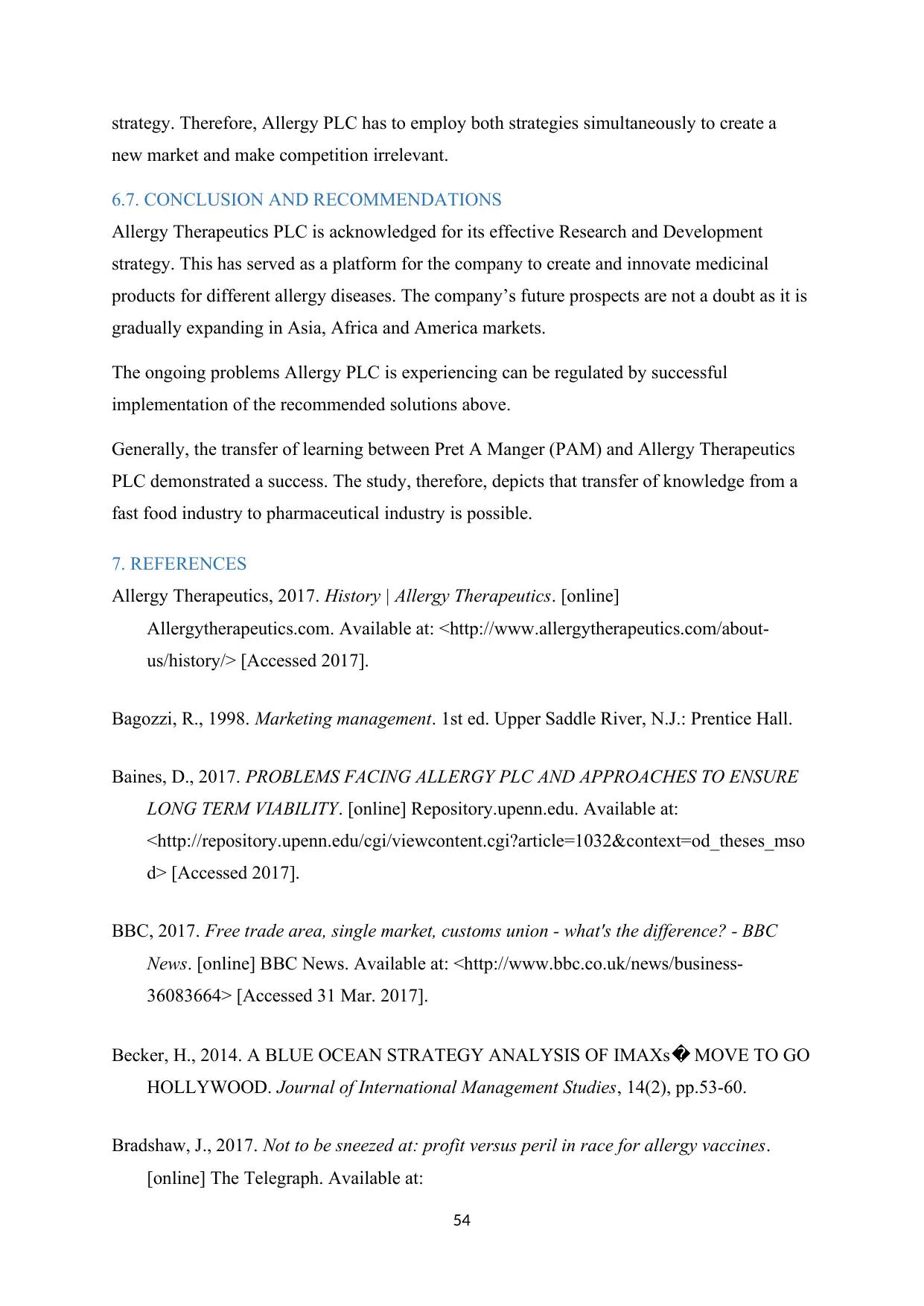
54
strategy. Therefore, Allergy PLC has to employ both strategies simultaneously to create a
new market and make competition irrelevant.
6.7. CONCLUSION AND RECOMMENDATIONS
Allergy Therapeutics PLC is acknowledged for its effective Research and Development
strategy. This has served as a platform for the company to create and innovate medicinal
products for different allergy diseases. The company’s future prospects are not a doubt as it is
gradually expanding in Asia, Africa and America markets.
The ongoing problems Allergy PLC is experiencing can be regulated by successful
implementation of the recommended solutions above.
Generally, the transfer of learning between Pret A Manger (PAM) and Allergy Therapeutics
PLC demonstrated a success. The study, therefore, depicts that transfer of knowledge from a
fast food industry to pharmaceutical industry is possible.
7. REFERENCES
Allergy Therapeutics, 2017. History | Allergy Therapeutics. [online]
Allergytherapeutics.com. Available at: <http://www.allergytherapeutics.com/about-
us/history/> [Accessed 2017].
Bagozzi, R., 1998. Marketing management. 1st ed. Upper Saddle River, N.J.: Prentice Hall.
Baines, D., 2017. PROBLEMS FACING ALLERGY PLC AND APPROACHES TO ENSURE
LONG TERM VIABILITY. [online] Repository.upenn.edu. Available at:
<http://repository.upenn.edu/cgi/viewcontent.cgi?article=1032&context=od_theses_mso
d> [Accessed 2017].
BBC, 2017. Free trade area, single market, customs union - what's the difference? - BBC
News. [online] BBC News. Available at: <http://www.bbc.co.uk/news/business-
36083664> [Accessed 31 Mar. 2017].
Becker, H., 2014. A BLUE OCEAN STRATEGY ANALYSIS OF IMAXs� MOVE TO GO
HOLLYWOOD. Journal of International Management Studies, 14(2), pp.53-60.
Bradshaw, J., 2017. Not to be sneezed at: profit versus peril in race for allergy vaccines.
[online] The Telegraph. Available at:
strategy. Therefore, Allergy PLC has to employ both strategies simultaneously to create a
new market and make competition irrelevant.
6.7. CONCLUSION AND RECOMMENDATIONS
Allergy Therapeutics PLC is acknowledged for its effective Research and Development
strategy. This has served as a platform for the company to create and innovate medicinal
products for different allergy diseases. The company’s future prospects are not a doubt as it is
gradually expanding in Asia, Africa and America markets.
The ongoing problems Allergy PLC is experiencing can be regulated by successful
implementation of the recommended solutions above.
Generally, the transfer of learning between Pret A Manger (PAM) and Allergy Therapeutics
PLC demonstrated a success. The study, therefore, depicts that transfer of knowledge from a
fast food industry to pharmaceutical industry is possible.
7. REFERENCES
Allergy Therapeutics, 2017. History | Allergy Therapeutics. [online]
Allergytherapeutics.com. Available at: <http://www.allergytherapeutics.com/about-
us/history/> [Accessed 2017].
Bagozzi, R., 1998. Marketing management. 1st ed. Upper Saddle River, N.J.: Prentice Hall.
Baines, D., 2017. PROBLEMS FACING ALLERGY PLC AND APPROACHES TO ENSURE
LONG TERM VIABILITY. [online] Repository.upenn.edu. Available at:
<http://repository.upenn.edu/cgi/viewcontent.cgi?article=1032&context=od_theses_mso
d> [Accessed 2017].
BBC, 2017. Free trade area, single market, customs union - what's the difference? - BBC
News. [online] BBC News. Available at: <http://www.bbc.co.uk/news/business-
36083664> [Accessed 31 Mar. 2017].
Becker, H., 2014. A BLUE OCEAN STRATEGY ANALYSIS OF IMAXs� MOVE TO GO
HOLLYWOOD. Journal of International Management Studies, 14(2), pp.53-60.
Bradshaw, J., 2017. Not to be sneezed at: profit versus peril in race for allergy vaccines.
[online] The Telegraph. Available at:
Paraphrase This Document
Need a fresh take? Get an instant paraphrase of this document with our AI Paraphraser
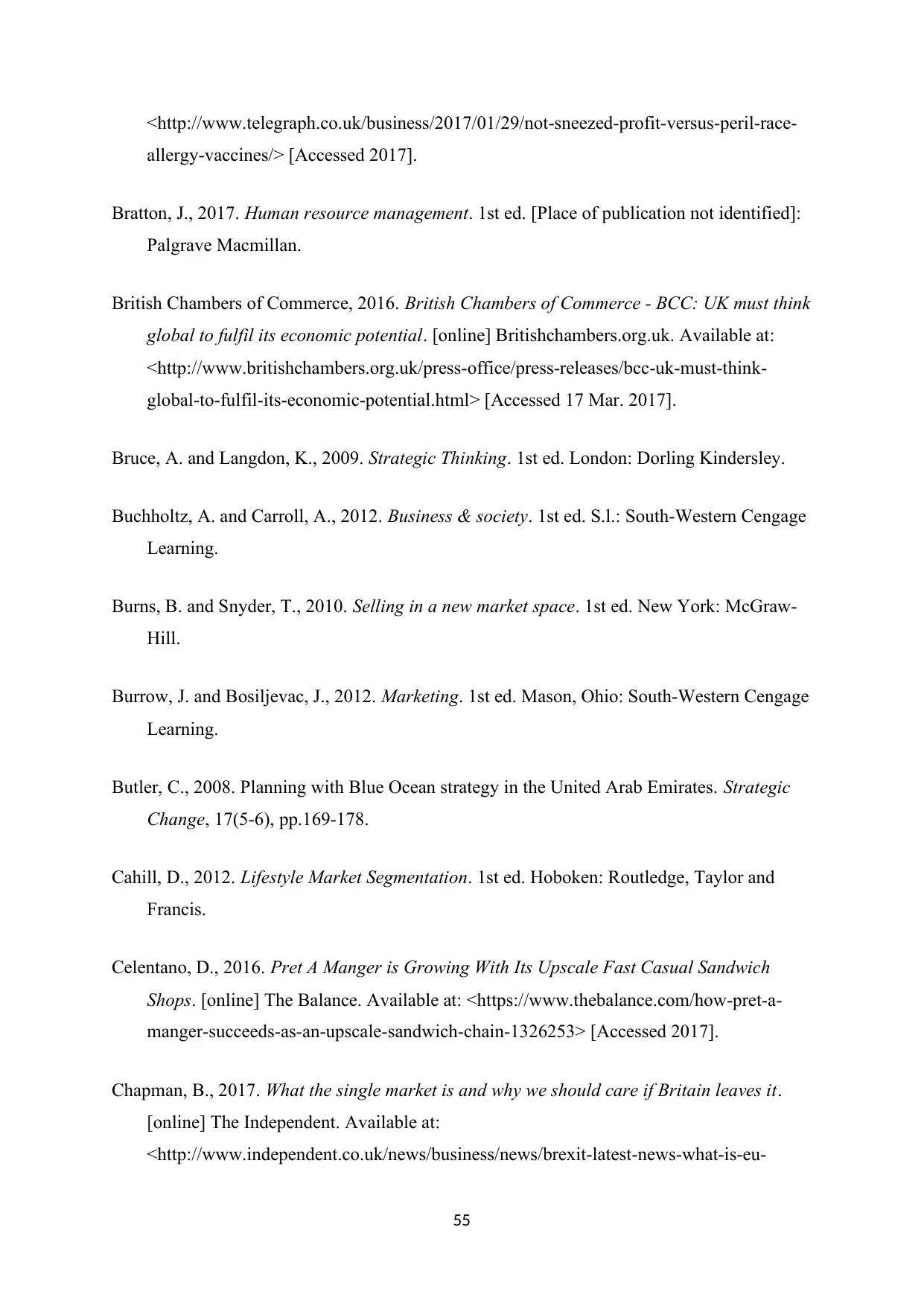
55
<http://www.telegraph.co.uk/business/2017/01/29/not-sneezed-profit-versus-peril-race-
allergy-vaccines/> [Accessed 2017].
Bratton, J., 2017. Human resource management. 1st ed. [Place of publication not identified]:
Palgrave Macmillan.
British Chambers of Commerce, 2016. British Chambers of Commerce - BCC: UK must think
global to fulfil its economic potential. [online] Britishchambers.org.uk. Available at:
<http://www.britishchambers.org.uk/press-office/press-releases/bcc-uk-must-think-
global-to-fulfil-its-economic-potential.html> [Accessed 17 Mar. 2017].
Bruce, A. and Langdon, K., 2009. Strategic Thinking. 1st ed. London: Dorling Kindersley.
Buchholtz, A. and Carroll, A., 2012. Business & society. 1st ed. S.l.: South-Western Cengage
Learning.
Burns, B. and Snyder, T., 2010. Selling in a new market space. 1st ed. New York: McGraw-
Hill.
Burrow, J. and Bosiljevac, J., 2012. Marketing. 1st ed. Mason, Ohio: South-Western Cengage
Learning.
Butler, C., 2008. Planning with Blue Ocean strategy in the United Arab Emirates. Strategic
Change, 17(5-6), pp.169-178.
Cahill, D., 2012. Lifestyle Market Segmentation. 1st ed. Hoboken: Routledge, Taylor and
Francis.
Celentano, D., 2016. Pret A Manger is Growing With Its Upscale Fast Casual Sandwich
Shops. [online] The Balance. Available at: <https://www.thebalance.com/how-pret-a-
manger-succeeds-as-an-upscale-sandwich-chain-1326253> [Accessed 2017].
Chapman, B., 2017. What the single market is and why we should care if Britain leaves it.
[online] The Independent. Available at:
<http://www.independent.co.uk/news/business/news/brexit-latest-news-what-is-eu-
<http://www.telegraph.co.uk/business/2017/01/29/not-sneezed-profit-versus-peril-race-
allergy-vaccines/> [Accessed 2017].
Bratton, J., 2017. Human resource management. 1st ed. [Place of publication not identified]:
Palgrave Macmillan.
British Chambers of Commerce, 2016. British Chambers of Commerce - BCC: UK must think
global to fulfil its economic potential. [online] Britishchambers.org.uk. Available at:
<http://www.britishchambers.org.uk/press-office/press-releases/bcc-uk-must-think-
global-to-fulfil-its-economic-potential.html> [Accessed 17 Mar. 2017].
Bruce, A. and Langdon, K., 2009. Strategic Thinking. 1st ed. London: Dorling Kindersley.
Buchholtz, A. and Carroll, A., 2012. Business & society. 1st ed. S.l.: South-Western Cengage
Learning.
Burns, B. and Snyder, T., 2010. Selling in a new market space. 1st ed. New York: McGraw-
Hill.
Burrow, J. and Bosiljevac, J., 2012. Marketing. 1st ed. Mason, Ohio: South-Western Cengage
Learning.
Butler, C., 2008. Planning with Blue Ocean strategy in the United Arab Emirates. Strategic
Change, 17(5-6), pp.169-178.
Cahill, D., 2012. Lifestyle Market Segmentation. 1st ed. Hoboken: Routledge, Taylor and
Francis.
Celentano, D., 2016. Pret A Manger is Growing With Its Upscale Fast Casual Sandwich
Shops. [online] The Balance. Available at: <https://www.thebalance.com/how-pret-a-
manger-succeeds-as-an-upscale-sandwich-chain-1326253> [Accessed 2017].
Chapman, B., 2017. What the single market is and why we should care if Britain leaves it.
[online] The Independent. Available at:
<http://www.independent.co.uk/news/business/news/brexit-latest-news-what-is-eu-
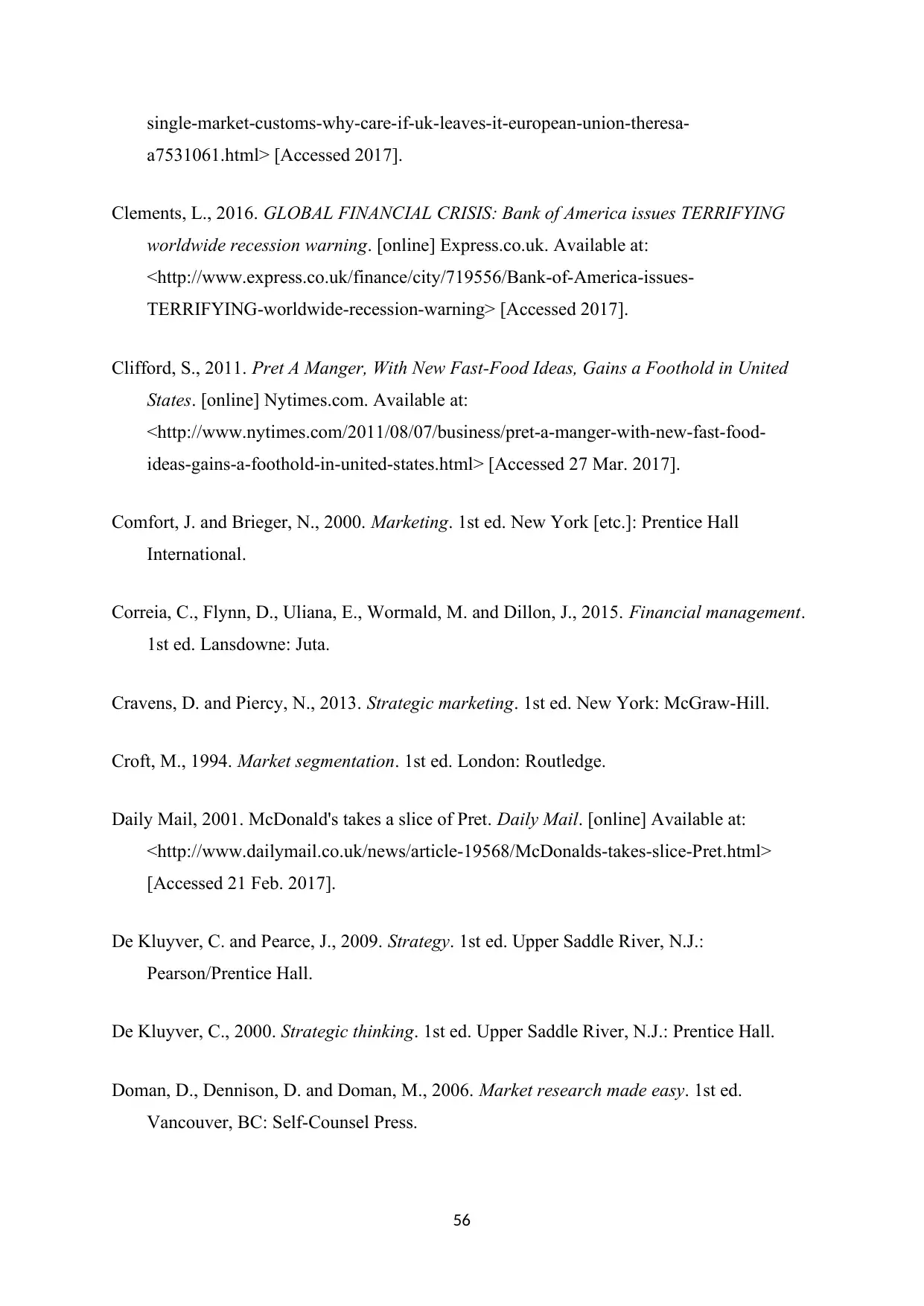
56
single-market-customs-why-care-if-uk-leaves-it-european-union-theresa-
a7531061.html> [Accessed 2017].
Clements, L., 2016. GLOBAL FINANCIAL CRISIS: Bank of America issues TERRIFYING
worldwide recession warning. [online] Express.co.uk. Available at:
<http://www.express.co.uk/finance/city/719556/Bank-of-America-issues-
TERRIFYING-worldwide-recession-warning> [Accessed 2017].
Clifford, S., 2011. Pret A Manger, With New Fast-Food Ideas, Gains a Foothold in United
States. [online] Nytimes.com. Available at:
<http://www.nytimes.com/2011/08/07/business/pret-a-manger-with-new-fast-food-
ideas-gains-a-foothold-in-united-states.html> [Accessed 27 Mar. 2017].
Comfort, J. and Brieger, N., 2000. Marketing. 1st ed. New York [etc.]: Prentice Hall
International.
Correia, C., Flynn, D., Uliana, E., Wormald, M. and Dillon, J., 2015. Financial management.
1st ed. Lansdowne: Juta.
Cravens, D. and Piercy, N., 2013. Strategic marketing. 1st ed. New York: McGraw-Hill.
Croft, M., 1994. Market segmentation. 1st ed. London: Routledge.
Daily Mail, 2001. McDonald's takes a slice of Pret. Daily Mail. [online] Available at:
<http://www.dailymail.co.uk/news/article-19568/McDonalds-takes-slice-Pret.html>
[Accessed 21 Feb. 2017].
De Kluyver, C. and Pearce, J., 2009. Strategy. 1st ed. Upper Saddle River, N.J.:
Pearson/Prentice Hall.
De Kluyver, C., 2000. Strategic thinking. 1st ed. Upper Saddle River, N.J.: Prentice Hall.
Doman, D., Dennison, D. and Doman, M., 2006. Market research made easy. 1st ed.
Vancouver, BC: Self-Counsel Press.
single-market-customs-why-care-if-uk-leaves-it-european-union-theresa-
a7531061.html> [Accessed 2017].
Clements, L., 2016. GLOBAL FINANCIAL CRISIS: Bank of America issues TERRIFYING
worldwide recession warning. [online] Express.co.uk. Available at:
<http://www.express.co.uk/finance/city/719556/Bank-of-America-issues-
TERRIFYING-worldwide-recession-warning> [Accessed 2017].
Clifford, S., 2011. Pret A Manger, With New Fast-Food Ideas, Gains a Foothold in United
States. [online] Nytimes.com. Available at:
<http://www.nytimes.com/2011/08/07/business/pret-a-manger-with-new-fast-food-
ideas-gains-a-foothold-in-united-states.html> [Accessed 27 Mar. 2017].
Comfort, J. and Brieger, N., 2000. Marketing. 1st ed. New York [etc.]: Prentice Hall
International.
Correia, C., Flynn, D., Uliana, E., Wormald, M. and Dillon, J., 2015. Financial management.
1st ed. Lansdowne: Juta.
Cravens, D. and Piercy, N., 2013. Strategic marketing. 1st ed. New York: McGraw-Hill.
Croft, M., 1994. Market segmentation. 1st ed. London: Routledge.
Daily Mail, 2001. McDonald's takes a slice of Pret. Daily Mail. [online] Available at:
<http://www.dailymail.co.uk/news/article-19568/McDonalds-takes-slice-Pret.html>
[Accessed 21 Feb. 2017].
De Kluyver, C. and Pearce, J., 2009. Strategy. 1st ed. Upper Saddle River, N.J.:
Pearson/Prentice Hall.
De Kluyver, C., 2000. Strategic thinking. 1st ed. Upper Saddle River, N.J.: Prentice Hall.
Doman, D., Dennison, D. and Doman, M., 2006. Market research made easy. 1st ed.
Vancouver, BC: Self-Counsel Press.
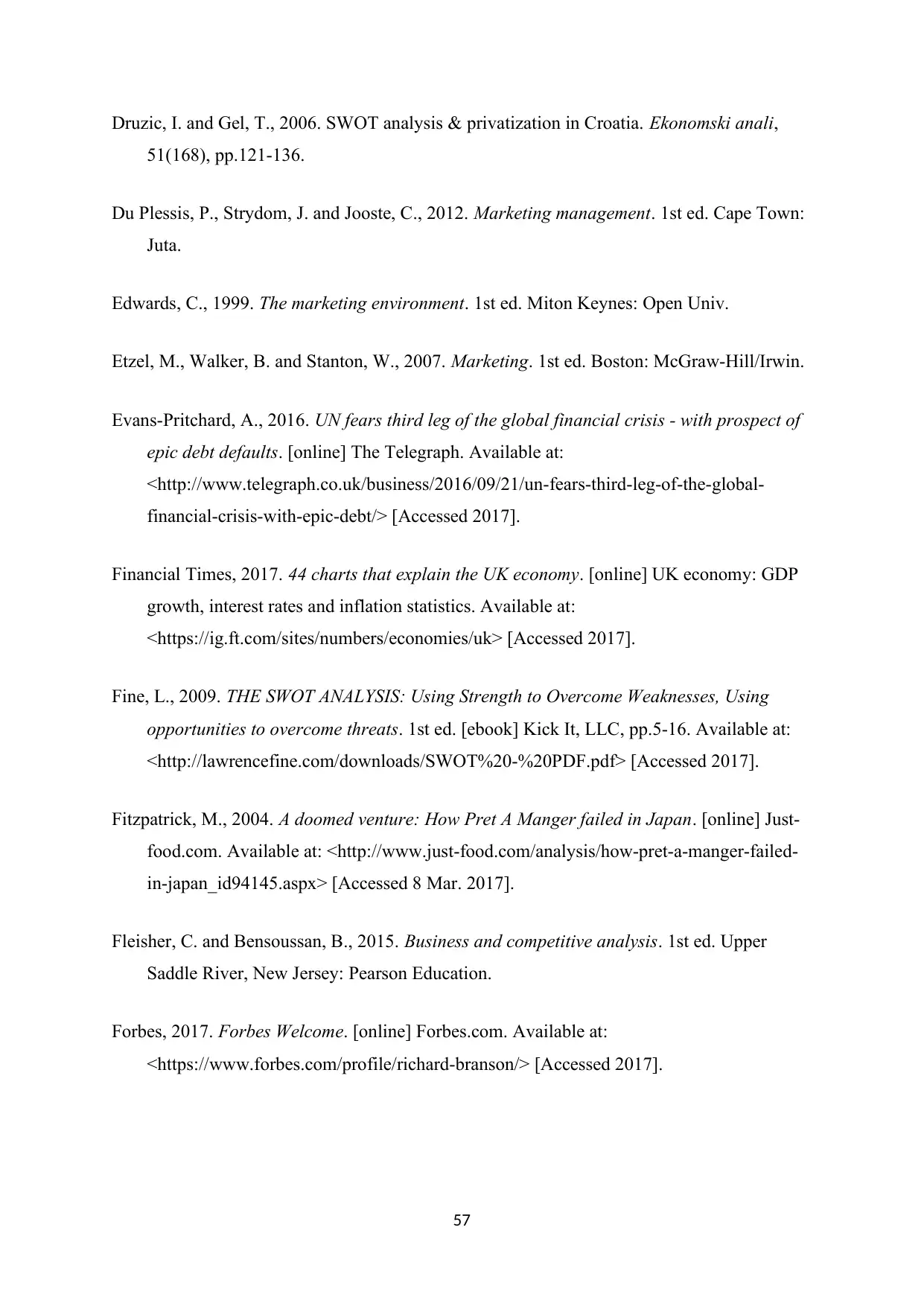
57
Druzic, I. and Gel, T., 2006. SWOT analysis & privatization in Croatia. Ekonomski anali,
51(168), pp.121-136.
Du Plessis, P., Strydom, J. and Jooste, C., 2012. Marketing management. 1st ed. Cape Town:
Juta.
Edwards, C., 1999. The marketing environment. 1st ed. Miton Keynes: Open Univ.
Etzel, M., Walker, B. and Stanton, W., 2007. Marketing. 1st ed. Boston: McGraw-Hill/Irwin.
Evans-Pritchard, A., 2016. UN fears third leg of the global financial crisis - with prospect of
epic debt defaults. [online] The Telegraph. Available at:
<http://www.telegraph.co.uk/business/2016/09/21/un-fears-third-leg-of-the-global-
financial-crisis-with-epic-debt/> [Accessed 2017].
Financial Times, 2017. 44 charts that explain the UK economy. [online] UK economy: GDP
growth, interest rates and inflation statistics. Available at:
<https://ig.ft.com/sites/numbers/economies/uk> [Accessed 2017].
Fine, L., 2009. THE SWOT ANALYSIS: Using Strength to Overcome Weaknesses, Using
opportunities to overcome threats. 1st ed. [ebook] Kick It, LLC, pp.5-16. Available at:
<http://lawrencefine.com/downloads/SWOT%20-%20PDF.pdf> [Accessed 2017].
Fitzpatrick, M., 2004. A doomed venture: How Pret A Manger failed in Japan. [online] Just-
food.com. Available at: <http://www.just-food.com/analysis/how-pret-a-manger-failed-
in-japan_id94145.aspx> [Accessed 8 Mar. 2017].
Fleisher, C. and Bensoussan, B., 2015. Business and competitive analysis. 1st ed. Upper
Saddle River, New Jersey: Pearson Education.
Forbes, 2017. Forbes Welcome. [online] Forbes.com. Available at:
<https://www.forbes.com/profile/richard-branson/> [Accessed 2017].
Druzic, I. and Gel, T., 2006. SWOT analysis & privatization in Croatia. Ekonomski anali,
51(168), pp.121-136.
Du Plessis, P., Strydom, J. and Jooste, C., 2012. Marketing management. 1st ed. Cape Town:
Juta.
Edwards, C., 1999. The marketing environment. 1st ed. Miton Keynes: Open Univ.
Etzel, M., Walker, B. and Stanton, W., 2007. Marketing. 1st ed. Boston: McGraw-Hill/Irwin.
Evans-Pritchard, A., 2016. UN fears third leg of the global financial crisis - with prospect of
epic debt defaults. [online] The Telegraph. Available at:
<http://www.telegraph.co.uk/business/2016/09/21/un-fears-third-leg-of-the-global-
financial-crisis-with-epic-debt/> [Accessed 2017].
Financial Times, 2017. 44 charts that explain the UK economy. [online] UK economy: GDP
growth, interest rates and inflation statistics. Available at:
<https://ig.ft.com/sites/numbers/economies/uk> [Accessed 2017].
Fine, L., 2009. THE SWOT ANALYSIS: Using Strength to Overcome Weaknesses, Using
opportunities to overcome threats. 1st ed. [ebook] Kick It, LLC, pp.5-16. Available at:
<http://lawrencefine.com/downloads/SWOT%20-%20PDF.pdf> [Accessed 2017].
Fitzpatrick, M., 2004. A doomed venture: How Pret A Manger failed in Japan. [online] Just-
food.com. Available at: <http://www.just-food.com/analysis/how-pret-a-manger-failed-
in-japan_id94145.aspx> [Accessed 8 Mar. 2017].
Fleisher, C. and Bensoussan, B., 2015. Business and competitive analysis. 1st ed. Upper
Saddle River, New Jersey: Pearson Education.
Forbes, 2017. Forbes Welcome. [online] Forbes.com. Available at:
<https://www.forbes.com/profile/richard-branson/> [Accessed 2017].
Secure Best Marks with AI Grader
Need help grading? Try our AI Grader for instant feedback on your assignments.
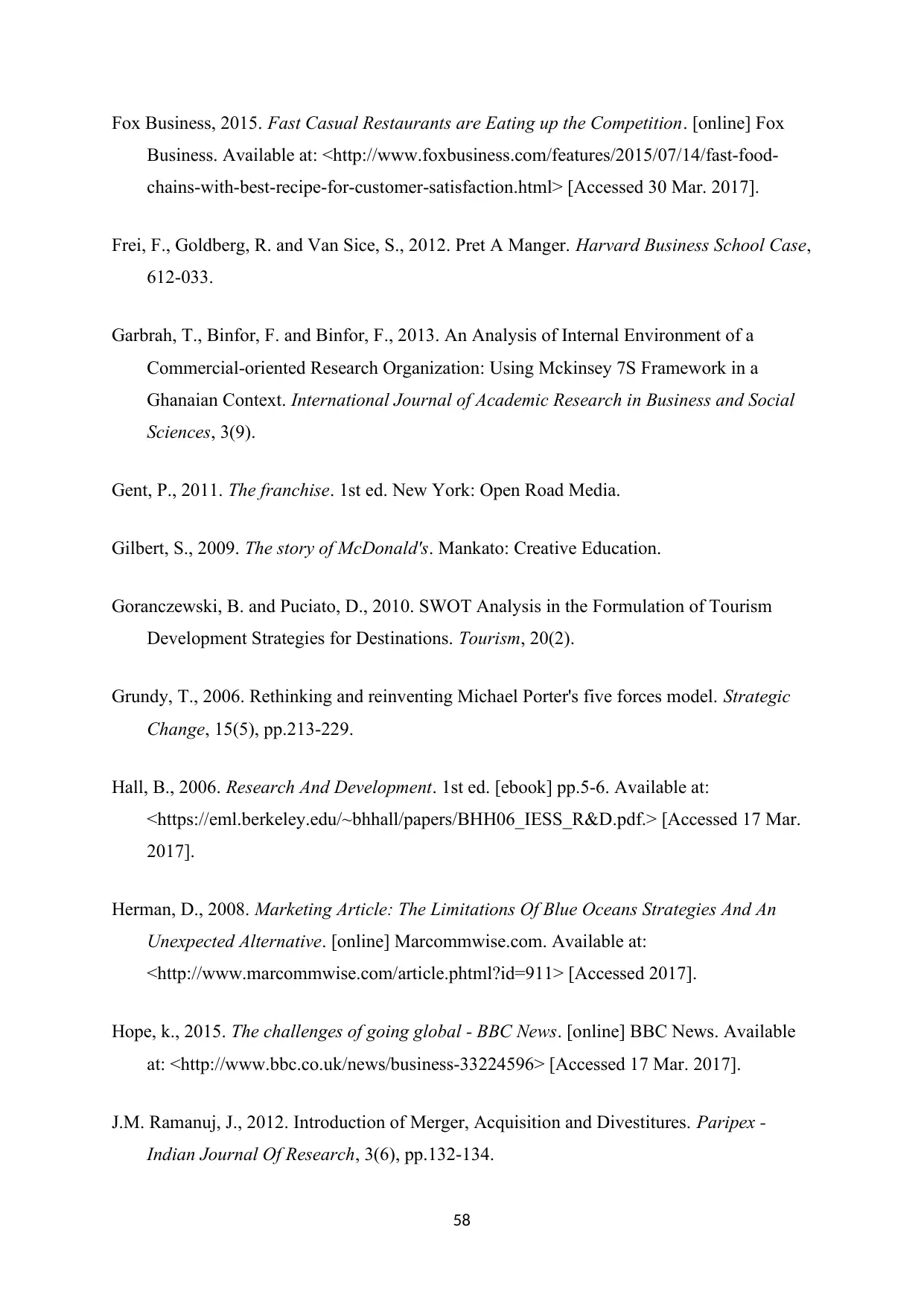
58
Fox Business, 2015. Fast Casual Restaurants are Eating up the Competition. [online] Fox
Business. Available at: <http://www.foxbusiness.com/features/2015/07/14/fast-food-
chains-with-best-recipe-for-customer-satisfaction.html> [Accessed 30 Mar. 2017].
Frei, F., Goldberg, R. and Van Sice, S., 2012. Pret A Manger. Harvard Business School Case,
612-033.
Garbrah, T., Binfor, F. and Binfor, F., 2013. An Analysis of Internal Environment of a
Commercial-oriented Research Organization: Using Mckinsey 7S Framework in a
Ghanaian Context. International Journal of Academic Research in Business and Social
Sciences, 3(9).
Gent, P., 2011. The franchise. 1st ed. New York: Open Road Media.
Gilbert, S., 2009. The story of McDonald's. Mankato: Creative Education.
Goranczewski, B. and Puciato, D., 2010. SWOT Analysis in the Formulation of Tourism
Development Strategies for Destinations. Tourism, 20(2).
Grundy, T., 2006. Rethinking and reinventing Michael Porter's five forces model. Strategic
Change, 15(5), pp.213-229.
Hall, B., 2006. Research And Development. 1st ed. [ebook] pp.5-6. Available at:
<https://eml.berkeley.edu/~bhhall/papers/BHH06_IESS_R&D.pdf.> [Accessed 17 Mar.
2017].
Herman, D., 2008. Marketing Article: The Limitations Of Blue Oceans Strategies And An
Unexpected Alternative. [online] Marcommwise.com. Available at:
<http://www.marcommwise.com/article.phtml?id=911> [Accessed 2017].
Hope, k., 2015. The challenges of going global - BBC News. [online] BBC News. Available
at: <http://www.bbc.co.uk/news/business-33224596> [Accessed 17 Mar. 2017].
J.M. Ramanuj, J., 2012. Introduction of Merger, Acquisition and Divestitures. Paripex -
Indian Journal Of Research, 3(6), pp.132-134.
Fox Business, 2015. Fast Casual Restaurants are Eating up the Competition. [online] Fox
Business. Available at: <http://www.foxbusiness.com/features/2015/07/14/fast-food-
chains-with-best-recipe-for-customer-satisfaction.html> [Accessed 30 Mar. 2017].
Frei, F., Goldberg, R. and Van Sice, S., 2012. Pret A Manger. Harvard Business School Case,
612-033.
Garbrah, T., Binfor, F. and Binfor, F., 2013. An Analysis of Internal Environment of a
Commercial-oriented Research Organization: Using Mckinsey 7S Framework in a
Ghanaian Context. International Journal of Academic Research in Business and Social
Sciences, 3(9).
Gent, P., 2011. The franchise. 1st ed. New York: Open Road Media.
Gilbert, S., 2009. The story of McDonald's. Mankato: Creative Education.
Goranczewski, B. and Puciato, D., 2010. SWOT Analysis in the Formulation of Tourism
Development Strategies for Destinations. Tourism, 20(2).
Grundy, T., 2006. Rethinking and reinventing Michael Porter's five forces model. Strategic
Change, 15(5), pp.213-229.
Hall, B., 2006. Research And Development. 1st ed. [ebook] pp.5-6. Available at:
<https://eml.berkeley.edu/~bhhall/papers/BHH06_IESS_R&D.pdf.> [Accessed 17 Mar.
2017].
Herman, D., 2008. Marketing Article: The Limitations Of Blue Oceans Strategies And An
Unexpected Alternative. [online] Marcommwise.com. Available at:
<http://www.marcommwise.com/article.phtml?id=911> [Accessed 2017].
Hope, k., 2015. The challenges of going global - BBC News. [online] BBC News. Available
at: <http://www.bbc.co.uk/news/business-33224596> [Accessed 17 Mar. 2017].
J.M. Ramanuj, J., 2012. Introduction of Merger, Acquisition and Divestitures. Paripex -
Indian Journal Of Research, 3(6), pp.132-134.
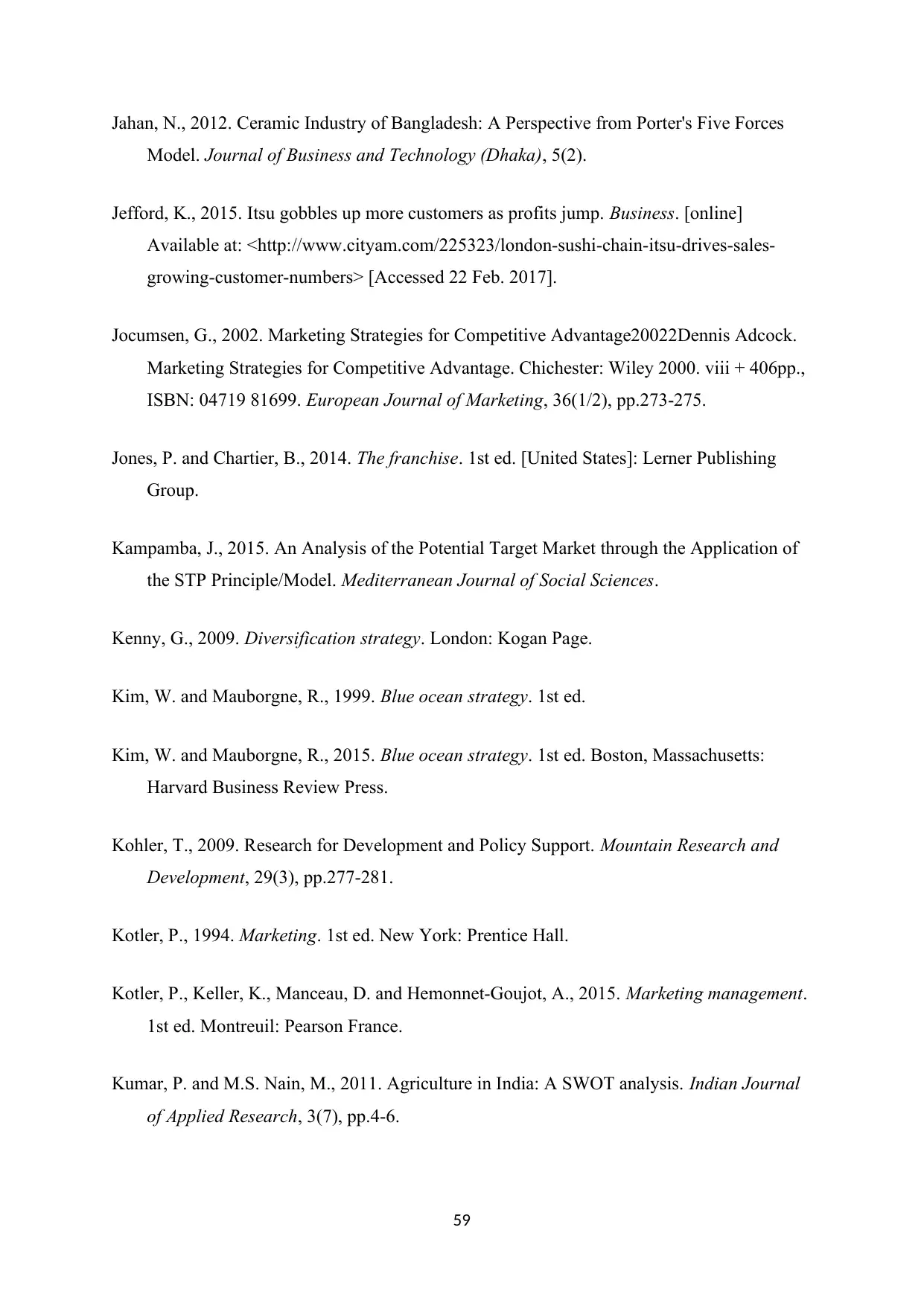
59
Jahan, N., 2012. Ceramic Industry of Bangladesh: A Perspective from Porter's Five Forces
Model. Journal of Business and Technology (Dhaka), 5(2).
Jefford, K., 2015. Itsu gobbles up more customers as profits jump. Business. [online]
Available at: <http://www.cityam.com/225323/london-sushi-chain-itsu-drives-sales-
growing-customer-numbers> [Accessed 22 Feb. 2017].
Jocumsen, G., 2002. Marketing Strategies for Competitive Advantage20022Dennis Adcock.
Marketing Strategies for Competitive Advantage. Chichester: Wiley 2000. viii + 406pp.,
ISBN: 04719 81699. European Journal of Marketing, 36(1/2), pp.273-275.
Jones, P. and Chartier, B., 2014. The franchise. 1st ed. [United States]: Lerner Publishing
Group.
Kampamba, J., 2015. An Analysis of the Potential Target Market through the Application of
the STP Principle/Model. Mediterranean Journal of Social Sciences.
Kenny, G., 2009. Diversification strategy. London: Kogan Page.
Kim, W. and Mauborgne, R., 1999. Blue ocean strategy. 1st ed.
Kim, W. and Mauborgne, R., 2015. Blue ocean strategy. 1st ed. Boston, Massachusetts:
Harvard Business Review Press.
Kohler, T., 2009. Research for Development and Policy Support. Mountain Research and
Development, 29(3), pp.277-281.
Kotler, P., 1994. Marketing. 1st ed. New York: Prentice Hall.
Kotler, P., Keller, K., Manceau, D. and Hemonnet-Goujot, A., 2015. Marketing management.
1st ed. Montreuil: Pearson France.
Kumar, P. and M.S. Nain, M., 2011. Agriculture in India: A SWOT analysis. Indian Journal
of Applied Research, 3(7), pp.4-6.
Jahan, N., 2012. Ceramic Industry of Bangladesh: A Perspective from Porter's Five Forces
Model. Journal of Business and Technology (Dhaka), 5(2).
Jefford, K., 2015. Itsu gobbles up more customers as profits jump. Business. [online]
Available at: <http://www.cityam.com/225323/london-sushi-chain-itsu-drives-sales-
growing-customer-numbers> [Accessed 22 Feb. 2017].
Jocumsen, G., 2002. Marketing Strategies for Competitive Advantage20022Dennis Adcock.
Marketing Strategies for Competitive Advantage. Chichester: Wiley 2000. viii + 406pp.,
ISBN: 04719 81699. European Journal of Marketing, 36(1/2), pp.273-275.
Jones, P. and Chartier, B., 2014. The franchise. 1st ed. [United States]: Lerner Publishing
Group.
Kampamba, J., 2015. An Analysis of the Potential Target Market through the Application of
the STP Principle/Model. Mediterranean Journal of Social Sciences.
Kenny, G., 2009. Diversification strategy. London: Kogan Page.
Kim, W. and Mauborgne, R., 1999. Blue ocean strategy. 1st ed.
Kim, W. and Mauborgne, R., 2015. Blue ocean strategy. 1st ed. Boston, Massachusetts:
Harvard Business Review Press.
Kohler, T., 2009. Research for Development and Policy Support. Mountain Research and
Development, 29(3), pp.277-281.
Kotler, P., 1994. Marketing. 1st ed. New York: Prentice Hall.
Kotler, P., Keller, K., Manceau, D. and Hemonnet-Goujot, A., 2015. Marketing management.
1st ed. Montreuil: Pearson France.
Kumar, P. and M.S. Nain, M., 2011. Agriculture in India: A SWOT analysis. Indian Journal
of Applied Research, 3(7), pp.4-6.
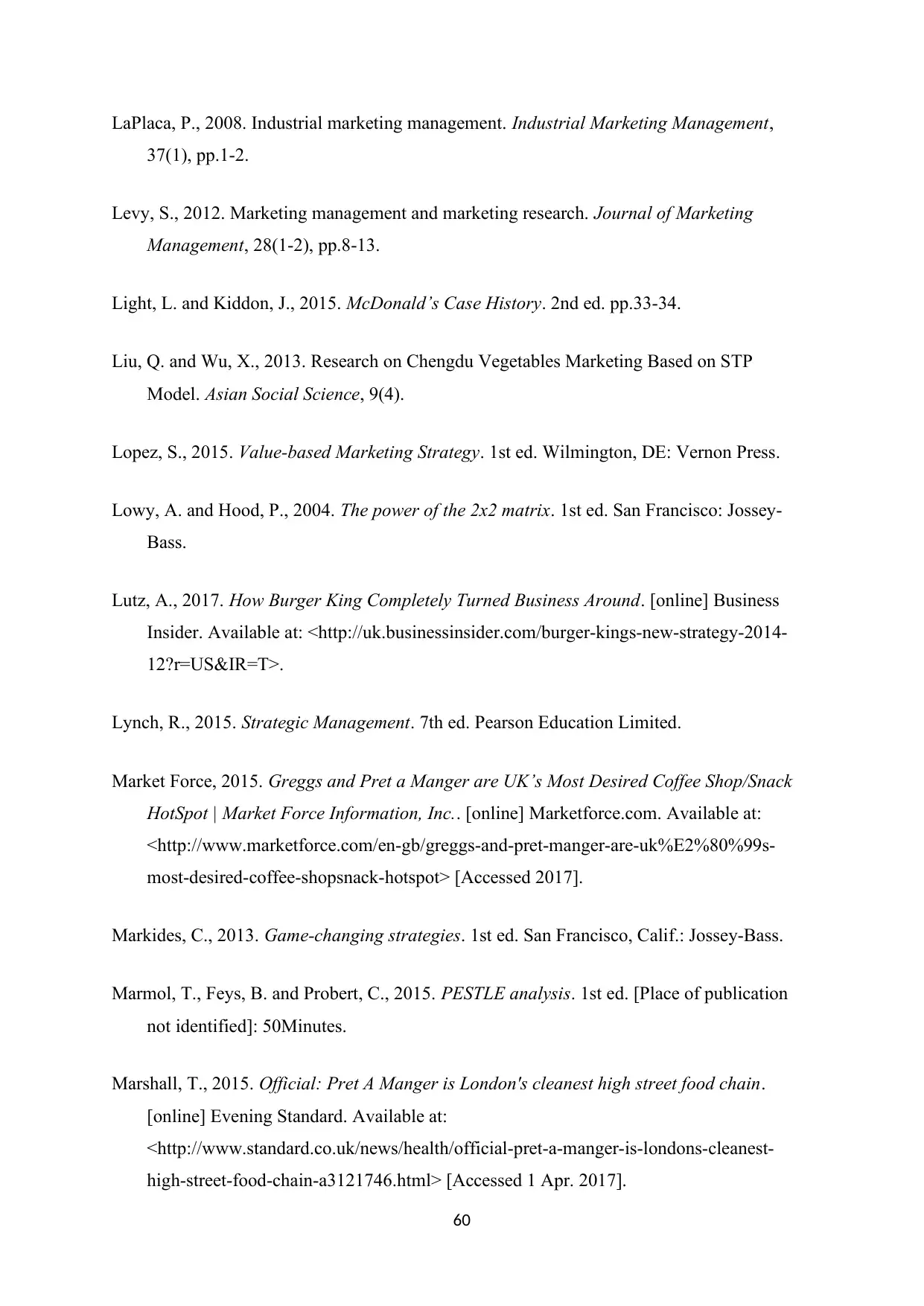
60
LaPlaca, P., 2008. Industrial marketing management. Industrial Marketing Management,
37(1), pp.1-2.
Levy, S., 2012. Marketing management and marketing research. Journal of Marketing
Management, 28(1-2), pp.8-13.
Light, L. and Kiddon, J., 2015. McDonald’s Case History. 2nd ed. pp.33-34.
Liu, Q. and Wu, X., 2013. Research on Chengdu Vegetables Marketing Based on STP
Model. Asian Social Science, 9(4).
Lopez, S., 2015. Value-based Marketing Strategy. 1st ed. Wilmington, DE: Vernon Press.
Lowy, A. and Hood, P., 2004. The power of the 2x2 matrix. 1st ed. San Francisco: Jossey-
Bass.
Lutz, A., 2017. How Burger King Completely Turned Business Around. [online] Business
Insider. Available at: <http://uk.businessinsider.com/burger-kings-new-strategy-2014-
12?r=US&IR=T>.
Lynch, R., 2015. Strategic Management. 7th ed. Pearson Education Limited.
Market Force, 2015. Greggs and Pret a Manger are UK’s Most Desired Coffee Shop/Snack
HotSpot | Market Force Information, Inc.. [online] Marketforce.com. Available at:
<http://www.marketforce.com/en-gb/greggs-and-pret-manger-are-uk%E2%80%99s-
most-desired-coffee-shopsnack-hotspot> [Accessed 2017].
Markides, C., 2013. Game-changing strategies. 1st ed. San Francisco, Calif.: Jossey-Bass.
Marmol, T., Feys, B. and Probert, C., 2015. PESTLE analysis. 1st ed. [Place of publication
not identified]: 50Minutes.
Marshall, T., 2015. Official: Pret A Manger is London's cleanest high street food chain.
[online] Evening Standard. Available at:
<http://www.standard.co.uk/news/health/official-pret-a-manger-is-londons-cleanest-
high-street-food-chain-a3121746.html> [Accessed 1 Apr. 2017].
LaPlaca, P., 2008. Industrial marketing management. Industrial Marketing Management,
37(1), pp.1-2.
Levy, S., 2012. Marketing management and marketing research. Journal of Marketing
Management, 28(1-2), pp.8-13.
Light, L. and Kiddon, J., 2015. McDonald’s Case History. 2nd ed. pp.33-34.
Liu, Q. and Wu, X., 2013. Research on Chengdu Vegetables Marketing Based on STP
Model. Asian Social Science, 9(4).
Lopez, S., 2015. Value-based Marketing Strategy. 1st ed. Wilmington, DE: Vernon Press.
Lowy, A. and Hood, P., 2004. The power of the 2x2 matrix. 1st ed. San Francisco: Jossey-
Bass.
Lutz, A., 2017. How Burger King Completely Turned Business Around. [online] Business
Insider. Available at: <http://uk.businessinsider.com/burger-kings-new-strategy-2014-
12?r=US&IR=T>.
Lynch, R., 2015. Strategic Management. 7th ed. Pearson Education Limited.
Market Force, 2015. Greggs and Pret a Manger are UK’s Most Desired Coffee Shop/Snack
HotSpot | Market Force Information, Inc.. [online] Marketforce.com. Available at:
<http://www.marketforce.com/en-gb/greggs-and-pret-manger-are-uk%E2%80%99s-
most-desired-coffee-shopsnack-hotspot> [Accessed 2017].
Markides, C., 2013. Game-changing strategies. 1st ed. San Francisco, Calif.: Jossey-Bass.
Marmol, T., Feys, B. and Probert, C., 2015. PESTLE analysis. 1st ed. [Place of publication
not identified]: 50Minutes.
Marshall, T., 2015. Official: Pret A Manger is London's cleanest high street food chain.
[online] Evening Standard. Available at:
<http://www.standard.co.uk/news/health/official-pret-a-manger-is-londons-cleanest-
high-street-food-chain-a3121746.html> [Accessed 1 Apr. 2017].
Paraphrase This Document
Need a fresh take? Get an instant paraphrase of this document with our AI Paraphraser
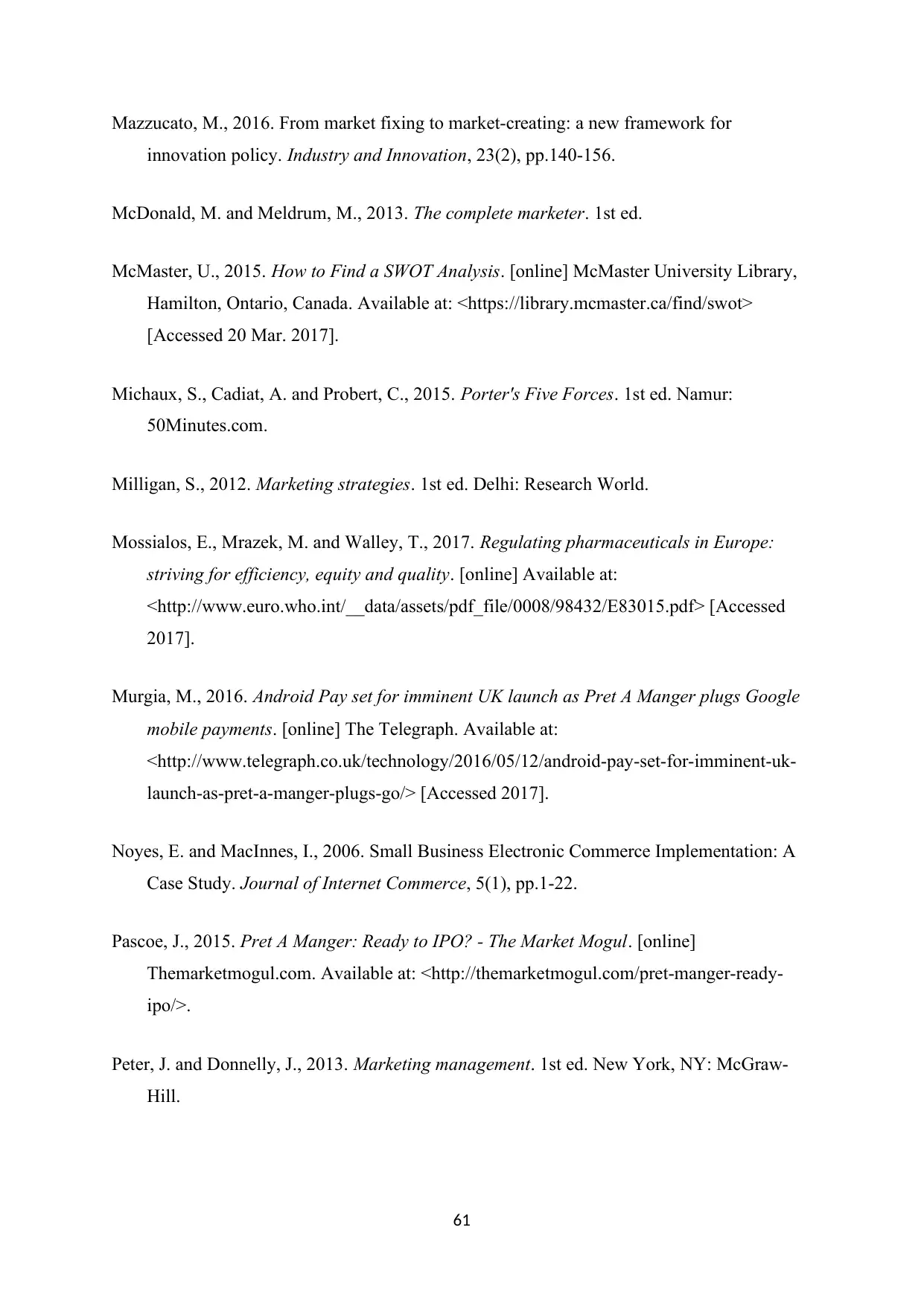
61
Mazzucato, M., 2016. From market fixing to market-creating: a new framework for
innovation policy. Industry and Innovation, 23(2), pp.140-156.
McDonald, M. and Meldrum, M., 2013. The complete marketer. 1st ed.
McMaster, U., 2015. How to Find a SWOT Analysis. [online] McMaster University Library,
Hamilton, Ontario, Canada. Available at: <https://library.mcmaster.ca/find/swot>
[Accessed 20 Mar. 2017].
Michaux, S., Cadiat, A. and Probert, C., 2015. Porter's Five Forces. 1st ed. Namur:
50Minutes.com.
Milligan, S., 2012. Marketing strategies. 1st ed. Delhi: Research World.
Mossialos, E., Mrazek, M. and Walley, T., 2017. Regulating pharmaceuticals in Europe:
striving for efficiency, equity and quality. [online] Available at:
<http://www.euro.who.int/__data/assets/pdf_file/0008/98432/E83015.pdf> [Accessed
2017].
Murgia, M., 2016. Android Pay set for imminent UK launch as Pret A Manger plugs Google
mobile payments. [online] The Telegraph. Available at:
<http://www.telegraph.co.uk/technology/2016/05/12/android-pay-set-for-imminent-uk-
launch-as-pret-a-manger-plugs-go/> [Accessed 2017].
Noyes, E. and MacInnes, I., 2006. Small Business Electronic Commerce Implementation: A
Case Study. Journal of Internet Commerce, 5(1), pp.1-22.
Pascoe, J., 2015. Pret A Manger: Ready to IPO? - The Market Mogul. [online]
Themarketmogul.com. Available at: <http://themarketmogul.com/pret-manger-ready-
ipo/>.
Peter, J. and Donnelly, J., 2013. Marketing management. 1st ed. New York, NY: McGraw-
Hill.
Mazzucato, M., 2016. From market fixing to market-creating: a new framework for
innovation policy. Industry and Innovation, 23(2), pp.140-156.
McDonald, M. and Meldrum, M., 2013. The complete marketer. 1st ed.
McMaster, U., 2015. How to Find a SWOT Analysis. [online] McMaster University Library,
Hamilton, Ontario, Canada. Available at: <https://library.mcmaster.ca/find/swot>
[Accessed 20 Mar. 2017].
Michaux, S., Cadiat, A. and Probert, C., 2015. Porter's Five Forces. 1st ed. Namur:
50Minutes.com.
Milligan, S., 2012. Marketing strategies. 1st ed. Delhi: Research World.
Mossialos, E., Mrazek, M. and Walley, T., 2017. Regulating pharmaceuticals in Europe:
striving for efficiency, equity and quality. [online] Available at:
<http://www.euro.who.int/__data/assets/pdf_file/0008/98432/E83015.pdf> [Accessed
2017].
Murgia, M., 2016. Android Pay set for imminent UK launch as Pret A Manger plugs Google
mobile payments. [online] The Telegraph. Available at:
<http://www.telegraph.co.uk/technology/2016/05/12/android-pay-set-for-imminent-uk-
launch-as-pret-a-manger-plugs-go/> [Accessed 2017].
Noyes, E. and MacInnes, I., 2006. Small Business Electronic Commerce Implementation: A
Case Study. Journal of Internet Commerce, 5(1), pp.1-22.
Pascoe, J., 2015. Pret A Manger: Ready to IPO? - The Market Mogul. [online]
Themarketmogul.com. Available at: <http://themarketmogul.com/pret-manger-ready-
ipo/>.
Peter, J. and Donnelly, J., 2013. Marketing management. 1st ed. New York, NY: McGraw-
Hill.
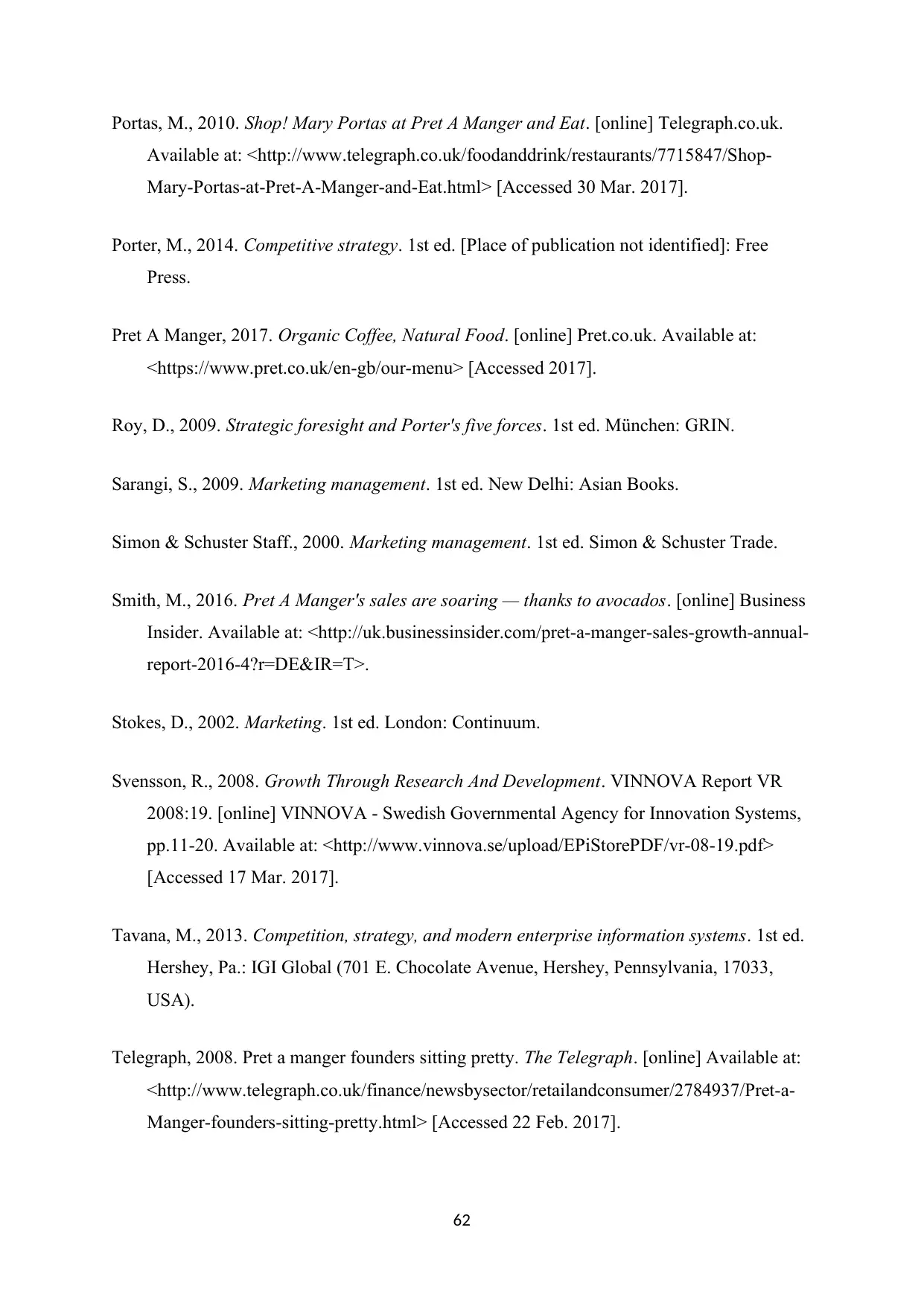
62
Portas, M., 2010. Shop! Mary Portas at Pret A Manger and Eat. [online] Telegraph.co.uk.
Available at: <http://www.telegraph.co.uk/foodanddrink/restaurants/7715847/Shop-
Mary-Portas-at-Pret-A-Manger-and-Eat.html> [Accessed 30 Mar. 2017].
Porter, M., 2014. Competitive strategy. 1st ed. [Place of publication not identified]: Free
Press.
Pret A Manger, 2017. Organic Coffee, Natural Food. [online] Pret.co.uk. Available at:
<https://www.pret.co.uk/en-gb/our-menu> [Accessed 2017].
Roy, D., 2009. Strategic foresight and Porter's five forces. 1st ed. München: GRIN.
Sarangi, S., 2009. Marketing management. 1st ed. New Delhi: Asian Books.
Simon & Schuster Staff., 2000. Marketing management. 1st ed. Simon & Schuster Trade.
Smith, M., 2016. Pret A Manger's sales are soaring — thanks to avocados. [online] Business
Insider. Available at: <http://uk.businessinsider.com/pret-a-manger-sales-growth-annual-
report-2016-4?r=DE&IR=T>.
Stokes, D., 2002. Marketing. 1st ed. London: Continuum.
Svensson, R., 2008. Growth Through Research And Development. VINNOVA Report VR
2008:19. [online] VINNOVA - Swedish Governmental Agency for Innovation Systems,
pp.11-20. Available at: <http://www.vinnova.se/upload/EPiStorePDF/vr-08-19.pdf>
[Accessed 17 Mar. 2017].
Tavana, M., 2013. Competition, strategy, and modern enterprise information systems. 1st ed.
Hershey, Pa.: IGI Global (701 E. Chocolate Avenue, Hershey, Pennsylvania, 17033,
USA).
Telegraph, 2008. Pret a manger founders sitting pretty. The Telegraph. [online] Available at:
<http://www.telegraph.co.uk/finance/newsbysector/retailandconsumer/2784937/Pret-a-
Manger-founders-sitting-pretty.html> [Accessed 22 Feb. 2017].
Portas, M., 2010. Shop! Mary Portas at Pret A Manger and Eat. [online] Telegraph.co.uk.
Available at: <http://www.telegraph.co.uk/foodanddrink/restaurants/7715847/Shop-
Mary-Portas-at-Pret-A-Manger-and-Eat.html> [Accessed 30 Mar. 2017].
Porter, M., 2014. Competitive strategy. 1st ed. [Place of publication not identified]: Free
Press.
Pret A Manger, 2017. Organic Coffee, Natural Food. [online] Pret.co.uk. Available at:
<https://www.pret.co.uk/en-gb/our-menu> [Accessed 2017].
Roy, D., 2009. Strategic foresight and Porter's five forces. 1st ed. München: GRIN.
Sarangi, S., 2009. Marketing management. 1st ed. New Delhi: Asian Books.
Simon & Schuster Staff., 2000. Marketing management. 1st ed. Simon & Schuster Trade.
Smith, M., 2016. Pret A Manger's sales are soaring — thanks to avocados. [online] Business
Insider. Available at: <http://uk.businessinsider.com/pret-a-manger-sales-growth-annual-
report-2016-4?r=DE&IR=T>.
Stokes, D., 2002. Marketing. 1st ed. London: Continuum.
Svensson, R., 2008. Growth Through Research And Development. VINNOVA Report VR
2008:19. [online] VINNOVA - Swedish Governmental Agency for Innovation Systems,
pp.11-20. Available at: <http://www.vinnova.se/upload/EPiStorePDF/vr-08-19.pdf>
[Accessed 17 Mar. 2017].
Tavana, M., 2013. Competition, strategy, and modern enterprise information systems. 1st ed.
Hershey, Pa.: IGI Global (701 E. Chocolate Avenue, Hershey, Pennsylvania, 17033,
USA).
Telegraph, 2008. Pret a manger founders sitting pretty. The Telegraph. [online] Available at:
<http://www.telegraph.co.uk/finance/newsbysector/retailandconsumer/2784937/Pret-a-
Manger-founders-sitting-pretty.html> [Accessed 22 Feb. 2017].
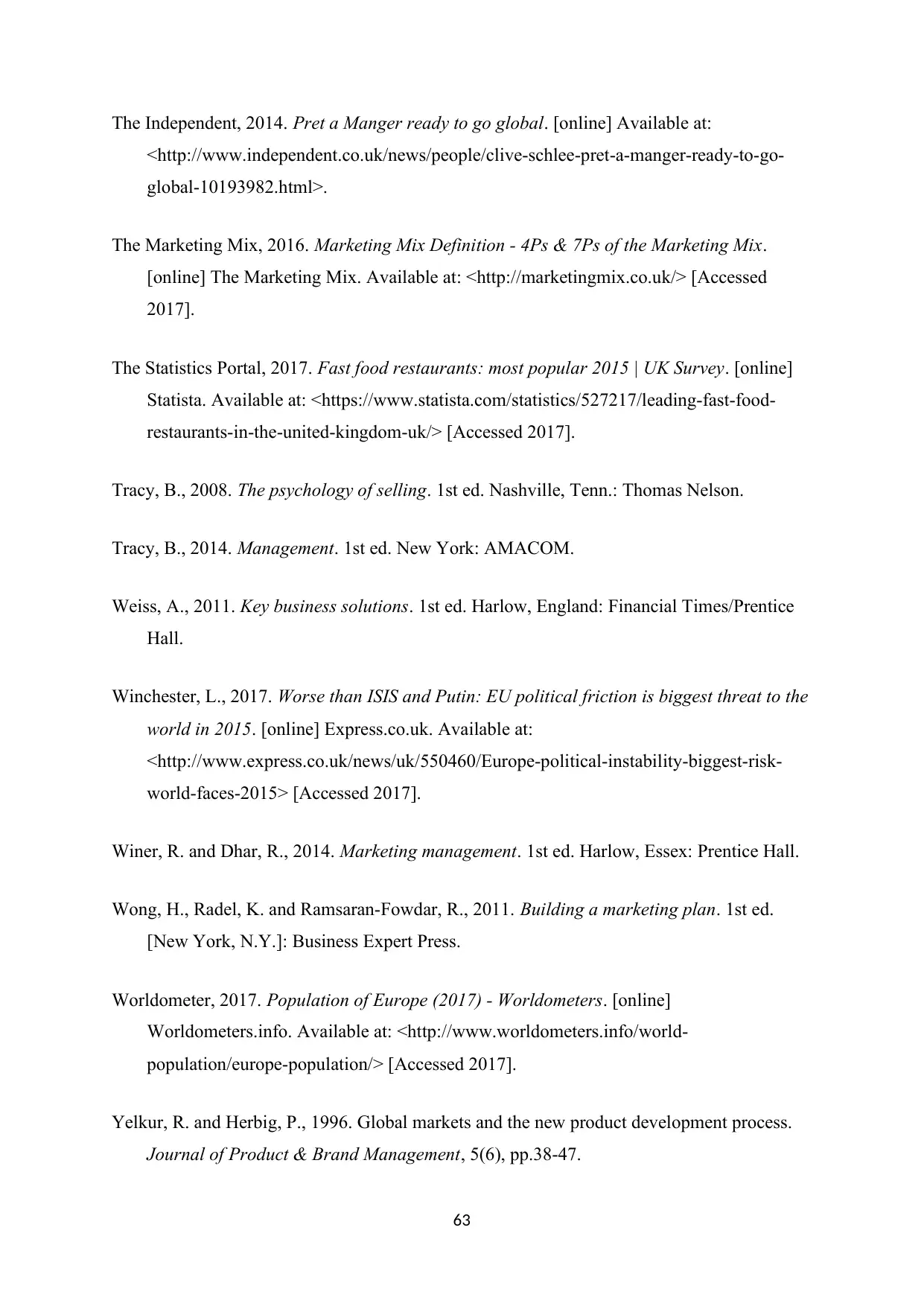
63
The Independent, 2014. Pret a Manger ready to go global. [online] Available at:
<http://www.independent.co.uk/news/people/clive-schlee-pret-a-manger-ready-to-go-
global-10193982.html>.
The Marketing Mix, 2016. Marketing Mix Definition - 4Ps & 7Ps of the Marketing Mix.
[online] The Marketing Mix. Available at: <http://marketingmix.co.uk/> [Accessed
2017].
The Statistics Portal, 2017. Fast food restaurants: most popular 2015 | UK Survey. [online]
Statista. Available at: <https://www.statista.com/statistics/527217/leading-fast-food-
restaurants-in-the-united-kingdom-uk/> [Accessed 2017].
Tracy, B., 2008. The psychology of selling. 1st ed. Nashville, Tenn.: Thomas Nelson.
Tracy, B., 2014. Management. 1st ed. New York: AMACOM.
Weiss, A., 2011. Key business solutions. 1st ed. Harlow, England: Financial Times/Prentice
Hall.
Winchester, L., 2017. Worse than ISIS and Putin: EU political friction is biggest threat to the
world in 2015. [online] Express.co.uk. Available at:
<http://www.express.co.uk/news/uk/550460/Europe-political-instability-biggest-risk-
world-faces-2015> [Accessed 2017].
Winer, R. and Dhar, R., 2014. Marketing management. 1st ed. Harlow, Essex: Prentice Hall.
Wong, H., Radel, K. and Ramsaran-Fowdar, R., 2011. Building a marketing plan. 1st ed.
[New York, N.Y.]: Business Expert Press.
Worldometer, 2017. Population of Europe (2017) - Worldometers. [online]
Worldometers.info. Available at: <http://www.worldometers.info/world-
population/europe-population/> [Accessed 2017].
Yelkur, R. and Herbig, P., 1996. Global markets and the new product development process.
Journal of Product & Brand Management, 5(6), pp.38-47.
The Independent, 2014. Pret a Manger ready to go global. [online] Available at:
<http://www.independent.co.uk/news/people/clive-schlee-pret-a-manger-ready-to-go-
global-10193982.html>.
The Marketing Mix, 2016. Marketing Mix Definition - 4Ps & 7Ps of the Marketing Mix.
[online] The Marketing Mix. Available at: <http://marketingmix.co.uk/> [Accessed
2017].
The Statistics Portal, 2017. Fast food restaurants: most popular 2015 | UK Survey. [online]
Statista. Available at: <https://www.statista.com/statistics/527217/leading-fast-food-
restaurants-in-the-united-kingdom-uk/> [Accessed 2017].
Tracy, B., 2008. The psychology of selling. 1st ed. Nashville, Tenn.: Thomas Nelson.
Tracy, B., 2014. Management. 1st ed. New York: AMACOM.
Weiss, A., 2011. Key business solutions. 1st ed. Harlow, England: Financial Times/Prentice
Hall.
Winchester, L., 2017. Worse than ISIS and Putin: EU political friction is biggest threat to the
world in 2015. [online] Express.co.uk. Available at:
<http://www.express.co.uk/news/uk/550460/Europe-political-instability-biggest-risk-
world-faces-2015> [Accessed 2017].
Winer, R. and Dhar, R., 2014. Marketing management. 1st ed. Harlow, Essex: Prentice Hall.
Wong, H., Radel, K. and Ramsaran-Fowdar, R., 2011. Building a marketing plan. 1st ed.
[New York, N.Y.]: Business Expert Press.
Worldometer, 2017. Population of Europe (2017) - Worldometers. [online]
Worldometers.info. Available at: <http://www.worldometers.info/world-
population/europe-population/> [Accessed 2017].
Yelkur, R. and Herbig, P., 1996. Global markets and the new product development process.
Journal of Product & Brand Management, 5(6), pp.38-47.
Secure Best Marks with AI Grader
Need help grading? Try our AI Grader for instant feedback on your assignments.
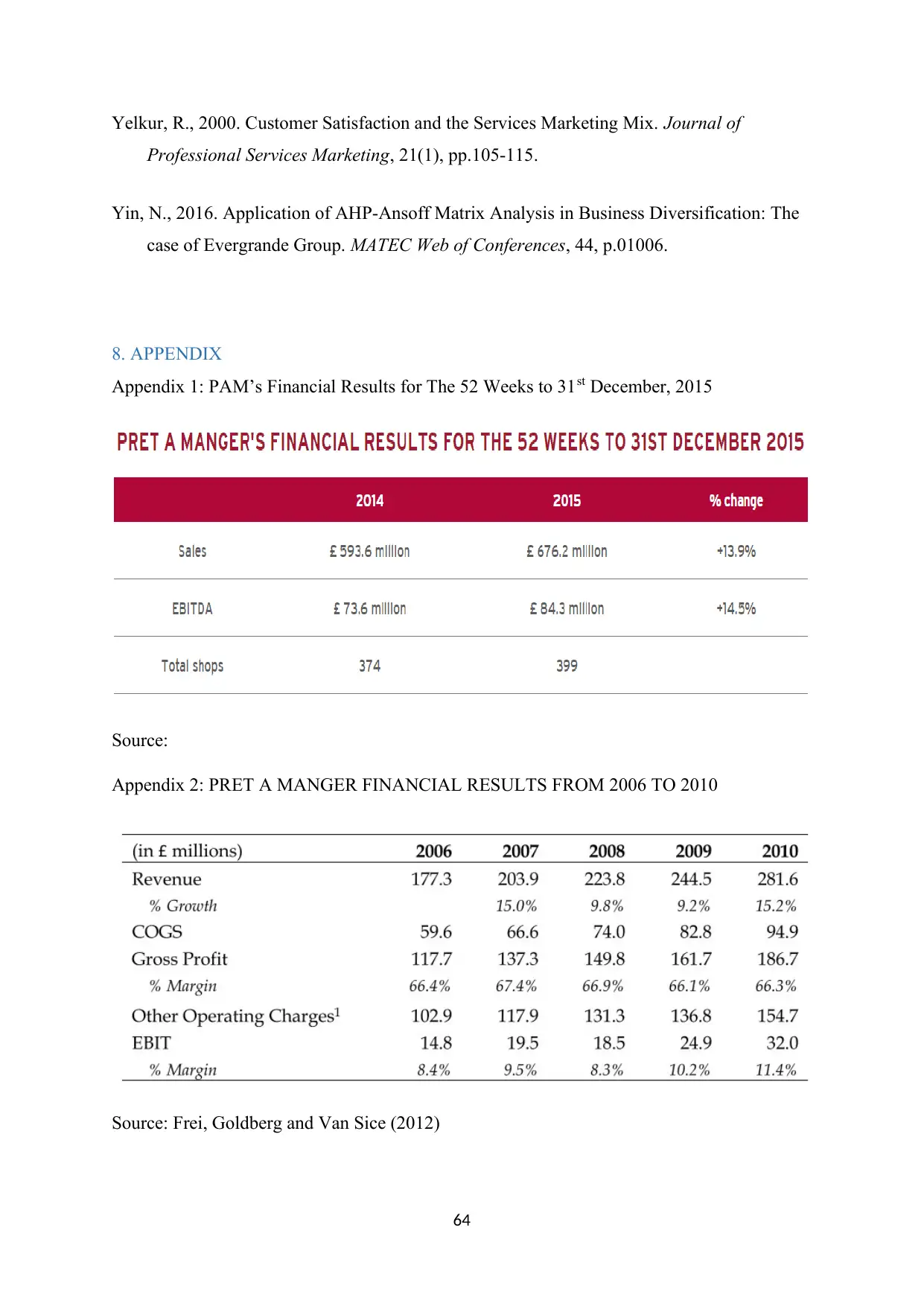
64
Yelkur, R., 2000. Customer Satisfaction and the Services Marketing Mix. Journal of
Professional Services Marketing, 21(1), pp.105-115.
Yin, N., 2016. Application of AHP-Ansoff Matrix Analysis in Business Diversification: The
case of Evergrande Group. MATEC Web of Conferences, 44, p.01006.
8. APPENDIX
Appendix 1: PAM’s Financial Results for The 52 Weeks to 31st December, 2015
Source:
Appendix 2: PRET A MANGER FINANCIAL RESULTS FROM 2006 TO 2010
Source: Frei, Goldberg and Van Sice (2012)
Yelkur, R., 2000. Customer Satisfaction and the Services Marketing Mix. Journal of
Professional Services Marketing, 21(1), pp.105-115.
Yin, N., 2016. Application of AHP-Ansoff Matrix Analysis in Business Diversification: The
case of Evergrande Group. MATEC Web of Conferences, 44, p.01006.
8. APPENDIX
Appendix 1: PAM’s Financial Results for The 52 Weeks to 31st December, 2015
Source:
Appendix 2: PRET A MANGER FINANCIAL RESULTS FROM 2006 TO 2010
Source: Frei, Goldberg and Van Sice (2012)
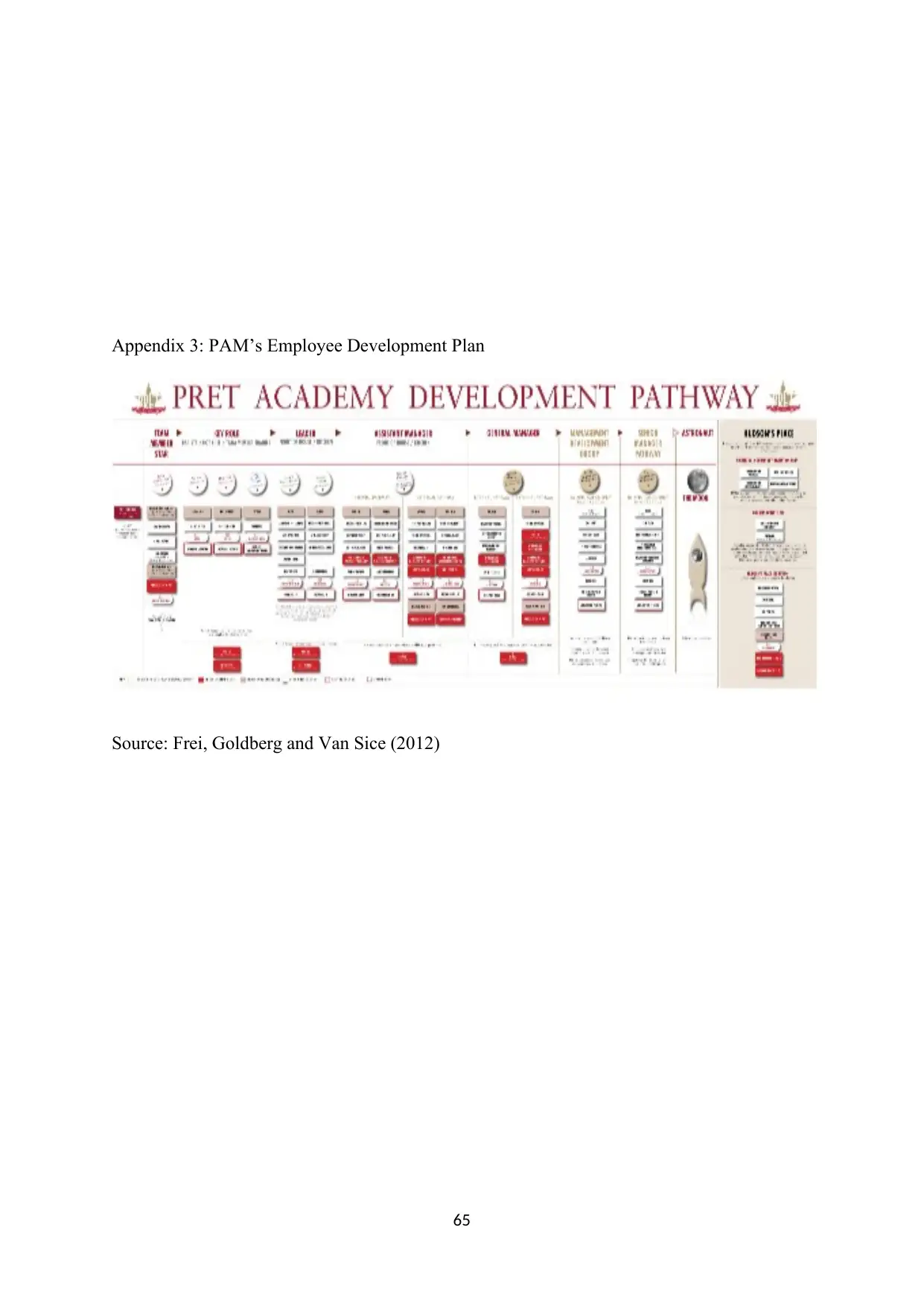
65
Appendix 3: PAM’s Employee Development Plan
Source: Frei, Goldberg and Van Sice (2012)
Appendix 3: PAM’s Employee Development Plan
Source: Frei, Goldberg and Van Sice (2012)
1 out of 72
Related Documents
Your All-in-One AI-Powered Toolkit for Academic Success.
+13062052269
info@desklib.com
Available 24*7 on WhatsApp / Email
![[object Object]](/_next/static/media/star-bottom.7253800d.svg)
Unlock your academic potential
© 2024 | Zucol Services PVT LTD | All rights reserved.





